Note: Text is printed in gold lettering with an inverted triangle of decorative
foliage below it.
DANTE GABRIEL ROSSETTI
Note: Inside the front cover is a bookplate which reads “ex
libris W. L. Phillips.”
DANTE GABRIEL ROSSETTI
BY CHRISTINA ROSSETTI
December, 1856
-
ONE face looks out from all his canvases,
-
One selfsame figure sits or walks or leans:
-
We found her hidden just behind those screens,
-
That mirror gave back all her loveliness.
-
A queen in opal or in ruby dress,
-
A nameless girl in freshest summer-greens,
-
A saint, an angel—every canvas means
-
The one same meaning, neither more nor less.
-
He feeds upon her face by day and night,
-
10
And she with true kind eyes looks back on him,
-
Fair as the moon and joyful as the light:
-
Not wan with waiting, not with sorrow dim;
-
Not as she is, but was when hope shone bright;
-
Not as she is, but as she fills his dream.
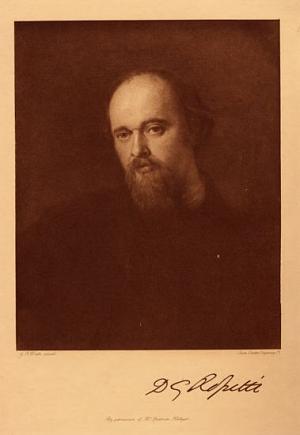
G.F. Watts, pinxit. Swan Electric Engraving C
o.
D G Rossetti
By permission of M
r.
Frederick Hollyer
Figure: Sepia tone half-length portrait of a mature Dante Gabriel Rossetti
with his head turned slightly towards his right. Marillier reproduces a
facsimile of DGR's autograph below this picture.
Note: Rossetti's name is printed in red ink.
DANTE GABRIEL
ROSSETTI
AN ILLUSTRATED MEMORIAL OF HIS
ART AND LIFE
by
H. C. MARILLIER
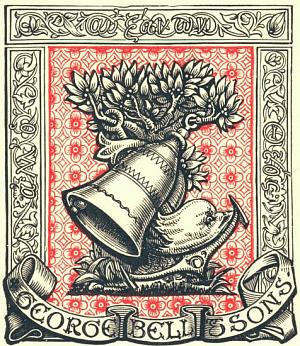
George Bell & Sons
Figure: Imprint of George Bell & Sons publishers.
LONDON
GEORGE BELL AND SONS
1899
CHISWICK PRESS:—CHARLES WHITTINGHAM AND CO.
TOOKS COURT, CHANCERY LANE, LONDON.
HAVING been asked more than once if I was compiling a life of
Rossetti, I think it well to disclaim at the outset any such presumptuous
intention. A life of Rossetti, in the full sense of the word, could only be
written by one who was intimately and sympathetically associated with his work
during the major portion of his career; and of the very few who could have
undertaken the task some are no longer alive, whilst others have either
abandoned or postponed it until too late. For this reason we can hardly expect
now to have a life of this great and most original genius, written by anyone
with enough knowledge to interpret his many-coloured personality, yet
sufficiently disinterested to form a critical estimate of his true position and
influence.
Biographical works and data there are in profusion. The admirably conscientious
labours of Mr. William Michael Rossetti have resulted in placing before the
public copious records of the painter's external life, and of his private life
as well so far as it is revealed in letters to the members of his family. What
these do not give us is the man in relation to his work, and what they do give
us is not always strictly important. Nevertheless they constitute the most
valuable body of materials yet published, and no biographer could affect to
disregard them. They have been supplemented recently by the publication of
Ruskin's letters to Rossetti and Rossetti's letters to William Allingham, both
immensely interesting to students of the subject, but not by any means
exhaustive of the periods they cover. The only other sources of information that
seem to me worth mentioning are Mr. William Sharp's memoir, which would have been
better had it been less hastily compiled; Mr. Joseph Knight's little volume in the “Great Writers” series, dealing chiefly with the poems; Mr. W. M. Rossetti's
chronological record called “
Dante Gabriel Rossetti as Designer and Writer”; William Bell Scott's “
Autobiographical Notes,” compiled when the author
was too much embittered to write fairly; and Mr. F. G.
Stephens's handy
monograph in
the “Portfolio” series
. In addition might
be mentioned Mr. Watts-Dunton's article in the “Encyclopædia
Brittanica.” There are of course many other books, and much
periodical literature dealing with Rossetti, but, with the single exception of
Mr. Holman Hunt's articles in the “Contemporary" of 1886 on the
“Pre-Raphaelite Brotherhood,” these are not of great account.
One or two who claim to have written with intimate knowledge of their subject
labour under the disadvantage of not having known Rossetti until the latter
clouded years of his life, when his vigour and health were impaired, and he had
apparently lost the power of personal discrimination.
Of the materials which I have mentioned it would be ungrateful to complain,
seeing that as occasion demanded I have used or borrowed from most of them. I
must, however, say that careful research has not always tended to confirm the
information they afforded, and I may claim, I think, for this memoir that it
will be found correct on many points where errors previously existed. Three of
the above-named authorities, Mr. Sharp, Mr. Knight, and Mr. W. M. Rossetti, have
published catalogues or lists of Rossetti's pictures, giving dates and a few
other scanty particulars. Mr. Rossetti's list is certainly by far the best of
these, though not itself complete, the two earlier ones being almost useless now
for purposes of reference. I say this with no intention of disparagement, for
Mr. Sharp's list was a wonderful one to have compiled in the time allowed him;
and he had no previous data to work on, whereas I have had three lists to
collate and check, and possibly better opportunities of acquiring information.
In addition I have received much help with some of the more tangled problems
both from Mr. Rossetti and from Mr. Fairfax Murray, the latter of whom is
recognized as an expert in all matters connected with Rossetti's work. To Mr.
Murray moreover I am indebted for kindly checking the list of works and dates
which appears as an appendix to this volume, as well as for revising some of the
proofs. What use I have made of the assistance so generously given is my own
affair, and for this I alone am answerable. In acknowledging the benefit I do
not wish to alienate the responsibility.
What I have aimed at chiefly is to interweave a simple account of the painter's
life with a detailed chronological record of his artistic work. In this way, by
following certain broad divisions, a fairly continuous narrative is made
possible without jumbling up
pictures and incidents too confusedly. In dealing
with the pictures in the text I have followed a system which I think should be
found useful, as I myself have found the lack of it in other books somewhat
irritating; namely, I have grouped under the first, or sometimes under the most
important version of any particular subject, a list of all the other versions
and replicas which exist of it. These versions and replicas are then referred to
again briefly or in detail as may be under the different years to which they
belong. Some such system is absolutely necessary in dealing with Rossetti's
work, for the multitude of replicas and variants is bewildering, and most of the
errors which I have encountered have been due to confusion arising on this
account. As an instance of the kind of tangle met with, who could foresee such a
confusion of dates and pictures as exists in the case of the
Proserpine
subject, or (without personal knowledge of the facts) understand the
complicated changes in the history of the
Dante and Beatrice
panels, given in this book, I believe, for the first time.
Whilst trying to compile a record of Rossetti's work which should be
comprehensive, accurate, and useful as a work of reference, I have not forgotten
that essentially it was a picture book that was wanted. In respect of the
illustrations, moreover, I can speak with greater freedom; and first, it is
pleasant to acknowlege that almost without exception the owners of Rossetti's
pictures have courteously allowed them to be reproduced, and have given special
facilities for photographing them. In some cases this was no ordinary
politeness, but a very generous concession, involving a violation of fixed
principles. Mr. Rae, it is well known, has for many years disapproved most
strongly of indiscriminate reproduction, and has refused all applications to let
his pictures be photographed for such a purpose, the only exceptions being when
he allowed Mr. Quilter to reproduce
The Blue Closet
in “Preferences,” and Mr. Stephens to include
a few small subjects in his
already mentioned monograph done for “ The
Portfolio.” I cannot, therefore, express my obligation to him
sufficiently strongly for placing his magnificent collection at my disposal, and
allowing me to reproduce eleven of his pictures; namely,
The Beloved
,
Sibylla Palmifera
,
Monna Vanna
,
Venus Verticordia
,
The Damsel of the Sanc Grael
(both the large
oil and
the little
water-colour),
The Blue Closet
,
The Wedding of St. George
,
The Tune of Seven Towers
, the early pen-and-ink diptych of
Il Saluto di Beatrice
, and the beautiful crayon head of a
Magdalen
. Mr. Beresford Heaton, whose objections were almost
equally invincible, has at the last moment allowed
me to include the charming early water-colour
Dante's Dream
and
The Vision of Rachel and Leah
from his collection. Mr. Fairfax Murray has been not less generous in
allowing his drawings to be reproduced than in helping me with facts, and though
there are one or two treasures that he has withheld for special reasons, I am
indebted to him for permission to include
The Merciless Lady
,
Dr. Johnson at the Mitre
,
The Laboratory
,
Bonifazio's Mistress
, with the
pen-and-ink
study
,
A Fight for a Woman
, the early sketch called
Genevieve
, a pencil drawing for
Mary in the House of John
, and several minor items, including some designs for pictures never
reproduced before. Mr. Watts-Dunton has allowed me to include
The Spirit of the Rainbow
, Rossetti's one nude figure, which has never before been given, as well
as his
Reverie
,
Pandora
, and another drawing. Mr. Wells, R.A., has contributed two interesting
portraits of Miss Siddal
[portrait
1]
[portrait 2] and the water-colour
Beatrice denying the Salutation
—the companion drawing to which (in point of date and history),
viz.,
Giotto painting Dante's Portrait
, has been lent by its present owner, Mr. John Aird, M.P. Other owners
who have obligingly given me access to their pictures, and have in one or two
cases even sent them to London to be photographed, are Mr. W. R. Moss, Mr. S.
Pepys Cockerell, Mr. Francis Buxton, Mr. Charles Butler, Mrs. Jekyll, Lord
Battersea and Overstrand, Mr. William Imrie, Mrs. Clarence Fry, Mr. Trist, Mrs.
Coronio, Mr. Constantine Ionides, Mrs. A. Ionides, Sir Cuthbert Quilter, Prof.
C. E. Norton, Mr. T. H. Leathart, Mr. F. J. Tennant, Mr. Russell Rea, Mr. S. E.
Spring-Rice, Mr. A. T. Squarey, the Rev. S. A. Donaldson, Mr. William Dunlop,
Mr. Charles Ricketts, Dr. Spence Watson, Mr. Arthur Severn, Mr. Cosmo Monkhouse,
Mrs. Constance Churchill, the Hon. Percy Wyndham, Sir Henry Acland, Dr. H. A.
Munro, and the Corporation Art Galleries of Birmingham, Manchester, and
Liverpool. Mr. Rossetti has given me practically a free hand in the reproduction
of family portraits and drawings belonging to him, and has also allowed me to
use many of the negatives of pictures that were specially made for his brother,
sometimes before alterations of a disastrous kind had been undertaken. To Mr.
Frederick Hollyer, Mr. Caswall Smith, and the Autotype Company, I owe an
expression of thanks for generously giving me the use of many of their copyright
negatives, and to Messrs. Macmillan no less for the right to reproduce the five
wood-blocks
[block 1]
[block 2]
[block 3]
[block 4]
[block 5] done for Moxon's “Tennyson” and two others
[plate 1]
[plate 2] from Miss Christina
Rossetti's books. Messrs.
Sotheran, Mr. Duckworth, and the editor of the “Pall Mall Magazine” have kindly lent me various blocks or plates, and, finally, Messrs.
Cassell have my thanks for allowing two pictures to be reproduced from the
“Magazine of Art.”
With a few rare exceptions, owing to owners' refusals, or in the case of
The Blue Bower
and
The Blessed Damozel
from the pictures being held in trust, there is scarcely a work of
individual importance by Rossetti which will not be found illustrated in this
book or in some way represented. In general, moreover, where a choice existed,
it is the best version of each particular subject from which the reproduction
has been made, though there are cases where this was not possible, owing to the
pictures having gone abroad or become untraceable. It would hardly be believed
how difficult Rossetti's pictures are to find since their dispersal after the
great Graham, Leyland, Turner, Ruston, and Leathart sales. Even with the kind
help of Mr. Croal Thomson and Messrs. Agnew there are many that I have not
located, though I have been fortunate in borrowing private photographs of some
of these and published prints of others. No doubt the constantly increasing
value of Rossetti's works is partly responsible for their restlessness, but
there is something almost melancholy in the way that they seem perpetually to
change hands. The Rae and Heaton collections are almost the only ones of
importance that have remained intact. Mr. Ruskin, who at one time had quite a
number of good water-colours, has parted with all but the unfinished
Passover
, and no one seems to know where some of them have gone. The Boyce
collection has shared the same fate, though in this case the bulk of it has
passed into the hands of Mr. Murray, who amid the maelstrom of flux and change
has constituted himself a sort of natural vortex or harbour of refuge.
This is one of the circumstances which has made the illustration of a book on
Rossetti not altogether easy, and which may have prevented its being undertaken
before. Even now I am conscious of many omissions and failures, which mar the
completeness of the work. But it is no part of an author's duty to specify these
for his readers, most of whom will be ready enough to find them, and perfectly
candid in pointing them out.
H. C. M.
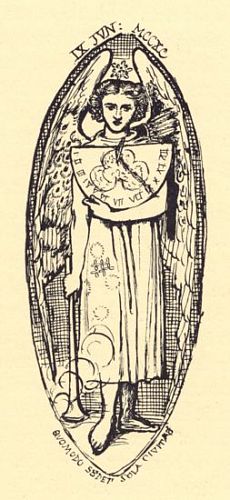
DESIGN FOR DANTIS AMOR, PAINTED BETWEEN THE DANTE AND BEATRICE PANELS,
1866.
See page 89.
Figure: Pencil. Inscribed at top: "IX JVN: MCCXC." Inscribed at bottom:
"QUOMODO SEDET SOLA CIVITAS." Oblong outline, framing the shape of the
angels' wings and coming to a point above his head and beneath his feet.
An angel, "Love," stands holding a clock and a down-turned
torch.
[
The Reproductions are the Work of the Swan Electric Engraving
Company
.]
DANTE GABRIEL, or, to give him his full christening name,
Gabriel Charles Dante Rossetti, was born on May 12th, 1828, at No. 38, Charlotte
Street, Portland Place, and was the second of four children, all born in
successive years. His
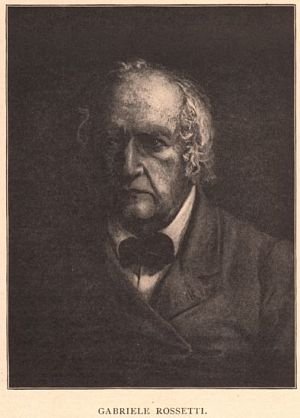
Gabriele Rossetti
Figure: Oil painting. Head and shoulders portrait of Gabriele Rossetti with
his head turned slightly to his right.
parentage and family life have been so copiously dealt with already in
the “
Memoir” compiled by his brother, Mr. William Michael Rossetti, that there is no
need here to do more than recapitulate the main facts. Gabriele Rossetti, the
father of Dante Gabriel, was a native of the city of Vasto, in the province of
Abruzzi, on the Adriatic coast of what was once the kingdom of Naples. He was a
man of superior literary ability and force of character, at one time custodian
of bronzes at the Naples Museum, who made himself obnoxious to the Bourbon King
Ferdinand during the suppression of the constitution in 1821, and was in
consequence proscribed and obliged to fly for safety. Assisted by a British
man-of-war in escaping to Malta, Gabriele Rossetti remained there for some time,
practising as an instructor in his native
language, until further annoyance drove him in 1824 to England. Here he settled,
and some years later obtained an appointment as Professor of Italian at King's
College. Meantime, in 1826, he had married a daughter of Gaetano Polidori, for
some while secretary to the notable Count Alfieri, and father also of that
strange being, Dr. John Polidori, who travelled with Byron as his physician, and
committed suicide in 1821. Gaetano Polidori's wife, Rossetti's grandmother, was
an Englishwoman, whose maiden name was Pierce. To his parentage the young Dante
Gabriel was indebted for much, but especially to his
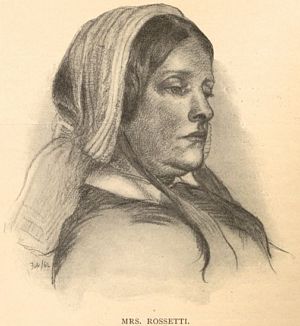
Mrs. Rossetti.
Figure: Chalk and pencil. Inscribed lower left: "Feb/62." Drawing of head
and shoulders, nearly in profile to right, wearing a white pleated muslin
bonnet; on either side a streamer falls forward over the
shoulders.Surtees, 187
mother. One can judge to this day of the latter's quiet sensible
character, and deep religious instincts, from the portraits left us by her son,
of which one is
reproduced here as typical. But,
besides these qualities, she possessed good literary and artistic judgment,
shrewd knowledge of human nature, and a fund of common sense which must have
effectually prevented the somewhat mystical spirit pervading the thoughts of her
young family from deteriorating into morbid and unhealthy channels. Between D.
G. Rossetti and his mother the warmest and most affectionate relations
prevailed, relations that were only severed by the former's untimely death on
April 9th, 1882. Mrs. Rossetti survived her son exactly four years
to the very day. Her husband
had died in April, 1854, honoured as a patriot in his native land with a
memorial statue
1 and a medal commemorating his
services. Their elder daughter, Maria, departed this life in 1876,
and in December, 1894, Christina Rossetti also died, leaving as sole survivor of
this brilliant family the younger son, William Michael, well known as a writer
of critiques on art and as the biographer of his more famous brother.
Albeit English in its main external features, the environment of the Rossetti
family in London remained essentially Italian during the lifetime of Gabriele
Rossetti. Their house was the resort of all classes of Italians passing through
or resident in town. Musicians and literary men met there with revolutionaries
fresh from the wasting struggle for Italian liberty. A romantic odour of
assassination hung round one at least of the regular habitués of the house, and
added spice to the somewhat fusty atmosphere of the father's own particular
studies. Gabriele Rossetti was a commentator on Dante, and himself a writer of
verse, mainly in a politico-satirical vein. He had a gift for declamation and
improvization, which is not so uncommon in men of his nationality as of ours;
but the exposition of Dante was his chief occupation, as well as the one by
which he is now best known. To the ears of the young Gabriel, familiarized by
habit with the sonorous metres of the “Inferno” and “Paradiso,” the name of Dante for many years conjured up no very stimulating
thoughts. It was not until he had begun himself in early life to read upon his
own lines, that the pictorial richness and splendour of the Florentine dawned on
him and seized him with its spell. There is a sketch by Rossetti of his father,
engaged upon his labours of interpretation, and surrounded, as Mr. W. M.
Rossetti has described him, by heavy folios in italic type, his “libri mistici,” full of the lore of Swedenborg,
alchemy, and Brahminism, with the aid of which he is devotedly burying the
poetry of his subject beneath unprofitable layers of teleological symbolism.
“The ‘Convito,’ ” says his son, “was always a name of dread to us,
as being the very essence of arid unreadableness,” an interesting
fact to remember when dealing, as we shall presently have to do, with the
influence which Dante was destined afterwards to exert upon two members at least
of the family.
Before passing to the early life of Gabriel Rossetti, a pair of independent
descriptions of the household and surroundings of No. 50, Charlotte Street,
whither the family removed from No. 38 in
Transcribed Footnote (page 3):
1The statue, I understand, has not yet been erected,
but is still in contemplation.
1836, may not be without interest, though to
some they will not be new.
Mr. William Bell Scott, in his “Autobiographical Notes,” says, “I entered the small front parlour or dining-room of the
house, and found an old gentleman sitting by the fire in a great chair, the
table drawn close to his chair, with a thick MS. book open before him, and
the largest snuff-box I ever saw beside it conveniently open. He had a black
cap on his head furnished with a great peak or shade for the eyes, so that I
only saw his face partially.” This description tallies in a
remarkable way with the
drawing of his
father
just mentioned, done by Dante Gabriel in 1853, though
otherwise not remarkable for insight or fullness of detail. A more interesting
picture is one by Mr. F. G. Stephens, Rossetti's early associate, quoted from
his “
Portfolio” monograph:
“As might be expected of one possessing so many accomplishments, and
whose career was marked by so much courage, the professor was a man of
striking character and aspect. . . . To a youngster, such as I was, he
seemed much older than his years, and while seated reading at a table
with two candles behind him, and, because his sight was failing, with a
wide shade over his eyes, he looked a very Rembrandt come to life. . . .
Near his side, but beyond the radiant circle of the candles,—her erect,
comely, and very English form and face remarkable for its noble and
beautiful matronhood, sat Mrs. Rossetti, the mother of Dante Gabriel. He
too, leaning his elbows upon the table and holding his face between both
hands so that the long curling masses of his dark brown hair fell
forward, sat on the other side, his attenuated features outlined by the
candle's light.”
Reared in this studious atmosphere, it is not to be wondered at that the young
Rossettis early took to literature. Before they were six years old they had made
acquaintance with Shakespeare and Scott, in addition to the usual works of
childhood, and were steeped in romance of a more lofty kind than is common at
such an age. A healthy crudity of taste and strong boyish proclivities, together
with the influence of his mother, prevented this precocity from developing into
priggishness in the case of the youthful Gabriel, whose letters, even up to his
sixteenth or seventeenth year, are as remarkable for naïve simplicity as for
their rather florid style and sonorous diction. They are also marked by an early
sense of humour. How many children of fourteen are there who possess the power
of expression, to say nothing of the critical observation, shown by this
juvenile specimen of Gabriel's domestic correspondence.
“CHALFONT ST.-GILES,
“
Thursday, 1
Sept.,
1842.
“MY DEAR MAMMA,
“We arrived safely at Chalfront at 12 o'clock yesterday. The village is
larger than I expected. The first thing we did on our arrival was to
demolish bread and butter, of which I at least was much in want. We then,
with considerable difficulty, opened Uncle Henry's trunks, and after
depositing a portion of their contents in a chest of drawers, sallied forth
to reconnoitre. I saw Milton's house, which is
unquestionably the ugliest and dirtiest building in the whole
village.
1 It is now occupied by a tailor. . .
.
“Yesterday I commenced reading ‘The Infidel's Doom,’ by Dr. Birch, which work forms part and parcel of Uncle Henry's
library. However, I have abandoned the task in despair. I then began ‘ The Castle of Otranto,’ which shared the same fate, and am now engaged on Defoe's ‘ History of the Plague.’ This morning we deposited Uncle Henry's books in a closet in Uncle
Henry's bedroom, which, in common with all the other closets in this house,
possesses a lock but no key.
“I do not think that I shall go to church on Sunday, for in the first place I
do not know where I can sit, and in the second place I find we are so stared
at wherever we go that I do not much relish the idea of sitting for two
hours the loadstone of attraction in the very centre of the aborigines, on
whose minds curiosity seems to have taken strong hold. . . . I ‘in
longing expectation wait’ the appearance of my dinner; for
which, however, I need not yet look, since it is now nearly three o'clock,
which is the nominal dinner hour, but, the fire having gone out, Uncle Henry
prophesies that it will not come till 4.
“I remain, dear Mamma,
“Your affectionate son,
“GABRIEL ROSSETTI”
Of Rossetti's early literary efforts it is sufficient to mention two: “
The Slave,” a bombastic drama in blank verse, which occupied his faculties at the
age of five, and is chiefly remarkable in that connection (though the
correctness of spelling and versification is extraordinary), and “
Sir Hugh the Heron”, a legendary poem
Transcribed Footnote (page 5):
1For the credit of Chalfont it may be mentioned that
Milton's house has, since the date of this letter, been acquired for the
nation and put in proper order.
founded on a tale by Allan Cunningham. The
latter, a more ambitious effort, written when he was twelve, was privately
printed by his grandfather, Gaetano Polidori, and a copy exists in the British
Museum. This fact was in after years rather a source of dread to Rossetti, who
feared that some meticulous compiler might light upon the curiosity and include
it in his published works, as to which he was morbidly scrupulous. These two
productions do not sum up the juvenile work of Rossetti, of which a record has
been kept, but they are quite as much as it is fair to mention, and serve
sufficiently to show the romantic drift of his earliest ideas. In art he was scarcely less precocious, a pretty story
being told of a milkman, who came upon him in the passage sketching his
rocking-horse, and who testified his surprise at having seen “a baby
making a picture.”Drawings of this date exist,
and also later ones done when he was in the habit of preparing illustrations
for books he read and for his own romances.
1 In point of quality, however, these juvenile sketches are not to be
compared with those of many masters of the brush who began early, for example
with those of Millais, a veritable infant prodigy, and are chiefly interesting
in connection with a statement of his brother that “he could not remember
any date at which it was not an understood thing in the family that Gabriel
was to be a painter.”
In 1837, after a short preliminary training at a private school, Dante Gabriel
and his brother were admitted to King's College, where their father was Italian
professor. Here the former remained for four or five years, acquiring a fair
knowledge of Latin and French, with a smattering of Greek. German he learnt just
well enough to enter upon a study of the wonderful literature of that language,
and Italian, of course, came naturally to him. The drawing-master at King's
College was the celebrated Cotman, of Norwich, from whom, however, he derived
little or no instruction.His artistic training did not begin
until 1842, when he left school,
2 and entered himself at
a drawing academy known in those days as “Sass's,” and kept
by Mr. F. S. Cary, son of the translator of Dante.
As a schoolboy, Dante Gabriel is described by those who knew him as a boy of
gentle and affectionate nature, but singularly masterful as well. He himself
confessed to recollections of a want of hardihood and a dislike for active games
and exercise. The
Transcribed Footnote (page 6):
1Several of these relics of his childish days will
be found reproduced in a
supplementary
chapter
at the end of the book.
Transcribed Footnote (page 6):
2This is the date usually given. Mr. W. M. Rossetti
now thinks it should be 1841.
latter defect haunted him through life. He took
little exercise at any time but walking, and suffered in consequence, as he was
prone to admit, from some of the physical and mental disadvantages attendant
upon a sedentary habit.
To return to his artistic life, Gabriel Rossetti remained some four years at
Cary's Academy, during which period he seems to have acquired the bare rudiments
of his art and to have made a small reputation for eccentricity. In July, 1846,
having sent in the requisite probation-drawings, he was admitted to the Antique
School of the Royal Academy. His first appearance is thus graphically delineated
by a fellow-student, whose observant eye has preserved for us a probably
accurate conception of the fiery young enthusiast, impatient of ordinary
considerations in the matter of attire, burning with zeal to paint his already
vivid imaginings, yet scornful of the routine and drudgery by which it was
supposed that masterhood must be acquired. The description, from which the
following is an extract, has often been quoted before.
“Thick, beautiful, and closely-curled masses of rich brown
much-neglected hair fell about an ample brow, and almost to the wearer's
shoulders; strong eyebrows marked with their dark shadows a pair of
rather sunken eyes, in which a sort of fire, instinct with what may be
called proud cynicism, burned with a furtive sort of energy. His rather
high cheekbones were the more observable because his cheeks were
roseless and hollow enough to indicate the waste of life and midnight
oil to which the youth was addicted. Close shaving left bare his very
full, not to say sensuous lips, and square-cut masculine chin. Rather
below the middle height, and with a slightly rolling gait, Rossetti came
forward among his fellows with a jerky step, tossed the falling hair
back from his face, and, having both hands in his pockets, faced the
student world with an
insouciant air which savoured of thorough self-reliance. A bare throat,
a falling, ill-kept collar, boots not over familiar with brushes, black
and well-worn habiliments, including not the ordinary jacket of the
period, but a loose dress-coat which had once been new—these were the
outward and visible signs of a mood which cared even less for
appearances than the art-student of those days was accustomed to care,
which undoubtedly was little enough.”
The clustering masses of hair are shown in the pencil sketch now at the National
Portrait Gallery, drawn by himself at the age of nineteen, and
reproduced here. The whole description is well
borne out by Mr. Holman Hunt, in an independent
description of Rossetti at about the same date, from which we get the additional
particulars that he was of “decidedly foreign aspect;” that he had staring,
dreamy eyes, and an aquiline but delicate nose, with a strongly marked
depression at the frontal sinus; and that his singularity of gait depended upon
the width of hip, which was unusual for a man. Mr. Holman Hunt also dwells upon
Rossetti's loud voice and rather blustering manner, which seem at first to have
jarred upon his retiring
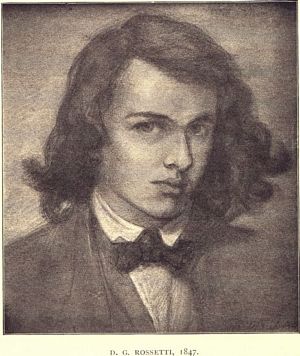
D.G. Rossetti, 1847.
Figure: Chalk and pencil drawing of head and shoulders. A young D.G.R. with
long curling hair faces forward, with his head turned slightly to his
left.
disposition. He adds, however, that “anyone who has addressed him was
struck with a sudden surprise to find his critical impressions dissipated; for
his language was refined and polished, and he proved to be courteous, gentle,
and winsome, generous in compliment, and in every respect, so far as could be
shown by manner, a cultivated gentleman.” Those who have read Mr. Hunt's
affecting account of his own early struggles in the pursuit of art, and realized
the picture of himself there given, will easily perceive that there could have
been but slight affinity at first, as far as externals were concerned, between
himself and the buoyant Rossetti, bursting with animal spirits,
and carried away by the power of fascination and mastery which he exerted over
all who came into contact with him.
As a student in the dry atmosphere of the Academy Antique School Rossetti proved
a failure, and never passed to the higher grades of the Life and Painting
classes. Conventional methods of study were distasteful to him, and the
traditions of the Academy were especially arid and cramping to the imagination.
It will be necessary later on to give some description of the state into which
the art of painting had fallen in England before the fresh minds of the young
and romantic school, breaking away under Rossetti's leadership, caused such a
turmoil and revolution; but in the meantime, at the period we are dealing with,
it is probably correct to say that Rossetti grew tired of, rather than
disapproved of, the teaching in the school, that he was full of ideas craving
utterance on canvas, and that he wanted to paint before he could properly draw.
This impatience caused him to take a momentous and curious step, which certainly
entailed harm to him as a technical executant, though it may indirectly have
furthered his career as an artist. He decided to throw up the Academy training,
and wrote to a painter of whom not many people at that date had heard, but whose
work he himself admired, asking to be admitted into his studio as a pupil. This
was Ford Madox Brown, and for his own particular needs and line of thought
Rossetti could have lighted upon no man more absolutely suitable. Madox Brown
was only seven years Rossetti's senior, but he had studied abroad at Ghent,
Antwerp, Paris, and Rome, and had exhibited during the early forties some fine
cartoon designs for the decoration of the new House of Lords, which—especially
the well-known one of
Harold's body brought before William the Conqueror
—Rossetti had marked out from the rest of the competitive drawings when
they were shown to the public in Westminster Hall. The pictures by Brown which
Rossetti had seen, and which he mentioned in writing, were the
Giaour's Confession
, exhibited at the Academy in 1841,
Parisina
(1845),
Our Lady of Saturday Night
, and
Mary Queen of Scots
, of which he remarked “if ever I do anything in art, it will
certainly be attributable to a constant study of that work”. This,
and other rather florid compliments of the same sort, may well have impressed
Madox Brown, who was not accustomed to be complimented, with a shrewd idea that
he was being made fun of; and the story has been told how, in a suspicious frame
of mind, he armed himself with a stick and went forth to seek his unknown
correspondent. On arriving at the house he
was partly reassured by a door-plate; and the evident sincerity and enthusiasm
of the boy himself, when they met, overcame his generous warm-heartedness, and
made him agree to take Rossetti into his studio, and to teach him painting, not
for a fee, which he declined, but for the sheer pleasure of encountering and
training up a sympathetic spirit. So in March 1848, less than two years after
his admission to the Antique School, and with a clear two years more ahead of
him before he could possibly hope to learn painting by the ordinary course,
Rossetti quitted his
sicca nutrix, the Academy, and installed himself under Madox Brown's guidance at
his studio not very far from the paternal roof in Charlotte Street.
Before following his fortunes further in this direction we must go back over the
ground just traversed and note what Rossetti's activities in literature had
amounted to during the same period. These are no less than astonishing. To take
the greatest first, they include the bulk of the series of verse translations
from the early Italian poets, first published in 1861, and afterwards
republished under the altered title of “
Dante and his Circle.” Although worked on and revised from time to time, these translations
remain in all essentials much as Rossetti compiled them between the years 1845
and 1849, and they rank among the very finest work of the kind in the English
language, being no less remarkable for their high poetic qualities than for the
subtle dexterity of phrase by which the sound and sense of the originals have
been transplanted into a naturally colder tongue. Swinburne, most generous as
well as most far-sighted of critics, has expended himself in admiration of these
essays in an art in which he himself is so eminent; and they were mostly done by
a boy not out of his teens, thrown off in the intervals of a more absorbing
occupation, the study of painting. Rossetti's
translation of the “Vita Nuova” alone might stand as a monument of industry in such a case,
for it breathes a new spirit of language, a voluptuous and exotic style such as
has never been excelled for conveying the emotional mysticism and introspective
sentiment of a southern lover; but to this he added that great mass of verse
translations and sonnets, involving many days and many hours previously spent
over musty volumes at the British Museum in search of Italian poets. Even this
was not all, for between the same years he began a
translation in verse of the Nibelungenlied, the strong passion of which seized hold of him much as it seized hold
upon Wagner, and finished a
translation of Hartmann von
Aue's“Arme
Heinrich”
, which has been
thought worthy of a place amongst his
collected works. Besides these, in 1847, before he was nineteen years old, he
had written his best-known poem,
“The Blessed Damozel”, together with several others, including
“My Sister's Sleep”,
“The Portrait”, and considerable portions of
“Ave”,
“A Last Confession”, and the
“Bride's Prelude”. The performance of these literary efforts is so finished, the sentiment
so profound and mature, that one can hardly understand the ambition which kept
painting in the foremost place and made poetry the
parergon. The ease with which versification came to Rossetti may have blinded him
at first to the merits of his work in this art, as happened later in the case of
William Morris; but that he was not altogether ignorant of its value is shown by
the fact that when he was most in despair over his future he wrote to Leigh Hunt
asking for advice on the question of taking up literature as his profession and
inclosing some of his early poems. Leigh Hunt's reply is extant, and contains a
warm and evidently spontaneous eulogy of Rossetti's poetry, especially of its
thoughtful and imaginative qualities; but, it goes on to say,
“I need not tell you that poetry, even the very best—nay, the best in
this respect is apt to be the worst—is not a thing for a man to live upon
while he is in the flesh, however immortal it may render him in
spirit.” An inquiry made a little earlier into the prospects of
railway telegraphy (!) had proved hardly more promising, though very interesting
to record. Rossetti, therefore, was not encouraged to abandon painting as a
means of livelihood, and having made the arrangement already described with
Madox Brown, settled down with a characteristic mixture of enthusiasm and
despair to the pursuit of art. Brown at this time was engaged upon his
well-known picture of
Wiclif and John of Gaunt
. He was too conscientious a painter himself to suppose that anyone could
acquire the power of painting without previous drudgery, and shattered any hopes
that Rossetti might have cherished in this direction by coupling his permission
to copy a picture with insistence on a study of still-life,—tradition says a row
of pickle bottles.
Much as he owed to him in the way of instruction and sympathetic encouragement,
Rossetti did not remain long in Brown's studio, at all events as a regular
attendant, but left him after a few months to share a studio with Holman Hunt.
The beginning of this intimacy was curious and typical. On the opening day of
the Academy Exhibition (May 1848) Rossetti, says Mr.
Hunt,came up boisterously and in loud tongue made me feel very
confused by declaring that mine was the
best picture of the year. The fact that it was from Keats (the
picture was for
The Eve of St. Agnes) made him extra-enthusiastic, for I think no painter had ever
before painted from this wonderful poet, who then, it may scarcely be
credited, was little known. Rossetti begged to be allowed to visit
Hunt, for at the Academy schools they had barely been acquainted, and some time
later called and poured out his trouble about the pickle jars. Hunt considered
them sound, in the circumstances, but suggested as a compromise that Rossetti
might try to paint one of his own designs, a subject recently contributed to a
sketching society,
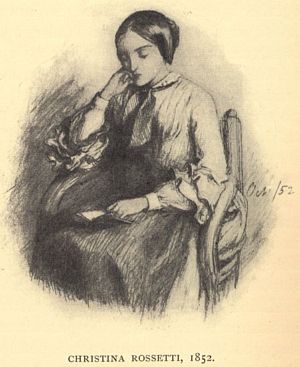
Christina Rossetti, 1852.
Figure: Pencil. Dated right: "Oct/52." 3/4 length oval drawing of Christina leaning her head on her right hand, seated in a chair reading
a book on her lap. The sleeves are flounced at the
elbows.Surtees, p. 184
and by way of practice might fill in all the still-life first. This
proposal was accepted at once, and so with apparent, but probably not actual,
fickleness Rossetti once more shifted his ground, and agreed to work for a time
with Hunt, sharing for this purpose a studio which the latter had just taken in
Cleveland Street, Fitzroy Square. Here (as well as later in a studio which he
took for himself at 83 Newman Street) Brown, whose staunch, unalterable
friendship continued to the end of Rossetti's life, visited him from time to
time, and gave him the benefit of his advice; and here, amid what Mr. Hunt has
described as the most dismal and dingy surroundings, Rossetti began to paint his
first picture. Up to this time he had done little beyond studies and sketches,
including a number of
portraits, some of which show excellent work.
The year 1848 marks his transition artistically from boyhood to adolescence, a
gracious adolescence adorned by many qualities that we too often look for in
vain in an age of tricky cleverness and pernicious skill; an adolescence in
which depth of feeling and height of aspiration transcended the power of
accomplishment, and no artificial or showy mannerisms obscured the honest
endeavour and deep-set seriousness of purpose that characterized, not him alone,
but the whole of the small band of workers with which he presently became
associated. The formation of this band, and the painting of Rossetti's first
picture, bring us to the story of the now famous Pre-Raphaelite movement, and
will more properly serve to begin a new, than to end a preliminary chapter.
IN relating afresh the history of the “Pre-Raphaelite” movement, one has many
precedents to choose from. According to the point of view selected one may see
in it the conscious expression of a great artistic revival, deliberately planned
by a body of zealots, and based upon a structure of lofty principles; or one may
go to the opposite extreme and regard it merely as an exuberant freak, an
irresponsible outburst on the part of a few impulsive youths linked together for
one brief moment by a mutual combination of enthusiasm and high spirits. For
both of these points of view ample authority might be quoted, and the truth as
usual lies somewhere safe between them. For the more emotional and serious
aspect of the case we have to thank Mr. Ruskin, who, finding in the work of the
men in question qualities and tentative aims such as he himself admired,
forthwith, as his manner was, read into it all the high morality of purpose and
principle that he conceived appropriate to ideal craftsmanship. On the other
hand, there have never lacked writers who from personal dislike, or, it may be,
a touch of jealousy, have tried to depreciate both Rossetti's work and his
wonderful influence over others. The facts of the case are, it happens,
abundantly in evidence. From Mr. Holman Hunt, Mr. F. G. Stephens, Mr. W. M.
Rossetti, and from others, who, if not so intimately connected with the movement
as these, were at all events in a good position to know about it, we have
received separate, and on the whole confirmatory accounts of its origin and
aims. No personal feeling or bias any longer obtrudes itself into the matter; we
can see the truth, if we will, in a clear perspective, and nothing remains to
obscure our vision but the amount of distortion that it may have contracted from
impressions formed on writers of the above-mentioned divergent opinions, or from
strongly developed artistic sympathies and prejudices.
The tendency has been on the whole, not unnaturally, to exaggerate the
significance, and to over-estimate the importance of the “Pre-Raphaelite
Brotherhood,” which after all was but the grain of mustard seed from which a
great tree sprung. Looking upon the tree, some are apt to magnify the seed,
forgetting what qualities of climate, soil, or accident may have assisted to
promote its growth. Those who do so, however, must either not have passed
through an impressionable youth themselves, or else have forgotten how naturally
at such a budding age men form romantic coteries based upon common friendships,
common ideals, and common habits of life. In such associations there is nearly
always one dominant personality which gives the tone to the set. A craving for
expression, and more particularly for expression in verse, is also a general
characteristic. The intellectual standing of the members of such a group is, no
doubt, a measure of the value of such expression, but not of its earnestness or
motive power, its romantic affinities, or its influence upon the men so brought
together. Dozens of “Pre-Raphaelite Brotherhoods” are formed every year, at the
great schools and at the universities, tracing lineal human descent from the
classical age which combined Platonic friendship with an enthusiasm for
philosophy. That few or none of them rise to celebrity is not so wonderful as
that one should have attained to
such celebrity. Accident and
circumstance, at least as much as the strong personal qualities of the members
of the group, combined to bring this about; and if argument were needed to prove
it, beyond the witness of the facts themselves, it would be found in the
deprecatory manner in which the leading “Pre-Raphaelites,” and none more than
Rossetti, were accustomed to look back on their turbulent, romantic, and on all
accounts most interesting past.
The formation of the “Brotherhood” came about in the following way. We have
noted the somewhat sudden alliance between Rossetti and Holman Hunt, and their
plan of sharing a studio to carry out work in common. Through Hunt, Rossetti had
become acquainted with Millais, and had joined, or helped to start, a
“Cyclographic Society,” numbering several members, to wit, Thomas Woolner, F. G.
Stephens, Walter Deverell, John Hancock the sculptor, James Collinson, William
Dennis, J. B. Keene, and some four or five besides. The scheme was for members
to contribute drawings to a portfolio which was sent round for all the rest to
criticise. Like other institutions based upon mutual candour, this society
enjoyed a very brief existence, and was mainly of service in weeding out those
who had no sympathy with the new ideas which
were ripening in Rossetti and his friends from those who had. The final
development of these ideas was brought about by a meeting in Millais's home in
Gower Street, where the three alighted upon a
volume
of engravings
after the frescoes in the Campo Santo at Pisa. Ruskin
has spoken scornfully of this work as “Lasinio's execrable
engravings,” but whatever their quality they at least served to show
that in the earlier men, who preceded Raphael, there was a feeling for earnest
work, a striving after lofty expression, which was worth more as an inspiration
than the rigidly mechanical fashion of painting stereotyped subjects which had
come into vogue in England. Why this mechanical cult should ever have become
grafted on to the ill-used name of Raphael, and shadowed by his stately fame, is
a difficult matter to explain, and requires an excursus into the history of
European art. Its effect on the teaching of the day, however, is summed up in
the following incisive passage by Ruskin:
“We begin, in all probability, by telling the youth of fifteen or sixteen
that Nature is full of faults, and that he is to improve her; but that
Raphael is perfection, and that the more he copies Raphael the better;
that after much copying of Raphael, he is to try what he can do himself
in a Raphaelesque, but yet original, manner: that is to say, he is to
try to do something very clever, all out of his own head, but yet this
clever something is to be properly subjected to Raphaelesque rules, is
to have a principal light occupying one-seventh of its space, and a
principal shadow occupying one-third of the same; that no two people's
heads in the picture are to be turned the same way, and that all the
personages represented are to have ideal beauty of the highest order,
which ideal beauty consists partly in a Greek outline of nose, partly in
proportions expressible in decimal fractions between the lips and chin;
but partly also in that degree of improvement which the youth of sixteen
is to bestow upon God's work in general.”
This canting and misdirected worship of Raphael by men who had discarded his
spirit, and the realization that before Raphael there were painters of lofty
aim, may well have determined the title under which the three enthusiasts
conspired to band themselves in revolt. From most points of view it was
unfortunate. It meant very little in actual fact, it was misleading so far as it
did mean anything, and it was responsible for much of the acrimony and abuse
which the devoted trio afterwards brought down upon their most meritorious
efforts. One curious feature
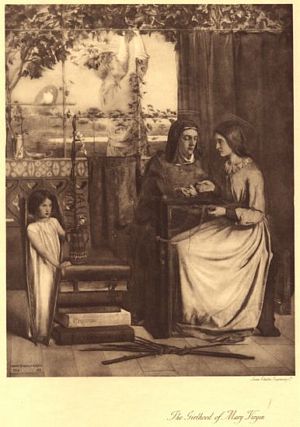
The Girlhood of Mary Virgin
Swan Electric Engraving C
o.
Figure: Oil. Signed and dated lower left corner: "Dante Gabriele Rossetti
P.R.B. 1849." The young Mary, facing to the left and seated in front of
her mother, St. Anne, embroiders a white lily on a piece of red cloth.
The lily she copies is placed a few feet away atop a pile of books, and
is held by a child angel. A trellis runs behind this scene, and behind
it St. Joachim reaches upward to prune a running vine. A Dove and the
lake of Galilee are behind him.
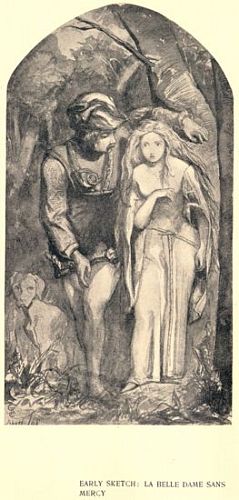
Early Sketch: La Belle Dame Sans Mercy
Figure: Pen and sepia with pencil, arched top. Monogram and date lower left
corner: "April/48." Two whole-length figures in a forest, facing to
front. The man stands on the left, looking at the girl while leaning his
left arm on the tree behind her. She looks to the front, with her long
hair unbound. A dog sits to the man's left.
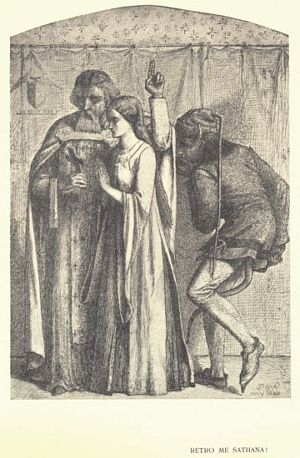
Retro Me Sathana!
Figure: Pen and ink, arched top. Inscription on shield: "Ex Nocte Dies."
Initialled and dated lower right corner: "July 1848." Three full-length
figures before a curtain. On the left, a priest gazes at a cross held in
his right hand, raising his left hand in blessing above the head of a
young woman, who also gazes downward at the cross. A shadowy figure with
horns and a tail sneaks up behind them.
of the matter is that they appear to have possessed between them
at this time a comparatively slight acquaintance with pre-Raphaelite pictures,
not more, perhaps, than the average intelligent visitor to the National Gallery
to-day. Scarcely anywhere in their writings (we must except one article by Mr.
F. G. Stephens) do we find praise, or even mention, of most of the great
pre-Raphaelite painters. Nothing of Mantegna, Botticelli, Bellini, Orcagna, Fra
Angelico, Melozzo, Lippo Lippi, or Piero della Francesca. At a slightly later
date Rossetti visited Bruges, and fell in love with Memling; but his letters
even then reveal some very crude preferences in art. Whatever was perceived or
imagined in the work of the men they decided to follow must have been largely a
matter of instinct, backed up by a strong sympathy for the naïve and simple
charm of the few early Italian pictures which they had seen. Perhaps the fact
that Keats too praised the early painters had something to do with it, for Keats
was a beloved idol with all three, most of all with Rossetti, who had
rediscovered him on his own account when his poetry was practically dead. In
addition, a bond of sympathy may be traced in the fact that the ancient
pre-Raphaelites, like these new ones who took their name, had established a
revolt from the effete and degraded classicism into which Byzantine art had
lapsed. They too had had to seek out nature afresh, by the light of their own
genius, and to invent new laws and new styles as a protest against the
mechanical system enforced upon them. The precedent showed to our reformers a
golden age of painting, crowned with the names of glorious painters, not perhaps
held so glorious then as they are to-day, when many persons outside the ranks of
art have learnt to love their quaint simplicity and to draw from it the noblest
inspirations. It is a mistake to suppose that what Rossetti and his companions
admired or sought to imitate in these old masters was the mediæval and primitive
style of painting. The mediæval quality proved infectious, no doubt, and may
have influenced all more or less at first in the direction of angularity and
awkward composition. But there were other causes which also contributed to this.
Amongst them may be mentioned an idea that for every scene an actual unidealized
room or landscape must be painted, and the figures grouped without reference to
arrangement; as well as another that for each figure a definite model must be
taken and followed even to the extent of blemishes. This counsel of perfection,
if it was ever seriously accepted, was certainly not followed even from the
first; but the fact of its proposal shows the austere lines upon which these
youthful painters proceeded, and helps to
explain what many people have found a stumbling-block, the lack of grace and
harmony in some of their earliest compositions. What they sought to follow in
the old Italian models, however, with all their archaism and immaturity of
skill, was the honest striving after nature, sincerity of style, decorative
simplicity, and, by no means least, the pious selection of worthy subjects. It
is this last quality, exhibited alike by all the members of the Brotherhood,
that more plainly than anything marks the cleavage between their
“pre-Raphaelite” work and the commonplace painting of the day. They set
themselves to paint great and ennobling subjects, often greater than they could
achieve, out of their imagination, when the rest of the world (always excepting
men like Madox Brown, who belonged to them in spirit) were painting what Ruskin
calls “cattle-pieces,” and ‘sea-pieces,’ and ‘fruit-pieces,’ and ‘family
pieces;’ the eternal brown cows in ditches, and white sails in squalls, and
sliced lemons in saucers, and foolish faces in simpers.”
In the inauguration of the Brotherhood Rossetti took a specially
active part, and the title itself was invented by him. One would not be far
wrong in saying that the whole idea was his, and that the two companions who
share the honour of its conception were dragged, enthusiastically enough without
doubt, not for the first or last time at the glowing wheels of his fervid
chariot. “Rossetti,” says one of them—Mr. Hunt, of course, for Millais was
remarkably reticent about those early days—“Rossetti, with his spirit
alike subtle and fiery, was essentially a proselytiser, sometimes to an
almost absurd degree, but possessed, alike in his poetry and painting, with
an appreciation of beauty of the most intense quality.” Millais is
credited in the same sentence with a rare combination of artistic faculty and
British common sense. “He was,” says Mr. Hunt, “beyond
almost anyone with whom I have been acquainted, full of a generous quick
enthusiasm; a spirit on fire with eagerness to seize whatever he saw was
good, which shone in every line of his face, and made it, as Rossetti once
said, look sometimes like the face of an angel.” His whole
after-career shows how completely thisBrother was fascinated and
dominated at the time by the imaginative natures round him, and with what
wonderful results for art. Though younger than his companions in age, in
painting he was already their superior, and his brilliant reputation as a
student was invaluable in the hour of strife; but in imaginative and poetic
qualities he was, compared with Rossetti, deficient, and such poetic
charm as breathes from his early pictures,
and from an occasional later one like
The Vale of Rest
, is unquestionably owing in part to the influences under which he fell,
and to that “spirit on fire with eagerness to seize whatever he saw was
good.” Of the third member of the trio, the writer of the foregoing
appreciations, a fair impression can be got from the autobiographical sketch
which he contributed to the “Contemporary Review” (April, May, June, 1886), in which with almost anatomical minuteness he
lays bare the secrets of his early struggle to win a way betwixt art and
commerce, and his heroic sacrifices for the former. At the time of the formation
of theBrotherhood he was twenty-one years old, and practically
out of his studenthood, his style being already formed on the almost painfully
laborious lines from which it has never deviated. In the sense in which the
“Brotherhood” professed to be pre-Raphaelite,i.e., in adherence to nature and in choice of great subjects,
Holman Hunt was, if the phrase may be permitted, the most eminently
pre-Raphaelite of them all. And he has remained so. The long series of journeys
undertaken in the East for the purpose of acquiring the proper setting and the
true local colour for his scriptural subjects prove that to him at least the
profession of “seeking nature” in its extreme sense was a real one, and not a
passing whim begotten of youthful enthusiasm. Mr. Hunt says, nevertheless, that
the title of “Pre-Raphaelite” was adopted partly in a spirit of fun, and, like
other names which have acquired honour, was originally a term of reproach
invented by their enemies. On this account they prudently decided to keep it
secret, and to let no outward symbol of their union appear beyond the mystic
initials P.R.B., which were to be used on all their pictures and in private
intercourse.
The next step was to enroll sympathetic fellow-members. Besides the three
founders of the Brotherhood, four more or less active adherents were enlisted.
Holman Hunt introduced Mr. F. G. Stephens, who at that time was a painter, but
very soon abandoned art for criticism. Woolner, the afterwards well-known
sculptor, whose contributions to the movement were mainly poetical, was
introduced by Millais, or possibly Rossetti; and the latter certainly was
responsible for the remaining two recruits, his brother and James Collinson.
Collinson, a torpid member at the best, and elected apparently on the strength
of one picture which Rossetti thought “stunning,” was mainly
useful as a butt to the others, who used to make fun of his sleepy nature and
drag him all reluctant from his bed to go for midnight walks. Shortly
afterwards, being seized
with religious propensities, he vacated his
membership and retired to Stonyhurst. Several other intimates and associates
have at one time or another been credited with membership of the “P.R.B.,” but
erroneously, as the survivors declare. Two men who were much in sympathy with
the movement, one of them its more than putative father—Madox Brown and William
Bell Scott—might well have joined it; but the former disapproved of anything
resembling an artistic clique, and the latter had somewhat similar reasons for
not being personally associated with the organization.
For the doings of the Brotherhood, sane and otherwise; for their weekly
meetings; their code of rules; the serious way in which they regarded their
mission, and the jocular way in which they customarily discussed it: for these
and many other interesting details of its career, including the gradual decline
in enthusiasm for its maintenance as the individual qualities of the members
began to develop upon divergent lines, the curious reader will do well to
consult Mr. W. M. Rossetti's “
Memoir.” Mr. Rossetti, not being an artist, was himself elected secretary to
the Brotherhood, and with businesslike care he has preserved in a diary all the
daily and weekly occurrences that came under his notice. These have not yet been
published in a complete form; but no doubt they will be some day, and then there
will be nothing left to tell. Such particulars, however, do not properly come
within the scope of this record, interesting as they may be from a personal
point of view. It is sufficient to say that the weekly attendances of the
Brethren, at first a constant source of pleasure and mutual help, had become
very irregular by December, 1850, that an attempt was made to revive them in
January, 1851, but without effect, and that Millais's election to the Academy in
1853 gave a final quietus to the organization, which for some time previously
had ceased to exist save in name. The ranks of the Brotherhood had not even
remained intact. In addition to Collinson, it had lost Woolner, who went to
Australia when the emigration craze was at its height. To replace the former a
young painter, Walter Howell Deverell, had been nominated, but his election was
regarded by some as invalid. Deverell, whose painting of
Viola and the Duke in
Twelfth Night remains an almost solitary testimony to his genius, unhappily died
young. He possessed many graces of appearance and manner, and was in all
respects a fascinating personality. Behind the Brotherhood, and hitherto
unmentioned, we seem to catch a glimpse of another very gracious, but very
retiring figure, that of Rossetti's sister Christina, who in addition to her deeply
religious and poetic gifts possessed a quiet
fund of humour to be expended on the events that occurred within her little
circle. The decay of the “P.R.B.” is thus recorded by her in a sonnet of
appropriately irregular form.
- “The P.R.B. is in its decadence:
- For Woolner in Australia cooks his chops,
- And Hunt is yearning for the land of Cheops;
- D.G. Rossetti shuns the vulgar optic;
- While William M. Rossetti merely lops
- His B's in English disesteemed as Coptic.
- Calm Stephens in the twilight smokes his pipe,
- But long the dawning of his public day;
- And he at last the champion great Millais,
- Attaining Academic opulence,
- Winds up his signature with A.R.A.
- So rivers merge in the perpetual sea;
- So luscious fruit must fall when over-ripe,
- And so the consummated P.R.B.”
We left Rossetti, in order to describe the formation of the Pre-Raphaelite
Brotherhood, at the point where he had just settled down in a joint studio with
Holman Hunt to paint his first picture. In an enthusiasm for community of
action, and a spirit of devotion to Keats, it had been proposed that each of the
Brethren should illustrate, by an etching, a scene from that poet's “Isabella”. Hunt, however, was already engaged upon his picture of
Rienzi swearing Revenge over his Brother's Corpse
; Millais had work of a less than Pre-Raphaelite character to finish off,
and Rossetti himself was seized with desire to paint a subject which much
commended itself to his intensely mystical and symbol-loving mind,
The Girlhood of Mary Virgin
. The only one of the three, eventually, who touched Keats that year
(1848) was Millais, who achieved a real triumph with the striking picture,
Lorenzo and Isabella
. He had been engaged to the last minute upon his old work, when
suddenly, in the graphic words of Mr. Hunt, about November, the whole
atmosphere of his studio was changed, and the new white canvas was installed
on the easel. Day by day advanced, at a pace beyond all calculation, the
picture now known to the whole of England, which I venture to say is the
most wonderful painting that any youth still under twenty years of age ever
did in the world. Whether posterity will support so overwhelming a
verdict as this may, without disrespect either to the critic or the picture, be
questioned.
Rossetti's picture, as can well be imagined, gave him endless
trouble, and was a source of the most violent
fits of alternate depression and energy. During the painting of it his kindly
mentor, Brown, frequently visited the studio occupied by the pair of Brothers,
and assisted them impartially with advice and technical knowledge. At the same
time, Brown's diary, a document full of dry sardonic humour and quaint touches,
to say nothing for the moment of its pathos, contains many anecdotes of
Rossetti's exasperating changefulness and want of consideration, which show that
kindness did not blind the painter to his pupil's foibles. To Brown's
description of Rossetti, “lying, howling, on his belly in my
studio,” and, at another time, reduced by struggles with impossible
drapery to an almost maudlin condition of profanity, we may add Hunt's
description of how he had solemnly to take his companion out for a walk and
explain that if the interruptions of temper and multiplication of difficulties
did not cease, neither of them would have a picture finished to show alongside
of Millais's—a remonstrance which he says was effectual and taken in perfect
good part.
So by the following spring (1849) all three pictures were ready for exhibition,
and were hung, Millais's and Hunt's in the Academy, and Rossetti's either from
choice or necessity in the so-called Free Exhibition held in a gallery at Hyde
Park Corner. Here it was bought for £80 by the Marchioness of Bath, in whose
family an aunt of Rossetti's was acting as governess; and on her death it was
bequeathed to her daughter, Lady Louisa Feilding. It is now in the possession of
Mrs. Jekyll, one of the daughters of the late William Graham, by whose courtesy
it is reproduced here.
The picture has lately become well known by its re-exhibition at the New
Gallery, and is on many accounts a favourite one with lovers of Rossetti's work.
For delicacy and charm of sentiment there are few to be preferred to it, even
though the work, and especially the colouring, may not be in all respects of the
strongest. Considering the painter's age and want of proper training, it is a
masterly performance. The scene shown is a room in the Virgin's home, with an
open carved balcony at which her father, St. Joachim, is tending a symbolically
fruitful vine. On the right of the picture, shown against an olive-green
curtain, are the figures of the Virgin and her mother, St. Anna, seated at an
embroidery frame. The latter, clothed in dark green and brown, with a nun-like
head-dress of dull red, sits watching with clasped hands the work before her,
whilst the young girl, a most untypical Madonna, in simple grey dress with pale
green at the wrists, pauses with the needle in her
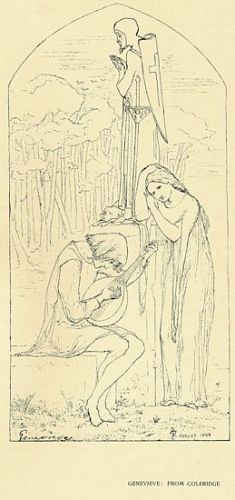
Genevieve: From Coleridge
Figure: Pen and ink, arched top. Inscribed lower left corner: "Genevieve."
Monogram and date inscribed lower right: "August 1848." Two full-length
figures near a statue of a praying knight and his hound. On the left, a
young man seated before the statue plays a lute, gazing downward, while
a young woman faces him, leaning her right side against the back of the
statue's base while she listens to his song.
hand, and gazes with a rapt ascetic look at
the room before her, where, as if visible to her eyes, a child-angel is tending
a tall white lily. Beneath the pot in which the lily grows are six large books
in heavy bindings, bearing the names of the six cardinal virtues. These, and a
white dove perching on the trellis, are amongst the peaceful symbols of the
picture, whilst the tragedy also is foreshadowed in a figure of the cross formed
by the young vine-tendrils and in some strips of palm and “seven-thorned
briar” laid across the floor. Each of the figures, and the dove,
bears a halo, the name being inscribed within it. Rossetti painted the calm face
of his mother for St. Anna, and his sister Christina for the Virgin, giving her,
however, in contravention of the rule mentioned above, golden instead of dark
brown hair. The picture was signed with his name in full and the letters P.R.B.
after it, and the frame bore as legend two sonnets, of which the first, the
well-known one beginning
- “This is that blessed Mary, pre-elect
- God's Virgin.”
was printed in the catalogue. The sestet which follows is explanatory of
the picture:
- “So held she through her girlhood, as it were
- An angel-watered lily that near God
- Grows and is quiet; till, one dawn at home,
- She woke in her white bed, and had no fear
- At all,—yet wept till sunshine and felt awed,
- Because the fulness of her time was come.”
Coincidently with the
picture of
Mary's girlhood
, Rossetti began and finished the oil
portrait of his father, which is
reproduced on page 1. He also drew, one night in 1848,
sitting up till six in the morning to finish it, an exquisite
outline design of a lute-player and
his lady, from Coleridge's “Genevieve.” This was given to his friend, Coventry Patmore, who many years later
exchanged it for some studies by Sir Edward Burne-Jones. On the death of the
latter it was presented by Lady Burne-Jones to Mr. Fairfax Murray, in whose
possession it remains. Other interesting drawings of about this date exist,
among which may be mentioned a curious one done in
pen and ink on green paper as an illustration to Edgar
Allan Poe's “Ulalume.” This, which I have not seen mentioned or catalogued before, was sold
at Foster's in 1888, under the somewhat misleading title of “Welcome,” an auctioneer's blunder for the real name, which is
written on the drawing. Mr. Fairfax Murray
bought, and is the owner of this rarity, as
well as of another
design for “The Raven.”
Two or three other pen-and-ink drawings of 1848 belong to Mr. J. A. R. Munro,
having been originally given to Rossetti's friend, Alex. Munro, the sculptor.
They include
Gretchen in the Chapel
, with Mephistopheles whispering in her ear, and
The Sun may shine and we be cold
, a sketch of a girl with clasped hands, crouching in the embrasure of a
window, apparently a prisoner. Both of these were exhibited in 1883 at the
Burlington Fine Arts Club.
Although 1848 is intrinsically the year of the Pre-Raphaelite movement, much of
the work of the next two years comes within the scope of its influence. As an
example may be given here the
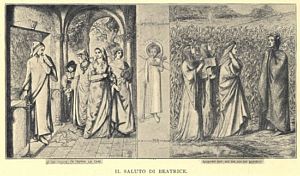
Il Saluto di Beatrice
Figure: Pen and ink, three compartments. Text in left compartment: E cui
saluta fa tremar lo core D.G.R. 1850. Text in center compartment: 9
Guigno 1290 Ita n'e Beatrice in alto ciel Ed ha lasciato Amor meco
dolente. Text in right compartment: Guardami ben; ben son, ben son
Beatrice D.G.R. 1850. A full-length Dantis Amor stands in the central
compartment, holding a sundial and a down-turned torch. In the left
compartment, Beatrice and two women pass through a portico, to the right
of Dante and his servant. Beatrice and Dante look at one another. In the
right compartment, Beatrice followed by two women meets Dante before a
field of lilies. The women approach from the left and appear in profile,
Dante faces 3/4 front towards Beatrice. An angel is seen in the
distance.
important pen-and-ink drawing called
Il Saluto di Beatrice
, representing in two compartments the meeting of Dante and Beatrice,
first in a street of Florence and secondly in Paradise. The left compartment
(from the spectator's point of view) is dated 1849, and bears the legend from
the “Vita Nuova”—
E cui saluta fa tremar lo core. It represents Dante standing in the doorway of a cloister or portico,
overcome by the sweetness of the salutation given him by his lady, who is
passing with her arms linked in those of two girl-friends. In the background is
a statue of a mænad with cymbals. At the feet of Dante is a slab carved with the
outline of a mounted knight. In his hand the poet bears a volume of Virgil, and
through the half-open doorway is caught a glimpse of frescoed walls. The second
compartment is dated 1850, and shows Dante crowned with
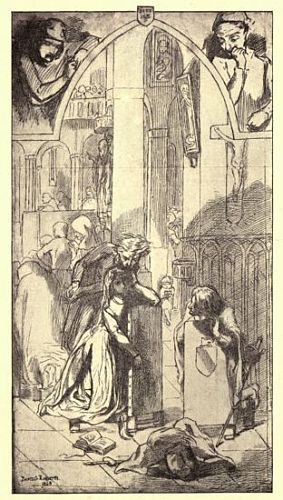
Gretchen and Mephistopheles in the Chapel. Two Designs
Figure: Pen and ink, rounded upper corners. Text in lower left corner:
G.C.D.R. July 1848. Numerous background figures pray in church pews. In
the foreground, a young woman facing forward kneels behind a short dias,
her eyes closed in prayer. A child kneels the right of the dais, and a
sword wrapped in a banner lies before them both. To the right behind
this pair, a devil with horns crouches behind another dais, over which a
woman leans, her hair unbound and her face concealed.
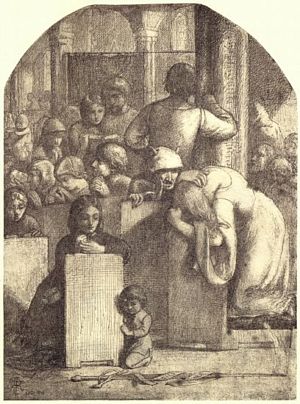
Figure: Pen and ink. Text in lower left corner: Dante G. Rossetti 1848.
Numerous background figures in church pews pray facing backward, while
in the foreground a young woman slouches over a small dais, and a man
with horns stands behind her, bending down towards her ear. To the
right, a second man kneeling behind another dais leans forward, looking
at the woman. The scene is enclosed within an arched architectural
frame, on the outside of which two half-length male figures watch the
scene, one in each of the upper corners.
laurel advancing to meet the forms of Beatrice and her two maidens
in the garden of Paradise. The latter are carrying instruments of music. Behind
the group is a field of swaying lilies, and in the distance a flying angel is
seen. Between the two compartments is a winged figure of Love, with bow and
quiver slung behind his back and a down-turned torch in his hand. Above this
figure is inscribed: “
Ita n' è
BEATRICE in alto
cielo
;” and below: “
Ed ha lasciato
AMOR meco
dolente
.” The title as given is inscribed at the bottom of the drawing. The whole
composition was repeated in
oil in
1859, and the meeting in Paradise formed the subject of more than one separate
drawing. In all of these later versions the direction of the two groups was
reversed, and the central figure of
Dantis Amor
underwent very considerable changes. A full account of these changes, as
well as of the different versions of the subject and their history, will be
found in a
later chapter, under 1859. The
pen-and-ink drawing,
reproduced here, which is the earliest design of all,
belongs to Mr. George Rae, of Birkenhead.
The cream of Rossetti's Pre-Raphaelite work, however, during the two years
subsequent to 1848, is the
Ecce Ancilla Domini
, a sequel in sentiment to Rossetti's picture of the previous year, and
the realization on canvas of the last lines of the sonnet.This is so well known to frequenters of the National Gallery
1 that to describe it would be superfluous. It was
exhibited in 1850 under the same auspices as its predecessor (though the gallery
this year was moved to Portland Place), and was priced at £50. Its appearance
was the signal for a storm of abuse and raillery, which descended with impartial
violence also upon the pictures of the other Pre-Raphaelite brothers exhibited
at the Academy, and which pursued them relentlessly until time and success
finally established their position. Munro, the sculptor, just mentioned, had
incautiously published the meaning of the mystic letters P.R.B., and no peace or
quarter was vouchsafed to those who dared to stand up against traditional
authority.
We are not so conventional now that a new idea or a new style in art could shock
us. The tendency in fact is towards the other extreme. It is consequently
difficult for anyone of this generation to see what in the quiet, shrinking,
girl-like figure of Rossetti's Virgin, in the handsome human-looking angel, or
the simple entourage of that Eastern room, could infuriate and outrage the
so-called critical opinions of the mid-Victorian age. To us, as to
Transcribed Footnote (page 25):
1
Ecce Ancilla is now hung in the Tate Gallery at Millbank.
Ruskin, whose great mind was ever alive to
beauty of thought, however expressed, there seems an especial charm in this new
conception of the oft-depicted scene: the angel, not as usual gay with peacock
wings and trappings, but grave and simply clad; the Virgin, not raised
triumphant on a throne, nor impossibly bedecked with jewels, but waked from
slumber in the early dawn, and crouching half in fear and awe upon a pallet
couch. The white painting, too, is a masterpiece, skilfully relieved by touches
of bright colour, the red embroidery at the bed foot, the soft blue curtain at
the Virgin's head, and through the open window the blue sky and bright sun of a
Syrian morning streaming into the room. Harmless enough, one might have thought
it, even for those who preferred the more garish sumptuousness of the
conventional type; but critics were on the alert to find fault, and with a
unanimity rarely discoverable in art circles they emphatically found it.
Millais's picture of
the boy Christ in
his father's carpenter's shop
was perhaps the best abused of the
three, Hunt's picture being the somewhat unprepossessing
Christian Missionary
. Millais, however, sold his picture; whilst the other two, who needed the
money more, had the mortification, owing to the dead-set made against them, of
receiving their pictures back.
Ancient injustice is an inspiring, but hardly a fruitful theme, and it would
serve no purpose to go again and at length into the nature of the attack made
upon the devoted band of Pre-Raphaelites. Charles Dickens and many other great
men lent their names to it, and the Brethren were compelled to face evil days in
consequence. But in the darkest hour a saviour appeared. Ruskin, who before the
outcry hardly knew of the existence of the school, had his attention drawn to it
by Coventry Patmore, and with characteristic fearlessness and energy plunged
into the fray. A series of letters to the “Times” pointing out the high qualities of the works impugned, and rounding on
their detractors, had the desired result of checking the stream of invective.
Ruskin defended the artists, at all points, from the charge of being ignorant
copyists and realists, the accusation that they could not draw, the alleged
conspiracy against Raphael, and finally from the subtlest insinuation of all,
because it sounded so professional, the charge that they knew not the laws of
perspective. This ardent championship had one curious effect. In his warmth of
defence Ruskin had not only combatted the statement of faults, but had revelled
in laying down an elaborate statement of principles. Thus it came about that the
original ideas out of which the Brother-
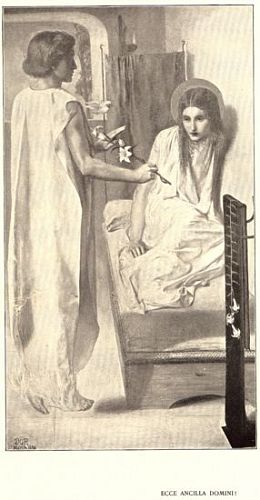
ECCE ANCILLA DOMINI!
Figure: Oil on canvas mounted on panel. Text in lower left corner: DGR
March 1850. A seated virgin in a loose white robe slumps on a bed,
gazing at a lily held by the angel Gabriel. The angel floats to the left
of her bed with flames at his feet, facing the virgin and holding a lily
out toward her. At the foot of the bed a crimson cloth embroidered with
lilies is displayed.
hood had grown, ideas of a broad and possibly
nebulous character, became transmuted into hard and fast rules of conduct and of
practice, which the Brotherhood more or less had to accept, partly perhaps out
of gratitude to their benefactor, partly because they agreed with them in
theory, and partly because they may not have seen how far or how forcefully they
led.
On the other hand, if we are not to credit the “Pre-Raphaelites” with all the
fine sentiments attributed to them in Ruskin's inspired defence, it is absurd to
imagine, as some have done, that they failed to take themselves or their work
seriously because Rossetti in his family letters used to speak flippantly of his
unlucky little picture, which, like a curse, had come home to roost. Men often
enough speak lightly to friends of things which have lain at the heart; and if
Rossetti joked to his brother about “the blessed white eyesore”
and “the blessed white daub,” it is none the less true that he
had striven to put all his thoughts and all his knowledge into it, with such
success that it reveals to us to-day an intensity of feeling and reverence which
few modern painters have emulated, and to which Rossetti in his later work did
not always attain.
A characteristic of the Pre-Raphaelite Brotherhood which has not yet been
touched on, and which here calls for digression, was its remarkable literary
strength. Of the seven original members, two— W. M. Rossetti and F. G.
Stephens—were writers by preference. The former did not paint at all. Gabriel
Rossetti was, as we have seen, a poet before he could be called a painter, and a
poet of the first order. Woolner also was a poet, and in this capacity alone
belonged to the movement. Collinson made a third; Deverell a weak fourth.
Millais and Hunt showed no inclination this way; but, besides those mentioned,
the coterie included Christina Rossetti, William Bell Scott, Coventry Patmore,
and Madox Brown, who wrote occasionally in verse. Even without the need of a
propaganda such a body was almost bound in the nature of things to produce a
school of literary thought allied in sentiment with its artistic ideas and aims.
Hence came about the “
Germ,” that much-prized periodical, which had its origin in the fertile brain
of Rossetti, and which was ostensibly formed to be the organ of the P.R.B., and
to spread its opinions. Rossetti's letters of the period show him actively
engaged in beating up recruits, forcing all with whom he came in contact to turn
journalist, just as later on he tried to force everyone to be a painter—because
he was one—or else a buyer of pictures. It speaks well for his persuasive powers
that he was able
to float the venture at all, for its
financial prospects were never tempting. As it was, he, with his brother as
editor, and his sister, formed the mainstay of the magazine, which ran to four
numbers, and then flickered out, leaving the usual monetary deficit behind.
The title originally proposed for the “
Germ” was “Monthly Thoughts in Literature, Poetry, and
Art;” but at a formal meeting held in Rossetti's studio, 72, Newman
Street, in December, 1849, just as the first number was ready to appear, this
tremendous appellation was rejected, and the simple monosyllable, put forward by
Mr. Cave Thomas, an intimate friend of the group, was substituted for it, with
the added sub-title “Thoughts towards Nature in Poetry,
Literature, and Art.” The first number contained
“My Sister's Sleep” and the prose romance,
“Hand and Soul”, by Rossetti; Woolner's poem,
“My Beautiful Lady”, illustrated by a
double
etching
, the work of Mr. Holman Hunt; a sonnet on “
The Love of Beauty” by Madox Brown; the first instalment of a paper on “
The Subject in Art” by J. L. Tupper; a small poem by Coventry Patmore, called “
The Seasons;” “
Dream Land” and
“An End” by Christina Rossetti; a
sonnet
and a
review of Clough's “Bothie” by W. M.
Rossetti, and
one other poem. Subsequent
numbers contained
“The Blessed Damozel”,
“The Carillon”,
“Sea Limits” (under its first title of
“From the Cliffs”), and six or seven sonnets by Rossetti;
[sonnet
1]
[sonnet 2]
[sonnet 3]
[sonnet 4]
[sonnets 5 and 6] a few sonnets and a prose
dialogue by Deverell;
Note: Marillier misidentifies Deverell's contributions to the
Germ
. Deverell contributed
“The Sight Beyond” (misprinted as “The Light Beyond”) and
“A Modern Idyl” to numbers 3 and 4, respectively.
William Bell Scott's
“Morning Sleep” and
“Early Aspirations”; and an interesting paper on
“The Purpose and Tendency of Early Italian Art” by F. G. Stephens, under the pseudonym of John Seward. Of the four
numbers published of the magazine the first two only were called “
The Germ,” the title in the third and fourth numbers being altered to “
Art and Poetry” at the suggestion of the Tuppers, who as printers of the magazine had
taken over the responsibility on generous terms.
Our interest here is rather with the purpose than with the contents of the
“
Germ.” In it, if anywhere, one would look for a clear exposition of the views
of the young painters, and for their new doctrine of art; but this, so far as it
can be found at all, must be admitted to lack sufficiency. Discounting the
rambling paper by J. L. Tupper, there is
little that can be called doctrinal in any sense beyond the
sonnet by W. M. Rossetti which appeared on
each cover, and a short exordium on the back. The latter was re-written when the
magazine changed its name, and it is matter for some doubt in
which form it is more obscure and worse in
regard to style. As Rossetti was held to have been mainly responsible for the
original draft, I will quote it. The first two paragraphs deal solely with the
contents, and with the prominence given to Poetry. The third runs as follows:
“The endeavour held in view throughout the writings on Art will be to
encourage and enforce an entire adherence to the simplicity of nature
[Nature, in the re-draft, was honoured with a capital N]; and also to
direct attention, as an auxiliary medium, to the comparatively few works
which Art has yet produced in this spirit. It need scarcely be added
that the chief object of the etched designs will be to illustrate this
aim practically, as far as the method of execution will permit; in which
purpose they will be produced with the utmost care and
completeness.”
On the whole, the announcement in “
Art and Poetry” is worse than this. It contains the following paragraph:
“With a view to obtain the thoughts of Artists, upon Nature as evolved
in Art, in another language besides their
own proper
one, this Periodical has been established. Thus, then, it is not open to
the conflicting opinions of all who handle the brush and palette, nor is
it restricted to actual practitioners; but is intended to enunciate the
principles of those who, in the true spirit of Art, enforce a rigid
adherence to the simplicity of Nature either in Art or Poetry, and
consequently regardless (sic) whether
emanating from practical Artists, or from those who have studied Nature
in the Artist's School.”
These two quotations may help to justify the observation already made, certainly
not in a disparaging spirit, that the doctrines of the Pre-Raphaelites took
substance and colour from Ruskin's idealism, and that prior to his defence they
were rather without form and possibly void. The sonnet by W. M. Rossetti, which
was referred to as figuring on the cover of all four numbers, does not greatly
help to clarify or crystallize the ideas of the P.R.B. so far as they existed at
that time. It is as follows:
- “
When whoso merely hath a little thought
-
Will plainly think the thought which is in
him—
-
Not imaging another's bright or dim,
-
Not mangling with new words what others
taught;
-
When whoso speaks, from having either sought
-
Or only found,—will speak, not just to skim
-
A shallow surface with words made and trim,
-
But in that very speech the matter brought:
- “
Be not too keen to cry—‘So this is all!—
-
A thing I might myself have thought as well,
-
But would not say it, for it was not worth!’
-
Ask: ‘Is this truth?’ For is it still to tell
-
That, be the theme a point or the whole earth,
-
Truth is a circle, perfect, great or
small.
”
The “
Germ,” as its brief career sufficiently denotes, fell almost stillborn upon
an ungrateful world; but amongst a small class of artists and admirers it
undoubtedly served to strengthen Rossetti's reputation. There was nothing feeble
or immature about the poetical ideas expressed in it, and one may even be
surprised that such an original piece of work as the
“Blessed Damozel” did not attract greater attention, imperfect as it now seems compared
with the revised and later versions. Both this and
“Hand and Soul” have frequently been reprinted. The latter is valuable, in addition to
its literary qualities, for the light it throws upon Rossetti's mediæval and
mystical mind. To some extent it is no doubt an autobiographical record, a
memory of mental perturbations and experiences which beset the young painter,
striving to preserve and foster the spiritual side of his nature at the expense
of more than commonly strong bodily inclinations. From an abstraction like this
story of the mythical young painter Chiaro dell' Erma, we may feel we get one
truer glimpse of the real Rossetti than any number of life-histories, overlaid
with trivial incidents which obscure rather than reveal his personality, can
give us.
Biographical facts are concrete, intelligible, and common to all men. Their
record tends in general to level genius to the limits of ordinary comprehension.
An imaginative work of genius like
“Hand and Soul”, with its semi-confession of faith, suggests the “something not
ourselves” so subtly that though we cannot grasp it we feel that it
is there, like worshippers at a darkened shrine, which, in all likelihood, were
it flooded with light, would to duller senses appear empty. In Rossetti's case,
almost beyond all others, one does not want to get to the very bottom of things.
He had the seer's eye before he was out of his teens. His curious
three-parts-alien birth stamped him with qualities that no fixed northern type
of mind can adequately appreciate or define. The more one tries, by accumulation
of facts, to realize,
approfondir, these qualities, the more one is likely to fail, and to be brought
up by a dead wall of what we can only regard in our limited way as
inconsistencies, vagaries, and occasional moral deficiencies. As he advanced in
age this became more and more the case. His biographers have felt the
difficulty, but have not always surmounted
it; and so, according to personal bias, they have mostly presented him either as
an angel of generosity or a devil of selfishness, an enthusiastic friend or an
unamiable recluse, a romantic lover or a hardened sensualist. They have tried to
reconcile facts unexplainable in themselves and mutually incompatible. They
have, in a word, sought for motives where they had only to make allowance for
moods; they have tried to impress single-mindedness on a varied, ever-changing,
and kaleidoscopic nature.
Let us be frank, and not try to understand Rossetti. He probably did not fully
understand himself, if he even ever sought to. He has written poems and painted
pictures that charm us by their infinite light and shade, their suggestiveness,
their harmony, their music, their colour, and a hundred subtle qualities not to
be described. Why should we cavil at accents, at occasional faults of drawing,
when there is so much beyond that lies outside of us and above our commonplace?
The art of modern journalism is gradually subjecting all great men and all great
things to the insult of our understanding. Is not this sufficient reason why we
should give thanks to Heaven for one revelation that is cryptic, one man of
passion and genius whom not even biographies as yet have entirely reduced to
common terms?
BEFORE the first number of the “
Germ” had appeared, and while it was in progress, Rossetti, accompanied by
Holman Hunt, paid a short and hurried visit to Paris and Belgium. A rhyming
diary and a series of jocular sonnets, interspersed with a few serious ones,
recall the vigour of his first impressions. A large proportion of the time was
spent at the Louvre and other galleries, rushing through Old Masters at a
furious rate. A sonnet marked each stop. Giorgione's
Venetian Pastoral
evoked the
fine one beginning “Water, for anguish of the solstice,” Ingres's
Ruggiero and Angelica
afforded material for
a second, being, as Rossetti writes, “unsurpassed for exquisite perfection
by anything I have ever seen.” This slightly premature pronouncement
was accompanied by another, which serves to show that Rossetti's taste in art
was still an unfixed and indefinite quantity: “Now for the best,”
he writes, “Hunt and I solemnly decided that the most perfect works,
takenin toto, that we have seen in our
lives are two pictures by Hippolyte Flandrin, in the Church of St. Germain
des Près. Wonderful! wonderful!! wonderful!!!”
Correspondingly emphatic, but abusive, were his
comments on the work of “Rubens, Correggio,
et hoc genus omne,”
- “Because, dear God! the flesh thou madest smooth
- These carked and fretted, that it seemed to run
- With ulcers; and the daylight of thy sun
- They parcelled into blots and glares, uncouth
- With stagnant grouts of paint.”
The monosyllable “slosh,” antithesis in his vocabulary of
“stunning,” and expressive of all qualities condemned by the
P.R.B., was in frequent requisition during this visit, and satisfac-
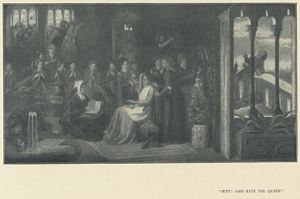
“Hist! Said Kate the Queen”
Figure: Oil. The left half of the painting depicts a room filled with women
sewing and tending the queen, who sits in the right foreground, having
her hair brushed as she listens to one of the ladies reading. Behind the
women, a high portico reveals amorous male revelers. To the right,
another portico reveals a young page on a balcony, reclining on a
railing as he sings to his beloved.
torily disposed of most of the pictures seen. As Rossetti
remarked, it did away with the necessity for detailed criticism.
His own affairs were by no means so easy of disposition.The failure of the
Ecce Ancilla
to find a purchaser at once
1 (it was not sold
until June, 1853), and the storm of unfavourable comment it provoked, caused
him frankly to abandon as unprofitable the mine of semi-religious,
semi-mystical feeling which he had begun to work, and it was some time
before he could settle down to find another. Canvas after canvas
was begun, we are told, and rejected in despair, either because the subjects
ceased to appeal, or because the technique became unmanageable. In their ardour for “Pre-Raphaelite”
principles, Rossetti and Holman Hunt went down for a few weeks to Sevenoaks
to paint natural scenery.
2 The experiment was a failure in Rossetti's case, so far as immediate
outcome was concerned. Feeling his way pictorially towards the field of romance
in which his thoughts wandered, he began to undertake subjects from this class
of literature, from Browning, Dante, Keats, and later from the “Morte Darthur” of Malory. His first experiment was a
large
canvas
illustrating the page's song in “Pippa Passes,” which soon became
Transcribed Footnote (page 33):
1The purchaser was Mr. MacCracken, a Belfast packing
agent, who figures largely in Rossetti's early correspondence as a
patron of all the Pre-Raphaelites. He was not always a generous or
wealthy customer, and had an annoying way of paying for pictures in
kind, i.e., with other pictures. Still,
his connection was a useful one in several ways. Mr. MacCracken depended
for his artistic preferences largely on the judgment of Ruskin, whom he
referred to habitually as “the Graduate.” One of the
earliest references to him occurs in a letter written by Rossetti to
Madox Brown: “MacCracken sent my drawing (water-colour of
Dante drawing the Angel
) to Ruskin, who the other day wrote me an incredible letter
about it, remaining mine respectfully (!!) and wanting to call. I of
course stroked him down in my answer, and yesterday he called. His
manner was more agreeable than I had expected. . . . He seems in a
mood to make my fortune.” Rossetti altered the title of
Ecce Ancilla to
The Annunciation
on selling the picture to Mr. MacCracken, as he thought the
former might smell of Popery to an unenlightened purchaser. The picture
changed hands several times after Mr. MacCracken's death. In 1874 it was
bought by Agnews at the sale of Mr. Heugh's collection, and sold by them
to Mr. William Graham, who sent it to Rossetti to see if he cared to
touch it up. Rossetti writes about it thus in a letter to William Bell
Scott: “Dear Scotus—A little early thing of my own,
Annunciation
, painted when I was twenty-one, sold to Agnew at Christie's
the other day (to my vast surprise) for nearly £400. Graham has
since bought it of Agnew, and has sent it to me for possible
revision, but it is best left alone, except just for a touch or two.
Indeed, my impression on seeing it was that I couldn't do quite so
well now.” Mr. W. M. Rossetti thinks that the lily held by
the angel may have been an addition of this date. Of the
Girlhood of Mary Virgin
, which came back to him in similar circumstances, he wrote:
“It quite surprised me (and shamed me a little) to see what I
did fifteen years ago.”
Transcribed Footnote (page 33):
2 This background, according to Mr. Stephens, was
intended for a
large picture
of
Il Saluto di Beatrice
, corresponding to the left side of the
pen-and-ink diptych on
page 24.
It was used for
The Bower Meadow
in 1872.
impossible and had to be dropped. The
composition of it remains, however, in a little painting called
Hist, said Kate the Queen
, dated 1851, which belongs to Mr. S. E. Spring Rice. The queen is
dressed in lavender grey, and is seated on a chair having her golden hair combed
by attendant ladies. At her feet sits an older lady reading aloud from
Boccaccio, whilst down the room is ranged a row of maidens working at a long
embroidery or seam. An arched window with twisted pillars yields a view of a
group playing ball outside, and to the right of the picture, sitting on a
balcony unseen from the room, his hawk on his wrist, is the love-sick page
leaning back and carolling. The large unfinished canvas remained by Rossetti for
some years in his studio, and was eventually cut up, one portion of it
(including the woman reading) being preserved in the
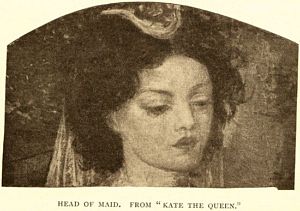
Head of Maid. From “Kate the Queen.”
Figure: Oil. According to Marillier, this is a detail of an original "Hist!
Said Kate the Queen," which was never finished and was later cut up.
Marillier isolates the head of a young woman in a medieval veil and
headress with dark curls. She gazes slightly downward and to her left.
form of a small picture entitled
Two Mothers
, whilst a little head of one of the attendants,
reproduced here, survives in the possession of Mr. W. M. Rossetti.
Mr. Stephens (“
Portfolio Monograph,” p. 28) states that the design of
Kate the Queen
originally formed the centre of an illustration in three parts, executed
in pen-and-ink at an earlier date. I cannot find any verification of this; but a
charming pen-and-ink drawing of
Pippa
by the lady who was afterwards Rossetti's wife, dated 1854, exists, and
was reproduced in the “Letters to William Allingham” (Fisher Unwin, 1897).
Two other designs from Browning which were carried out at this time are the
pen-and-ink drawing from “Sordello” entitled
Taurello's first sight of Fortune
, and
The Laboratory
. In the first, which represents a scene upon the ramparts of the castle
at Messina, the young Salinguerra is being invested by his host, the noble
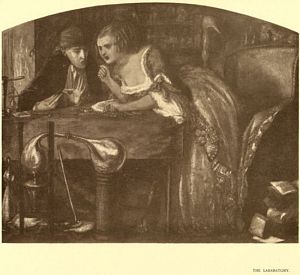
The Laboratory.
Figure: Water color over pen and ink. A man seated behind a laboratory
table shows a piece of metal to a young woman, who leans over the table
to look at it. Books and laboratory apparatus are strewn
about.
King of the Romans, with “the silk
glove of Constance,” which the queen is drawing off. Other
characters in the poem are grouped round. The design was presented by
“his P.R. Brother, Dante G. Rossetti” to Mr. F. G. Stephens,
who owns it still.
The Laboratory
was, in all probability, Rossetti's first attempt at water-colour (it is
painted over a pen-and-ink drawing, as several of his early ones were), and
bears but slight resemblance either in thought or execution to the work by which
he is popularly known. The picture bears the legend:
- “In this devil's smithy
- Where is the poison to poison her, prithee?”
and illustrates the scene described by Browning as typical of the “ancien régime.” The lady of the poem, with passion
in her eyes and clenched hand, rises to take the tiny phial which the alchemist
has prepared for her, and is depositing her jewels and offering the old man her
mouth to “kiss if he will,” before going on to the ball where she is to meet her
rival. The brilliant and striking colour, and the movement of this drawing are
much commented on by Mr. Stephens, and besides reflecting, according to his
judgment, the teaching of Madox Brown and the influences of the Flemish and
Italian pictures just visited, mark the decided opening of Rossetti's second
period.
In addition to these three subjects, chosen, as he put it
with a certain wayward affectation of insincerity, “on account of
their presumptive saleableness,” but also out of his deep
admiration for Browning,
1 Rossetti drew or painted in
the years 1849-50 other themes of a romantic and mediæval nature.
Amongst them was his first illustration to Shakespeare, a scene from “Much Ado about Nothing,” representing the happy lovers,
Benedick and Beatrice
, receiving the felicitations of those who had plotted their match.
Rossetti wrote to his brother on September 3rd, 1850, describing the subject and
announcing his intention of painting it. The water-colour was never executed,
but the author possesses the
pencil design,
reproduced on the next page, which shows the composition and grouping of the
characters.
From the “
Vita Nuova” Rossetti took the incident of
Dante
Transcribed Footnote (page 35):
1The story is too well known to need more than
passing mention, how Rossetti, being one day at the British Museum, and
chancing upon “Pauline, recognized it as being Browning's work, very little of which he
had then seen. He copied the poem out at length, and wrote to Browning,
who in reply admitted the authorship. The two met several times later,
and in 1855 Rossetti painted the
water-colour
portrait of Browning
which forms a companion picture to
his
Swinburne.
drawing an Angel on the Anniversary of Beatrice's
Death
, executed first in pen-and-ink, and originally given to Millais. Mr.
Fairfax Murray now owns this highly interesting and most
“Pre-Raphaelite” drawing, the
water-colour
reproduced here being of later date, 1853. The
latter was bought by Mr. Thomas Combe, of the Oxford University Press, and was
bequeathed by his widow to the Taylorian Museum, where it remains. Both versions
represent the following passage from Rossetti's own translation:
“On that day which fulfilled the year since my lady had been
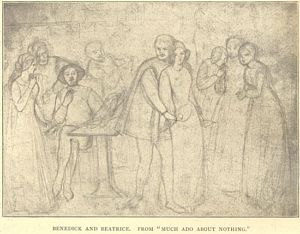
Benedick and Beatrice. From Much Ado About
Nothing.
Figure: Pencil. Depicts the various pairs of lovers onstage at the
end of Shakespeare's play. In the foreground, Benedick stands
behind Beatrice, embracing her.
made of the citizens of eternal life, remembering me of her as
I sat alone, I betook myself to draw the resemblance of an angel upon
certain tablets. And while I did thus, chancing to turn my head, I
perceived that some were standing beside me to whom I should have given
courteous welcome, and that they were observing what I did. Also I
learned afterwards that they had been there a while before I perceived
them. Perceiving whom, I arose for salutation, and said:‘Another
was with me.’ ”
The “
Vita Nuova” also furnished the subject of a small water-colour belonging to Mr. H.
T. Wells, R.A., and attributed to 1849. This represents
Beatrice at the Wedding Feast
denying her Saluta-
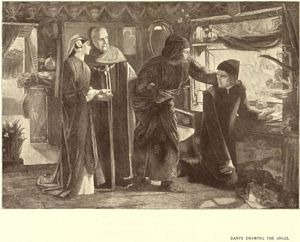
Dante Drawing the Angel
Figure: Water color. Text in lower right corner: D.G.R. 1853. Inside of
Dante's studio, at the picture's right, the artist kneels next to a
window, holding a small sketch. To the left and rear are three
visitors, at whom he looks over his right shoulder. Glaring sunlight
pours in from the open window and doorway.
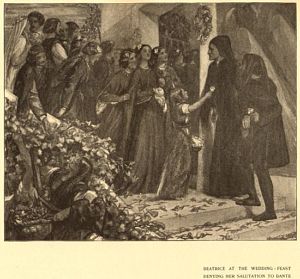
Beatrice at the Wedding-Feast Denying her Salutation to
Dante
Figure: Water color. Dante and his servant stand in profile next to a
wall on the right, as Beatrice and other members of a wedding party
descend a staircase and walk past him on the left.
tion to Dante, who, with a friend grasping his arm as if to restrain him, stands
watching a procession of figures clad in blue and green, and adorned with roses
in their hair. A
replica was painted for Mr.
Ruskin in 1855 (see
page 53, and
note). This is a different subject entirely from
the
Saluto di Beatrice
described and illustrated in the last chapter. The central figure of the
bridal procession is a portrait, easy to recognize, of Miss Elizabeth Eleanor
Siddal, who first came into Rossetti's life at about this date. She,
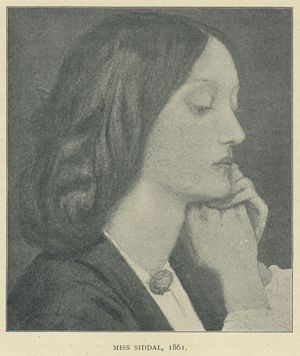
Miss Siddal, 1861.
Figure: Water color. Head and shoulders of Elizabeth Siddal in profile,
facing right. Her left cheek rests on her folded hands.
as one almost fears to repeat, so hackneyed is the story, was the
daughter of a Sheffield cutler, and was employed in a milliner's shop off
Leicester Square, where Walter Deverell discovered her one day when shopping
with his mother. She was persuaded to sit to Deverell for his
Viola
, and later to Rossetti. Her portrait also occurs in a picture by Holman
Hunt and in Millais's
Ophelia.
The story of her marriage to Rossetti and her early death
will be briefly dealt with further on.
Both on account of her romantic history and her individual
attractions, the personality of Miss Siddal
has always exercised a delicate charm over those who love Rossetti. The
portrait in oils painted by herself and reproduced
in Mr. W. M. Rossetti's “
Memoir” (vol. i., p. 175), though not unlike the face in Mr. Wells's
Salutation
, fails to do full justice either to the descriptions of her beauty or to
the imaginative works produced under its influence, as the
Beata Beatrix
. Far more pleasing are Rossetti's sketches of her, some of which I have
reproduced.
[sketch 1]
[sketch 2]
[sketch 3]
[sketch 4]
[sketch 5] For its artistic, not for its personal
interest, I give the following plain description of her by her brother-in-law at
the time when she and Rossetti first met: “Tall, finely formed, with a
lofty neck and regular, yet somewhat uncommon features, greenish blue
unsparkling eyes, large perfect eyelids, brilliant complexion, and a lavish
wealth of coppery golden hair.” With this brilliance of form and
colouring went an unhappy, yet not uncommon, consumptive taint, which rendered
her perpetually delicate.
Miss Siddal was the model for most of Rossetti's earliest and finest
water-colours containing women, and probably for all his Beatrices except the
last. A little later Miss Fanny Cornforth, a favourite model, who sat to
Rossetti until almost the end of his life, began to appear at intervals in his
pictures, notably as the woman in
Found
.
To resume the tale of early work, in 1851 Rossetti continued to be engaged on
small subjects of a mediæval or dramatic character. We have, for instance, the
charming little group called
Borgia
, formerly in the collection of Mr. G. P. Boyce, the well-known
water-colour painter, and
reproduced here by
permission of its present owner, Mr. Hacon. In this the famous Lucretia is seen
seated with a lute in her hands, to the music of which two children are dancing.
Over her shoulders lean on the one side the bloated Pope Alexander VI., on the
other her brother Cæsar, beating time with a knife against a wine-glass on the
table, and blowing the rose-petals from her hair. Lucretia's white gown is of
ample folds, with elaborate sleeves, looped up all over with coloured ribbons
and bows, a device which so took Rossetti's fancy that he repeated it in
Bonifazio's Mistress
(1860). A
pen-and-ink sketch of earlier
date for the
Borgia
group bears simply the legend from “Richard III.,” “To caper nimbly in a lady's chamber to the lascivious
pleasing of a lute.” In this the figures bear a much smaller
relation to the whole area of the scene, which is not well composed. Rossetti
first drew the picture in the same way, but got it back from Mr. Boyce, I
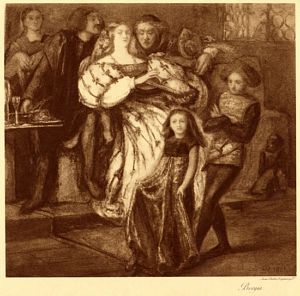
Borgia
Swan Electric Engraving Co.
Figure: Water color. text in lower right corner: D.G.R. 1851. A family
grouping in Lucretia Borgia's chamber. She stands in the center, turned
slightly to her left and wearing a white dress. Two children dance in
front of her, facing left. Behind her stand two men, who peer over her
shoulders at her bosom.
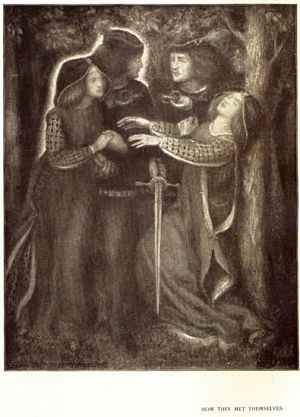
How they Met Themselves
Figure: Water color. Text across bottom: How they met themselves D.G.R.
1864. Illustrating a döpplegänger myth, a pair of lovers meet their
doubles in a wood. All figures are standing, the distressed and swooning
couple to the right of their doubles, who are outlined in
white.
suppose about 1860, and by dint of scraping
it out and adding patches of paper—a form of mosaic in which he excelled—very
greatly improved the design. The
water-colour
was repeated in 1863 for Mrs. Tong, and is now the property of Mr. William
Coltart, of Birkenhead. It was exhibited, together with the
1851 version, at the New Gallery in 1897-8.
In the same year (1851) was produced the first design for a subject of weird and
ghostly conception, called
How they met Themselves
. This depicts a pair of lovers wandering at twilight in a wood, and
suddenly confronted with their own doubles. The lady is fainting; her lover with
a terrified look essays to draw his sword. The apparitions, glancing defiantly
and ominously in their faces, are passing on, outlined with a pale halo of
light. The legend of the Döppelgänger was one of a class of mysterious horrors
which greatly appealed to Rossetti's imagination, and which fascinated him from
boyhood up. Few but he would however have dared to draw it, and fewer still
could have succeeded with it. The
first design just referred to, in pen-and-ink, was destroyed or
lost at an early date; but Rossetti re-drew it for Mr. Boyce in 1860 whilst
at Paris on his honeymoon, and four years later painted two water-colour
versions,
[version 1]
[version 2]
one of which, formerly included in the
Graham collection, and now belonging to Mr. S. Pepys Cockerell, is
reproduced here. It was last seen in
public at the New Gallery, 1897-8.
The other
was lent to the Burlington Fine Arts Club in 1883 by Mr. J. Anderson Rose. It
is, according to Mr. Fairfax Murray, rather the finer of the two, and is now in
California. The
pen-and-ink version dated 1851-1860
was exhibited at Burlington House in 1883, the year after the artist's death. It
was one of a number of subjects which Rossetti had photographed from time to
time in order to distribute copies to his friends.
This shows Giotto as a young man, rather modern looking, seated on a scaffold
before the wall of the Bargello, and painting the famous portrait of Dante which
was discovered on removing the plaster from the wall in 1839. This incident was
impressed upon
Transcribed Footnote (page 39):
1See a note upon the sale of this picture, page 53.
An earlier
sketch for it was exhibited at
the rooms of the Old Water-Colour Society, 121, Pall Mall, at the winter
exhibition of 1852, and (if Mr. Sharp is right in his date) as far back
as 1850, at the Portland Place Gallery. Mr. Sharp is certainly wrong in
saying that the water-colour itself was exhibited then, as it is dated
September, 1852.
Rossetti as a boy, a
copy of the portrait made by one of the discoverers having been sent
to his father, and having passed into his own possession. Giotto is in dull red,
with brocaded sleeves turned back. To his left is seated Dante in green, with
violet sleeves and the red hood, cutting a pomegranate in his hand, and gazing
down with a rapt expression to where Beatrice, with eyes intent on a book of
devotions, is passing in a church procession. Her ruddy golden hair strikes a
bright note at the bottom of the picture. Behind Giotto stands his master,
Cimabue, in a robe of blue, watching the work which is to eclipse his; and
behind Dante, in a gorgeous apparel of gold-embroidered black, leans his rival,
Cavalcanti, holding in his hand a book of Guinicelli, symbolizing thereby the
three generations of poets. Brushes, pigments, and a flask of oil are
discernible in the box on which Giotto is seated. A palette lies beside him, and
instead of using a mahl-stick he is steadying his wrist with his other hand.
Numerous accessories, such as a lute with bright blue ribbon and pomegranates in
a napkin, are scattered upon the platform.
The subject is intended to give expression to the following lines from Canto XI.
of the
Purgatorio on the waxing and waning of fame:
- “Credette Cimabue nella pintura
- Tener lo campo; ed ora ha Giotto il grido,
- Sì che la fama di colui oscura.
- Così ha tolto l'uno all' altro Guido
- La gloria della lingua; e forse è nato
- Chi l'uno e l'altro caccerà del nido.”
This picture, we are informed by Mr. W. M. Rossetti (“
Letters and Memoir,” vol. i., p. 163), was intended only for the centre of a triptych, on
the sides of which were to be represented Dante, as one of the Priori, banishing
the factious chiefs from Florence, and next Dante, mocked by the clown, in exile
at the court of Can Grande. The
rest of the
subject
was never painted. Mr. MacCracken was at one time in treaty
for the water-colour, which however passed into the possession of Thomas Seddon,
the artist, one of the early friends of the group. A few years ago it was sold
at auction, and realized no less a sum than £630, being more than sixty times
the amount originally paid for it to the artist. The present owner is Mr. John
Aird, M.P.
Nothing else of importance is catalogued under the year 1852, but in 1853 we
come to one or two well-known designs and pictures. First may be mentioned the
pen-and-ink drawing entitled
Hesterna
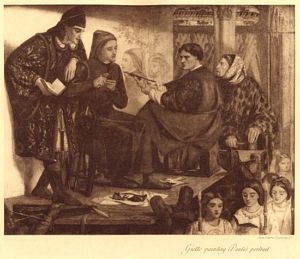
Giotto painting Dante's portrait
Swan Electric Engraving Co.
Figure: Water color. Set on a scaffold in Giotto's studio, on the right
Giotto is seated, painting Dante's profile as an old woman looks over
the artist's shoulder. Dante sits to the left, and Guido Cavalcante
stands behind him, leaning on his shoulder and holding an open book. In
the lower right corner, below the scaffold, Beatrice and several other
female figures walk past, holding lighted candles and open
books.
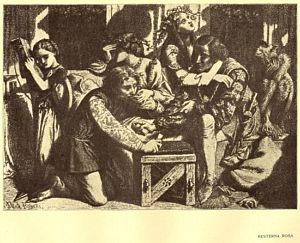
Hesterna Rosa
Figure: Pen and ink. Text in lower left corner: Dante Rossetti. Inside a
tent, two men kneel and sit next to a short bench, perhaps gambling. A
woman stands behind each of them, one gazing skyward, and the other
turning her head and hiding her face. To the left, a young girl holds a
lute, and to the right, a monkey scratches itself.
Rosa
, still in the possession of Mr. F. G. Stephens,
to whom it was presented.
1 This was founded upon the plaintive song of Elena in Sir Henry
Taylor's “Philip van Artevelde”:
- “Quoth tongue of neither maid nor wife
- To heart of neither wife nor maid,
- ‘Lead we not here a jolly life
- Betwixt the shine and shade?’
- Quoth heart of neither maid nor wife
- To tongue of neither wife nor maid,
- ‘Thou wag'st but I am sore with strife,
- And feel like flowers that fade.’”
The scene as shown in the illustration represents two gamblers throwing
dice, and their mistresses, one of whom in a fit of shame is covering her face.
She is the “yesterday's rose.” The other clasps her arms round
the neck of her lover, and is singing a merry song. An innocent little child
near by is touching a lute, and Rossetti has completed the other aspect of the
scene by putting in an ape scratching itself, a Düreresque touch which he added
also in the little
Borgia
group. This drawing was shown at the Pre-Raphaelite Exhibition in
Russell Place, 1857, at Burlington House in 1883 (No. 334), and at the New
Gallery in 1897-8 (No. 19). A
water-colour
version of the same subject was painted for Mr. Craven, of Manchester, or
acquired by him, in 1865. This was exhibited at the Manchester Exhibition, 1882,
and at the New Gallery, 1897-8. Rossetti's own description of the picture says:
“The scene represented is a pleasure tent, at the close of a night's
revel, now growing to dawn. . . . The effect is that of a lamp-light
interior towards dawn, when (as also in twilight) all objects seem purely
and absolutely blue by the contrast with the warm light therein.” A
larger version, bearing the title
Elena's Song
, was painted in 1871.
The little water-colour sketch called
Carlisle Wall
, in the collection of the late Mr. Virtue Tebbs, belongs to 1853. It was
simply named
The Lovers
originally, and the inscription states that it was done at Carlisle. Mr.
Tebbs himself gave the picture the name it bears, probably because the rich
sunset effect behind the lovers on the tower suggested to him the ballad line,
“The sun shines red on Carlisle wall.” The picture first
belonged to Madox Brown, and passed through two other hands at least before it
reached its late owner. It was exhibited at Burlington House in 1883, and again
at the New Gallery in 1897-8.
Transcribed Footnote (page 41):
1 The real date of the drawing is probably 1850. It was
altered later and inscribed as “drawn in 1853.”
This sketch was made during the course of a visit to William Bell Scott at
Newcastle in June and July of 1853. Rossetti had made Bell Scott's acquaintance
in the same way as he made Browning's and Madox Brown's, by the simple process
of writing to him. He had seen some verses that he admired, and that was enough.
For many years, indeed to the end of Rossetti's life, Bell Scott remained a
staunch and helpful friend. Why in his reminiscences he should have recalled so
many things to his friend's discredit
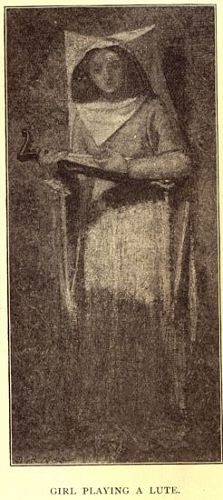
Girl Playing a Lute.
Figure: Water color. A young girl in medieval dress plays a lute. Full
figure, facing front.
and forgotten so many that were pleasant is hard to explain. At the
period in question Rossetti must have been a delightful companion for anyone
with a sense of humour and a not too rigid devotion to rules. His letters are of
the gayest kind, rather in contrast to his pictures, which were apt from the
very first to be sombre. He chaffs his sister Christina unmercifully for her
supposed melancholy disposition, and illustrates his point with caricatures; his
letters about patrons are almost scandalously flippant, and he makes fun of all
his friends in turn with youthful impartiality and candour. That he was adored
in his own circle is certain. The sober Hunt, when the emigration craze had
begun to lay hold of the little group of struggling friends, and threatened to
involve him also, thought first of the wrench of leaving Rossetti. “I
know him,” he wrote, “to be in the same land somewhere, and
that at any time he can be found out and spoken with if necessary, and that
is enough.” Deverell worshipped him, and we shall see a little
further on what Madox Brown, testy and sharp-tempered as he was, could put up
with for his sake. This was the real Rossetti, before ill-health and a long
course of vitiating drugs had wrecked his nervous system, and this is the
Rossetti that we have to imagine in connection with one of the most brilliant
groups of literary men and artists that this country has ever produced.
During his stay with Bell Scott Rossetti did not paint much.“I have
made,” he writes, “a little water-colour of a woman in
yellow, which I shall be able to sell, no
doubt”—probably the
sketch of a girl
playing a lute, owned by Mrs. Constance Churchill, a friend of Ruskin's. After
leaving Newcastle and the north he went to Coventry and walked thence to
Stratford, an exceptional feat of energy for him. At Coventry he made a vigorous
and amusing little
pen-sketch of a girl trundling a
baby
in a sort of barrow, which fetched several guineas at the late
Mr. Boyce's sale. This glimpse at the lighter side in art was also exceptional,
and he emphasized it by writing to a relation: “Would it not make a
capital picture of the domestic class, to represent a half dozen of girls
racing the babies entrusted to their care—babies bewildered, out of breath,
upset, sprawling at bottom of the barrow, etc., etc.!” A harrowing
picture it would have been for mothers.
In connection with Mr. MacCracken he writes: “I replied to what he said
about
The House of John
and told him that I should have no objection to paint something else
instead, mentioning the two pictures I had in contemplation, viz., the
Magdalene at the door of Simon
and the town subject. . . . I also offered him the
Dante
water-colour, begun in London, for thirty-five guineas. This last he
snatches at. . . .”
The “Dante water-colour” was the advanced version of his pen-and-ink
design,
Dante drawing the Angel on the Anniversary of Beatrice's
Death
(
reproduced page 36). After multitudinous
negotiations this drawing actually passed into MacCracken's hands, and at his
sale, in May, 1855, was bought by Mr. Thomas Combe, of Oxford. Rossetti, before
the picture left him, worked on it for several months, improving it so much
beyond his original idea that he says, “the stipulated thirty-five
guineas is absurdly under its value now, and I think I must give MacCracken
to understand as much.” In an explanatory letter, such as he was
fond of sending with his pictures, Rossetti says that he had had “an idea
of an intention of the possibility of a suggestion” that he would
turn the lady visitor into Gemma Donati, whom Dante afterwards married, and so
he meant to paint the Donati arms on her dress, but gave it up as impracticable.
He also had a notion of connecting the same personage with the “Lady of Pity”
who occurs in the “
Vita Nuova,” and whom he painted more than once later.
Of the other subjects mentioned above,
Mary in the House of St. John
was not committed to paper until about 1856, and
Mary Magdalene
a year later. The “town subject” is obviously
Found
. It is the starting of this great picture that makes the year 1853
chiefly memorable in connection with Rossetti.
Tradition has always had it that the subject—a countryman or drover recognizing
in a fallen woman of the streets his own lost sweetheart—was founded on a ballad
by William Bell Scott called “Rosabell”. Scott himself, in his strangely sour reminiscences, makes out some kind
of grievance against Rossetti for professing to paint the poem
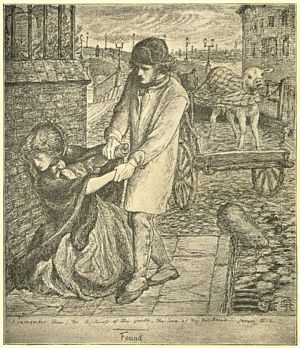
Figure: Pen and ink. Text across bottom: I remember thee; The kindness of
thy youth, the love of thy betrothal. Jerem. II. 2. Text at center
bottom: Found. Text in lower right corner: D.G.R. On the left, a young
woman on a sidewalk crouches against a wall, turning her face away from
a man on the right who grasps her arms, apparently trying to pull her to
her feet. Behind him, to the right, the man's calf is trammeled to a
cart.
and then not doing so; but in point of fact hardly any connection
exists between picture and poem beyond the root of the subject-matter, and the
picture was begun before the incident which Bell Scott mentions in support of
his complaint.
Found
was commissioned by MacCracken in 1853, and studies were made for it,
notably the
pen-and-ink sketches belonging to Col.
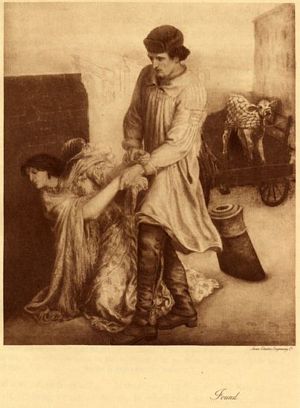
Found
Swan Electric Engraving Co.
Figure: Oil. On the left, a young woman crouches against a wall, turning
her face away from a man on the right who grasps her arms, apparently
trying to pull her to her feet. Behind him, to the right, the man's calf
is trammeled to a cart.
Gillum and Mr. Fairfax Murray, the latter of
which is
reproduced here. There were also various
drawings for the figure of the man and the girl; but the picture was not
properly begun until the following September, when Rossetti started painting the
brick wall, at Chiswick, where his friends the Keightleys lived. A month later
he installed himself with Brown, near Finchley, for the purpose of painting the
calf in the cart which the countryman is taking to market. The details of this
visit, and its inconvenience, are given in a characteristic passage from Brown's
diary, which is so interesting for the general light thrown on Rossetti's
methods and his easy-going relations with his friends, that I hope I may be
excused for transplanting it from the collection of letters published by Mr.
George Allen under the title “Ruskin, Rossetti, and Pre-Raphaelitism”:
“1854,
September 5th. On Saturday . . . Rossetti came
in the middle of the most broiling sun. I knew he must have come to get
something. He wanted costumes to paint a water-colour of the Passover,
this instead of setting to work on the picture for which he has been
commissioned by McCrack since twelve months. His aunt has, moreover,
given him £30, so that it is not for want of money. However, whatever he
does is sure to be beautiful. But the rage for strangeness disfigures
his ideas. . . .”
“
October 6th. Called on Dante Rossetti. Saw Miss
Siddal, looking thinner and more deathlike and more beautiful and more
ragged than ever; a real artist, a woman without parallel for many a
long year. Gabriel as usual diffuse and inconsequent in his work.
Drawing wonderful and lovely Guggums one after another, and his picture
never advancing. However he is at the wall, and I am to get him a white
calf and a cart to paint here; would he but study the
golden one a little more. Poor Gabriello. . . .”
“
November 12th. Gabriel . . . getting on slowly with
his calf. He paints in all like Albert Dürer, hair by hair, and seems
incapable of any breadth; but this he will get by going over it from
feeling at home. From want of habit I see Nature bothers him, but it is
sweetly drawn and felt.”
“
November 27th. Saw Gabriel's calf; very beautiful, but
takes a long time. Endless emendations, no perceptible progress from day
to day, and all the time he wearing my greatcoat, which I want, and a
pair of my breeches, besides food and an unlimited supply of
turpentine.”
“
December 16th. Gabriel not having yet done his cart,
and talking quite freely about
several days yet,
having been here since the 1st November, and not seeming to notice any
hints. . . . Emma being within a week or two of her confinement, and he
having had his bed made on the floor in the parlour one week now and not
getting up till 11, besides my finances being reduced to £2 12
s. 6
d. which must last till 20th
January, I told him delicately he must go, or go home at night by the
'bus. This he said was too expensive. I told him he might ride to his
work in the morning and go home at night. This he said he should never
think of. . . . So he is gone for the present.”
Found
was never finished. “It was,” writes Mr. W. M. Rossetti,“a source of
lifelong vexation to my brother and to the gentlemen, some three or four
in succession, who commissioned him to finish it.”
1
Transcribed Footnote (page 45):
1 In a letter of November 13th, 1859, occurs the
following: “Leathart of Newcastle has written me this morning
settling a commission which he has now given me for the
Found
, at 350 guineas.”
The perspective, always in elaborate
compositions a difficulty for Rossetti, resolved itself into a checkmate at an
early period, and though the figures were altered, and though Mr. Frederick
Shields once made special studies for the pavement edges, nothing could be
satisfactorily done with it. The wall, the girl's head, and the cart with the
calf remained as an eloquent testimony of Rossetti's intense efforts to produce
a really valuable modern picture, with a lesson in it, and these were of course
priceless as mementos of his early work. Moreover, in his latest years he
practically completed the group; so, after his death, Sir Edward Burne-Jones
consented to give
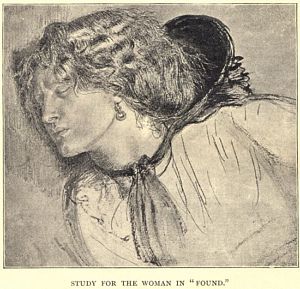
Study for the Woman in Found.
Figure: Pen and ink with slight wash. Head and shoulders of a woman leaning
on her right shoulder, her head turned to the right, with her eyes
closed and her bonnet falling down on her shoulders.
a sort of finish to the picture by washing in blue sky, and this he
has done all over the space where the churchyard railing was meant to come,
showing that even this had been left blank. The pen-and-ink design
reproduced here will make the details clearer. In its
half-completed state the picture passed into the possession of Mr. William
Graham, who had last commissioned it, and after his death it went to
America.
Of the two finished pen-and-ink studies mentioned as
belonging to Col. Gillum and Mr. Fairfax Murray, the former is probably the
earlier.
1 It was exhibited at the Hogarth Club in 1859, at
the
Transcribed Footnote (page 46):
1 There is a larger drawing than either of these in
the possession of Mr. Rossetti, but it is of later date and probably
done by an assistant.
Burlington Fine Arts Club in 1883, and again
at the New Gallery in 1897-8. Both are inscribed in Rossetti's hand with the
verse from Jeremiah: “I remember thee, the kindness of thy youth, and the
love of thy betrothal.” The following
sonnet, one of Rossetti's latest ones, from “
Ballads and Sonnets,” also describes the picture:
- “ ‘There is a budding morrow in midnight:”—
- So sang our Keats, our English nightingale.
- And here as lamps across the bridge turn pale
- In London's smokeless resurrection-light,
- Dark breaks to dawn. But o'er the deadly blight
- Of love deflowered and sorrow of none avail
- Which makes this man gasp and this woman quail,
- Can day from darkness ever again take flight?
- “Ah, gave not these two hearts their mutual pledge,
- Under one mantle sheltered 'neath the hedge
- In gloaming courtship? And, O God! to-day
- He only knows he holds her;—but what part
- Can life now take? She cries in her locked heart,
- ‘Leave me—I do not know you—go away!’ ”
There was something in the air at the time which caused this everlasting and
painful human problem to take strong hold of the entire group of
“Pre-Raphaelite” poets and painters. Bell Scott, as we have seen, treated it
pretty openly in his poem called“Rosabell” or “Mary Anne”. Holman Hunt painted it in a much-discussed picture,
The Awakened Conscience
. Rossetti sought to give expression to it in
Found
, and also in a different manner in
“Jenny”, one of the earliest of his poems. The theme comes out in other work of
his besides, as, for instance, in the
Gate of Memory
and in the drawing called
Hesterna Rosa
. Difficult as it is to treat delicately, the subject in Rossetti's hands
never falls below a lofty level of reverence and pathos. Hood was not more
sympathetic or pure-minded in his treatment of it. That
“Jenny”, which breathes the very spirit of pitiful tenderness, should have been
attacked later on the grounds of impurity is one of those incongruities of the
journalistic mind which cannot rationally be accounted for.
A short note on Rossetti's movements during the period just covered may be
useful. We left him in 1848, after a few months' work at Madox Brown's, sharing
a studio with Holman Hunt in Cleveland Street, Soho, and painting at the
Girlhood of the Virgin
. This picture was finished in a studio which he shortly afterwards took
for himself at No. 72, Newman Street, over a dancing academy familiarly referred
to as “the hop shop.” The proprietor of the
house going bankrupt, Rossetti's goods and
those of a friend, the American poet Thomas Buchanan Read, by the harsh law of
the time underwent distraint in August, 1850. Upon this Rossetti moved two doors
away to No. 74 in the same street, where he remained until the beginning of
1851, when he took in common with Deverell the first floor rooms at No. 17, Red
Lion Square—the rooms which Morris and Burne-Jones occupied subsequently from
1856 to 1859, and which served as a cradle for the famous firm. I forget which
group of occupants it was that fled these rooms on account of “the bugs of
Bloomsbury,” but in May of 1851 Rossetti gave notice to quit them, and for a
time quartered himself once more upon Madox Brown at No. 17, Newman Street, near
his old studio. It was at this time that he sat to Brown for the portrait of
Chaucer, in the great picture of
Chaucer reading his Legend of Custance at the Court of
Edward III
., now in the Sydney Museum. The sitting was done in one night, lasting
till four o'clock in the morning, and the head was not subsequently touched. Mr.
William Rossetti says that his brother at the time was held to resemble Chaucer,
also to some extent the Stratford bust of Shakespeare. He is most inclined,
however, to agree with Mr. Knight, who suggests a resemblance to Salvini.
Rossetti's next move was a more permanent one. In November, 1852, he took a set
of rooms at 14, Chatham Place, Blackfriars, on a site now cleared away,
overlooking the river and presenting other advantages. Here he remained for
nearly ten years, including the brief two years of his married life, and here he
accomplished what many judges consider the most interesting portion of his work.
To those who knew Rossetti in his youthful days the Blackfriars rooms are a keen
and poignant memory, bound up with one of the most attractive personalities it
could ever have been their fortune to meet, and sweetened by the recollection of
that other gracious presence, the frail and beautiful Miss Siddal. When Rossetti
took these rooms he gave up, for the first time, living at home with his father
and mother in Arlington Street, Mornington Crescent, whither the family had
removed from Charlotte Street in 1851. He had, therefore, acquired a certain
measure of independence as a painter, which went on increasing with each
successive year as generous or wealthy patrons attached themselves. That his
progress in this respect was slow, and that for many years he was reduced to
selling water-colours of priceless beauty for comparatively trifling sums, was
the result partly of a determination which he formed never to exhibit
his work or allow it to be exhibited by others. This resolve,
which later on became a sort of mania, is said to have been due in the first
instance to the discouraging reception of
Ecce Ancilla Domini
in 1850. For a long time, of course, it prevented his being known at all
or appreciated by possible purchasers, and his work circulated amongst a narrow
circle of artistic friends, or was bought up by casual and temporary patrons, of
whom he was lucky in securing a
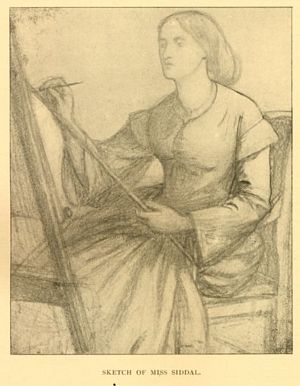
Sketch of Miss Siddal.
Figure: Pencil. 3/4 length seated figure, facing an easel, head turned to
the right. She holds a paintbrush in her right hand, and a maul-stick in
her left.
fairly continuous series. In the days of his greatness it may have had
an opposite effect by arousing curiosity, and producing a feeling of pique.
Buyers were attracted towards a man who was notorious for despising the public
eye, and whose work was spoken of with bated breath as something supremely
precious. Those were not altogether Rossetti's best days. More patronage at the
start would have increased the quantity and importance of his work during the
period of his greatest inventiveness; whilst a little less at the finish
would have removed the temptation, after his
powers had begun to fail, of turning out replicas which did not interest him,
and of which a good number, there is cause to suppose, were not even done by
himself.
There were a few exceptions to his rule of seclusion which may as well be
mentioned here, though they involve some anticipation of future chapters. In
1857 a small “Pre-Raphaelite Exhibition” was organized at No. 4,
Russell Place, Fitzroy Square, to which Millais, Holman Hunt, Madox Brown,
Arthur Hughes, W. L. Windus and others all sent pictures. Rossetti exhibited a
water-colour
Dante's Dream
,
Dante drawing the Angel
, the pen-and-ink
Hesterna Rosa
, a
Mary Magdalene at the Door of Simon
, and a very beautiful little water-colour done in this year, the
Blue Closet
. In 1858, at the annual exhibition of the Liverpool Academy, a body
which for many years was staunchly faithful to the Pre-Raphaelites, and which
died for its allegiance, Rossetti exhibited the
Dante's Dream
again and two other water-colours, the
Christmas Carol
and
Wedding of St. George
. In this year the old Hogarth Club was founded, and Rossetti at first
took some interest in its exhibitions. The earliest version of
Lucretia Borgia
was exhibited under these auspices, as was also the oil portrait
called
Bocca Baciata
, and possibly other things as well. In 1862 the Royal Scottish Academy
in Edinburgh held an exhibition to which Rossetti sent for sale, from his studio
in London, a study for
Found
called
The Farmer's Daughter
and a head in oils called
Fair Rosamund
. A few other pictures were exhibited in Glasgow (1878 and 1879),
Liverpool (1864), and Edinburgh (1877); and the great Loan Exhibition in
Manchester in 1882, the last year of Rossetti's life, included no fewer than
nine subjects by his hand—the greatest number ever exhibited together up to that
date. With these exceptions, and possibly one or two others of minor importance,
it is essential to remember that Rossetti's work was absolutely unseen by the
public, who became acquainted with him as a poet long before they knew him even
dimly as a painter. The effects of this ignorance are still discernible. Even
after two great exhibitions of his works in London, and after the publication of
a wide selection from his designs, there are people who believe that Rossetti
never painted but from one model, and that all his pictures are distinguished by
impossible lips and a goitrous development of neck.
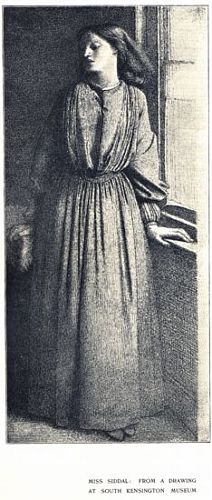
Miss Siddal: From a Drawing at South Kensington Museum
Figure: Pen and ink. Full-length figure standing, with her face turned to
her right. Her left hands rests on a window ledge, and her right hand is
on a table slightly behind her.
WITH the year 1854 Rossetti's life entered upon a new phase.
This was the first year of his memorable connection with Ruskin, some details of
which have recently been placed before the world in the form of letters. At the
same time he had by now engaged himself to marry Miss Siddal, whose
companionship and whose health became, for the next eight years, the most
absorbing facts in his private life. To speak of Ruskin first, his was no
ordinary friendship, but a curious combination of patron, friend, and mentor,
not a little suggestive of the benevolent god in the background of a classical
drama. If Rossetti had been a common man, living an orderly life and working on
regular lines, such a connection would have been, as he jocularly described it
at first, “in a way to make his fortune.” For Ruskin was willing
to buy within certain limits almost everything that Rossetti produced, or to
sell it to others, and was ever ready to propose congenial themes. Furthermore,
having taken a great fancy to Miss Siddal, and admiring her poetic and artistic
gifts, which had grown in a remarkable way under Rossetti's tuition, he tried to
make an arrangement whereby he should purchase all her work also, paying a
minimum sum of £150 a year. For a long time, in fact, this arrangement was
carried out. In Miss Siddal's precarious state of health, necessitating constant
change with periods of rest, such a proposition was obviously a tactful way of
offering to contribute towards her expenses; and there is no doubt that Ruskin's
help at this critical period was invaluable, and that without it the young
couple would have suffered even more struggling times than they did. For
Rossetti was hopelessly and heedlessly unthrifty, flush of money one day,
out-at-elbows the next, borrowing from the needy Brown, putting off the day of
repayment, and invariably anticipating
with the greatest ingenuity any money to be
earned from commissions. One of the Ruskin letters, besides being typical in
itself of the writer, throws a momentary flash of light upon this butterfly existence:
“? Oct
., 1855.
“DEAR ROSSETTI,
“You are a
very odd creature, that's a fact. I said I
would find funds for you to go into Wales to draw something I wanted. I
never said I would for you to go to Paris, to disturb yourself and other
people, and I won't. . . .
“I am ill-tempered to-day—you are such absurd creatures both of you. I
don't say you do wrong, because you don't seem to know what
is wrong, but do just whatever you like as far as possible—as
puppies and tomtits do.However, as it is so, I
must think for you—and first, I can't have you going to Paris, nor
going near Ida,
1 till you have finished those
drawings, and Miss Heaton's too. You can't do anything now
but indoors, and the less you excite Ida the better. Positively, if you
go to Paris I will; but you won't go, I'm sure, when you know I
seriously don't think it right. I will advance you what you want on this
drawing, but only on condition it goes straight on.
“Most truly yours,
“J. RUSKIN.”
Rossetti seems to have gone to Paris and to have enjoyed meeting the Brownings
there, after which the incident drops. No one can read these letters of Ruskin's
without feeling that there breathes through them a spirit of wonderful
generosity and kindness, unmixed with a single mean thought or secondary motive.
He never tried to get a drawing more cheaply than the market price, or to sell
it at a higher without sending the difference to the artist. The wiles of the
bargainer were foreign to him, and even in conferring kindnesses he is at
evident pains to conceal the obligation. On the other hand he had, in private as
well as in his writings, a vigorous mode of expression not always meant to be
taken seriously, and a dogmatic way of criticising what he did not like, and of
suggesting alterations, which some men might not have resented, but which
Rossetti in time could not bring himself to bear. The next letter to the one
just quoted is an instance in point:
“DEAR ROSSETTI,
“ I have been mighty poorly. . . . Coming to scratch again gradually.
Please oblige me in one or two matters or you will make me ill again.
Take all the pure green out of the flesh in
the
Nativity I send, and try to get it a little less like worsted work by
Wednesday, when I will send for it. I want the Archdeacon
of Salop, who is coming for some practical talk over religious art for
the multitude, to see it. . . .”
On this occasion we hear later: “
Nativity
is much mended. Many thanks;” but the result of carrying out
Ruskin's suggestions
Transcribed Footnote (page 52):
1 The pet-name given by Ruskin to Miss Siddal, from
some allusion to Tennyson's
Princess.
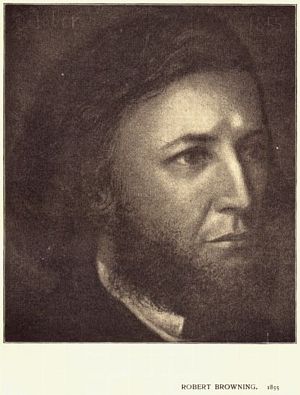
Robert Browning. 1855
Figure: Watercolor. Text in upper left corner: October. Text in upper right
corner: 1855. Browning's head. facing to the right.
too literally was not always satisfactory, as
the following pair of letters will show:
“I think I like that duet between Ida and you
better than anything you have done for me yet, for it has
no faults and is full of power—except and always
that man with boots and lady with golden hair.
1I have sent your
Beatrice
2 to-day to somebody who will like to look at
it; it will be sent or brought to you on Monday. Please
leave word about reception of it if you must go out. Please put a dab of
Chinese white into the hole in the cheek and paint it over. People will
say that Beatrice has been giving the other bridesmaids
apredestinate scratched face; also a white-faced
bridesmaid behind is very ugly to look at—like a skull or body in
corruption. Also please ask Hunt about young fool who wants grapes, and
his colour of sleeve. Then—I will tell you where this drawing is to be
sent next to be lectured upon, and am affectionately yours,
“JOHN RUSKIN.”
“DEAR ROSSETTI,
“ I suppose the girl who let me in was up to telling you what I had said,
and to
showing you what I had done. I had told her to
tell you that I was in such a passion that I was like to tear everything
in the room to pieces at your daubing over the head in that picture; and
that it was no use to me now until you had painted it in again. And I
told her to show you that I had carried off the
Passover
instead. . . . How you could think I could care to look at it
with any pleasure in that mess, I can't think.
Before,
the whole thing was explained—there was only a white respirator before
the mouth. You have deprived me of a great pleasure by your absurdity. I
never, so long as I live, will trust you to do anything again, out of my
sight.”
“You are a conceited monkey,” he writes once more on a similar
occasion, when an alteration had displeased him, “thinking your pictures
right when I tell you positively they are wrong. What do
you know about the matter, I should like to know?”
Still, against such episodes as this must be set the genuine admiration which
Ruskin had for Rossetti's work of this period and up to, perhaps, 1865, when he
had practically abandoned the romantic compositions of his youth, with all their
charm and
Transcribed Footnote (page 53):
1 “Duet between Ida and you,”
possibly (?) the
Paolo and Francesca
triptych. “Man with boots and lady with golden
hair,” the
Belle Dame sans Mercy
; also described generically in another letter as The Man
with his Blue Wife. Ruskin had a humorous way of referring
to his drawings in this style which is rather puzzling, and must be very
much so to those unacquainted with the pictures and their dates.
Transcribed Footnote (page 53):
2 The
Beatrice
referred to here, and in many of Ruskin's letters of 1855-56,
must be a copy made from the
Beatrice at a Wedding Feast denying her Salutation
to Dante
, which belongs to Mr. H. T. Wells, R.A. (
see page 36). The latter was painted at least by 1852, in
which year it was brought to Mr. Wells by the late Mr. Thomas Seddon,
together with the
Giotto painting Dante
. Rossetti, being at the time hard up for money, was anxious to
sell these two drawings, and Mr. Wells took one and Mr. Seddon the
other. The price asked and paid for them was about £10 each. They are
amongst the finest specimens of Rossetti's early work. At about the date
of these letters, Rossetti seems to have borrowed the
Beatrice
from Mr. Wells to copy for Ruskin, and the criticisms just
quoted refer to the copy. In
Ruskin, Rossetti, and Pre-Raphaelitism they are made to refer to the original water-colour, which is
reproduced by way of illustration, but which certainly has never been
altered in the manner described. The copy has gone, I find, to Mr.
Ruskin's old friend, Prof. C. E. Norton, of Harvard.
naïveté, and adopted riper and more sophisticated methods of expression. This
admiration has been fully recorded in his serious writings and lectures,—as for
instance when he says:
“ I believe that Rossetti's name should be placed first on the list of
men, within my own range of knowledge, who have raised and changed the
spirit of modern art; raised in absolute attainment, changed in
direction of temper.”
Nor was Rossetti, though he may have chafed often enough at the criticisms
lavished upon his work and methods, a backward or half-hearted friend. He speaks
in a family letter of Ruskin as the best friend, with one or two exceptions,
that he had ever made, and up to the limits of his capricious nature he
evidently took genuine pains to please him. The fact of the intimacy lasting a
full eight years proves this. It came to an end gradually
and without any open disagreement, from the purely natural circumstance that
Rossetti was developing upon his own lines and had too much independence to
subject his genius permanently to the fixed ideas of any critic, however
eminent.
1
Other causes as well may have helped to determine the inevitable.
Marriage, especially in the case of self-absorbed natures, is an effectual
solvent of old ties; and in addition to marriage Rossetti had his constant
anxiety for his wife's health to occupy him. So it came about that the two fell
apart, and whether we should count it loss or gain we cannot entirely tell,
saving as a matter of sentiment. The long duration of the intercourse, and its
closeness for so many years, are points to be borne in mind in judging of
Rossetti's character; for an unfair impression of him might easily be got from
the Ruskin letters, which, besides revealing only one side of the
correspondence, are so scattered in date as to convey a false idea of the length
of time they cover, and by consequence a false idea of the rapidity of
the
dénoûment.
A difficulty about the friendship with Ruskin which cost Rossetti some
unpleasantness was the marked antipathy existing
Transcribed Footnote (page 54):
1 Mr. W. M. Rossetti in his “
Memoir,” vol. i., p. 261, mentions letters from Ruskin which show that
in 1865, although there had been a considerable divergence over the
painting of
Venus Verticordia
, which the critic frankly detested, no positive breach of
friendship had occurred. One letter ends: “You meant them—the
first and second (letters)—just as rightly as this pretty third; and
yet they conclusively showed me that we could not at present—nor for
some time yet—be companions any more, though true friends, I hope,
as ever. I do not choose any more to talk to you until you can
recognize my superiorities as I can yours. You simply do not see
certain characters in me. A day may come when you will be able;
then—without apology, without restraint, merely as
being different from what you are now—come back to me, and
we will be as we used to be.” After this the two men
scarcely saw each other, though even as late as 1870 they were
exchanging perfectly amicable correspondence.
between the critic and Madox Brown, which
Rossetti tried in vain to bridge over. Ruskin ignored Brown's pictures, and
Brown, who was vain and touchy for such a great man, whether he suffered
directly or not, felt the slight very deeply. In company, where the two were
often bound to meet, he could with difficulty prevail upon himself to be civil,
and Rossetti finally had to accept the circumstances, and veil all mention of
his new acquaintance in jocular allusions to the “Great
Prohibited.”
Before passing from the subject of Ruskin it is interesting to note that he
enlisted Rossetti as an active helper in the scheme promoted by Frederick
Denison Maurice for bringing art into the East end.
In Rossetti's “Letters to William Allingham,” edited by Dr. Birkbeck Hill, this episode in the painter's life is
referred to many times:
October 15
th, 1854. “Ruskin is back.
. . . He has written to me saying he wants to consult with me about
plans for ‘teaching the masons’; so you may soon expect
to find every man shoulder his hod, ‘with upturned fervid face
and hair put back.’”
November.“Perhaps you know that he [Ruskin] has joined
Maurice's scheme for a
Working Men's College, which
has now begun to be put in operation at 31, Red Lion Square. Ruskin has
most liberally undertaken a drawing class, which he attends every
Thursday evening. . . . He is most enthusiastic about it, and has so
infected me that I think of offering an evening weekly for the same
purpose when I am settled in town again.”
January 23
rd, 1855.“I began my class
last night at the Working Men's College: it is for the figure, quite a
separate thing from Ruskin's, who teaches foliage. I have set one of
them as a model to the rest till they can find themselves another model
. . . some of them, two or three, show unmistakable aptitute—almost more
than one could ever have hoped for.”
Rossetti kept on his class for very nearly four years, and then it was taken
over by Madox Brown. His method of teaching has been described by one who
attended his lectures, and who himself derived benefit from them. He began at
once with colour. As in his own personality and his own work, light and shade,
drawing, and everything else was subservient to colour. Without troubling about
the grammar of design he gave his pupils nature to copy and showed them how to
copy it. In his own pithy language he wrote to a friend: “You think I
have turned humanitarian, but you should see my class for the model! None of
your
Freehand Drawing Books used! The British mind is brought to bear on the British
mug at once, and with results that would astonish
you.” A later generation has come to see wisdom in Rossetti's
method, and has introduced it under government auspices in elementary schools.
Moreover, throughout our educational system
the autocratic rule of grammar is being more and more relaxed, so that almost we
may look forward to a time when the great authors of the classical period will
be read primarily for themselves, and not secondarily as a medium for
illustrating the use of the subjunctive.
Ruskin's admiration for Miss Siddal and her work has already been mentioned, and
is abundantly evident in the letters of this period. In one from Rossetti to
Brown, dated April, 1855, the

The Quest of the Grail. By Miss Siddal.
Figure: Oil. In a water-filled sepulcher, a young knight kneels in a small
boat, flanked by two young female angels. He has just washed his hands
in a basin held by one of the angels, and he gazes at the grail held by
the other.
painter describes how Ruskin had thought her a noble glorious
creature, and how his father had said that by her look and manner she might have
been a countess. In another, to Allingham, he says: “About a week ago
Ruskin saw and bought on the spot every scrap of designs hitherto produced
by Miss Siddal. He declared that they were far better than mine, or almost
than anyone's, and seemed quite wild with delight at getting them. . . . He
is going to have them splendidly mounted and bound together in gold, and no
doubt this will be a real opening for her, as it is already a great assistance
and encouragement.” Miss Siddal's failing health,
however, shortly afterwards put an end to her productiveness, and with the
exception of one or two small water-colours, very much in Rossetti's own style
as regards colouring, she painted no pictures. Her designs are, however, of
great interest, both on their own account, for the imaginative insight they
display, and because Rossetti often worked on them, and occasionally even
borrowed her ideas. In the case of the well-known illustration of St. Cecily,
for instance, done for
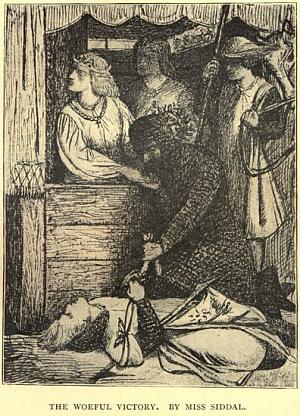
The Woeful Victory. By Miss Siddal.
Figure: Pen and ink. In the foreground, a young knight lies dead, while
another knight kneels directly behind him, and his attendant stands by
holding a horse's reins. Behind this trio, a young woman and a young man
stand in a tournament box. The young man stares at her as she looks away
from the dead knight and hands the kneeling knight his prize.
Tennyson's “Palace of Art”, it is far from
unlikely that Rossetti's design for the central figure was borrowed from Miss
Siddal. Her drawings for it exist. The water-colour
called
The Quest of the Grail
, which used to belong to Mr. Ruskin, and which is
reproduced here by the kind permission of Mr.
Arthur Severn, to whom he gave it, is a very typical instance of her
richness in invention and also of the way in which Rossetti used to help
her. It is signed “E. E. S.
inv.: E. E. S.
et D. G. R.
del.” Another
drawing by Miss Siddal
Transcribed Footnote (page 57):
1 This drawing was exhibited at the New Gallery in
1897-8 in the name of Rossetti.
which I have
reproduced, from Mr. W. M. Rossetti's negative, is called
The Woeful Victory
, and has an especial interest in being (there is reason to suppose)
intended for an illustration to Rossetti's poem,
“The Bride's Prelude”. As will be seen, the lady is turning away her head as she gives the
prize of victory to the knight who has slain her lover. Two other very
interesting designs will be found in the “Letters to William
Allingham.” A few poems by Miss Siddal which have been preserved
show the same delicacy of insight and feeling that is present in her drawings,
together with the same incomplete maturity of expression.
Her life, so much as we know of it, was passive and singularly free from
adventure. Wrapped up in Rossetti, as he was in her, she varied the monotony of
her confined existence by occasional changes of air at Hastings, Matlock, Bath,
or Clevedon in Somersetshire, with one longer trip abroad in the winter and
early spring of 1855-6. During the intervals she worked in Rossetti's studio at
Chatham Place, Blackfriars, or sat to him for endless studies, concerning which
Madox Brown's diary of 1855 contains the following passage: “He
(Rossetti) showed me a drawer full of ‘Guggums’; God knows how many, but not
bad work I should say for the six years he has known her. It is like a
monomania with him. Many of them are matchless in beauty, however, and one
day will be worth large sums.”
In 1860 Rossetti and Miss Siddal carried out their long projected plans of
matrimony, which had been delayed by uncertain prospects, and perhaps also by a
final want of resolution on Rossetti's part. In a private letter to his mother,
dated Hastings, April 13, 1860, he says:
“I write this word to say that Lizzy and I are going to be married at
last, in as few days as possible. . . . Like all the important things I
ever meant to do—to fulfil duty or secure happiness—this one has been
deferred almost beyond possibility. I have hardly deserved that Lizzy
should still consent to it, but she has done so, and I trust I may still
have time to prove my thankfulness to her. . . . The constantly failing
state of her health is a terrible anxiety indeed; but I must still hope
for the best, and am at any rate in a better position to take the step,
as regards money prospects, than I have ever been before.”
After still further delays, on account of Miss Siddal's health, the marriage took
place on May 23rd, 1860, and the young couple went for their wedding trip to
Paris and Boulogne. On their return they took a cottage at Hampstead, while the
rooms at Chatham Place were extended by opening a door into the adjoining house.
The independent bachelor habits to which both were accustomed
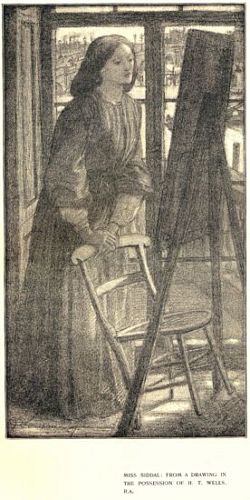
Miss Siddal: From a Drawing in the Possession of H.T. Wells,
R.A.
Figure: Pencil. Text in lower left corner: D.G.R. Blackfriars. To the left,
a full-length figure stands 3/4 front leaning on a chair back and gazing
at a picture on an easel. Behind her is a window, through which
Blackfriars Bridge and the Thames are seen.
made life as Bohemian and irregular after
marriage as before it. Men friends came and went as they pleased; tavern dinners
relieved the strain of studio work, and little if any respect was paid to the
conventions of social intercourse. Mrs. Rossetti's delicate health alone made it
impossible for her to go about much, except amongst devoted and intimate
friends, the chief of whom in these days perhaps were Algernon Charles Swinburne
and the Madox Brown and Morris families. The acquaintance with the first and
last mentioned of these dates from the Oxford episode of 1857-8, which there
will be occasion to deal with in reviewing Rossetti's work during the years so
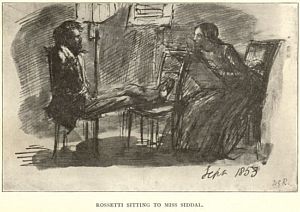
Rossetti Sitting to Miss Siddal.
Figure: Pen and ink. Text in lower right corner: Sept. 1853 D.G.R.
Full-length profile of two seated figures. To the left, DGR sits facing
Elizabeth, his feet propped on a chair seat. The back of this chair
serves as an easel, as Lizzie leans over her work, scrutinizing DGR as
she sketches.
briefly outlined in the foregoing pages. In May, 1861, Mrs. Rossetti
gave birth to a child, still-born, and her slow recovery, added to the
phthisical troubles with which she was afflicted, induced a severe and wearing
form of neuralgia. For this she was prescribed laudanum, of which, on the night
of February 10, 1862, she unhappily took an overdose. Poor Rossetti, on
returning home from the Working Men's College, where he had been lecturing,
found his wife already past recovery, and, frantic with anxiety, rushed off to
Highgate Rise to summon the ever-ready assistance of Madox Brown. The following
morning she died, after but two years of married life clouded with illness; and
for a time at least her loss deprived Rossetti of all capacity for work and
almost of all interest in his art. The most
touching event in his whole career of swift
and flame-like emotions is the sudden impulse which led him, as his wife's
coffin was being closed, to bury in her beautiful hair of gold the drafts of all
his early poems, which at her request he had copied into a little book. Scenes
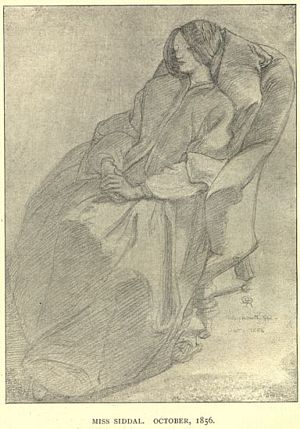
Miss Siddal. October, 1856.
Figure: Pencil. Text in lower right: D.G.R. Weymouth St. Oct. 1856.
Full-length figure angled to the left as she reclines in an arm-chair,
her eyes closed, her hands clasped, and her head resting on a
pillow.
such as these are not suited for a biographer, still less for one who
is only concerned with biography in so far as it binds and illustrates the
artistic record. Some poets might dare to touch them; but no poet yet has tried
to put into words the dramatic intensity of grief which was expressed in this
now historic sacrifice to the memory of Rossetti's dead wife.
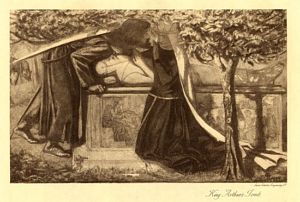
King Arthur's Tomb
Swan Electric Engraving Co.
Figure: Water color. Text in lower right corner: D.G.R. 1854 Arthur's Tomb.
Water color. Full-length painting of two figures in a grove next to a
tomb, beneath some short leafy trees. Guenevere kneels before the side
of Arthur's tomb with her hands raised before her face to deter
Launcelot's kiss. The knight stands leaning over the head of the king's
tomb, attempting to kiss Guenevere.
ROSSETTI'S work, during the earlier part of the period we have
been glancing through, was of a particularly interesting, and towards the latter
end of a sufficiently varied character. In range of subject it belongs to the
category described in Chapter III.,
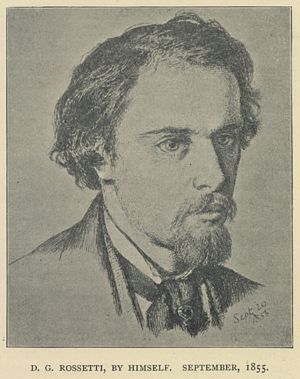
D.G. Rossetti, by Himself. September, 1855.
Figure: Pen and ink. Inscribed lower right: "Sept 20 1855." Head and
shoulders of a youthful D.G.R., with a moustache and goatee. His head is
turned slightly to right.
with the important addition that now for the first time is added to
his sources of romantic inspiration the “Morte Darthur” of Sir Thomas Malory. This cycle of old Celtic legends had been for
many years practically a sealed book in England, and its wide popularity to-day
is largely owing to the interest revived in it by Rossetti, and later by the
famous group of Oxford friends, including William Morris and Edward Burne-Jones.
Tennyson became infected from the same source, and produced the first set of the
“Idylls Of the King” in 1859; but Rossetti had become acquainted with Malory by 1854, which
is the date of that strange, sad little water-colour,
King Arthur's Tomb
, representing, in an imaginary scene, Launcelot bidding a last farewell
to Guenevere. Bending across the marble effigy of the dead prince is the gaunt
figure of Launcelot, beseeching a kiss from the
queen, who, repentant now, and clad in
mourning garments, crouches by the tomb and repels his unhallowed love. In the
background is the knight's charger, ready caparisoned for his journey, and as if
from an instinctive sense of contrast, to heighten the dramatic effect, a sunny
smiling orchard enfolds and beautifies the scene. This little drawing was first
purchased by Ruskin, who gave it away because he complained that in the course
of some retouching Rossetti had “scratched out the eyes.” Shortly
afterwards it passed into the hands of Mr. Morris, who might almost have lent
his features for Sir Launcelot. It came later still into the magnificent
collection of Mr. William Graham, which was broken up in 1886, and now belongs
to Mr. S. Pepys Cockerell, who has kindly allowed it to be photographed and
reproduced for this work. With the exception of
some portraits, including a newly-discovered
head of Miss
Siddal
in water-colour, probably the first done and unhappily a good
deal faded, only one other drawing by Rossetti, to my knowledge, bears date
1854—a little sketch of
The Queen's Page
, from Heine, done for William Allingham to illustrate his translation of
the lyric. The fact is that Rossetti had in hand a large number of pen-and-ink
drawings and water-colours, which were continually put on one side as fresh work
accumulated or fresh ideas crowded into his restless brain, and were often not
finished until many years later. I have not seen it mentioned before, but the
statement can easily be verified, that many, if not most, of Rossetti's later
pictures were planned during these early strenuous years of his life. No one
will ever know what piles of unused studies and drawings were destroyed in the
periodic excavations of his studio, or during his frequent removals, but one
visitor of about this time, Sir Edward Burne-Jones, has recorded his amazement
at the number which littered the floor and every available corner. Mr. William
Rossetti inherited a valuable collection of such relics, many of which, however,
were sold in 1883 or subsequently. The best as well as the largest collection
now is that of Mr. Fairfax Murray, who has the advantage of being a recognized
authority on Rossetti's work, as well as the possessor of an unrivalled
aggregation of his early drawings and manuscripts. Among the pencil sketches and
studies so preserved are several which show that Rossetti had in his mind at the
time the composition of works which were not executed for many years afterwards.
Here, for instance, we find in embryo, committed to paper during the early
fifties,
Morning Music
(painted 1864),
Hamlet and Ophelia
(1858),
My Lady Greensleeves
(1859),
Tibullus and Delia
(1867),
Fight for
a Woman
(1865),
Mary Magdalene at the Door of Simon
(1858),
Saluto di Beatrice
(1859),
Proserpine
(1871), and
The Boat of Love
, from a sonnet by Dante to Guido Cavalcanti, taken up late in life and
still unfinished in 1880.
In addition to these designs, which were all carried out more or
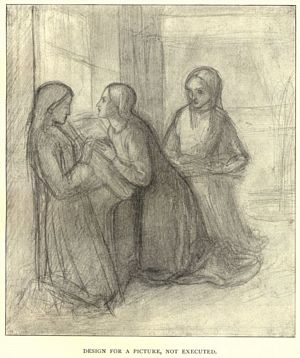
Design for a Picture, Not Executed.
Figure: Pencil. Full length sketch of three figures. A young woman in
profile kneels, looking out a window on the left with her hands clasped
in prayer. To the left of her, another young woman plays a lute, while a
third young woman sits or kneels behind the first, cradling what is
perhaps another musical instrument in her arms.
less completely, are several others which were not. Some of the
latter, though it is not always easy to identify their subjects, evidently
occupied Rossetti's thoughts for a considerable time, as they are repeated in
various forms; and a few are interesting enough to be worth description and
illustration on their own account. The first, which is reproduced by Mr.
Murray's permission, represents
a lady kneeling at a low
prie-dieu before a window
and two other figures
kneeling by her. A large and
carefully-worked
nude study was made for the centre
figure,
which Mr. Murray also has. The second, from the same source,
might seem to refer to a Dantesque incident from the appearance of the figure on
the left; but which I am unable to determine. It was repeated with variations
two or three times. In addition to these, Mr. Murray has a very interesting
little
sketch
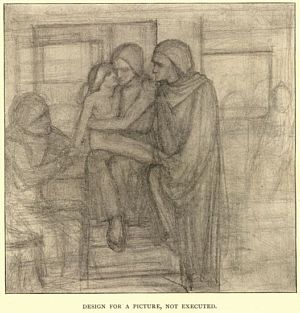
Design for a Picture, Not Executed.
Figure: Pencil. Four full-length figures. A seated woman supports a boy
sitting on her lap, encircling his head and waist with her arms. To the
right, a man looks over the woman's shoulder at a seated figure on the
left, who tends to the boy's hand. Behind the man, the outlines for two
additional figures are lightly sketched.
illustrating the
“Ballata” of Guido Cavalcanti which Rossetti has translated in his
Early Italian Poets
—the one beginning:
- “Being in thought of love, I chanced to see
- Two youthful damozels.”
The poet and the maidens are represented meeting at a well in the
foreground of the picture, and Love goes up the street beyond them, drawing the
hearts of ladies who look out from the windows. The first words of the poem, in
Italian, are inscribed on a corner of the drawing.
The
Design for an Old Ballad
, in pen-and-ink—illustrating the pathetic story of “Fair Annie” and her generous sister—may be classed among these instances of subjects
which Rossetti thought out but never painted; and so may the drawings of
Giorgione
and
Fra Angelico painting
, the
Parable of Love
(a lady drawing her own portrait from a mirror whilst her lover guides
her hand), and
Dante at Verona
, a study for one side of the triptych which was to include the incident
of Giotto painting Dante's portrait, already described and illustrated. With all
these conflicting subjects to occupy Rossetti's thoughts, with many months spent
upon
Found
, and
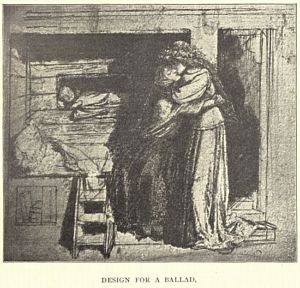
Design for a Ballad.
Figure: Pen and ink. Full-length sketch of three figures. To the right, two
young women in profile embrace, while to the left, a baby sleeps
peacefully in a niche in a wall above a bunk bed.
taking into consideration as well those drawers-full of
“wonderful and lovely” Miss Siddals, which Madox Brown and
Ruskin so admired, it is not to be wondered at that the actual finished work of
these early years was sparse in quantity and slight in quality—much slighter,
for instance, than the two religious paintings with which he had begun his
career. On the other hand, for many people these little water-colours of
Rossetti's second period, despite their quaintness, hard colouring, and
occasional faults of drawing or design, have a charm of their own that nothing
in his larger and more elaborated later work can recall. Many of them besides
are flawless examples of work, and exhibit none of the defects just
mentioned.
In the early part of 1854 Rossetti had written to Ruskin that
he was occupied with ideas for three
subjects,
Found
,
Mary Magdalene at the Door of Simon
, and another which is not named in the reply, but which from the context
I infer to have been the water-colour diptych of
Paolo and Francesca da Rimini
. In August of the same year he wrote to William Allingham that he was at
work on a
Hamlet and Ophelia
, “deeply symbolical of course,” and predestined for the
folio which Millais had presented, and which was still supposed to be in
circulation among the members of a select sketching club. About the same time he
submitted to Ruskin two designs
[design 1]
[design 2] for
The Passover
,
one of which was chosen to be begun at
once, while Ruskin also commissioned seven drawings from the
Purgatorio, of which one certainly,
Matilda gathering Flowers
, was very shortly put in hand. None of these undertakings saw the light
for at least another year; the
Hamlet
not for four or five. The
Matilda
was finished first and delivered in September, 1855, and on the 2nd
December Madox Brown records in his diary,
apropos Miss Siddal being stranded in Paris without money, “Gabriel, who saw that none of the drawings on the easel could
be completed before long, began a fresh one,
Francesca da Rimini
, in
three compartments; worked day and night,
finished it in a week, got thirty-five guineas for it from Ruskin, and
started off to relieve them.” This was the earliest
version of a subject that Rossetti returned to more than once, representing in
one compartment the lovers' kiss, and in the second their two souls floating
clasped together in Hell through a rain of pale sulphurous flames. Between the
compartments are two figures meant for Dante and Virgil, and the words “O
Lasso!” A more elaborately finished version of the complete picture
was painted in 1862 for Mr. Leathart, and a copy of the first compartment only,
a drawing of singular loveliness and power, was sold to Mr. Graham in 1861. This
will be further described under the latter date. A
pencil
study
for one compartment only, dated 1854, belongs to Mr. J. A. R.
Munro, but hardly counts as a finished picture. Mr. Sharp in his not always
accurate book on Rossetti describes the pencil drawing as belonging to Mr.
Ruskin and a replica of the Leathart picture as having been done for Mr. Rae. As
a matter of fact it is the
Ruskin early water-colour
that belongs to Mr. Rae, and the
Leathart
picture
(
here reproduced) was the
replica. The latter remains in the possession of Mr. T. H. Leathart. The
Graham picture is now the property of Mr. W. R.
Moss, of Bolton, Lancashire, who has kindly allowed it to be engraved for this
work. (
See Chap. VI.) Within the same period,
viz., by October, 1855, another Dante subject,
The Vision of Rachel and
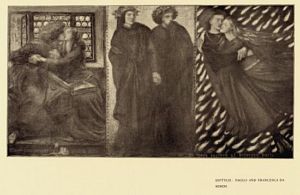
Diptych: Paolo and Francesca da Rimini
Figure: Water color triptych. Text in left compartment: “Quanti dolci
pensier Quanto disio.” Text in central compartment: “O lasso!” Text in
right compartment: “Menò costor al doloroso passo!” In left compartment,
two lovers seated before a bottle-glass window kiss, holding hands while
a book lies open on the young woman's lap. In the central compartment,
two men in dark robes stand 3/4 front, looking toward the right
compartment. In the right compartment, the two lovers embrace, floating
through drops of flame in hell.
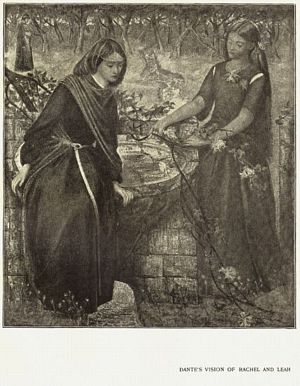
Dante's Vision of Rachel and Leah
Figure: Water color. Two full-length women in long dark dresses in front of
a stone wall and a wooded area, on either side of a water-filled stone
basin. The left figure wears a cape and veil as she sits on the wall,
her hands at her sides, gazing downward, perhaps at her reflection. To
the right, another downward-gazing young woman stands holding a spray of
flowers and vines which cascade over the basin onto the ground at her
feet.
Leah
, was taken up and completed. For this Ruskin paid “thirty guineas
instead of twenty asked,” and afterwards parted with it to Miss
Heaton, of Leeds, an early patron whom he introduced to Rossetti's work. It is
now in the possession of Mr. Beresford Heaton.
Matilda gathering Flowers
, which forms a sort of companion to
The Vision of Rachel and Leah
, I have never seen, and its whereabouts
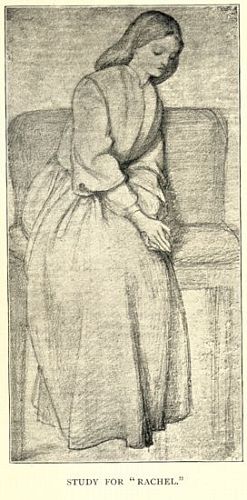
Study for Rachel.
Figure: Pencil. Full-length sketch of a young woman seated on a high bench,
with her torso turned to her left. Her hands are clasped on her left
knee, and she gazes downward.
are unknown to me. The latter picture, as will be seen, represents two
young girls at a fountain. The one to the left is in purple, sitting on the
well, the other in bright green, holding a spray of honeysuckle which trails all
over the stonework. Beyond is a buttercup meadow, with a little stream
meandering through it, and at the back is an orchard. Dante, in the distance to
the spectator's left, contemplates the graceful scene, which is, by the way, of
a typically English, and most un-Oriental character. Madox Brown has the
following record in his diary, under the date August 15, 1855: “Rossetti
still here, painting at his drawing of
Rachel and Leah
. I suggested his putting in Dante in the distance and sundry great
improvements, and now he is in spirits with it and will ask £5 more for
it.” As already mentioned he obtained ten. The little study in
pencil for one of the figures was drawn from Miss Siddal.
The
Passover
drawing, referred to in one of Ruskin's letters in the last chapter, is
a small, unfinished, but highly interesting water-colour, in which once more
Rossetti has treated the domestic life of the Holy Family with a reverent
freedom from conventionality, such as Millais used in the
Carpenter's Shop
and Holman Hunt in the
Finding of Christ in the Temple
. This time the incident represented is an imaginary one, the sprinkling
of blood upon the lintels, with Mary gathering bitter herbs for the Passover.
The scene, to quote
Rossetti's own description, “is in the
house porch, where Christ (as a boy) holds a bowl of blood from which
Zacharias is sprinkling the posts and lintel. Joseph has brought the lamb
and Elizabeth lights the pyre. The shoes which John fastens, and the bitter
herbs which Mary is gathering, form part of the ritual.” It will be
seen that the whole idea is full of allegory, the part assigned to the
characters being generally chosen from some special allusion to the future.
Ruskin, however, who seized the drawing and bore it away in an unfinished state
lest worse should befall, after that unhappy difference about the
Beatrice
, refused to recognize this. Patmore, he says, in reply to
some letter, “is very nice; but what the mischief does he mean by
Symbolism? I call that
Passover
plain prosy Fact. No Symbolism at all.” The two pencil
drawings,
[drawing 1]
[drawing 2] showing the alternative pictures
offered, also belonged to Ruskin and were much admired by him. They are now at
Oxford, in the possession of Sir Henry Acland, who has kindly allowed them to be
reproduced.
[drawing 1]
[drawing 2]
The Passover
was one of Rossetti's very earliest designs, having been
sketched out first as far back as 1849; it was the
one selected for a memorial window to Rossetti in the church at
Birchington-on-Sea, where he was buried, the adaptation for purposes of stained
glass being carried out by Mr. Frederick Shields. The unfinished
water-colour is the only one of Rossetti's drawings
which Mr. Ruskin still retains in his possession, all the many others which once
belonged to him having been given away, exchanged, or sold.
Other drawings which are dated, or were finished by 1855, though they may have
been in hand considerably earlier, are
The Nativity
(done in a week and sold to Ruskin for fifteen guineas:
see page 52),
La Belle Dame sans Mercy
, and the
Annunciation
, all water-colours, of which the two last were acquired by the late Mr.
George Price Boyce, and formed part of his fine collection. After the sale of
his pictures in 1897,
La Belle Dame
, with others, came into the possession of Mr. Fairfax Murray, but
the
Annunciation
was retained by Mrs. Boyce. It never belonged to Mr. Ruskin, as has
generally been stated, but was much admired by him.In it
the Virgin (done from Miss Siddal) is represented washing clothes in a
stream,
1 whilst the angel Gabriel stands with folded
wings between two trees hard by, on which he leans his hands. Both
are in white, and the whole picture shows a strong effect of sunlight. The
inscription put upon it by Rossetti was, “My beloved is mine and
I
Transcribed Footnote (page 68):
1 Compare the line in Rossetti's
“Ave”.
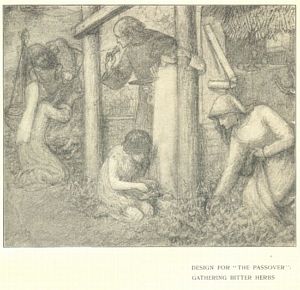
Design for The Passover: Gathering Bitter
Herbs
Figure: Pencil. Five full-length figures outside a small hut, variously
kneeling and bending over to gather herbs.
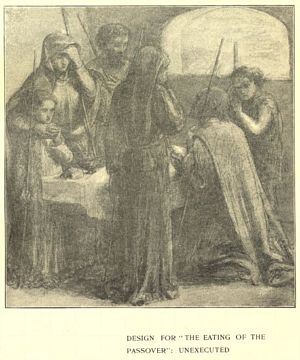
Design for The Eating of the Passover:
Unexecuted
Figure: Pencil. Six figures around a table, standing and kneeling, all
holding staves.
am his; he feedeth among the lilies. Hail
thou that art highly favoured; blessed art thou among women.
With regard to the drawing of
La Belle Dame sans Mercy
—which, in spite of its name, does not immediately suggest the
well-known Keats ballad—there is some room for ingenious speculation. The title,
it is true, ante-dated its execution, and belonged as well to a little
sepia sketch of the subject given to an early friend,
the
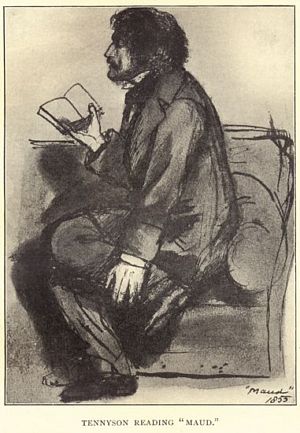
Tennyson Reading
Maud.
Figure: Pen and ink. Text in lower right corner: "Maud" 1855. Full-length
sketch of Tennyson in profile facing left, seated in an over-stuffed
chair and reading from a book held in his right hand. His legs are
tightly crossed, and his left hand grasps his right shin.
sculptor Alex. Munro, in 1848. This even bore upon its frame the two
verses from Keats beginning:
- “I met a lady in the wood,
- Most beautiful, a fairy's child;”
but the composition represents neither wood nor fairy—simply a pair of
figures walking arm-in-arm, the man booted and spurred, the lady golden haired,
in a bright blue gown and long girdle. It was laconically referred to by Ruskin,
who at one time owned and highly valued the drawing, as “the man and his
blue wife.” Mr. Fairfax
Murray has suggested an idea that the
composition may have been intended at first to represent Laertes leading away
Ophelia, and points out that the figures reappear almost exactly in a
water-colour of 1864 entitled
The First Madness of Ophelia
.
Of portraits, there belong to the year 1855 a
pen-and-ink
head of Rossetti
himself at the age of twenty-seven, sallow-faced and
slightly bearded, of which at least one copy exists, perhaps by
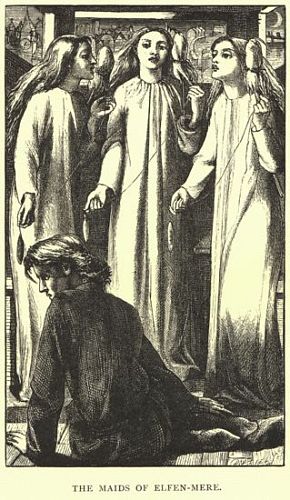
The Maids of Elfen-Mere.
Figure: Woodcut. text in lower right corner: T Dalziel. Full-length woodcut
of four figures. Three young women stand in flowing gowns, facing
forward, left, and right, before a youth, who faces backward while
seated on the floor, turning his head away from them.
another hand; a
water-colour portrait of
Browning
, done at Paris in October of the year; a lovely little
water-colour of Miss Siddal seated upon the ground,
in the possession of Mr. Wells; and a
sketch,
which however deserves notice for its intrinsic interest, of Tennyson reading
aloud the proof-sheets of “Maud.” Browning, at whose
house the reading took place, on September 27, 1855, retained possession of this
sketch, and his son may possibly have it still; but a
copy was made at Miss Siddal's request by Rossetti, who gave it away
many years later when he was cherishing a real or imaginary grievance against
Tennyson, and this is
reproduced on page 69 by
permission of its present owner, Mr. Cosmo Monkhouse.
In addition to the foregoing there must be chronicled under 1855 the first of the
important and beautiful designs for woodcuts, which in the absence of his
pictures were almost the only means afforded to the public for many years of
judging of Rossetti's work. This is a drawing for a poem in William Allingham's
“Day and Night Songs,” called
The Maids of Elfen-Mere
. Allingham was employed in the Customs in Ireland, and at the period in
question, and for some years after, Rossetti and he were very intimate, corresponding
freely and vivaciously on all topics
concerning their circle. Rossetti's letters have fortunately been preserved, and
unlike some others which have shared the same publicity are entirely suitable
for and worthy of general reading. They have been excellently edited by Dr.
Birkbeck Hill, and are a source of information on these years of Rossetti's life
from which I have not scrupled occasionally to draw. In them the whole history
of this
wood-block is circumstantially
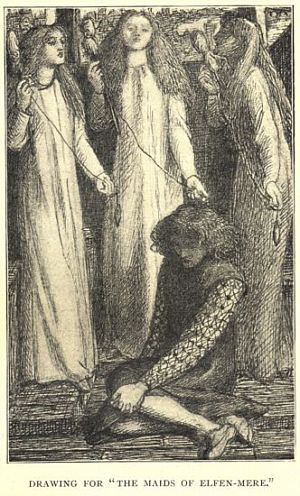
Drawing for The Maids of Elfen-Mere.
Figure: Pen and ink. Four full length figures. A young man sits on the
ground, turned slightly to the left. His hands are clasped around his
left knee, and he gazes downward. Behind him, three women in flowing
dresses face forward, left, and right.
detailed, so that I need not dwell much upon it here; sufficient to
say that Rossetti was violently displeased with the cutting of his design by
Dalziel, and after keeping the edition waiting ever so long, wanted to cancel
and withdraw the block. Allingham and some others were by no means equally
displeased, and eventually on the former's urgent petition it was allowed to go
in. To our eyes to-day it appears a sufficiently
creditable piece of work,
1 though it is too fine and
light in tone to yield a satisfactory reproduction. As a set-off
against the coarseness of the block shown here I have placed alongside it a
reproduction from one of the original
pen-and-ink designs which Rossetti copied on to the
wood, and which has kindly been lent to me for the purpose by its present owner,
Dr. Robert Spence Watson, of Gateshead. A
larger
drawing
remains in the possession of Mrs. Allingham. An interesting
incident in connection with this block is that Rossetti first drew the subject
on the wood without reversing it, showing at once his
Transcribed Footnote (page 71):
1 It was his delight at the sight of this
woodcut in Allingham's book that started
William Morris on designing and engraving blocks himself. Both he and
Burne-Jones were emphatic in admiration, the latter writing of it as
“the most beautiful drawing for an illustration that I have
ever seen.”
inexperience and the same kind of
happy-go-lucky confidence which afterwards led to the deplorable fiasco at the
Oxford Union. The drawing as shown here is intended to be reversed.
In 1856 were completed the water-colours of
Dante's Dream
and
Fra Pace
; the former for Miss Heaton, the latter for anyone who would buy
it,—Ruskin, who had the first offer, having pronounced it to be “very
ingenious and wonderful, but not my sort of drawing.” Mr. William
Morris, who, as we shall presently see, acquired several early water-colours by
Rossetti, was apparently the first purchaser of
Fra Pace
, which later on found its way into the great Graham collection, and is
now in the possession of Mrs. Jekyll, one of Mr. William Graham's daughters. It
represents, as the
plate will show, a kneeling monk
busy illuminating at a desk. He is copying a dead mouse, and has worked so long
and with such preoccupation that the cat has coiled itself up asleep upon his
trailing robe. A youthful acolyte is tickling it with a straw in order to
beguile the tedium of the long silence. The drawing is somewhat archaic in
character and stiff in design—based upon Memling, some have said; but it is
eminently characteristic of Rossetti, full of quaint conceits and devices, from
the row of little bottles that hold the good man's pigments to the split
pomegranate that lies uneaten by his side. From the amount of humour it contains
Rossetti must evidently have enjoyed doing it.
The
Dante's Dream
just mentioned is the first, and in certain points most beautiful,
version of the subject which afterwards served for Rossetti's
largest picture, the one in the Walker Art
Gallery at Liverpool. A
third picture, not so
large as the latter, but distinguished by a pair of predellas, belongs to Mr.
Wiliam Imrie, of the same city. These will be further described in their proper
place. Mr. Heaton's little
water-colour—really not a
very little one in comparison with most of the works of that time—has been
described (even by Mr. W. M. Rossetti) as different in composition from the
later versions. This, it will be seen by comparing the illustrations, is hardly
the case. The
water-colour is somewhat squarer in
shape, but the composition and pose of the five figures are very much the same
as in the large
Liverpool picture. Love,
arrayed in bright blue, instead of in flame red as the later versions represent
him, is leading a very grave and sorrowful Dante up to the bier whereon in a
vision he saw his lady lie. Her maidens at head and at foot are lowering or
holding up a snowy pall, on which are strewed symbolic sprigs of hawthorn bloom.
Poppies of death cover the floor. The
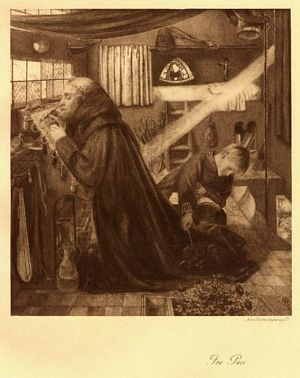
Fra Pace.
Swan Electric Engraving Co.
Figure: Water color. Monogram lower right. Two full-length figures in a
rectory. To the left, a monk kneels next to desk, drawing a dead mouse
in an illuminated manuscript. Behind him, a small boy plays tries to
awaken a cat who has curled up asleep in the folds of the monk's
robe.
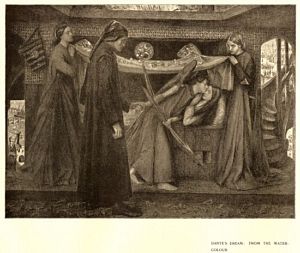
Dante's Dream: From the Water-Colour
Figure: Water color. Five full-length figures. In a chamber, a man stands
in profile facing to the right, gazing down at a woman who lies on a
bier behind him. He is led to the bier by an embodiment of love, who
holds his left hand while bending over to kiss the supine woman. An
attendant stands at the head and foot of the bier. The dead woman's eyes
are closed and her hands are joined as if in prayer.
scene is an interior, with open vistas to right and left, showing
the sunny city of Florence and the winding Arno. Certain features, such as the
red birds of love flying in and out at the openings and filling all the house,
are absent in this earlier picture, which gains by a depth of feeling peculiarly
its own, by entire freedom from affectation in the expression of the faces, and
by the simple beauty of the recumbent Beatrice, with her golden hair, done,
according to
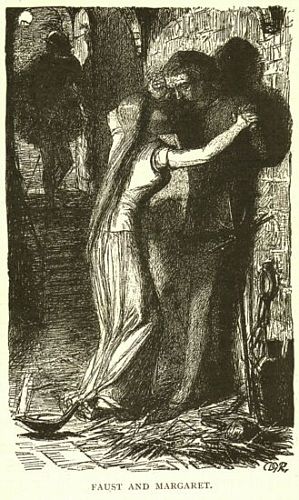
Faust and Margaret.
Figure: Pen and ink. Initialed lower right. Three full-length figures. On
the right, Faust stands with his back against a prison cell wall, his
arms raised and bent as he clasps Margaret's hands. She faces him,
raising her arms to grasp his hands as they gaze into one another's
eyes. In the background to the left, a shadowy figure of Mephistopheles
descends a stairway into the cell.
Mr. William Rossetti, from the wife of his friend, James Hannay.
Rossetti made a charming study for the Beatrice of the later picture from Mrs.
Morris, although in the picture itself the effect has been somewhat spoilt by
altering the colour of the hair, and by the introduction of ugly mannerisms,
which marred a great deal of the painter's latest work.
Of the same date as
Dante's Dream
is a pen-and-ink design belonging to Mr. Arthur Hughes, which
represents
Faust and Margaret
in the prison.
1 Mephistopheles is coming down the steps, urging the pair
to make haste. At the very close of his life Rossetti essayed to paint an
important picture, dealing with the incident of the jewel-casket, to be
called
Gretchen
, or
Risen at Dawn
. Particulars as to this will be found in
Chapter
IX.
Transcribed Footnote (page 73):
1 On page 24 mention was made of an early drawing
of
Gretchen and Mephistopheles in the Chapel
, belonging to Mr. J. A. R. Munro. This, I find, since the page was
printed, now belongs to Dr. H. A. Munro, who has also a second,
less finished, drawing of the same subject, but
totally different in composition. In this, Faust kneels at a pew close by,
looking lovingly at Gretchen, and the upper spandrils of the picture contain
large heads of Faust and Mephistopheles. Both will be found reproduced at
page 24.
[reproduction 1]
[reproduction 2] The
finished drawing, with the flaming sword pointing to Gretchen,
and the words “Dies Irae” round it, was done for the “Cyclographic Society,”
and criticisms on it by Millais and Holman Hunt were quoted by Mr. Rossetti
in the “Art Journal,” May, 1894.
In March, 1856, Rossetti secured an important commission— judged by the standard
of his current work and prices—to paint a
reredos in three
compartments
for the cathedral of Llandaff, which John P. Seddon was
engaged in restoring. The matter had been broached a year earlier, when Madox
Brown had felt a momentary annoyance at being passed over himself and asked to
recommend Rossetti. This did not deter him from pushing his friend's interests,
and through the influence of Mr. Bruce, M.P., afterwards Lord Aberdare, and the
Seddons, Rossetti got the commission at his own price, viz., £400 for the triple
picture—“a big thing,” as he wrote, “which I shall go
into with a howl of delight after all my small work.” The subject he
chose for this undertaking was
The Seed of David
, showing in the centre-piece the infant Christ on his mother's knee
being adored by a shepherd and a king, and on either side a single figure of
David, first as a shepherd-boy slinging the stone for Goliath, and secondly as a
king harping to the glory of God. In this year the Llandaff triptych got no
further than a set of
water-colour designs, which
for a long time have been in the possession of Rossetti's early friend Vernon
(now Mr. Justice) Lushington. Even they were probably not all completed until
later, as several earlier studies
[study 1]
[study 2]
[study 3]
[study 4]
[study 5] were made, of which some were sold
after Rossetti's death, and are to be found in the possession of Mr. J. W.
Thompson, of Walcot, Stalham. Mr. Fairfax Murray also has one or more. The
painting was started about 1858, and was evidently much discussed with Ruskin,
who wished Rossetti to use for the face of the Virgin the handsome features of
Miss Herbert, an actress whose acquaintance he had just then made, and who sat
to him more than once. In 1857, however, Rossetti had met Miss Burden,
afterwards Mrs. Morris, and it is her face which appears in the picture. The
colouring and the work in general is not unlike that of the early
Adoration by Burne-Jones
, which was painted about the same time, under
the strong influence of Rossetti, and which will be remembered at the Winter
Exhibition of the New Gallery, 1898-9. In this picture also Mrs. Morris sat for
the Virgin, and William Morris and Swinburne are recognizable among the group of
worshippers. The triptych was not completely finished until 1864, and after that
was considerably retouched in 1869, when Rossetti went down to Llandaff for the
purpose.
An interesting family letter,
1 of
June, 1864, gives Rossetti's own description of the triptych, and also shows
how much novelty of idea
Transcribed Footnote (page 74):
1W. M. Rossetti, “
Letters and Memoir,” vol. ii., p. 174.
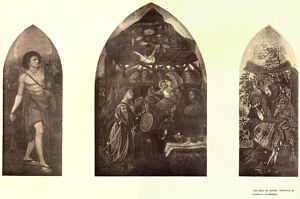
The Seed of David: Triptych in Llandaff Cathedral
Figure: Oil. Three panels with arched tops. The left panel shows David as a
shepherd with a sling-shot and stone, ready to slay Goliath. The center
panel depicts the birth of Christ among a group of people dressed in
medieval attire. The right panel shows David as a king, playing a
harp.
Note: This page contains one half of the triptych The Seed of David,
described on the preceding page.
and teaching he contrived to throw into such
a hackneyed theme as the Adoration: “It is intended,” he says,
“to show Christ sprung from high and low in the person of David, who
was both Shepherd and King, and worshipped by high and low—a King and a
Shepherd —at his nativity. Accordingly in the centre-piece an angel is
represented leading the Shepherd and King to worship in the stable at the
feet of Christ, who is in his mother's arms. She holds his hand for the
Shepherd, and his foot for the King, to kiss—so showing the superiority of
poverty over riches in the eyes of Christ. There is an opening all round the
stable, through which angels are looking in, whilst other angels are playing
on musical instruments in a loft above. . . . The three pictures are in a
stone framework in the cathedral, which being white I fear must injure their
effect; but before long I shall go down there and give directions for such
decoration of the framework as seems best. I have been thinking of some
concise mottoes to inscribe round the pictures, so as to suggest their
purport, and have hit on the following:
- (1) Christ sprang from David Shepherd, and even so
- (2) From David King, being born of high and low.
- (3) The Shepherd lays his crook, the King his crown
- (4) Here at Christ's feet, and high and low bow down.”
The year 1856 (or, if we take the date of publication, 1857) deserves
commemoration apart from these annals as the year of the famous Moxon “Tennyson”, for which Rossetti designed no fewer than five illustrations. The first
mention we have of the matter is in a letter from Rossetti himself to Allingham,
dated January 23, 1855, in which he says:
“The other day Moxon called on me, wanting me to do some of the blocks
for the new Tennyson. The artists already engaged are Millais, Hunt,
Landseer, Stanfield, Maclise, Creswick, Mulready, and Horsley. The right
names would have been Millais, Hunt, Madox Brown, Hughes, a certain
lady, and myself. NO OTHERS. . . . Each artist, it
seems, is to do about half-a-dozen; but I hardly expect to manage so
many, as I find the work of drawing on wood particularly trying to the
eyes. I have not begun even designing for them yet, but fancy I shall
try the‘Vision of Sin’, and‘Palace of Art’, etc.—those where one can allegorize on
one's own hook, without killing for oneself and everyone a distinct idea
of the poet's.”
Rossetti's interpretation of the last sentence may be sought for in the wonderful
illustration to the “Palace of
Art”
, on which he has lavished all the wealth of his rich mediæval fancy and
feeling for beauty, without trespassing to any apparent extent upon either the
central idea of the poem or any one of its details. Tennyson, who hated
pictures, and took the most attenuated interest in this edition of his poems, is
said to have been a good deal puzzled by the illus-
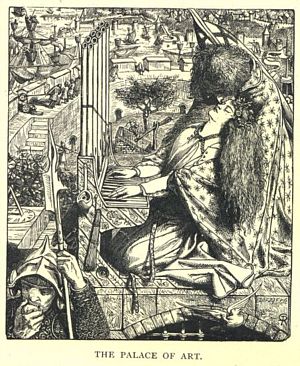
The Palace of Art.
Figure: Woodcut. Monogram, lower right corner. A woman kneeling to the left
plays a small organ as an angel embraces her from behind and kisses her
forehead. A guard eating an apple stands in the lower left corner, his
back to the couple.
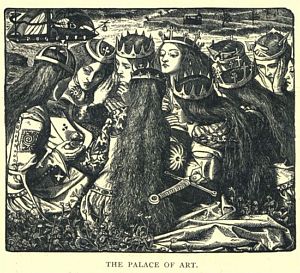
The Palace of Art.
Figure: Woodcut. Monogram, lower left corner. A supine Arthur is cradled on
the laps of ten young, weeping queens.
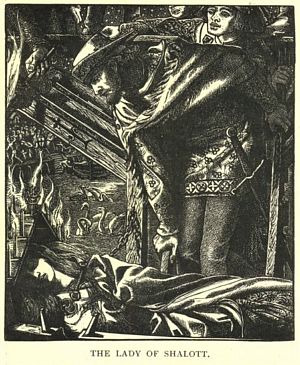
The Lady of Shalott.
Figure: Woodcut. Lancelot facing left while standing on a barge, leans over
to gaze upon the supine Lady of Shalott.
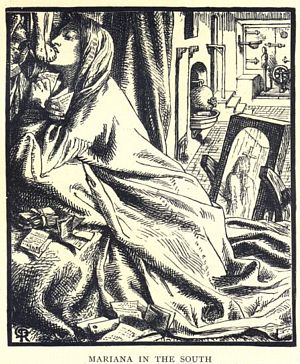
Mariana in the South
Figure: Woodcut. Monogram, lower left. Mariana kneels to the left, kissing
the feet of a crucifix on the wall. Behind her, a free-standing mirror
reflects the scene.
tration in question, which is intended to
represent the verse describing how
- “in a clear-wall'd city on the sea
- Near gilded organ-pipes, her hair
- Wound with white roses, slept St. Cecily;
- An angel looked at her.”
As I have already mentioned in Chapter IV., there is reason to believe
that Rossetti availed himself of a
design by Miss Siddal
for the centre figure of St. Cecily
.
A second
illustration for the same poem, showing how
“mythic
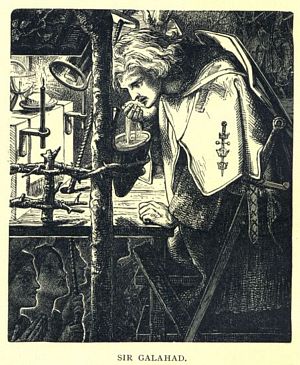
SIR GALAHAD.
Figure: Woodcut. Sir Galahad, kneeling at the top of a flight of steps
before the altar of a deserted chapel in a wood at night, is
in the act of making the sign of the cross on his
face with the holy water in a vessel suspended on a
beam. The chapel is brilliantly lit within so
that the faces of the girls standing below, praying and
tolling the golden bell hanging at the entrance, are
illuminated by the reflection of light from the
altar.Surtees, p. 70
Uther's deeply-wounded son” was tended in the Vale of
Avalon by weeping queens, Tennyson liked best of any in the book, and indeed it
can hardly be surpassed for beauty. The remaining three designs— intended to
illustrate
“The Lady of Shalott”,
“Sir Galahad” at the secret shrine, and
“Mariana in the South”, have each a separate and never-fading charm, without entirely rivalling
the exquisite workmanship and elaborate finish of the two just mentioned.
Messrs. Macmillan, who afterwards acquired the rights of the Moxon “Tennyson,” have with great generosity placed the original five wood-blocks
[woodblock 1]
[woodblock 2]
[woodblock 3]
[woodblock 4]
[woodblock 5] at my disposal, and I can only
regret that the electrotypes made from them do not do better justice to
Rossetti's work and to Dalziel's really fine cutting. Not that Rossetti himself was
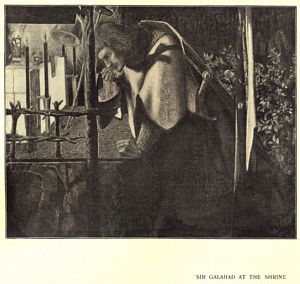
SIR GALAHAD AT THE SHRINE
Figure: Water color. Sir Galahad, kneeling at the top of a flight of steps before
the altar of a deserted chapel in a wood at night, is in the act
of making the sign of the cross on his face with the holy
water in a vessel suspended on a beam. The chapel is
brilliantly lit within so that the faces of the girls standing
below, praying and tolling the golden bell hanging at the
entrance, are illuminated by the reflection of light from the
altar.Surtees, p. 70
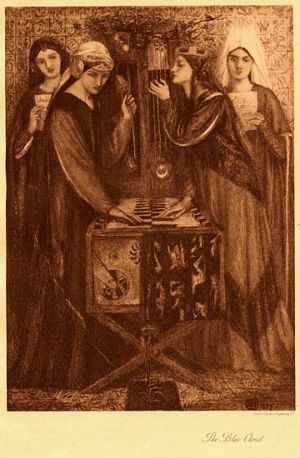
The Blue Closet
Swan Electric Engraving Co.
Figure: Water color. Monogram and date lower right: "1857." Two Queens playing upon the keys of a clavicord within a
chamber, the walls and floor of which are tiled in brilliant
blue, from which the drawing takes its name. A red lily rises
from a patch of earth in the centre foreground. Surtees,
p. 50
entirely satisfied with the results. As in
the case of the Allingham block, he found himself at variance with the engravers
more than once, especially Dalziel, preferring the simpler and broader work of
Linton (
Sir Galahad
and
Mariana
). In one of those little humorous flashes that generally mean either
much more or much less than they seem to, he wrote to Bell Scott:
“I have designed five blocks for Tennyson, some of which are still
cutting and maiming. It is a thankless task. After a fortnight's work my
block goes to the engraver, like Agag delicately, and is hewn to pieces
before the Lord Harry.
“ADDRESS TO THE DALZIEL BROTHERS.
- “O woodman, spare that block,
- O gash not anyhow!
- It took ten days by clock,
- I'd fain protect it now.
-
Chorus—Wild laughter from Dalziel's
workshop.”
For these Tennyson designs, according to Mr. W. M.
Rossetti, his brother got £15 each.
1Separate pen-and-ink drawings
[drawing 1]
[drawing 2]
[drawing 3]
[drawing 4] exist for most, if not for all of
them,
2 and water-colours were afterwards painted from
three:
St. Cecily
(1857), described by a well-known writer as glowing “with
such a glow of gold and amethyst as sometimes burns upon the sunset
Atlantic”;
Sir Galahad in the Chapel
(1859), formerly in Mr. James Leathart's collection, and now in the
Corporation Gallery at Birmingham;
Mariana
(1862)—not to be confused with an oil
Mariana
of later date, named direct from the lady in “Measure for Measure.” The water-colour belongs to Mr. George
Rae, and is also known by the title
Heart of the Night
.
About 1857 was designed a drawing in crayons of
St. Luke the Painter
, for which the artist composed the fine sonnet beginning:
- “Give honour unto Luke Evangelist;
- For he it was (the aged legends say)
- Who first taught Art to fold her hands and pray.”
This sonnet was afterwards included in the “House of
Life” series, under “Old and New Art”, as
No. LXXIV. It is an interesting enunciation of “Pre-Raphaelite” principles.
Since abandoning his picture of
Hist, said Kate the Queen
, in 1853, Rossetti had up to this date produced no further work in oil,
a rather remarkable fact considering that both his earlier works were in the
more important medium. He had started upon
Found
, it is true; but the amount of work done upon the actual canvas was
inconsiderable. Ruskin had once or twice half advised him to take up
Transcribed Footnote (page 79):
1 In the “
Memoir ” the price is given as £30.
Transcribed Footnote (page 79):
2 Mr. C. F. Murray owns three out of the five, the
missing ones being
Sir Galahad
and
The Lady of Shalott
.
oil, on account of its superior market value
as compared with water-colour. “Very foolish it is, but so it
is,” as he wrote; and by way of backing his recommendation he
commissioned, somewhere about 1855. a
St. Catharine
picture for himself. This was finished in 1857, but an alteration to the
figure at the last moment so displeased the purchaser that he begged Rossetti
either to sell it to someone else or to alter it back again. The picture
represents a mediæval artist painting from a lady a full-length picture of St.
Catharine, with her wheel and other accessories. It is described as being
especially rich in colour, and belonged some years ago to Mr. J. G. Kershaw, by
whom it was exhibited at the Burlington Fine Arts Club in 1883.
In point of number and interest the productions of 1857 are remarkable. It was
the year of the Oxford frescoes, for one thing, though these dragged on till
1859; and it was the year of a charming little series of water-colours, which
were acquired one after the other by Rossetti's newly-made acquaintance, William
Morris, who, some time later, being in want of capital for his own business,
sold them in a batch to their present possessor, Mr. Rae. These comprise—to
leave the frescoes until later:
(1)
The Damsel of the Sanc Grael
, robed in green, holding a long-stemmed cup in her hand, and with the
holy dove above her bearing a censer in its beak. Many years later, in 1874,
Rossetti painted an
oil version of the same
subject for Mr. Rae, in which he modernized, and many will think spoilt, the
archaic simplicity of the design. As both versions are reproduced in this book,
readers will be able to form their own opinions on the point, though they will
miss in the one case the primitive charm of the fresh green colour, and in the
other the sumptuous and heavy richness of the painting.
(2)
The Death of Breuse sans Pitié
, one of the crudest and least successful of all Rossetti's
water-colours. The terribly realistic encounter of two knights struggling in the
foreground, and the grimness of the scene behind, where a dead man is hanging
contorted on a tree while a lady waits beside him with a halter round her neck,
has a repulsive and unpleasant effect. The composition, moreover, is grotesque
and strained, and the painting (although Rossetti worked on it later)
unsatisfactory.
(3)
The Chapel before the Lists
, a scene suggested by Malory. In a lighted chapel a lady is helping to
arm a kneeling knight in red, her long white head-dress, as she stoops to kiss
him, falling like a mantle down her blue dress. She is holding his long
two-handed sword. Upon the pointed shield of the knight is a figure of a maiden
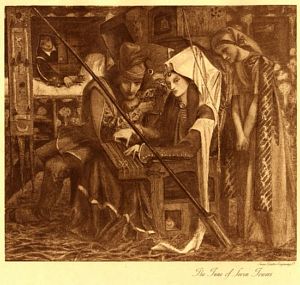
The Tune of Seven Towers
Swan Electric Engraving Co.
Figure: Water color. A woman seated in an oak chair towering above her into a
belfry plays upon a musical instrument which is fitted to the
chair and lies across her knees. A bell rope hangs down from
above; a staff, with banner suspended, cuts diagonally across
the picture.Surtees, p. 51

THE DAMSEL OF THE SANC GRAEL
Figure: Water color. Inscribed upper left and right: "Sanct Grael." She stands whole-length to front with hair outspread, holding
in her left hand a long-stemmed cup and a basket of bread
covered with a little white napkin; her right hand is raised in
blessing. The Holy Dove bearing a censer in its beak has come to
rest above her head. Surtees, p. 51
in distress (Andromeda, or the Princess in the dragon story).
Beyond the chapel is a tented field, and knights going forth to joust. This
little drawing was considerably touched up in 1864, and bears the double date in
one corner.
(4)
The Tune of Seven Towers
, a quaint little scene, very characteristic of Rossetti's fertility and
originality of invention. A lady in red with mediæval head-dress is sitting in a
high oaken chair, which above towers up into a sort of belfry, and is playing
upon a musical instrument which also forms part of the chair. A man in green
doublet, with long boots, sits sideways on a stool close by watching her, and a
second lady stands mournfully behind. In an alcove at the back a maid is seen
reaching through a little window to place an orange branch upon a bed. A banner
hangs down at the right from a pole which cuts the picture diagonally in half,
and which ends in a socket beside the oaken chair.
(5)
The Blue Closet
, the gem of the collection for beauty of colour, represents two queens,
the one on the left in red with green sleeves, and the one on the right in
crimson and grey, playing upon opposite sides of a carved and inlaid dulcimer or
clavichord. Two other ladies stand behind them singing. Above their heads the
wall is tiled with blue, and so likewise is the floor, suggesting the title of
the picture. Strong blue touches upon an escutcheon at the back carry the
thought still further.
William Morris, with whom the last two pictures were especial favourites, used
their romantic and sweet-sounding titles as themes to base two poems on; and
this has led to a confused idea that the pictures illustrate the poems. In
reality they have nothing in common but their names, and for these the painter,
not the poet, was responsible. In Mr. Rae's catalogue the poems are quoted.
A sixth subject acquired in the same manner as the others, and at the same time,
by Mr. Rae, was the early water-colour triptych of
Paolo and Francesca
, which used to belong to Mr. Ruskin and has already been mentioned (
see page 66).
The Wedding of St. George
, also in Mr. Rae's collection, belongs to this year, but was not
acquired from Mr. Morris. The old story of St. George and the Dragon had a
powerful influence upon the romantic school to which Rossetti belonged.
Burne-Jones's variations upon it are well known, and Rossetti also, besides
treating it as a whole in a series of designs for stained glass windows, painted
St. George more than once at typical stages of the adventure. In this earliest
version he is resting from his feat, clad in armour, with a gorgeous
surcoat, whilst the princess, now wholly his,
kneels and leans her head upon his breast, cutting off a large dark lock of hair
which she has bound upon the crest of his helmet. The dragon's head, a monstrous
object, stands grotesquely in one corner in a box with ropes attached for
drawing it along. In the background is a hedge of flowers and attendant angels
playing on bells. “One of the grandest things, like a golden dim
dream,” wrote James Smetham the Methodist painter, in a letter
quoted by Mr. W. M. Rossetti. “Love ‘credulous all gold,’ gold armour, a
sense of secret enclosure

THE GATE OF MEMORY.
Figure: Water color. Monogram lower right corner. On the right a prostitute stands at dusk under an
archway, watching a group of dancing children and recognizes
herself as once she was in the figure of a seated,
flower-crowned child. An over-hanging lamp casts a dull
yellow light upon the children and illumines for a moment a
large rat as it scuttles out of sight. Fine houses with
lighted windows supply the background.Surtees, p.
56
in ‘palace-chambers far apart’—quaint chambers in quaint palaces,
where angels creep in thro' sliding panel doors, and stand behind rows of
flowers, drumming on golden bells, with wings crimson and
green.”
Other water-colours of 1857 are
The Gate of Memory
, which used to belong to the Rev. Moncure Conway, representing a woman
standing under an arch and watching some children at play—a theme based upon W.
B. Scott's “Mary Anne;”
The Garden Bower
, a drawing of a girl drinking out of a long glass, bought by Mr. Plint,
and subsequently acquired by Mr. Leathart; and
A Christmas Carol
, one of those scenes of chamber music that Rossetti was so fond of
depicting in his early days. This beautiful little water-colour (also formerly
in Mr. Leathart's collection, and now owned by Mr. Fairfax Murray), has no
affinity with the
later oil painting of the same
name
belonging to Mr. Rae, which represents a girl robed in some
Eastern stuff with her head thrown back, singing to a lute “a song of
Christ's birth with the tune of Bululalow”—as the old Winchester
mystery phrases it. The water-colour, it will be seen from the
plate, represents a lady singing and playing upon a
sort of clavichord, whilst two maidens comb out her beautiful long hair. I have
seen it suggested that
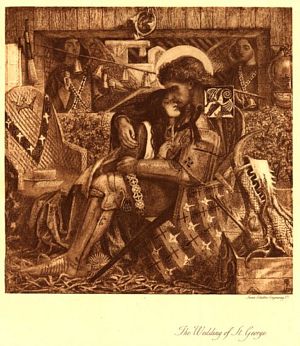
The Wedding of St. George
Swan Electric Engraving Co.
Figure: Water color. Monogram and date, lower right corner: "1857." In a confined space crammed with accessories, St. George is
kissing the Princess; enveloped in his arms she is in the act of
cutting off a lock of her hair.Surtees, p. 55
the subject was taken from Swinburne's poem
of the “Christmas Carol”, which begins:
- “Three damsels in the queen's chamber;
- The queen's mouth was most fair;
- She spake a word of God's mother
- As the combs went in her hair.”
A reference to “Poems and Ballads” would have shown that this is not the case, but that, as with the
Blue Closet
, the
Tune of Seven Towers
,
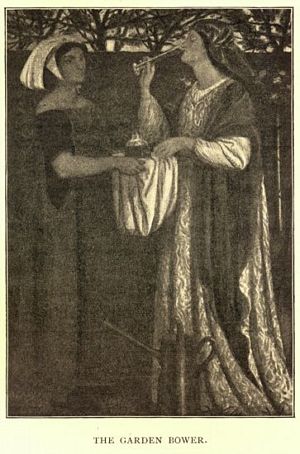
THE GARDEN BOWER.
Figure: Water color. Monogram, date lower left corner: "1859." Two women in a garden face each other. The one on the right
is drinking from a long glass offered to her by a serving-woman
in a blue smock (Fanny Cornforth). Espalier trees against a
red-brick wall provide the background. Surtees, p.
68
and
Arthur's Tomb
, the poem took its inspiration and title from Rossetti's picture. The
Christmas Carol
was exhibited at the Liverpool Academy, together with the water-colour,
Dante's Dream
, in 1858. It was done at the close of the year, and is appropriately
dated “Xmas 1857-8.”
We now come to the story of the Oxford “Frescoes,” as they are called—although
not really fresco at all, but tempera—to which a short introduction is
necessary. A much fuller account of the whole proceeding than I can give here
will be found in Mr. Mackail's “Life of William
Morris,” volume i. The artistic and romantic impulses stirring in
England at the midpoint of the century had, as we have seen, produced one
notable movement in the shape of the “Pre-Raphaelite Brotherhood.” Five or six
years later they gave birth to another, not less important either in regard to
its results or to the quality of men engaged in it; and very shortly afterwards
a fusion of the two took place. The second of these “Brotherhoods” —the word was
actually adopted for a time—had its origin at Exeter College, Oxford, in the
personalities of William Morris and Edward Burne-Jones, and resolved itself at
first, like its forerunner, into a “crusade and holy warfare against the
age,” with a much wider scope
of conflict and with an added religious tinge
which was hardly visible, though doubtless present, in the other. The
parallelism of effort and ideal which appears in these two independent
movements—for the “P.R.B.” was not among the primary influences at Oxford— might
strike one at first as a coincidence, were it not merely a fresh instance of a
broad and general fact that new ideas ripen like corn of which the sowers are
many and the harvest universal. The Oxford group, like the “P.R.B.,” published a
magazine to illustrate, not to preach, their principles, and had as a tangible
link with Rossetti the same warm appreciation of the beauties of the Arthurian
legend. Mr. Mackail says it was at a bookshop in Birmingham that Burne-Jones
first discovered (about 1855) a copy of Southey's “Malory,” which he used to read in snatches. Morris, on hearing of
this, bought the book, which “at once became for both one of their most
precious treasures; so precious that even among their intimates there was
some shyness over it, till a year later they heard Rossetti speak of it and
the Bible as the two greatest books in the world, and their tongues were
unloosed by the sanction of his authority.”
In the Christmas vacation of 1855 Burne-Jones came up to London, and after
attending a meeting of the Working Men's College in order to see Rossetti, whom
he and Morris had already begun to worship, he was introduced to him at Vernon
Lushington's rooms in Doctors' Commons. The next day he visited Rossetti in his
studio at Blackfriars, and saw him working on
Fra Pace
. Thus was laid the foundation of an alliance that even more potently
than the “P.R.B.” has changed the face of art in England—an alliance which
consolidated the principal factors that were working in the field of reform, and
resulted in the formation of a group which for combined poetic, literary, and
artistic power is unapproached in the history of the nation. Incidentally, it
was this visit that determined Burne-Jones—hankering after art but predestined
for the Church—to become a painter; and no one can fail to be struck with the
evidence of Rossetti's influence upon his early work.
To the “
Oxford and Cambridge Magazine,” William Morris's organ, which ran for the twelve months of 1856,
Rossetti contributed
“The Burden of Nineveh”,
“The Blessed Damozel”, (a little altered from the
Germ
version), and
“The Staff and Scrip”. Ruskin wrote to him wild with curiosity to find out who was the author
of the first-named poem, and it is interesting to know from his hesitation in
replying that Rossetti up to that time had been shy of discussing or mentioning
his poetry to Ruskin.
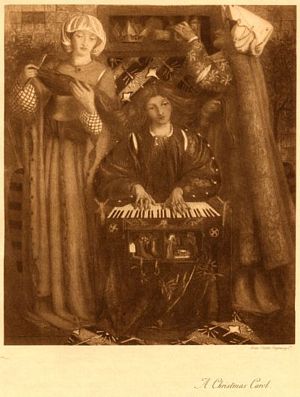
A Christmas Carol
Swan Electric Engraving Co.
Figure: Water color on panel. Monogram and date upper left: "Xmas 1857-8." A young woman in red, with the face of Elizabeth Siddal,
having her hair combed out by two attendants, is seated in the
centre facing to front, playing a clavichord decorated on two
panels with scenes of the Annunciation and Nativity, and hung
with sprigs of green foliage; holly trees in red barrels stand
to left and rigth against a wall of bright blue tiles; a black
and gold tapestry hangs behind the central figure and falls to
form a carpet beneath her feet. Surtees, p. 55
By the end of 1856 Burne-Jones and Morris had left Oxford and were settled in
London, occupying the rooms at 17, Red Lion Square, which had formerly served as
a studio for Rossetti and Deverell. Both were deeply under the spell of
Rossetti's influence. “Morris,” says Mr. Mackail, “became not only a
pupil, but a servant.” Once, when Burne-Jones complained that the
designs he made in Rossetti's manner seemed better than his own, Morris answered
with some vehemence, “I have got beyond that; I want to imitate Gabriel
as much as I can.” For this
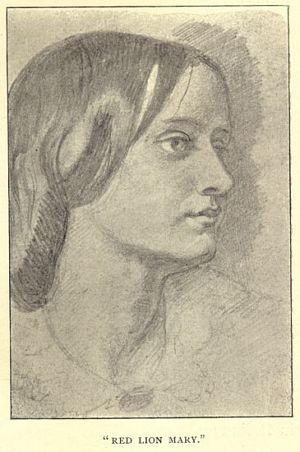
RED LION MARY.
Figure: Pencil. Head and shoulders of the maid at 17 Red Lion Square, during
the occupancy of Morris and Burne-Jones. Head nearly in profile
to right against a shaded background. Surtees, p. 182
reason he had turned painter too, Rossetti being somewhat dogmatic as
to the limit of possible vocations; and inasmuch as the latter's theory then was
that men who had brains should paint, and men who had money should buy pictures,
Morris, being possessed of both money and brains, was compelled to fulfil the
double function. To Rossetti's credit, be it said, he was just as keen to get
his friends' pictures bought as his own.
The
ménage at Red Lion Square lasted till 1859, and was a sort of rallying point
for all members of the circle. “From the incidents that occurred or were
invented there,” says Mr. Mackail, “a sort of Book of the Hundred Merry
Tales gradually was formed, of which Morris was the central figure. A great
many of these stories are connected with the maid of the house, who became
famous under the name of Red Lion Mary. She was very plain, but a person of
great character and unfailing good-humour, with some literary taste and a
considerable knowledge of poetry. She cooked and
mended for the new lodgers, read their books and letters, was anxious to
be allowed to act as a model, and neglected all her other duties to
stand behind them and watch them painting.”
1
Transcribed Footnote (page 85):
1 The following story, stripped of some absurd and
unlikely details about rolling
The rooms were “the quaintest in all London,” as Burne-Jones wrote, “hung
with brasses of old knights and drawings of Albert Dürer;” and in
order to furnish them comformably recourse had to be had to invention. A local
joiner was engaged to manufacture furniture from Morris's own designs:
“intensely mediæval” was Rossetti's description of it to a
friend, “tables and chairs like incubi and succubi.” Next came
the idea of painting pictures on walls, cupboards, and doors, about the time
that Morris was planning to build himself at Upton, in the neighbourhood of
Bexley Heath, a “palace of art” the like of which should never have been seen.
In the
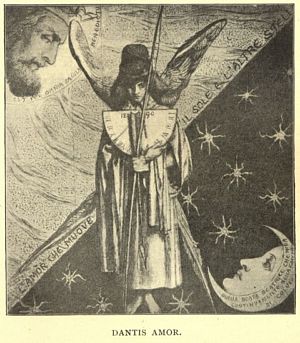
DANTIS AMOR.
Figure: Pen and brown ink. Inscribed around the sun, upper left: "QUI EST
PER OMNIA SAECULA BENEDICTUS." Inscribed around the moon, lower right:
"QUELLA BEATA BEATRICE CHE MIRA CONTINUAMENTE NELLA FACCIA DI COLUI."
Inscribed along the diagonal dividing line: L'AMOR CHE MUOVE IL SOLE E
L'ALTRE STELLE." Love, dressed as a pilgrim, stands full-face holding a
sun-dial dated 1290. In the upper left corner the
sun (head of Christ); lower right corner a crescent moon (head
of Beatrice). The background is divided diagonally between the
sun's rays and the stars. Surtees, p. 74
general enthusiasm Rossetti set to and designed a pair of panels for a
cabinet—the subject of his early pen-and-ink drawing,
The Salutation of Beatrice
, representing in two compartments Dante meeting Beatrice in Florence,
and again in Paradise, with (to go between them) a quaint figure of Love
revelling in a medley of horologies and symbols, poised between the sun (a head
of Christ) above, and the moon (a head of Beatrice) below, and lavishly
intertwined with inscriptions in Italian and Latin. This is known as
Dantis Amor
.
At the risk of repetition, I may mention once more a side of the movement which
is apt to be overshadowed by its momentous and far-reaching results; I mean the
intense lightheartedness and sense
Transcribed Footnote (page 86):
[
1] eyes and feigning madness, is told of Red Lion
Mary, as a sample of her imperturbable good-nature. Rossetti one day, on
her entering the room, strode up to her, and in deep resonant tones,
with fearful meaning in his voice, declaimed the lines:
- “Shall the hide of a fierce lion
- Be stretched on a couch of wood,
- For a daughter's foot to lie on,
- Stained with a father's blood?”
Whereupon the girl, quite unawed by the horrible proposition,
replied with baffling complacency, “It shall if you like, sir!”
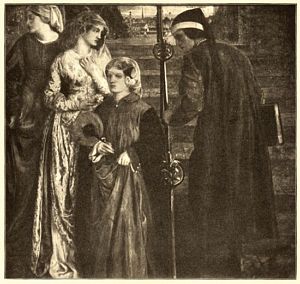
THE SALUTATION OF BEATRICE: PANELS. RIGHT COMPARTMENT: MEETING IN
FLORENCE LEFT COMPARTMENT: MEETING IN PARADISE
Figure: Oil on two panels, reproduced in Marillier as top and bottom,
rather than as left and right. Left (upper) panel: inscribed above
Beatrice's head: "Domicella Beatrix de Portinaris." Inscribed above
Dante's head: "Dantes de Alghieris." Right (lower) panel: inscribed on
scroll in both upper corners: "Hortus Eden." Inscribed behind Dante's
head: "Poeta Dantes de Alghieris de Florentia," behind Beatrice's head:
"Beata Beatrix." In the left (upper) panel, Beatrice, facing left
descends a flight of stairs, holding a fan in her right hand. She is
attended by two women at left. Dante, ascending the stairs, turns
profile facing left to look at her. He holds the railing in his left
hand and a book in his right. A town can be seen upper background. In
the right (lower) panel, Dante and Beatrice, both garlanded with leaves,
stand facing each other in a flower garden. Two women at right playing
stringed instruments look on.
of fun which prevailed amongst this band of
artistic pioneers. There was nothing about them of the mawkish affectation which
discredited the æsthetes who came after them. When Burne-Jones was down at
Upton, helping to decorate the Red House in 1860, Rossetti wrote to a mutual
friend: “I wish you were in town, to see you sometimes, for I literally
see no one now except Madox Brown pretty often, and even he is gone to join
Morris, who is out of reach at Upton, and with them is married Jones
painting the inner walls of the house that Top built (Morris was always
called ‘Topsy’ by his friends). But as for the neighbours, when they see men
pourtrayed by Jones upon the walls, the images of the Chaldeans pourtrayed
(by
him!) in Extract Vermilion, exceeding all probability
in dyed attire upon their heads, after the manner of no Babylonians of any
Chaldea, the land of anyone's nativity—as soon as they see him with their
eyes, shall they not account him doting and send messengers into Colney
Hatch?”
The Red House, on which so much love and labour had been spent, was abandoned in
1865, owing to the exigencies of Morris's rapidly growing business, and at the
break-up the
Dante and Beatrice
panels were removed from their cabinet and sold. They came into the
possession of Sir Frederick Burton, the late Director of the National Gallery,
from whom they were afterwards acquired by Mr. Leathart. At the sale of the
latter's pictures in 1896 they were bought by Mr. F. J. Tennant, of North
Berwick, in whose possession they doubtless remain. One is dated, “June 15-25,
1859,” and the other has the year merely.
The other versions extant of the
Dante and Beatrice
subject, besides the
early pen-and-ink
composition
belonging to Mr. Rae, (
see page
24
), which is interesting for comparison because Rossetti afterwards
reversed the grouping of both the pictures, consist of a
water-colour of the left compartment, inscribed
Guardami ben; ben son, ben son Beatrice, painted for Mr. Boyce in 1852, and given by him to Mr. Philip Webb,
and a replica of the same done for Mr. Graham in 1864, and sold some years since
at Agnew's under the title of
Beatrice in Paradise
; there was also a
water-colour of the
entire picture done for Lady Ashburton in 1864, and still in her family. The
latter is referred to in some letter as a “double Dante,” by which title Mr. W.
M. Rossetti has catalogued it among his brother's works. Mr. Rossetti has
moreover included in his list, as done for Mr. Rae in 1863, another water-colour
copy, of which there is no record. The descriptions given by different
authorities of these versions are so
confusing that no little trouble is required
to reconcile and put them straight. Nowhere, for instance, can a hint be found
that the diptych owned by Mr. Leathart was composed of the panels painted for
William Morris and sold at the break-up of the Red House; the natural
presumption for anyone unacquainted with the history being that the two were
separate versions. Mr. F. G. Stephens, in fact, actually states as much in his
“
Portfolio” monograph on Rossetti.
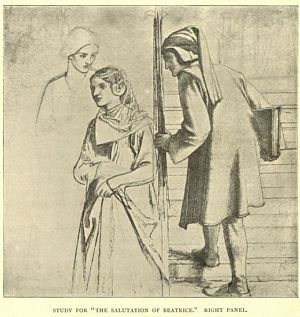
STUDY FOR THE SALUTATION OF BEATRICE. RIGHT
PANEL.
Figure: Pencil, pen, and Indian ink. Study of Dante for the left panel; back turned mounting
steps, head in profile to left, his gaze directed at Beatrice
who stands whole-length, lightly sketched. In the foreground a
woman with the face of Red Lion Mary moves to the
left.Surtees, p. 72
The story of the
Dantis Amor
design is also rather complicated, and even the latest and best-informed
writer on the subject, Mr. Mackail, does not appear to be entirely right about
it. It was painted at the same time as the other panels, and was itself a centre
panel. Afterwards, when the side ones were removed and framed together, this
centre-piece remained over. Rossetti for a long time kept it in his studio,
meaning to do something to it; then it was
bought by Mr. Gambart, the picture-dealer, as it stood. Another,
much
simpler design, of the figure of Love in
a narrow pointed oval, was made by Rossetti and painted in the centre of the
framed panels—probably for Mr. Leathart. Mr. Murray, who is my
informant on some of these points, has the pen-and-ink designs for both
versions.
Besides the
Dante and Beatrice
panels, Rossetti painted on the backs of two armchairs, either at Red
Lion Square or at the Red House, subjects from Morris's own poems, one
representing
Gwendolen in the Witch-tower
, with the Prince below kissing her long golden hair, and another
The Arming of a Knight
, from the Christmas Mystery of “Sir Galahad”.
These chairs are now in the possession of a member of the Morris family, and, so
far as I know, they have never been mentioned in a list of Rossetti's works
before. They and the Dante panels are particularly interesting as being painted
by Rossetti's own hand, which was not the case with the designs executed a year
or two later (1861 and 1862) for the firm of Morris, Marshall, Faulkner
& Co., of which he was one of the original co-partners.
During the long vacation of 1857 Rossetti went up to Oxford with Morris on a
visit to the architect, Benjamin Woodward, who was at work upon the new Museum
buildings and was also constructing a debating hall for the Union Society. There
had been a battle royal between the old semi-classical style of architecture and
the new Gothic, represented by Woodward, over the plans for the Museum, and a
feeling of glorification and enthusiasm was in the air. Rossetti caught it, and
seeing an opportunity for mural decoration of a kind never previously attempted
in England in the new hall of the Union, he became fired with an idea for
carrying it out. In his ready mind the scheme probably shaped itself at once
exactly in the form which it afterwards took. The hall, which is no longer used
for debates, but has become a reading-room, was a long building, with an apse at
each end, and a gallery half way up running all the way round. In this gallery
were bookcases, and above the cases were ten semicircular bays, each pierced
with a pair of circular six-foil windows. These bays, it was suggested, should
be painted with scenes from the Arthurian legend, and the roof, as part of the
general scheme, was to be decorated in a harmonious manner. A building committee
was in charge of the operations, and without any clear idea of its
responsibilities or restrictions it fell in with Rossetti's proposal that he and
a select band of artists should execute the work gratuitously, but that the
Union should defray their expenses at Oxford and
should provide all necessary materials. The
time estimated for completing the work was six weeks. Seven artists, including
Rossetti, Burne-Jones, and Morris, were enlisted without much trouble, the
remaining four being Arthur Hughes, Spencer Stanhope, Val Prinsep, and J.
Hungerford Pollen, who had already won much credit from his painting of the roof
in Merton College Chapel. Madox Brown and W. B. Scott declined to co-operate,
but Munro, the sculptor, was given a share, and carried out some carvings in the
porch, one of which was from a design by Rossetti of
Arthur sitting with his knights at the round table. For the rest,
Rossetti took as subjects for two bays
Launcelot asleep before the Chapel of the Sanc Grael
and
Sir Galahad, Sir Bors and Sir Percival receiving the Sanc
Grael
; Morris chose
Sir Palomides' Jealousy of Tristram and Yseult
; Burne-Jones
Nimuë bringing Sir Peleus to Ettarde
; Prinsep
Merlin lured into the pit by the Lady of the Lake
; Stanhope
Sir Gawain meeting three Ladies at a Fountain
; Pollen
King Arthur receiving the sword Excalibur
; and Hughes
King Arthur conveyed by weeping queens to Avalon
. This left two bays still undisposed of, which Rossetti thought might be
done by anyone who finished before the others; but in a short time it was found
that the work in hand was considerably more than had been anticipated. By July,
1858, it was still in progress, judging from the following letter which Rossetti
wrote to his friend Professor Norton in America:
“ My own subject (for each of us has as yet done only one) is Sir
Launcelot prevented by his sin from entering the Chapel of the San
Grail. He has fallen asleep before the shrine full of angels, and
between him and it rises in his dream the image of Queen Guenevere, the
cause of all. She stands gazing at him with her arms extended in the
branches of an apple-tree. As a companion to this I shall paint a design
which I have made for the purpose of the attainment of the San Grail by
Launcelot's son Galahad, together with Bors and Percival. . . . Several
spaces still remain to be filled, and will be so gradually as time
allows. Something more, if not all, will be done this long vacation. . .
. There is no work like it for delightfulness in the doing, and none I
believe in which one might hope to delight others more according to his
powers.”
Confirmatory evidence of the beauty of the designs at the time when they were
first executed is to be found in a notice by Mr. Coventry Patmore, dated
December 26, 1857, which speaks of the colour as “sweet, bright, and pure
as a cloud in the sunrise,” and “so brilliant as to make the walls look like
the margin of an illuminated manuscript.”
Unfortunately the delight was not to be of long duration. Almost before the
pictures were finished they had begun to decay, the effect of tempera laid
direct upon a new brick wall, with no pre-
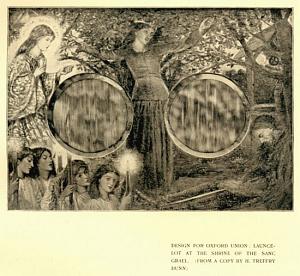
DESIGN FOR OXFORD UNION: LAUNCELOT AT THE SHRINE OF THE SANC GRAEL.
(FROM A COPY BY H. TREFFRY DUNN)
Figure: Oil painting on a mirror. Copy by H. Treffry Dunn, DGR's assistant.
Inscribed around the angel's halo at left: "ANCILLA SANC GRAEL."
Guenevere stands center, arms outstretched, in front of a tree.
Launcelot sleeps lower right, his hands on his sword, which rests
between his legs. A haloed angel holds the grael at upper left, and four
white-robed girls in candles stand lower left.
paration but a layer of whitewash, being
quite inadequate to resist the English climate. Rossetti's design, though the
finest of all, was never completed, being interrupted by an illness which seized
Miss Siddal; in fact, at the time the above sanguine letter was written, the
whole work had practically come to a standstill, and was never resumed. In 1859
some arrangement was entered into by the Union with a Mr. Riviere to fill the
three blank compartments; and after that the ill-fated undertaking, on which so
much enthusiasm, so much pains, and so much skill had been spent, gradually
faded away and
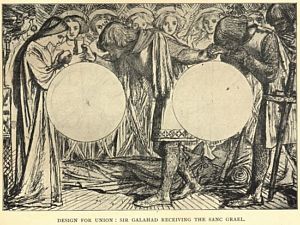
DESIGN FOR UNION: SIR GALAHAD RECEIVING THE SANC GRAEL.
Figure: Pen and brown ink. Inscribed above the figures: "Dom Galahad," "Dom
Percival," "Dom Bors," "Soror D Percival." The incident is that of the attainment of the Holy Grail by
Sir Galahad who reverently recieves it, while leading forward
Sir Percival, whose sister lies dead on the ground beside
him.Surtees, p. 53 A row of angels stands in the background.
resolved itself into what it is to-day, a dingy blur of colours in
which may be distinguished the occasional vague form of an armoured limb or a
patch of flowery background. The roof alone, which was redecorated in 1875,
remains a success, and a tribute to the genius of William Morris, whose design
for it—almost his first work of the kind—was done in a single day and carried
out with customary energy and vehemence.
In 1869 the matter of the Frescoes came up for discussion by a new generation at
Oxford, and some overtures were made to Rossetti and William Morris on the
subject. The fiasco had not come about without unpleasantness, both on account
of the expenses incurred
by the artists and the unsatisfactoriness of
the result; but Rossetti, at the invitation of Mr. J. R. Thursfield, who was
chairman of a committee appointed to inquire into the matter, did at this later
date send down his assistant, Mr. Treffry Dunn, to see whether anything could be
arranged. Mr. Dunn made a sketch of the Launcelot design in water-colours, which
I would gladly have reproduced here if I had succeeded in tracing it.
Unfortunately no other
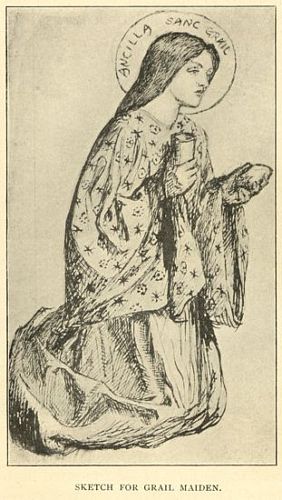
SKETCH FOR GRAIL MAIDEN.
Figure: Pen and brown ink. Inscribed on halo: "ANCILLA SANC GRAEL." An
angel kneels, holding bread and a chalice.
complete picture of the composition exists, though Mr. Murray owns a
few rough drawings,
one (done from Burne-Jones) of
Launcelot asleep
, with the image of Guenevere just sketched in; one
for the
floating Grail maiden,
reproduced here; and one or two slightly more
finished sketches for the Guenevere.
[sketch 1]
[sketch 2] The reproduction given here is from an
oil painting on a mirror belonging to Mr. T. Watts-Dunton. It is by Dunn, and so
may be taken as fairly accurate. Of the
Sir Galahad, Sir Bors, and Sir Percival design a
pen-and-ink sketch is
preserved at the British Museum, which serves to show the form.
1 Rossetti painted a most briliant little
water-colour of it—all red and gold—in 1864, for the late Miss
Heaton, of Leeds. A third design, which was intended for one of the vacant bays,
was
Launcelot escaping from Guenevere's Chamber
. The drawing of this was bought by Mr. Plint in 1859, and later was in
the possession of Rossetti's solicitor, Mr. Anderson Rose. It now belongs to Mr.
Fairfax Murray, to whom I am indebted for permission to
reproduce it.
Rossetti's connection with Oxford, and its intercalation in his work, does not
end with the Union paintings. It was destined to
Transcribed Footnote (page 92):
1 Col. Gillum has another rough sketch, bought at
Rossetti's sale in 1883.
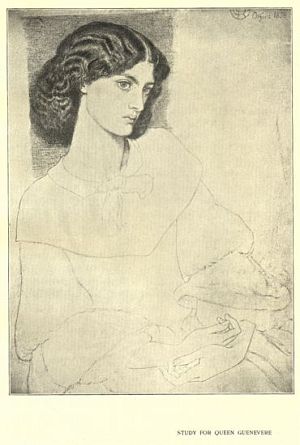
STUDY FOR QUEEN GUENEVERE
Figure: Pen and ink. Monogram and date upper right corner: "Oxford 1858."
Jane Morris, seated, Seated, over half-length, turned to the right, her left
shoulder raised, her hands placed in her lap; only the head
inclined slightly forward, is finished. Surtees, p. 174
furnish him with a far more lasting
influence—a face that to the end of his life haunted his pictures with an
austere and solemn beauty, dominating and transforming all other kinds, so as
even to give rise to the suggestion—a shallow and ignorant one, it is true—that
he painted but one type of face. It was at the theatre, one night in the summer
of 1857, that Rossetti and Burne-Jones found themselves sitting near two
youthful Misses Burden, daughters of an Oxford resident, the elder of whom, by
her striking, almost exotic features
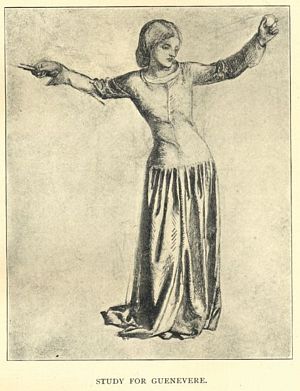
STUDY FOR GUENEVERE.
Figure: Pen and ink, with traces of water color. Study for Guenevere standing whole-length, arms outstretched
along the fork of an apple-tree, holding an apple in her left
hand; the upper part of her body inclined backwards to left, the
head turned three-quarters to right, eyes looking down.Surtees, p. 52
and southern wealth of dark wavy hair, appealed so forcibly to
Rossetti's painter eye that he obtained an introduction in order to ask for
sittings. A pen-and-ink head called
Queen Guenevere
, now in the National Gallery at Dublin, and evidently intended to
replace the earlier studies done for
Launcelot at the Shrine
, was one of the first fruits of this acquaintance, which, for the rest,
does not seem to have become really prolific of results until several years
later, when Rossetti's wife was dead. In the meantime William Morris, whose
admiration went even further, had married Miss Burden, and the casual
relationship of painter and sitter which existed between
her and Rossetti deepened into a friendship,
in which Miss Siddal participated, both up to and after her marriage. Another
friend made during this period was the poet Algernon Charles Swinburne, just
then approaching his fiery and splendid zenith. Swinburne was
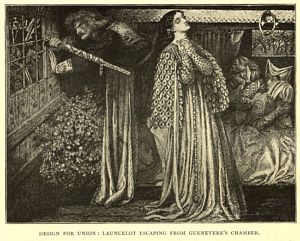
DESIGN FOR UNION: LAUNCELOT ESCAPING FROM GUENEVERE'S CHAMBER.
Figure: Pen and ink. Monogram and date lower right: "Oxford 1857." At left,
Launcelot stands, holding a sword. looking out a window at the attacking
knights. At center Guenevere stands facing right, her hands clasped to
her throat. Three distressed ladies-in-waiting sit at right. A bush
grows beside Launcelot.
known to the Morris set, one of whom brought him down to the Union,
where he first met Rossetti. Thus was another pillar added to the edifice of
famous men who have done so much for literature and art in our generation. Truly
there were giants abroad in those days, by comparison with whom these present
ones may well seem barren of greatness.
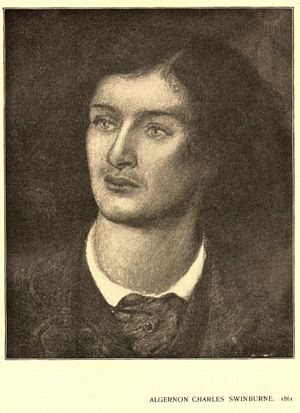
ALGERNON CHARLES SWINBURNE. 1861
Figure: Water color. Monogram and date upper right: "1861." Head and shoulders against and emerald-green ground, the head
looking to the left; bush of auburn hair; slight moustache;
yellow cravat and jewlled pin; blue coat. Surtees, p. 198
THE year 1858, while the Oxford affair was still in train, and
Rossetti was busied besides with the Llandaff triptych, saw the completion of
two important pen-and-ink drawings which had been in hand a long time
previously. These were the
Hamlet and Ophelia
(purchased from the easel by T. E. Plint, of Leeds, for
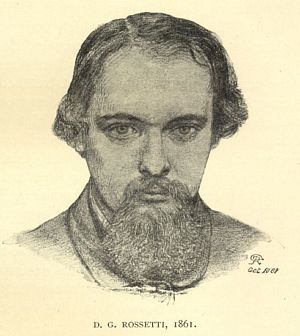
D. G. ROSSETTI, 1861.
Figure: Pencil. Text in lower right corner: monogram and Oct 1861. Head and
shoulders of DGR, facing front, with moustache and bushy
goatee.
£40, at the same time as the drawing of
Launcelot escaping from Guenevere's Chamber
) and
Mary Magdalene at the Door of Simon the Pharisee
. The former is now the property of Colonel Gillum, who owns several
interesting drawings by Rossetti. It represents the scene in Act III., where
Ophelia is returning Hamlet's gifts, holding them out to him while she turns
away her head. He, with arms outstretched upon the back of a sculptured seat, is
uttering the speech which ends: “What should such fellows as I do
crawling between earth and heaven?” The carving of the seat is
curious, and typical of the amount of thought that Rossetti put into such
accessory details. It represents the tree of knowledge, encircled by a crowned
serpent, between two angels with uplifted swords. In the space is inscribed
vertically “Eritis sicut deus scientes bonum et
malum.” On an upturned
miserere seat below is a carved relief
of Uzzah falling dead after touching the ark
of the covenant. Apart from its great wealth of detail and richness of
treatment, this drawing is highly remarkable for its intellectual conception of
the character of Hamlet. At a time when there lingered the hideous tradition of
nodding plumes and trunk hose, Rossetti has represented the Prince gracefully
and gravely attired, with hair tossed back, and such a handsome serious face as
Mr. Benson or Mr. Forbes Robertson would offer us to-day. The same subject, but
with considerable variation of treatment, was painted by Rossetti in 1866 as a
water-colour, and was bought by Mr. A. T.
Squarey, of Bebington, Cheshire, to whom it still belongs. In this version
Hamlet and Ophelia are standing at an opening in a gallery, he holding her right
hand in both of his. He is in black, she in a blue close-fitting robe with red
sleeves, and a design in yellow embroidered on the left shoulder. She is turning
her head away as in the other case, as if reluctantly suffering his caress. The
gifts she is returning, including an ivory casket, are ranged on a sill before
them. The reproduction, which is inserted here out of its proper place, will
make these differences clear. Mr. Fairfax Murray possesses early sketches for
both of these designs. In the one for the
pen-and-ink
drawing
the outstretched arms of Hamlet have been erased, and then
drawn hanging down or clasped in front. Rossetti afterwards went back to his
first idea, which was incomparably the better. The
sketch for the water-colour is dated 1865, possibly by some other
hand, and has been published under the erroneous title of
Romeo and Juliet
or
Lovers in a Window
. It is in pen-and-ink outline.
The drawing of
Mary Magdalene
, perhaps the most perfect of all Rossetti's early works, was begun
at least by 1853,
1 and continued to occupy his thoughts
in one form or another for many years. Perhaps it would be best, in
case there are any to whom the subject is not familiar, to quote his own
description of it, written however, not for this drawing, but for a
replica in oil which he supplied to Mr.
Clabburn, of Norwich, in 1865, or perhaps copied from an earlier letter:
“The scene represents two houses opposite each other, one of which is
that of Simon the Pharisee, where Christ and Simon, with other guests,
are seated at table. In
the
Transcribed Footnote (page 96):
1 Mr. Murray has an early
pen-and-ink sketch of the principal
group in which all the figures are reversed. The Magdalen,
restrained from behind by an old woman, is advancing towards the
spectator's left, and Christ with Simon is at the left of the
picture, inside a long portico or colonnade, to a pillar of
which Mary is clinging. Her lover and a girl are barring the
way. This may be the same as a “tiny sketch in
ink” mentioned by Mr. Sharp as having been at one
time in the possession of C. A. Howell, of whom more anon.
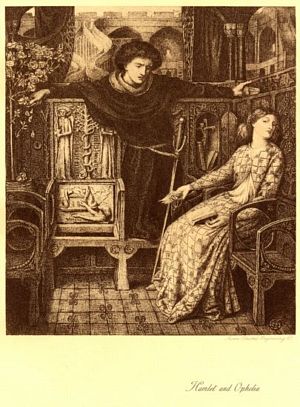
Hamlet and Ophelia
Swan Electric Engraving Co.
Figure: Pen and ink. Monogram lower right corner. In a small
oratory, Hamlet, wearing a black robe, stands center with arms
outstretched, leaning against an ornately carved panel depicting
Biblical scenes. He plucks a flower from a tree at left. He
stares at Ophelia, seated at lower right, who turns away from
Hamlet, returning his letters with her right hand, and holding a
book with her left.
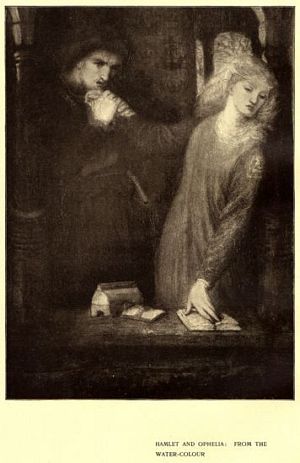
HAMLET AND OPHELIA: FROM THE WATER-COLOUR
Figure: Water colour. Hamlet, at left, clasps Ophelia's right hand
to his face. Ophelia stands right, face turned right away from
Hamlet, left hand resting on an open book on a table.
opposite house a great banquet is held, and feasters are
trooping to it dressed in cloth of gold and crowned with flowers. The
musicians play at the door, and each couple kiss as they enter. Mary
Magdalene has been in this procession, but has suddenly turned aside at
the sight of Christ, and is pressing forward up the steps of Simon's
house, and casting the roses from her hair. Her lover and a woman have
followed her out of the procession and are laughingly trying to turn her
back. The woman bars the door with her arm. Those nearest the Magdalene
in the group of feasters have stopped short in wonder and are looking
after her, while a beggar girl offers them flowers from her basket. A
girl near the front of the procession has caught sight of Mary and waves
her garland to turn her back. Beyond this the narrow street abuts on the
high road and river. The young girl seated on the steps is a little
beggar who has had food given her from within the house, and is
wondering to see Mary go in there, knowing her as a famous woman in the
city. Simon looks disdainfully at her, and the servant who is setting a
dish on the table smiles, knowing her too. Christ looks towards her from
within, waiting till she shall reach him. A fawn crops the vine on the
wall where Christ is seen, and some fowls gather to share the beggar
girl's dinner, giving a kind of equivalent to Christ's words:
‘Yet the dogs under the table eat of the children's
crumbs.’ ”
In addition to this description Rossetti wrote a sonnet for the picture, which is
found in his first volume, called
Poems. The first eight lines are addressed by the lover to Mary, seeking to
dissuade her from entering the house, and the sestett is her reply:
- “Oh loose me! See'st thou not my Bridegroom's face
- That draws me to Him? For His feet my kiss,
- My hair, my tears He craves to-day:—and oh!
- What words can tell what other day and place
- Shall see me clasp those blood-stained feet of His?
- He needs me, calls me, loves me: let me go!”
This drawing of
Mary Magdalene
with her many companions was not the first finished version done, for
Rossetti mentions in one of his letters an earlier “single figure of
Mary leaving the house of feasting,
” which had been noticed in the “North Atlantic Monthly.” Whether this exists or not I am unaware. The big drawing itself has
had a chequered history. It was originally acquired by Mr. Plint, but did not
figure in his sale. Subsequently it vanished for some years, and was
re-discovered not long since in a shop in Brompton Road. It is now in the
possession of Mr. Charles Ricketts, the artist.
A
large pencil drawing of the principal figures,
dated 1870, with a specially fine face for the Magdalen, used to be in the
possession of Mrs. Schott, and was acquired from her by Lord Battersea, who has
recently parted with it to Mr. Fairfax Murray. The other known versions of the
subject, some parts of which may be attributable to Rossetti's assistants rather
than to himself, include an
oil picture 24 by
24 in., painted in 1865 for Mr. Clabburn as mentioned above
(and exhibited in 1883 by a Mr. Keir), and
a
water-colour in the possession of
Gertrude, Lady Pembroke, which also seems to be dated 1865. In this the
Magdalen's dress is powdered with tulip-like flowers, her lover is partly in
yellow, his flowing cloak covered with a different pattern from that in the
pen-and-ink version. There are gold dresses and gold sleeves skilfully disposed
in the procession beyond, which suggest that Rossetti at all events
superintended the
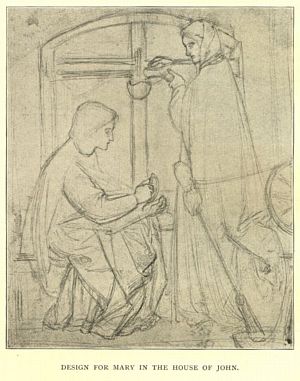
DESIGN FOR MARY IN THE HOUSE OF JOHN.
Figure: Pencil sketch. At left St. John, seated in profile to the right,
works with a spinning wheel. Mary, standing at right facing profile
left, mends a window frame which resembles the Cross.
colouring, if he did not actually paint the picture. A much
larger
copy in oil than any of the
foregoing was commissioned about 1862 or 1863 by Mr. John Heugh, but was
cancelled for some reason afterwards, the only part remaining of it being the
head and shoulders of the Magdalen, which are supposed to have been painted.
The head of the Christ seen through the window of Simon's house has a special
interest attaching to it, and has been more than once a subject of dispute. It
was drawn from the late Sir Edward Burne-Jones, or, according to some, from Mr.
George Meredith,
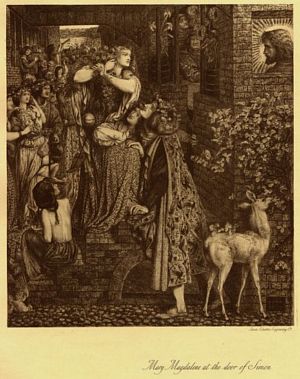
Mary Magdalene at the door of Simon
Swan Electric Engraving Co.
Figure: Pen and India ink. Monogram and date lower right corner: "1858."
Mary at center, removes flowers from her hair, as she stands on the
steps of a brick building staring through its front entrance at Christ,
whose haloed face is visible in a window at far right. Her lover and a
woman clasp her foot and knee to prevent her from entering. At left
stand a crowd of garlanded men and women and at lower right a deer
stands eating from a tree.
whom it undoubtedly also resembles. At a
later date, after 1862, Mr. Meredith was for a time a co-tenant with Rossetti of
his Chelsea house, and it is this relationship which may have suggested the
theory that he sat for the head. But the date of the pen-and-ink drawing, apart
from all other considerations, makes it certain that this could not be; and the
likeness to Burne-Jones, at the time in question, is said to be sufficiently
striking.
An enlarged circular drawing of the
head of Christ
in mixed oil and water-colour was done in 1859, and belonged for some years to
Mr. Moncure D. Conway, who exhibited it at the Burlington Fine Arts Club in
1883. He has since sold it.
Another subject finished in 1858, though in hand as already mentioned a year or
two earlier, was
Mary in the House of John
. The scene is at late twilight, or in an eastern night, the red glow of
the sky casting a purple light over the clustered dwellings of Nazareth, with
deep blue hills beyond. In the interior of the room are Mary and St. John, the
latter seated in shadow, engaged in striking light from a flint; whilst Mary,
standing before the tall window, the framework of which resembles a cross, fills
a hanging lamp from a long red jar of oil. The suggestion for this—as for more
than one other of his pictures of the Virgin—is to be found in Rossetti's poem
of
“Ave”. I quote the special passage:
- “Mind'st thou not (when the twilight gone
- Left darkness in the house of John)
- Between the naked window-bars
- That spacious vigil of the stars?—
- For thou, a watcher even as they,
- Would'st rise from where throughout the day
- Thou wroughtest raiment for His poor;
- And finding the fixed terms endure
- Of day and night which never brought
- Sounds of His coming chariot,
- Would'st lift through cloud-waste unexplored
- Those eyes which said, ‘How long, O Lord?’”
This fine water-colour, full of delicate feeling and glowing colour, was bought
by Lady Trevelyan of Wallington, in whose possession it did not however remain.
The next, or at all events a subsequent, owner was Mr.
R. E. Loft, who exhibited it at Burlington House in 1883.
1 A few years later it was on exhibition at the
Transcribed Footnote (page 99):
1 The title given in the catalogue,Mary in the House of John
on the night of
the Crucifixion
, is wrong, the supposed scene being long after the Crucifixion.
St. John in the picture is probably engaged on his gospel, the net which
occupies him by day being hung up on the wall behind.
Galleries of the Fine Art Society, and
seems since to have been allowed to pass out of the country. A
replica, by no means equal in quality to the
first version, was painted in 1859 for the late Miss Heaton, of Leeds, and still
forms part of her nephew's collection. A certain number of pencil drawings of
the subject are scattered about, the
one
reproduced here being in Mr. Fairfax Murray's
possession. Some of these may date from 1849, when the subject was first
designed as one compartment of a triptych, of which the other side was to have
represented the Virgin planting a lily and a rose, and the centre the Passover
subject illustrated on page 68.
The next drawing to be chronicled is one called
Golden Water
, or
The Princess Parisadé
, a subject taken from “The Arabian Nights.”
This probably belonged once to Mr. Ruskin, and is now in the possession of Mrs.
Constance Churchill. The Princess, a sort of Cinderella, is seen descending from
the mountain, with the singing tree behind her and over her head the talking
bird. In her arms she bears the barrel of golden water.
The only other items to be recorded under 1858 are a water-colour called
Ruth and Boaz
, in which Boaz is represented in the cornfield holding the maiden's hand
and kissing her upon the forehead, and another called
Before the Battle
, painted for Rossetti's American friend, Professor Norton, of Harvard.
In the letter of July, 1858, from which a portion dealing with the Union
paintings has already been quoted, Rossetti wrote as follows:
“The drawing which I have for you is called
Before the Battle
, and represents a castle-full of ladies who have been
embroidering banners which are now being fastened to the spears by the
Lady of the castle. There are a good many figures and half figures,
large and small, in it; and I hope that in colour it is one of the best
things I have done. . . . These chivalric Froissartian themes are quite
a passion of mine, but whether of yours also I do not know.”
Then follow some details about payment, the “Oxford labours of love ” having, as
he explains, left him rather aground. The price asked for it was £50. This was
accepted and presumably paid, and then we hear no more about
Before the Battle
until January, 1862 (!), when Rossetti writes once more to Professor
Norton, giving as his reason for not having sent it that “it did not
prove a favourite with our mutual friend Ruskin, ” and adding that he
himself had begun to think it “rather ultra-mediæval, it having been
produced during a solitary stay in the country of some length, when I was
peculiarly nourishing myself with such impressions. ” He promised,
however, to put some improving and finishing touches on it and to send it off
within a week.
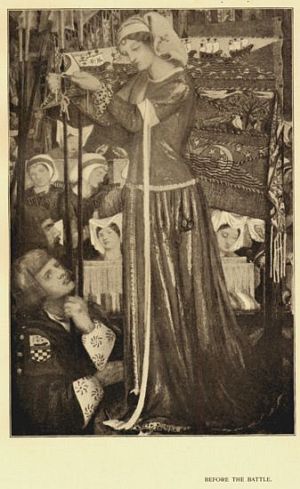
BEFORE THE BATTLE.
Figure: Water colour. A woman standing on a dais is in the act of fastening a
coloured pennant to a halberd held by a young knight; further
pennants are attached to an upright embroidery frame. Warriors
in armour gather up their spears on the left; in the background
women are working at looms and carding wool.Surtees, p. 60.
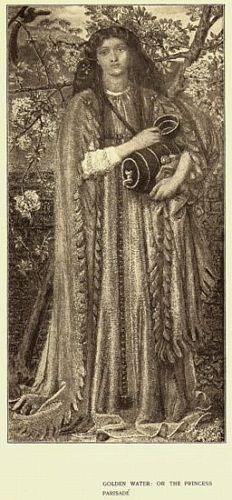
GOLDEN WATER: OR THE PRINCESS PARISADÉ
Figure: Water colour. Full-length of a standing woman facing front, holding
a black barrel with both hands. In the distance stands the green mountain;behind her is the
lilac singing tree with the scarlet talking bird fluttering in
the branches heavy with mauve blossom.Surtees, p. 61.
In 1859 there is not very much to record besides the Dante and Beatrice panels
already mentioned. Rossetti, it must be presumed, was principally at work on the
Llandaff altar-piece, which did not reach completion, and the rest of his output
was scanty. He produced
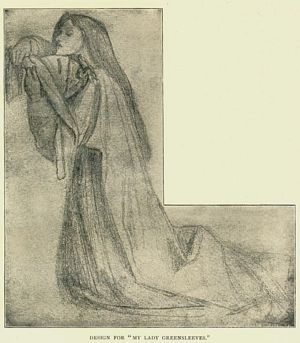
DESIGN FOR “MY LADY GREENSLEEVES.”
Figure: Pencil. A girl, whole-length, kneeling to the left is in the act of
tying a sleeve round a helmet.Surtees, p. 68
the replica already mentioned of
Mary in the House of John
, for Miss Heaton, and apparently began, if he did not finish, one
of
Giotto painting the portrait of Dante
.
1 He also finished the
Sir Galahad
after his 1856 Tennyson design. The only new water-colour of this date
is a little thing, mostly in yellow, of a lady binding a green scarf round a
helmet, called
My Lady Greensleeves
. In one corner it has a few bars of the old tune, with the words:
- “Greensleeves is my Heart of Gold,
- And who but my Lady Greensleeves?”
This drawing was for many years in the possession of the Rev. Edward Hale,
of Eton College, familiarly known to generations of
Transcribed Footnote (page 101):
1 Mr. Murray owns a
water-colour replica in an unfinished state. The Giotto in
this is quite different, and appears to have been done from Mr. Val
Prinsep.
Eton boys as “Badger ” Hale, and at his
death it passed into the possession of another Eton master, the Rev. S. A.
Donaldson, who has kindly allowed me to reproduce it. I have heard that Rossetti
was much annoyed at some criticisms passed upon the drawing by one of the
reviews, and that he set to and daubed the background all over, spoiling some
very fine work. Mr. Murray has lent me, for comparison with the finished
picture, an earlier
pencil version with the
subject differently arranged.
The last and most important item of this year, completed about November, is a
highly-finished little head in oils, called
Bocca Baciata
, which came into the possession of Mr. Boyce. The model for this—or
rather the sitter, for it is simply a portrait framed in marigolds—was Miss
Fanny Cornforth, afterwards Mrs. Schott, who has already been mentioned as the
model for
Found
, and whose florid type of beauty reappears in a series of sensuous
pictures of the kind that Rossetti began to paint after 1862—
Aurelia (Fazio's Mistress)
,
The Blue Bower
,
The Lady at her Toilet
,
Lilith
, and
The Lady of the Fan
. These pictures, and numerous portraits in oil and water-colour, of
which there is a typical one dated 1862 in the possession of Mr. Rae, give a
sufficiently recognizable idea of this model, who exercised almost as remarkable
an influence over Rossetti's life as over his art. “She was pre-eminently
a fine woman,” says Mr. William Rossetti, who was in a position to judge,
“with regular and sweet features, and a mass of the most lovely blonde
hair—light-golden or harvest yellow. ” Her régime, however, came at
a later period than the one we are discussing, and does not concern us here. The
title of
Bocca Baciata
is taken from some lines in a sonnet by Boccaccio: “Bocca baciata non perde ventura, anzi rinuova come
fa la Luna ”—the mouth that has been kissed loses not its freshness; still it
renews itself even as does the moon. The portrait is full-face, perhaps a little
faded in colour, with lips of a purplish crimson, and bright reddish-gold hair.
The flesh under-tints are very green, but the modelling is like a miniature, as
fine and delicate as anything by a Dutch or Flemish master. It was exhibited at
the old Hogarth Club, and later at Burlington House in 1883. At the sale of Mr.
Boyce's pictures this much esteemed work was acquired by Mr. Fairfax Murray.
Rossetti painted several heads later after much the same pattern as
Bocca Baciata
, of which two, a
Regina Cordium
done for the late Mr. Trist, of Brighton, and a water-colour of 1868
called
Bionda del Balcone
, may be regarded as inferior replicas.
Bonifazio's Mistress
, another of the charming little water-colours
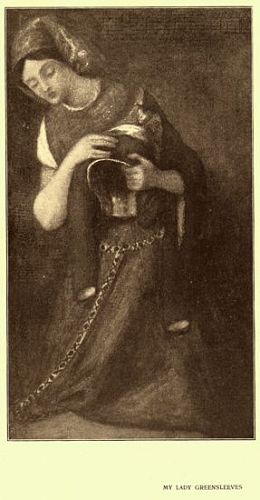
MY LADY GREENSLEEVES
Figure: Water colour. Monogram lower left. Full length of a woman kneeling,
leaning to the left, winding a sleeve around a helmet.
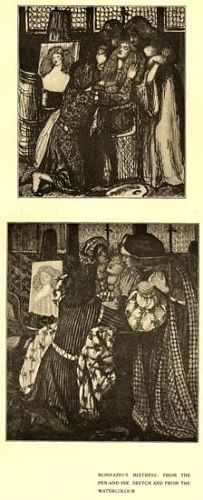
Figure: Pen and brown ink. At center, a fainting woman is supported by a
kneeling man at left and two women standing at right. At left, a chair
sits beside the portrait of the fainting woman.

BONIFAZIO'S MISTRESS: FROM THE PEN-AND-INK SKETCH AND FROM THE
WATERCOLOUR
Figure: Water colour. At center, a fainting woman is supported by a
kneeling man at left and two women standing at right. At left, a chair
sits beside the portrait of the fainting woman.
acquired by the late Mr. Boyce, was painted
in 1860, and is dated on the back. It shows a lady (dressed in the same brightly
be-ribanded flounces as Lucretia Borgia wears in the little 1851 group) who has
been sitting to her lover, a painter, when suddenly she has fallen back in her
chair, dead. The painter has dropped his palette and kneels in front of her,
trying to restore her. Two attendant ladies with anxious looks are holding her
hands and examining her face. The composition of the group and the colouring are
alike charming, and it enjoys a distinction of being rather more widely known to
students of Rossetti's work than many of these small water-colours, from the
fact that its late owner allowed it to be reproduced for “The Hobby Horse” in 1889.
The connection of this subject with the painter, Bonifazio (or Fazio) degli
Uberti, even if intended, is entirely fanciful. There can be little doubt—in
fact a letter from Rossetti to Mr. Boyce, quoted in the “Hobby Horse,” says as much—that it was intended to illustrate Rossetti's own story
of
“St. Agnes of Intercession”. When this story was to appear in “
The Germ,” Rossetti began to do an
etching for it,
which turned out a failure. Millais then, in a hurry, did another to replace it,
which was never used, because “
The Germ” came to an end and the story was not published. A couple of proofs from
Millais's plate (one of which I have seen) remain to show the incident
illustrated, which is taken from the end of the tale, where the lady to whom the
hero is affianced suddenly falls back and dies as he is painting her, thereby
fulfilling a sort of destiny enjoined by the like tragedy which had happened in
a previous state of existence. In addition to the
water-colour, Mr. Murray has allowed me to
reproduce an earlier
pen-and-ink
sketch
, which has not been published before.
Bonifazio's Mistress
has no connection whatever either in subject or composition with the oil
painting done for Mr. Blackmore in 1863 (now Mr. Rae's), and afterwards
re-named
Aurelia
. The latter is simply a three-quarter length figure of a lady plaiting
her hair before a toilet glass.
This (1860) was the year of Rossetti's marriage, as has already been stated, and
in June he was at Paris on his honeymoon. While there he executed two
pen-and-ink drawings, one of which, the design of
How they met Themselves
, done for Mr. Boyce to replace the earlier version of 1851 which had
been lost, has already been mentioned on
page 39.
The other represents a scene from Boswell's“Life of
Johnson,” a rather curious source of inspiration for Rossetti, rendered
more remarkable from the fact that the
incident chosen is of a humorous and spicy character. Dr. Maxwell told the story
how two young women from Staffordshire had come up to town to consult Johnson
about Methodism, in which they were much interested. “Come, ” said he,
“you pretty fools, dine with Maxwell and me at the Mitre, and we will talk
over that subject; ” which they did, and after dinner he took one of
them on his knee, and fondled her for half-an-hour together.
Dr. Johnson and the would-be Methodists at the Mitre
is an almost unique piece of genre work on the part of Rossetti, who has
entered with zest into the humour and surroundings of the scene. His Johnson is
quite a study in portraiture, but instead of Maxwell he has introduced the more
recognizable features of Boswell.
Almost immediately after Rossetti's marriage a severe blow fell upon him through
the death of Mr. Plint, one of his handsomest patrons at that time. Apart from
the indirect loss which this involved, there was the fact that Mr. Plint had
advanced him several hundred pounds on account of work commissioned—much of
which, as would have been the case at any period of Rossetti's life, was not
even put in hand. Amongst the pictures which Rossetti with great struggles
produced in order to repay this advance was a water-colour copy of the
Dr. Johnson
drawing, which at the sale of Mr. Plint's effects in 1865 fetched
seventy-six guineas. It was exhibited at Burlington House in 1883 by Mr. J.
Stewart Hodgson (together with the
pen-and-ink
version
, lent by Mr. Boyce), and is now the property of Mr. Fairfax
Murray, who has allowed it to be
reproduced here.
The other pictures belonging to, or done for the Plint estate, which were sold
at the same time as the
Dr. Johnson
, were
Burd Alane
(oil) and the
Garden Bower
(water-colour), both acquired by Mr. Leathart;
The Wedding of St. George
(water-colour), bought by Mr. Rae; and
Carlisle Wall
(water-colour—called at that time simply
The Lovers
), bought by Mr. H. V. Tebbs. The
Hamlet
and
Launcelot
drawings did not figure in the list, and an oil portrait of the
painter's wife, entitled
Regina Cordium
(being a replica of the last one painted of her), was removed from the
sale in consequence of her recent death, to spare Rossetti's feelings. Mr.
William Rossetti notes with regard to this sale that a dead set was made against
the Pre-Raphaelite pictures, and that his brother for the rest of his life
mistrusted and avoided auction rooms, just as from a similar single instance at
an earlier date he had chosen to avoid exhibitions for his pictures.

DR JOHNSON AT THE MITRE
Figure: Water colour. At a tavern, Johnson and Boswell sit at a table
between two ladies with bonnets. Johnson takes tea with the woman on the
left, gesturing with his right hand, while at right Boswell drinks from
a spoon and the second lady leans towards Johnson. A man lights the
lantern directly above the table.
To return to the output of 1860, Rossetti in this year was attracted once more
towards the annals of the Borgia family, a group of which he had painted in
1851. His subject now was the single upright figure of Lucretia Borgia, washing
her hands at a basin after preparing a poison draught for her unhappy husband,
Duke Alphonso
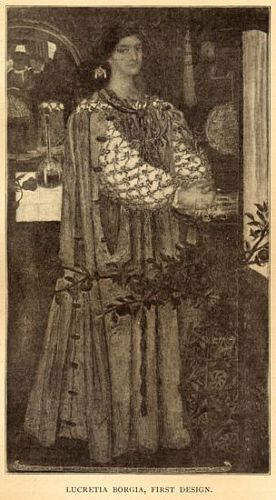
LUCRETIA BORGIA, FIRST DESIGN.
Figure: Water colour. Full length of a woman wearing a dress with sleeves,
facing front, washing her hands her hands in a basin at right. At left,
a mirror reflects the image of two men, and a flask containing a liquid
sits on a counter. A large potted plant sits beside the basin. A scroll
with text appears along the bottom edge of the painting. The text is
unclear, and Surtees does not record it. This first design no longer
exists because DGR painted S124 over it either when it was in his
posession during 1873-1874 or immediately after Rae purchased it in June
1874.
of Bisceglia. In a circular mirror at the back the latter can be seen
hobbling on crutches, and being walked about the room by Pope Alexander IV., as
Rossetti said, “to settle the poison well into his system.” The
drawing had a curious history. In its
original state
Lucretia was stiffly drawn in a straight gown with puffed sleeves. In this
condition it was acquired by Mr. Leyland; but some time
afterwards it was got back by Rossetti, who
repainted the lady entirely, representing her with sinuous and ample curves, and
turning her whole head towards the spot where her husband is supposed to be
walking. The
altered drawing, formerly Mr.
Leyland's, is the one now belonging to Mr. Rae, which bears evidence of patching
in the way described. But Rossetti painted two or three replicas of it, all
larger than Mr. Rae's version, of which
one,
dated 1871, is in the possession of Mr. J. Beausire (who had it from Mr.
Coltart),
another (undated) is in the
possession of Mr. Fairfax Murray. From a photograph taken of the
original design, of which one or two copies exist,
it is possible to show what the picture was like before, as well as after
alteration. It had a long legend at the bottom, which ran, so far as I can
decipher it: “Dom. Lucretiam de stirpe Borgia Alphonsi Ducis
Biscelliae uxorem aetate xxiv sua anno MD Dantes Gabrieles Rossetti
pinx.”
Amongst other less known compositions Rossetti is one belonging to this year, of
Joseph accused by Potiphar's wife
, a finished pen-and-ink drawing which used to belong to Mr. Anderson
Rose, and which a note on the back states was acquired by him at Rossetti's
studio on a certain date, “at 3 o'clock in the morning.” The
Egyptian “local colour ” in this design is strongly marked, and it is altogether
a pleasant little work. It has not been mentioned in any previous list or
record, though it appeared at the Burlington Club in 1883, and figures in the
catalogue of Mr. Anderson Rose's sale. It now belongs to Mr. Fairfax Murray.
In 1861 Rossetti's translations from the Italian poets were at last published,
together with the “Vita Nuova,” in a volume called “The Early Italian Poets from
Ciullo d'Alcamo to Dante Alighieri (1100-1200-1300).” Ruskin
generously assisted the production by advancing £100 to the publishers, Smith,
Elder and Co., and the sale of the first edition just sufficed to pay this back,
with £10 or so over for Rossetti. A second edition, now hardly less scarce than
the first, was called for in 1874, and amongst other changes bore the altered
title, “Dante and his Circle.” Rossetti thought out a
very beautiful and charming design of two lovers kissing in a rose garden, which
he proposed to etch on copper for the title-page. The plate, however, displeased
him as usual, and he destroyed it, only two proofs
[proof 1]
[proof 2] remaining (both now in the
possession of Mr. Murray). Various pen-and-ink drawings of the subject
nevertheless exist, one of which, from a copy also belonging to Mr. Murray (or
rather from a
woodcut of it), is
reproduced here. The central idea of this design
reappears in
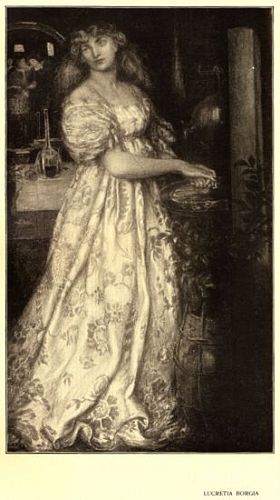
LUCRETIA BORGIA
Figure: Water colour. Full length of a woman wearing a sleeveless dress,
facing front, washing her hands her hands in a basin at right. Her head
leans slightly to the left, where a mirror reflects the image of two
men, and a flask containing a liquid sits on a counter. A large potted
plant sits beside the basin.
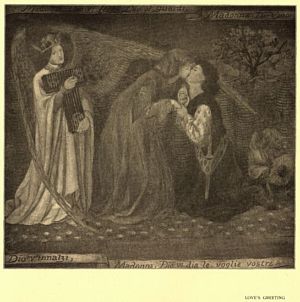
LOVE'S GREETING
Figure: Oil. A crowned angel stands at left playing a stringed instrument,
her left wing extended behind two lovers kissing. The lovers are a woman
bending over a kneeling man. Flowers grow at right and petals are strewn
on the ground. A scroll at top reads: "Madonna, Dio vi fece, Dio vi
guardi, Madonna Dio v'onori"; a scroll at the bottom reads: "Dio
v'innalzi, Madonna, Dio vi dia le voglie vostre."
various forms about the period we are
dealing with. It will be found, for instance, in
Love's Greeting
, a little panel containing, in addition to the lovers, a crowned figure
of Amor bearing a harp in his hand; and in a water-colour of 1864
inscribed
Roman de
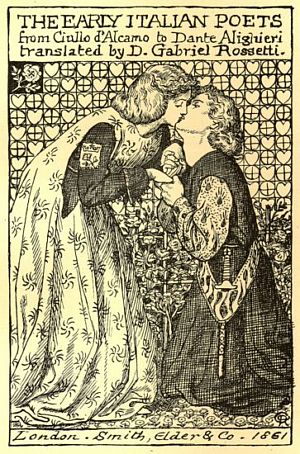
Figure: Etching. Two lovers kissing in a flower garden, a woman
who bends over a kneeling man. The background of the upper
half of the picture is a design of alternating hearts and
cross-hatched circles. Handwritten text appears at top: "THE
EARLY ITALIAN POETS / from Ciullo d'Alcamo to Dante
Alighieri / translated by D. Gabriel Rossetti." and at
bottom: "London. Smith, Elder & Co. 1861."
la Rose
, in which again Love appears overshadowing the kissing pair with his
wings.
The portrait in oils of Mrs. Rossetti, called
Regina Cordium
or
The Queen of Hearts
, has already been mentioned. It was first done on a little panel, 10 by
8 inches, in 1861, and shows no more than the head and bare shoulders, on a gold
ground, behind a parapet on which rests one hand holding a purple pansy. The
title is inscribed
on the parapet, and is faintly re-echoed by
a little heart-shaped pendant on a coral necklace. This portrait was acquired by
Ruskin, who after a time disliked “the mahogany coloured hair and coral
beads,” and gave it away to his friend Mr. Severn, who has it now.
This is the version which is reproduced here. Rossetti, contrary to what might
have been expected in such a case, painted more than one replica of the
portrait, of which I presume the
Plint picture
mentioned a page or two back to have been one.
Another belongs to Mrs. Philip Rathbone, of Liverpool.A water-colour copy, which appeared at the New Gallery in
1897-8, but did not remain there long, is almost certainly not genuine.
1 In addition to these versions of his wife, Rossetti painted other
heads from different sitters and called them
Regina Cordium. The first, dated November, 1861, was an
oil
portrait of Mrs. Aldam Heaton
, the wife of a friend with whom
Rossetti afterwards quarrelled. Another, painted in 1866, was done from
Miss Alice Wilding, a model who sat for many of
Rossetti's prettiest faces (
Veronica Veronese
,
Sea Spell
,
La Ghirlandata
,
The Blessed Damozel
,
The Roman Widow
,
Monna Vanna
, and
Sibylla Palmifera
). This belonged to Mr. Trist, of Brighton, and was sold in 1892.
Somewhat akin to these, or perhaps rather to the
Bocca Baciata
type, is a life-sized oil portrait of “a fair, red-haired young
woman, with bare shoulders, a rose in her hair, and round her throat coral
and amber necklaces,” called
Fair Rosamund
, which belonged to the late Mr. Pyke Thompson, and is now amongst the
collection of pictures deposited by him at the Turner House, Penarth. This, and
a study for
Found
, called
The Farmer's Daughter
, already mentioned, were sent by Rossetti as a sort of experiment to an
exhibition of the Royal Scottish Academy in Edinburgh, where they attracted no
particular attention and were not sold.
A more important outcome of the year is the very fine and masterly composition
known as
Cassandra
, in Colonel Gillum's possession. The subject is a scene on the walls of
Troy, and is described in a letter of Rossetti to the owner as follows:
“The incident is just before Hector's last battle. Cassandra has warned
him in vain by her prophecies, and is now throwing herself against a
pillar, and rending her clothes in despair, because he will not be
detained longer. He is rushing down the steps and trying to make himself
heard across her noise, as he shouts an order to the officer in charge
of the soldiers who are going round the ramparts on their way to battle.
One of
Transcribed Footnote (page 108):
1 There
should be
somewhere in existence a
water-colour
portrait of Rossetti's wife
, with a gold background,
I know not of what date, which used to belong to C. A. Howell,
and was disposed of by him about 1874, together with other
genuine drawings which have not since turned up.
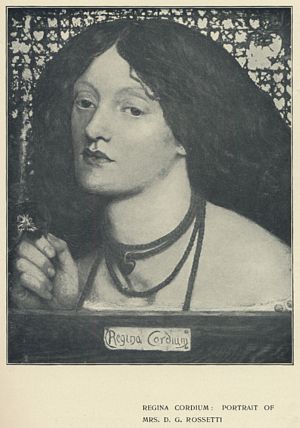
REGINA CORDIUM: PORTRAIT OF MRS. D. G. ROSSETTI
Figure: Oil. Title inscribed lower center. Head and shoulders of a
woman, head turned slightly to left, right hand clutching a
flower. She wears a necklace witha heart-shaped
pendant.
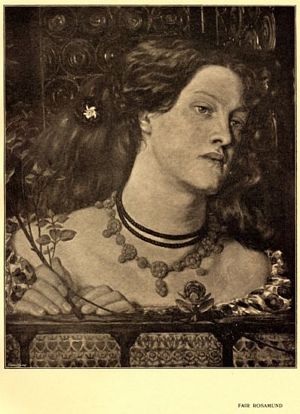
FAIR ROSAMUND
Swantype
Figure: Oil. Head and shoulders of a woman, head turned slightly to
right, leaning against a railing, holding a stick and a silk
cord in her right hand. She wears two necklaces and a flower is
in her hair.
his captains is beckoning to him to
make haste. Behind him is Andromache with their child, and a nurse who
is holding the cradle. Helen is arming Paris in a leisurely way on a
sofa; we may presume from her expression that Cassandra has not spared
her in her denunciations. Paris is patting her on the back to soothe
her, much amused. Priam and Hecuba are behind, the latter stopping her
ears in horror. One brother is imploring Cassandra to desist from her
fear-inspiring cries. The ramparts are lined with engines for casting
stones on the besiegers.”
The pen-and-ink drawing
reproduced here was worked
upon and improved (as well as re-dated) in 1867; but even as it stands it is a
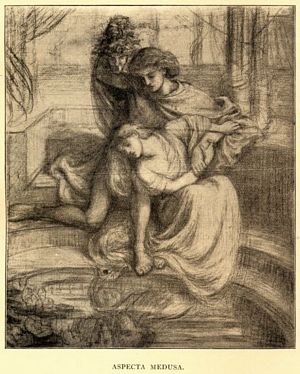
ASPECTA MEDUSA.
Figure: Pen and ink. Andromeda, leaning against Perseus, looks down into a
pool at the reflection of the head of Medusa, which Perseus holds over
the water with his right hand. Both her arms clutch his left arm.
wonderful example of Rossetti's skill in invention and resourcefulness
in composition. Rossetti wrote two sonnets for the drawing of
Cassandra
, which will be found in his volume of
Poems. The first describes the futile warning of the prophetess, the mocking
of Paris, the grief of Andromache, and then the departure of Hector:
- “He goes. Cassandra's words beat heavily
- Like crows above his crest, and at his ear
- Ring hollow in the shield that shall not save.”
The second foreshadows the death of Hector
in the plain and the ruin of the fore-doomed city.
The pity is great that Rossetti never had an opportunity to paint the picture for
which this was merely a preliminary design. Mr. Leyland and Mr. Rae both had the
offer of it, but at a very high figure (£2,100, I believe), and it was never
commenced. Rossetti, at the date when these offers were made, had begun to paint
the deeply imaginative or sumptuous single figures which proved so acceptable to
his later patrons, and he could not thenceforward find time or encouragement or
money to carry out elaborate subjects. The one exception, almost, to this rule
is the great picture of
Dante's Dream
, the disposal of which (on account of its size) gave the painter an
infinite amount of anxiety and trouble.
One must go back to the earlier fifties to find a period in Rossetti's life so
prolific in invention and ideas as were these two brief married years of 1860
and 1861. The completion and delivery of his
Llandaff
altar-piece
, although one panel was not actually sent out until 1864,
doubtless left him freer to try new designs.In addition
to
Cassandra
he planned the composition for a
large
picture
, subsequently commissioned but never finished, of Perseus
showing the Medusa's head to Andromeda (
Aspecta Medusa
1), and made the first rough pencil studies for
Beata Beatrix
, the most harmonious, as well as the most widely popular, of all his
works. Other little pencil drawings of figures, bearing such titles
as
Lachesis
and
The Laurel
, may have belonged to the same or to a somewhat later period. The
water-colour of
Bethlehem Gate
, belonging to Mr. Heaton, which represents the Holy Family being led
away at night by a pair of angels, one of whom closes behind them the door
through which the massacre is seen, also belongs to 1862, though whether earlier
or later than the gap caused by Mrs. Rossetti's death I am not certain.
Transcribed Footnote (page 110):
1 For the design of
Aspecta Medusa
Rossetti composed in 1865 the following lines, which were
published in his
Poems of 1870:
- “Andromeda, by Perseus saved and wed,
- Hankered each day to see the Gorgon's head:
- Till o'er the fount he held it, bade her lean,
- And mirrored in the wave was safely seen
- The death she lived by.
- Let not thine eyes know
- Any forbidden thing itself, although
- It once should save as well as kill: but be
- Its shadow upon life enough for thee.”
Sir Edward Burne-Jones did not begin to paint his pictures of
the “
Perseus” series until 1877.
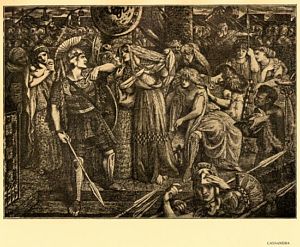
CASSANDRA
Figure: Pen and ink. The incident is just before Hector's last battle. Cassandra
has warned him in vain by her prophecies, and is now throwing
herself against a pillar, and rending her clothes in despair,
because he will not be detained longer. He is rushing down the
steps and trying to make himself heard across her noise, as he
shouts an order to the officer in charge of the soldiers who are
going round the ramparts on their way to battle. One of his
captains is beckoning to him to make haste. Behind him is
Andromache with their child, and a nurse who is holding the
cradle. Helen is arming Paris in a leisurely way on a sofa; we
may presume from her expression that Cassandra has not spared
her in her denunciations. Paris is patting her on the back to
soothe her, much amused. Priam and Hecuba are behind, the latter
stopping her ears in horror. One brother is imploring Cassandra
to desist from her fear-inspiring cries. The ramparts are lined
with engines for casting stones on the besiegers.Surtees, p. 80
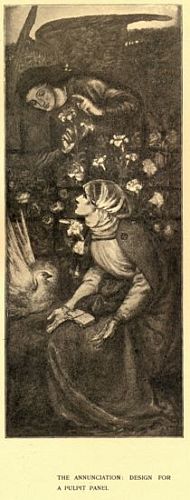
THE ANNUNCIATION: DESIGN FOR A PULPIT PANEL
Figure: Water colour. Monogram lower left corner. An angel at top leans
over a fence to speak to Mary, who sits bottom looking up at him. The
angel clutches a flower from the garden beside the fence with his right
hand, gesturing with his left. A haloed dove sits beside Mary, whose
arms are extended towards the ground.
It seems to have been invented some ten or
eleven years previously, to judge from the date ascribed to a
pen-and-ink study in the catalogue of Rossetti's
effects. These dates, however, are very untrustworthy.
About this time (1861-1862) the firm of Morris, Marshall, Faulkner and Co. was
just being started, with William Morris, Rossetti, Faulkner, Burne-Jones, Madox
Brown, Webb, and others as the active promoters of a venture which was to reform
the arts of decoration and furniture making. The notion of a trading company, at
that date a most unheard-of and revolutionary one, was due in large measure, Mr.
Mackail says, to Madox Brown, “but perhaps even more to Rossetti, who,
poet and idealist as he was, had business qualities of a high order and the
eye of a trained financier for anything that had money in it.”
Tapestry, furniture, wall-papers, stained glass, painted panels, and later on
carpet weaving and dyeing, were among the industries to which this band of
highly original artists and designers turned their attention, the principle on
which they went being that each member should be paid individually for the work
commissioned by the firm, and that profits should be divided in a proper ratio
at the end.
The Anglo-Catholic movement and the demand for decoration and ritual of an
æsthetic and sensuous kind gave the new firm plenty to do, amongst their first
commissions being the embellishment of two new churches then being built by
Bodley, St. Martin's on the Hill, Scarborough, and St. Michael's at Brighton.
For the former Rossetti executed a
design for two pulpit
panels
and
several windows, achieving
from the very first a mastery over this branch of art which few designers have
ever surpassed. It is characteristic of his original mind that he went right
back to the fundamental principles of
vitraux, paying no attention whatever to the elaborations which had grown
round them, and recognizing that a picture which was transparent, that is, seen
by transmitted light, must be conceived in flat tones and not made to give the
illusion of shading, as can be done in the case of a surface from which the
light is reflected. The following are the designs by Rossetti done for St.
Martin's, and to be seen there now.
The Annunciation
. A design intended to fill two vertical panels. In the upper one the
angel with outspread wings is descending upon the Virgin, who in the lower one
is sitting with upturned face and a book on her knees amongst a bed of lilies. A
high trellised hedge covered with red roses forms a background to the
picture. As will be seen, this version of
the
Annunciation
bears no affinity either to the
Ecce Ancilla
of Rossetti's earliest days or to the
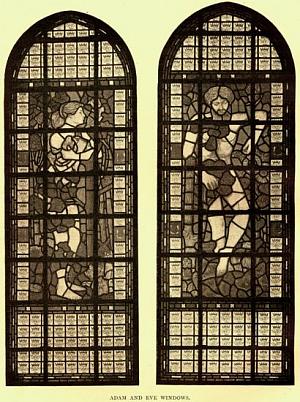
ADAM AND EVE WINDOWS.
Figure: Two stained glass windows. The first depicts Eve standing in
profile to the right, the second Adam standing facing front, head
looking down. Both figures are partly covered with leaves.
water-colour of 1855 in the possession of Mrs.
Boyce. Mr. Sharp says expressly that the painting was done by Rossetti, but he
does not mention the grounds on which the statement is made, and I expect he
would find the information to be inaccurate. At any rate,
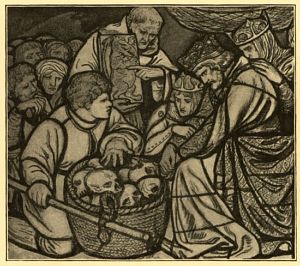
Figure: Indian ink. A boy kneels over a basket of skulls, gesturing towards
it with his left hand. He faces right, where a seated king, queen, and
prince stare at the skulls. An old man stands directly behind the
skulls, holding a picture of a dragon. At far left a crowd tries to peer
over the boy's shoulders.
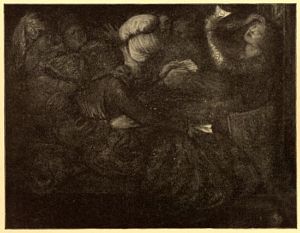
Figure: Water colour over Indian ink. A group of seated female figures with
dismayed expressions, each clutching a piece of paper. At far right, a
woman holds the piece of paper before her eyes with her right hand and
clutches her head with the left.
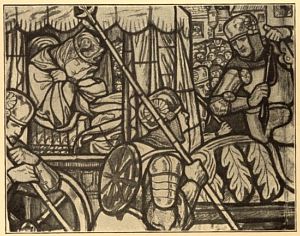
ST. GEORGE AND THE DRAGON DESIGNS FOR WINDOWS (1)
Figure: Indian ink. Depicts a crowned woman, who leans against her hands,
in a horse-drawn carriage. Two knights march with spears beside the
carriage, one of whom speaks speaks to a third knight on horseback, who
draws the carriage. A crowd can be glimpsed in the background.
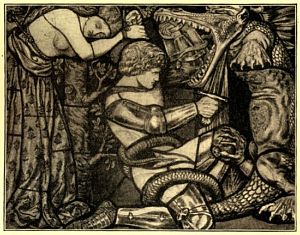
Figure: Indian ink. At center, St. George, wearing armor, stabs the neck of
the dragon, at right, with his right hand and holds his shield in front
of the dragon's mouth with his left. At left stands the princess,
slumped over, tied to a tree.
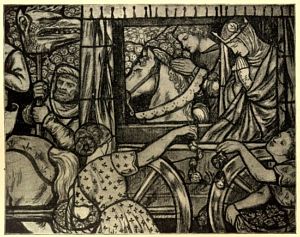
Figure: Indian ink. Inside a horse-drawn carriage, the princess folds her
hands in prayer. Beside the carriage rides St. George, whose hands are
also folded. A bearded man walks beside the carriage carrying the
dragon's head atop a staff. Two girls scatter flowers in the foreground,
and a crowd of faces stares in the background.
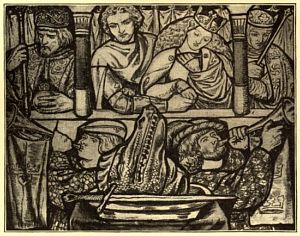
ST. GEORGE AND THE DRAGON DESIGNS FOR WINDOWS (2)
Figure: Indian ink. St. George and the princess stand hand in hand leaning
over a railing, flanked by the king on the left and queen on the right.
In the foreground, two buglers blow their horns, and the head of the
dragon and a sword lie in a basin on a table.
the
water-colour design for the
panels
, which is all that Rossetti might be expected to execute,
exists and is in the possession of Mr. Dunlop, of Bingley, having previously
belonged to Mr. John Miller. This
Annunciation
drawing is the one referred to in Mr. Rossetti's book as being a
separate version of the subject, under the date 1864. It should be dated 1861 or
1862 at latest.
Adam and Eve before the Fall
. Two windows for the west end, representing in one compartment Adam
leaning upon a branch of a leafy tree and with his foot tickling a small brown
bear that curls itself upon the ground. A squirrel watches him from above. In
the other Eve is seen standing in a richly flowered field, her long fair hair
falling unbound about her shoulders. She presses a white dove to her bosom, and
in the tree above her a solemn owl is perched. Both figures are nude, with a
rosy glow of flesh-colour, broken up by the graceful veiling of thick green
foliage.
The Parable of the Vineyard
. Seven designs for a window in the choir, of which M. Olivier Georges
Destrée, one of the most appreciative critics of Rossetti, writes that it
produces “an impression of colour, dazzling and magnificent, velvety and
harmonious, resembling the Flemish stained glass windows decorating the
Gothic cathedrals.” The central compartment of the window
represents
The Crucifixion
, and round it are grouped the different incidents of the parable,
the planting of the vine,
the
letting it out to husbandmen
,
the stoning of
the servants
,
the feast of the
vintage
,
the arrival of the young heir
against whom the husbandmen are plotting, and, lastly, their
judgment and condemnation by the master. The designs
for the
Parable of the Vineyard
were at one time in the possession of Mr. Leyland, it is believed, and
later came into the hands of Mr. McConnel, whose effects were sold at Manchester
about 1870. I have not ascertained who has them now.
To the same category of work designed for Morris and Co., and executed by them
during 1861 or 1862, may be added the following:
The Last Judgment
. Nine designs in a circle for stained glass, of which the originals,
formerly in Rossetti's possession, were bought after his death by a Mr.
Brough.
St. George and the Dragon
. A very famous set of six designs for stained glass, reproduced here.
The original cartoons, of which the second, representing
the Princess drawing the fatal lot, has been painted over in
water-colour, belong to Mr. Fairfax Murray. A duplicate set, presumably
consisting of shop tracings, is in the
possession of Mr. Theodore Watts-Dunton,
who acquired them from Rossetti.
King René's Honeymoon
. This was a design for a panel, one of four representing the arts, done
for the famous Gothic cabinet which Mr. J. P. Seddon had built by Morris and Co.
to hold his architectural drawings. The history of this cabinet has recently
been written by Mr. Seddon himself, and is published by Batsford, with separate
illustrations of the various panels designed by Rossetti, Madox Brown,
Burne-Jones, and others. Rossetti's subject was “Music,” in which
the amiable and enlightened King of Sicily is seen leaning over a species of
chamber-organ, on which his bride is playing, to kiss her. Rossetti also
designed one of the minor panels, representing “Gardening.” The
water-colour sketch for this, whether done at the time in colours or painted
over the design afterwards, got the title of
Spring
, and as such is catalogued among Rossetti's works, mostly under the year
1864. A
pen-and-ink drawing of the subject —a
girl cutting blossoms from a tree—formerly belonged to Mr. H. V. Tebbs, but was
sold by him to Mr. Murray. The whole question of dates, regarding this cabinet,
has been somewhat mysterious. Mr. Sharp in his list gives “
King René's Honeymoon
: oil: 1850,” which is of course impossible. The painting in
oil was not done by Rossetti, and the Morris firm was not thought of in 1850.
Mr. J. P. Anderson, in Mr. Knight's little book, gives the date as 1856-7, which
is not much better; and even Mr. W. M. Rossetti has not corrected the mistake.
Somewhere or other the water-colour design for
King René's Honeymoon
should exist, unless it has perished. A
replica of it was painted in oil a year or two later for Mr. Trist,
of Brighton, amongst whose pictures it figured in the sale of 1892.
Amor, Amans, Amata
. These are three small figures in ovals, designed for the back of a sofa
which Rossetti had made for himself, and which for many years stood in his house
at Chelsea. The sofa, which has also six little circular heads in brown on gold
along the front, belongs now to Mr. Murray.
Sir Tristram and La Belle Yseult drinking the Love
Potion
. This was a very beautiful design intended to form one of a series in
stained glass for the windows of Mr. Birket Foster's house in Surrey. Other
designs for the same series were done by Burne-Jones. The
original cartoon, in sepia or Indian ink, which was the really fine
thing, is not to be traced; but Rossetti painted a
water-colour replica in 1867 for Mr. McConnel, which afterwards came
into the possession
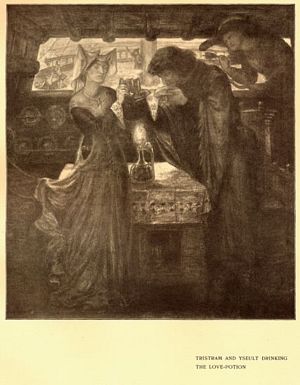
TRISTRAM AND YSEULT DRINKING THE LOVE-POTION
Figure: Water-colour. Yseult, at left, clinks glasses with Tristram at
right, who kisses her other hand. The two stand in a ship's cabin beside
a table with a burning lamp. In background at right, the figure of Love
takes an arrow from his quiver.
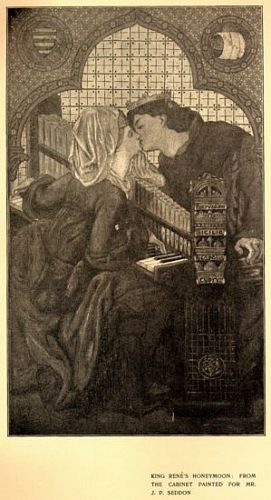
KING RENÉ'S HONEYMOON: FROM THE CABINET PAINTED FOR MR. J. P.
SEDDON
Figure: oil (?). King Rene (here uncrowned) leans forward across a low
chamber-organ on which Queen Isabella is playing, and kisses
her. The organ bears the names of the four Kingdoms of which
René was titular King— Jerusalem, Sicily, Naples, and
Cyprus.Surtees, p. 101
of Mr. Leathart,
1 and this I have
reproduced. It represents an incident in the story from “Morte Darthur,” when Tristram is bringing King Mark's betrothed to Cornwall, and when
they drink the magic potion intended for her husband. The scene is in the cabin
of the ship, with Love floating by on crimson wings and drawing a feathered
arrow from his quiver. As the goblets filled by the lovers touch, the potion
bursts into flame. At the sale of the Leathart pictures in 1896 this
water-colour was acquired by Mr. M. Sears, of Boston. Rossetti offered to paint
the subject in oil for Mr. Rae for 350 guineas.
King René's Honeymoon
. Another subject from the story of the Sicilian king (or perhaps the
same), done for a series of stained glass windows in Mr. Birket Foster's house.
The
drawing in ink, which I have not seen,
belongs to Mr. A. S. Stevenson, and was exhibited at the Burlington Fine Arts
Club in 1883.
The Annunciation
. This is a design for a window, and is different again from any versions
of the subject previously mentioned. The cartoon for it is in the possession of
Mr. Watts-Dunton.
Threshing
. A design for a tile, presumably one of a series, the original sepia
sketch for which was acquired by Colonel Gillum at Rossetti's sale.
The remainder of Rossetti's work in applied art, unless other unrecorded examples
exist, comprise a memorial window in Christ Church, Albany Street, representing
the
Sermon on the Mount
, erected in 1869 to the memory of Rossetti's aunt, Miss Polidori, who
died in 1867; and a bright little water-colour drawing for a window representing
Christ Crowned
, with a regal globe in his hand, and above and below two pairs of winged
angels. This was formerly in the possession of Mr. Trist, and now belongs to Mr.
Murray. It may or may not be the same as a
Christ in Glory
(“sketch for stained glass”), sold to Mr. William Graham
in 1873, but its date of course is much earlier than that. For convenience I
have catalogued it under 1862.
Transcribed Footnote (page 115):
1 There is a letter from Mr. Frederick Shields to
Rossetti referring to the
water-colour in Mr.
McConnel's possession, and saying: “I agree with you in regarding it
as one of your finest”—or words to that effect.
The
Paolo and Francesca
water-colour done for Mr. William Graham I have included under the date
1861, although no particular authority exists for this beyond the auctioneer's
catalogue. In the catalogue of the Burlington Fine Arts Club it was given as
1854, which would ante-date by a year the
original
diptych
painted for Mr. Ruskin and now in the possession of Mr. Rae
(
see page 66). There
is a
possibility, borne out to some extent by internal evidence, that this may have
been an early sketch not used at the time, but taken up later and finished off
to sell. The paper on which it is painted has been added to on all four sides
for the purpose of extending the composition. Traces of this patching are
plainly visible in the reproduction, especially at the bottom and across the
window. In its original form, therefore, the drawing would have included the
pair of lovers and practically nothing else.
This beautiful and luminous little water-colour represents, as I have described
already, the first compartment of the double subject. In the other half of the
complete picture the souls of the lovers are shown floating for ever in a rain
of flames. The story is too well known for repetition how Francesca, daughter of
Guido di Polenta, lord of Ravenna, being married to Lanciotto, the son of
Malatesta di Rimini, fell in love with her husband's brother Paolo, and how
Lanciotto, detecting the intrigue, put the guilty pair to death. In the picture,
Paolo in red and Francesca in green are seated before a window bearing the
gryphon arms of Malatesta. A branch of red roses lies on the floor at their feet
and a rose-bush is growing from a barrel on their right. A red lute hangs upon
the wall to their left. Outside is a bright and sunny landscape. The lovers have
stopped in the midst of their reading to give the fatal kiss that sealed their
doom, but the approaching form of Lanciotto is not seen. On the frame is
inscribed the following passage
translated from the fifth Canto of the
Inferno:
- “One day
- For our delight we read of Launcelot,
- How him love thralled. Alone we were, and no
- Suspicion near us. Oft times by that reading
- Our eyes were drawn together, and the hue
- Fled from our altered cheek. But at one point
- Alone we fell. When of that smile we read,
- The wicked smile so rapturously kiss'd
- By one so deep in love, then he, who ne'er
- From me shall separate, at once my lips
- All trembling kiss'd.”
The present owner of the water-colour is Mr. W. R. Moss, of
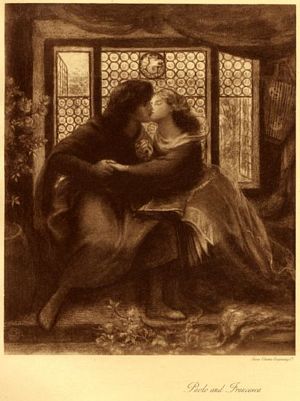
Paolo and Francesca
Swan Electric Engraving Co.
Figure: Water color. Monogram lower left corner. Two seated lovers kissing. The book they have been reading drops from the man's knees as
they kiss; beneath his feet the single red rose has blossomed
into a flowering branch. 0n the left in a large barrel stands a
rose bush; a scarlet psaltery hangs on the right wall; the
window of bottle-glass lights, bearing the arms of the Malatesta
family, is partly open revealing a landscape bathed in
sunshine.Surtees, p. 39
Bolton, Lancashire, by whose courtesy it
has been engraved. It was exhibited at the Burlington Club in 1883, at the
Manchester Jubilee Exhibition in 1887, at the Guildhall in 1896, and at the New
Gallery in the winter of 1897-98.
A drawing of this period which has not been mentioned is one of
the Crucifixion scene, with Mary weeping at the foot
of the cross, and one of the disciples waving away a gathering flock of ravens.
This was formerly in the possession of Mr. Alphonse Legros, and now belongs to
Mr. Charles Ricketts.
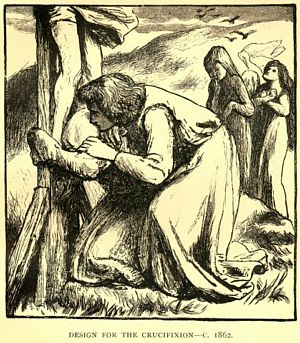
DESIGN FOR THE CRUCIFIXION—C. 1862.
Figure: Pen and ink and Indian ink, and sepia wash. The Virgin kneels at the foot of the Cross and is comforted
by St. John; two women are approaching while a third is seen in
the distance, driving off a flock of ravens.Surtees, p. 57
In 1861 or 1862 Rossetti designed two woodcuts for his sister Christina's “Goblin Market,” published by Messrs. Macmillan. These
illustrated respectively the lines “Buy from us with a golden
curl” (
frontispiece) and
“Golden head by golden head,” the two girls lying asleep
folded in each other's arms (
title-page). In 1865
he drew two more designs for “The Prince's Progress,”
illustrating the lines “You should have wept her yesterday” —the
story of the Prince setting out to seek his bride, who dallies so long on the
way that when he arrives he finds her dead—and “
The long hours go and
come and go
”. Numerous studies in pen-and-ink were made for these illustrations,
especially for the last, which remains perhaps the most beautiful and successful
of the four. Mr. Fairfax Murray has a number of these drawings, and may, for
what I know, have all. The covers for these two little volumes of his sister's
poems,
[Cover-Goblin Market (1862)]
[Cover-Goblin Market (1865)]
[Cover-The Prince's Progress] as well as for his
own when they appeared,
[Cover-The Early Italian
Poets (1861)]
[Cover-Poems by Dante Gabriel Rossetti (1870)
1]
[Cover-Poems by Dante Gabriel Rossetti (1870)
2]
were designed by Rossetti, and are as original and effective and
tasteful as his decorative work invariably was.
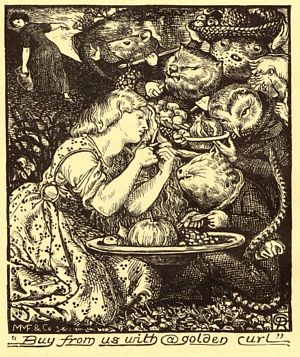
Figure: Woodcut. Monogram lower right corner; lower left corner reads: "MMF
& Co". Inscription at bottom reads: "Buy from us with a golden
curl." A woman kneels at left cutting off a lock of her long
light-colored hair. At right several rodent-faced creatures hold out
bowls of fruits to her. At top left, a woman with short dark hair
holding a pitcher ascends a hill, looking back at the scene.
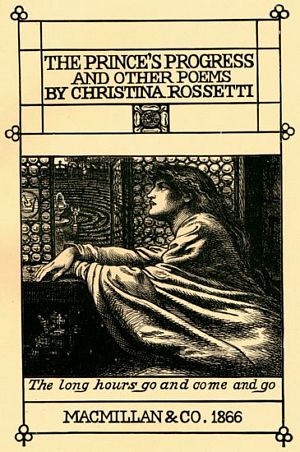
Figure: Woodcut. Inscription at top: "THE PRINCE'S PROGRESS / AND OTHER
POEMS / BY CHRISTINA ROSSETTI" and at bottom: "MACMILLAN & CO.
1866." Inscribed just below the picture is "The long hours go and come
and go." A woman leans toward an bottle-glass window with an open
casement through which a fountain can be seen.
AFTER the tragic death of his wife, on February 11th, 1862,
Rossetti could no longer bear to occupy the rooms they had inhabited at Chatham
Place, and began to seek for others.
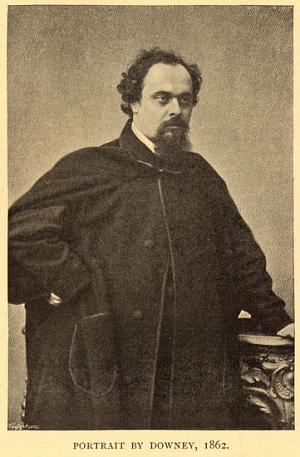
PORTRAIT BY DOWNEY, 1862.
Swantype
Figure: Photogravure reproduction of photograph of DGR by Downey. Nearly
full-length of DGR in overcoat, turned slightly to right. Left hand
rests on ornately carved table, right hand upon hip.
In the meantime he took lodgings for a few months in a house in
Lincoln's Inn Fields. He had a fancy for getting away from the crowd of London,
and yet for being near the river, which caused him to examine one or two old
houses in the then by no means fashionable neighbourhoods of Hammersmith and
Chelsea. He came near taking one in the further suburb which afterwards served
for William Morris's home in London, and from which was founded the Kelmscott
Press, but finally decided in favour of No. 16, Cheyne Walk, a house which from
some traditional association with Queen Elizabeth became known as Tudor House
and is now called Queen's House. It is also said to have been described by
Thackeray in “Esmond” as the home of the old Countess of Chelsey. At first he thought of
inviting his family to live with him, but circumstances rendered this
undesirable, and he started instead a joint
ménage with
Mr. Algernon Swinburne, Mr. George
Meredith, and (at casual intervals) his brother. Mr. Meredith's subtenancy was
not of long duration; in point of fact he never really occupied his rooms. But
Mr. Swinburne remained long enough to have shared very considerably the
traditions which soon grew up round Tudor House, and whilst there wrote the most
famous of his dramas, “Atalanta in Calydon,” as well as many of the “Poems and Ballads,” and a portion of “Chastelard.” The gloom which at first had threatened Rossetti gradually wore away
before the robustness of his nature; settling into and furnishing his house on
new, and at that time practically unheard-of
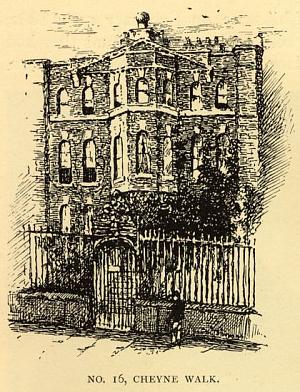
NO. 16, CHEYNE WALK.
Figure: Etching of the exterior of the house facing the walk. A figure
stands beside the closed iron gates.
principles, afforded abundant distraction; and for some years, until
his own illness intervened, Rossetti played the genial and charming host to many
old friends of his intimate group, and to an increasing circle of new ones who
were attracted by sympathy or by the growing glamour of his name. Madox Brown he
saw as much as ever, and whenever he was in trouble or need; Morris less, and in
course of time very little. W. Bell Scott had come up to town from Newcastle,
and became a constant visitor. The Greek community in London, which is as
renowned for the beauty and culture of its women as for the prosperity of its
men, furnished him not only with patrons, but also with congenial friends, and
with one very lovely sitter who appears in some of his later canvases. Besides
these were his constant patrons William Graham, George Rae, and Frederick
Leyland, with whom he was on friendly terms; J. P. Seddon, a faithful member of
his early circle; Philip Bourke Marston, the poet; Michael Halliday, the
painter, and others.
I have alluded just above to the furnishing of Tudor House, but the subject
deserves more than a passing reference. Rossetti, in spite of his entire
indifference to the outside public, had a wonderful way of infecting it with his
own predilections and taste. We have seen the part he took in popularizing the
Arthurian legend
and the various romances of chivalry. In the same way he
championed to very good purpose the almost forgotten cause of Keats. His
discovery of Fitzgerald's
translation of Omar in a bookseller's box started the world-wide
appreciation of those wonderful quatrains. Blake, Coleridge, and other less
celebrated worthies owed to his fine discrimination much of their revival in the
public taste. He had borne a leading share in the Morris decorative movement;
and now he was destined to pave the way for the modern craze for old oak
furniture and blue china.Bric-à-brac was not of
much account in England when Rossetti first began rummaging the
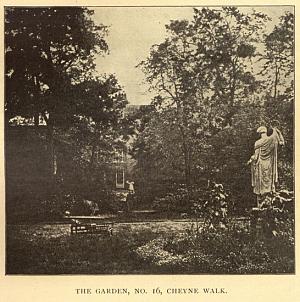
THE GARDEN, NO. 16, CHEYNE WALK.
Figure: A photograph of the garden of Rossetti's house showing a marble
statue from behind at right and the house in the distance.
dealers' shops for old and battered cabinets, Chippendale chairs,
carved oak panels, “hawthorn” jars (the name was his invention), and an infinite
variety of brass implements, chandeliers, sconces, mirrors, and vases of antique
and comparatively neglected types. As regards blue china he found a rival in Mr.
Whistler, whose acquisitions with his own soon began to send the prices flying
up; but it was a purely original idea in those days to buy up old furniture for
use, and to enrich the walls of a house with panelled carvings and treasures
from Japan. Those who follow the fashion to-day do it in many cases vulgarly and
unintelligently, turning their houses into museums of costly and incongruous
objects. So far as decora-
tion went Rossetti knew to a hairbreadth
what would harmonize and what would not, and however wide the range of his
purchases might be he was never guilty of errors of taste. In such matters, it
is generally conceded, his judgment was a touchstone.
One of the main charms of the house at Chelsea was its long garden, more than an
acre in extent, with an avenue of trees on to which the studio looked. As time
went on this garden became tenanted with a miscellaneous assortment of birds and
animals, round which a veritable saga of anecdote has gathered. I purpose in a
miscellaneous chapter at the end to give a short account of these animals, which
formed a prominent feature in Rossetti's life at Cheyne Walk, and which, with
his affection forbric-à-brac, his spontaneous
generosity, his ever-ready wit, his love of good stories, and his endless flow
of
vers d'esprit, form a pleasant contrast to the somewhat sombre atmosphere in which
he sought his inspirations, and in which, owing to the seclusion of his later
years, he was popularly supposed to live. As insomnia, with added physical
troubles, attacked him, he suffered from melancholy, and the remedy recommended
to him proved almost worse than the disease; but at the commencement of his life
in Chelsea Rossetti was a remarkably cheery unaffected human being, free from
vanity, full of good nature; and it cannot be regarded otherwise than as a
misfortune that most of the personal and intimate literature published about him
has come through the channels of men who only knew him late in life, and whose
impressions of him in the days when he had better health and less fame were
consequently vitiated.
For convenience of division I do not propose in this chapter to take Rossetti's
work beyond the year 1868, when his health first showed signs of breaking down,
and when, in order to escape from the oppression of sleeplessness, and to rest
his eyes, which began to give serious trouble, he went on a visit to Penkill
Castle in Ayrshire, the residence of Miss Alice Boyd. Here he was tended and
cared for with unsurpassable kindness, and enjoyed the company of his old friend
William Bell Scott, who was still blind to the manifold vices of character which
he afterwards detected and published. Of incidents during the six years there
were not many that concern my purpose. In 1862 and 1863 a couple of short trips
were made to Belgium and Paris, but without particular results upon Rossetti's
work. Late in 1862 a visit was paid to Bell Scott in Newcastle, the interesting
feature of which is the well-known
portrait by
Downey
which was taken upon that occasion, and which is
reproduced at the begin-
ning of this chapter. During the same two
years Rossetti was engaged in finishing for press the “Life of Blake,” begun by his friend, Alexander Gilchrist, who had died very tragically
in 1861. About 1865 he joined, and even used to frequent, the Garrick Club, a
plunge into public life which he capped by a letter to the “
Athenæum” in this year, protesting against its being stated that he was a
water-colour painter who only occasionally used oils, and asserting that having
first begun as an oil-painter he had “now, for a good many years
past,” reverted to oil for all his principal works. I only know of
one other instance of this obtrusion of his name in public print to correct a
misstatement, and that was when he wrote a dignified letter protesting against
some scurrilous paragraph to the effect that he had given a “not at home”
message when the Princess Louise had called upon him. The article in the “
Athenæum” entitled “
The Stealthy School of Criticism” hardly belongs to that category, being a necessary rejoinder to a
slanderous public attack.
Among the first signs of increasing popularity when Rossetti settled down at
Chelsea was the employment of an assistant, Mr. W. J. Knewstub, who helped to
trace subjects on to canvas, and doubtless was materially useful besides in the
production of duplicates of the pictures. Mr. Knewstub was himself a painter,
and shortly afterwards, preferring to be independent, made way for a successor,
Mr. Henry Treffry Dunn, recently (I am informed) deceased, whose knowledge of
Rossetti's methods, as well as of the way in which, towards the end of his life,
replicas were turned out in rather questionable profusion, must have been
encyclopædic and peculiar. The only other person whose advent into Rossetti's
life need be chronicled here was Charles Augustus Howell, an Anglo-Portugese of
fascinating exterior and the most plausible manners, who had been of some
service first about 1857, and who returned to England in 1864, when he
captivated everybody and became private secretary to Mr. Ruskin. In 1870 this
relationship terminated rather abruptly, but before that time, and after it as
well until a breach came, Howell acted as agent for the sale of Rossetti's
pictures. A gentleman named Parsons was for a while in partnership with him, but
resigned on account of some difficulty with Rossetti about the sale of certain
works. Howell was undoubtedly a salesman of most exceptional gifts, and his
resourcefulness in invention was past praise; but I do not know that in the long
run his connection with Rossetti did the latter much good, and I have noticed
among those who had dealings with him a reluctance to embark upon his sterling
business qualities. Amongst other features
of his activity at one period was the circulation of a number of spurious
Rossetti drawings, which he either did himself or got done. It has been stated
that his skill as a copyist commanded admiration from no less an authority than
Ruskin. Howell figures in Mr. Watts-Dunton's novel, “Aylwin,” under the thin disguise of the Anglo-Portugese Da Costa—Rossetti
himself being a leading and easily recognized character in the book. There is a
crayon portrait of him by Rossetti, dated
1865, which gives a good notion of his foreign, sallow, and by no means
unintellectual features. He was a fine judge of art, and but for the misfortune
of his quarrelling with some of the inner circle, which led him into straits and
eventually into malpractices, he might have kept up a good position. His house
was full of beautiful furniture and valuable drawings, most of which he disposed
of so secretly that they are now hard to find.
I may here resume the thread of Rossetti's work, dropped at the point where his
wife's death broke it and rendered him for a short time incapable of settled
application. One of the last things he executed prior to that bereavement, and
certainly the last thing for which his wife sat to him, was a water-colour
of
St. George and the Princess Sabra
, different from all his other versions of St. George, in which the
kneeling Princess is holding up a helmet as a basin for her hero to wash his
blood-stained hands. The knight, still solemn from his encounter, looks towards
the window where a procession is bearing past the dragon's head in triumph. This
picture belongs to Mr. Heaton, and a
replica
of it was painted some six years later for Mr. Craven, of Manchester.
The first things done after he recovered from the momentary shock were a
crayon portrait of his mother, dated February, 1862,
the one that is
reproduced on the second page of
Chapter I., and an oil picture of a dark gipsy-looking girl leaning out from a
lattice-window. This
Girl at a Lattice
, which has generally been wrongly described as a water-colour, shows
some falling off from his usual standard of work, but it is rich in tone and
colour. It is said that the subject was a real one, which caught his fancy and
impelled him to begin painting again. At any rate, the choice of model is an
exceptional one for Rossetti, though in the accessories, a coral necklace and a
blue and white jug and saucer with wall-flowers on the window sill, he has
followed the method common with him at this period.
Two other subjects dated 1862, an oil painting of
Joan of Arc
for Mr. Anderson Rose, and a replica, much improved, of his early
Paolo and Francesca
diptych, for Mr. Leathart, call for passing notice. The first represents
on a square-shaped canvas a half-length figure of Joan with head thrown back
kissing the sword of deliverance. A somewhat hard and masculine type was
selected for the model—Mr. Rossetti says a German, named Mrs. Beyer. The
original purchaser did not keep the picture very long, yet the subject
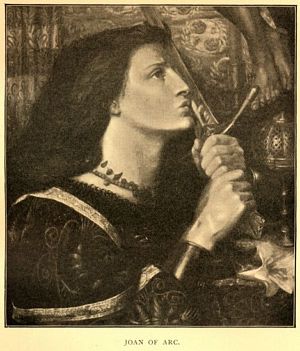
JOAN OF ARC.
Figure: Oil. Joan, kissing the sword of deliverance, kneels before a
crucifix; on the altar lies a white lily.Surtees, p. 91
proved popular, if one may judge by the number of replicas
commissioned, which included one for Miss Heaton (a
water-colour),
one for Lady
Ashburton
, and
one very much later for Mr.
L. R. Valpy
. These varied a little, the figure in some cases facing
to the right and in others to the left. In connection with the third of these I
note for the first time a phrase which later on becomes curiously frequent in
Rossetti's letters when offering replicas to likely customers. Speaking of
Joan of Arc
, in order to tempt Mr. Valpy, he says: “Neither in expression,
colour, nor design, did I ever do a better thing.” I have no
recollection of the
Valpy picture (which
was exhibited in 1883) nor have I seen
Lady Ashburton's copy from which it was done;
but I have seen another which is contemporaneous with the latter, and it is
difficult to believe that the above is not a slight exaggeration of its
merits.
The Leathart version of
Paolo and Francesca
is similar in composition to the
1855 one
(Ruskin—Rae), but is larger and more developed. It is
reproduced here from a photograph specially taken, and those who wish
to compare differences between the two
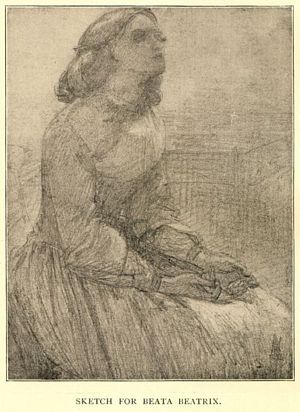
SKETCH FOR BEATA BEATRIX.
Figure: Pencil. Study taken from Elizabeth Siddal; seated, turned to the
right; the eyes are looking up and the hands lie palm upwards in
her lap.Surtees, p. 94
versions will find the other reproduced in Mr. Stephens's “
Portfolio” monograph. Some account of the subject will be found at the end of
Chapter VIII., whilst the replicas are dealt with on
page
66
.
The well-known picture of
Beata Beatrix
, formerly owned by Lord Mount Temple and now in the National Collection
by Lady Mount Temple's bequest, bears date 1863, but was only partially painted
in that year, the completion being long delayed. One reason for the difficulty
may have been that Rossetti desired to make this picture a living memorial of
his wife, and that no regular studies of the face had been done for it. It is
possible that he may have used
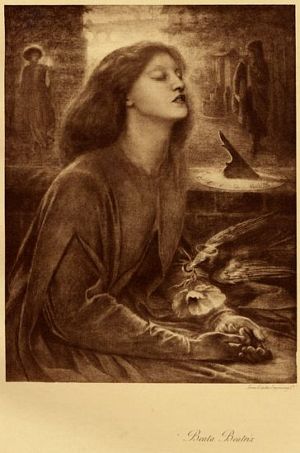
Beata Beatrix
Swan Electric Engraving Co.
Figure: Oil. At center Beatrice sits, her head leaned back and eyes closed
as if in a trance, her hands resting on her knees. In the background the figures of Love and Dante gaze at each
other; Dante stands beside a well, Love in vermillion holds a
burning heart; the Ponte Vecchio stretches across the river Arno
and the Duomo stands silhouetted against the sky.Surtees, p. 94
studies done for Delia (in
The Return of Tibullus
), of which several existed, with the head poised nearly in the proper
attitude. There were early pencil sketches intended for the picture, as for
instance the
one
reproduced here from Mr. J. P. Heseltine's
collection. Mr. W. M. Rossetti moreover mentions having had in his possession
a
small nude study for the figure and the
head.
Those who judge Rossetti as deficient or shallow in real feeling exhibit a gross
blindness to the generosity of his nature, and do him a special injustice in
regard to the execution of this picture, the haunting melancholy of which is a
faithful reflection of the spirit in which he set himself to commemorate his
dead wife's features. For an artist or literary man to trail his private griefs
in public, is, in nine cases out of ten, a sign of innate vulgarity. There is no
trace of such vulgarity here. The noble choice of subject, the still nobler
execution, place it beyond the reach of any such suggestion, and render the
picture in effect, as well as in its inspiration, unique amongst the pictures of
the world. That the subject cost him pain in the doing the most cynical could
not fail to see; that, being done, it is almost more beautifully done than any
other picture he painted is a judgment which many would endorse without
question. Technically there may be others far better. Technique in any case is
not the standard by which to estimate a painter who puts pure poetry on to his
canvas. Rossetti has done work with the brush capable of satisfying any purist
in technique, just as he has done work that is absolutely flawless in drawing;
but technique and drawing were not his strongest points, and though he himself
frequently regretted the loss of early training which would have given him what
he lacked, he was master of gifts which are rarer and more precious than drawing
or technique. Into the
Beata Beatrix
he has put the very best of himself: imagination, feeling, colour,
beauty, and perfect harmony. Not a flaw, not an ugly touch mars the repose of
that upturned face in trance, the purest of all the images that have made his
wife immortal.
Rossetti's descriptions of his own pictures are not always so poetical as the
pictures themselves, being generally written to people who might be expected to
miss the subtle meanings he put into them. It is more interesting, however, to
have them than any description by an alien hand, and so I quote the passage in a
letter describing the
Beata Beatrix
, which has often been wrongly named
The Dead or the
Dying Beatrice—a title more fitly to be applied to
Dante's Dream
:
“The picture illustrates the
Vita Nuova
, embodying symbolically the death of Beatrice as treated in that
work. The picture is not intended at all to represent death, but to
render it under the semblance of a trance, in which Beatrice, seated at
a balcony overlooking the city, is suddenly rapt from earth to
heaven.
“You will remember how Dante dwells on the desolation of the city in
connection with the incident of her death, and for this reason I have
introduced it as my background, and made the figures of Dante and Love
passing through the street and gazing ominously on one another,
conscious of the event; while the bird, a messenger of death, drops the
poppy between the hands of Beatrice. She, through her shut lids, is
conscious of a new world, as expressed in the last words of the
Vita Nuova—That blessed Beatrice who now gazeth continually on His
countenance
qui est per omnia sæcula benedictus.”
The picture is so familiar that it is probably unnecessary to say much about the
colouring, which is soft and mysterious as befits the subject. The figure of
Beatrice, with a misty aureole playing about her golden auburn
hair, is robed above in the purest green, with faint purple sleeves and a
fainter purple below. A crimson dove bears the grey death poppy in its bill, and
in the distance watching her are dimly seen Dante and the crimson figure of
Love. A dial marks the fateful hour which was to bear her, on that 9th of June,
1290, “to be glorious under the banner of the blessed Queen
Mary.” On the frame, designed by Rossetti himself, as was usually the
case with his later and more important pictures, are the first words of that
quotation from Jeremiah which Dante uttered when Beatrice's death had
“despoiled the city,” as he said, “of all dignity”:
Quomodo sedet sola civitas.“How doth the city sit solitary that was full of people; how
is she become as a widow, that was great among the nations!”
What Rossetti felt and thought about this picture himself we may gather from the
fact that for some years he refused to send out a replica of it, even when
replicas had become a regular and lucrative form of business to the detriment of
his better art. At last he was prevailed on to let Mr. William Graham have one
in return for a special obligation, the copy being a
crayon drawing dated 1869, now in the possession of Mr. Robert
Harrison, of Shiplake Court, Henley-on-Thames. Later on,
in 1872, he consented to paint it in
oil,
also for Mr. Graham, adding, for the sake of distinction, a predella,
representing below the main subject the meeting of Dante and Beatrice in
Paradise, with maidens bearing instruments of music.
1 White doves hover round, and underneath is the date “Mort: Die 31. Anno 1300”, with the inscription “Veni,
Sponsa,
Transcribed Footnote (page 128):
1 The
pencil
study
for this, presented to George Gordon Hake in
1872, and inscribed “Guardami ben; ben son, ben son
Beatrice,” is
reproduced on the
opposite page by permission of its present owner, Mr. Russell
Rea.
de Libano.” This version of the picture
was bought at the great Graham sale by Messrs. Agnew, and, after remaining with
them for some time, was transferred to a purchaser in Chicago. Once the reserve
was broken, Rossetti painted other replicas as well, none of them at all equal
in quality to the original. A small
water-colour was done for Mr. Craven while the
Graham picture was in progress, and was finished
in 1871. This, with the two already mentioned (making three versions in all),
was exhibited at the Burlington Fine Arts Club in 1883, whilst at the Academy in
the same year was the Mount Temple picture, with a
crayon replica of 1872 done for Mr. Valpy. There was a third
copy in oil done for Mr. Valpy in 1880, as part
of the artist's debt for
Dante's Dream
(of which particulars will be given later). This was put in with
Rossetti's own effects at the sale in 1883, and was acquired by
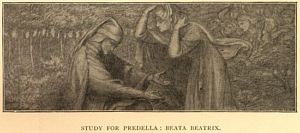
STUDY FOR PREDELLA: BEATA BEATRIX.
Figure: Pencil. Study for the predella. Dante, turned in profile to right, is
kneeling on the ground, head down turned, and arms outstretched
in welcome. Beatrice bends towards him lifting the veil from her
face. In the right background young women sing and bear
instruments of music.Surtees, p. 96
the Hon. Percy Wyndham. The
picture
possessed by the Corporation Art Gallery of Birmingham would have been a fourth,
but it was left unfinished, the background and some other parts being painted
after the artist's death by Mr. Madox Brown. It was acquired from the late Mrs.
Lucy Rossetti, to whom her brother-in-law had given it, in 1891.
To 1863 belongs a small oil picture called
Helen of Troy
, a full-face study, head and shoulders only, of a rather pretty model,
with masses of rippling yellow hair. Swinburne, in his “Essays and Studies,” has written a glowing description of this “Helen, with her
Parian face and mouth of ardent blossom, framed in broad gold of widespread
locks;” and in truth she is sumptuous enough, without, however, much
claim to intellectual or imaginative beauty. Except that Rossetti has painted a
burning town behind, and that the lady is fingering a crystal locket in which is
a flaming torch,
there is little to suggest that
“daughter of the gods divinely tall and most divinely fair”
for whom the towers of Ilium were sacked. Mr. Blackmore, of Liverpool, was the
original purchaser of this picture, the later history of which is not quite
clear. It is probably in America or Germany. Rossetti at a later date had some
thought of doing a picture to illustrate his ballad of
“Troy Town”, which must not be confused with this, the subject being Helen's
dedication to Aphrodite of the goblet modelled on her shapely breast. This will
be illustrated under 1870.
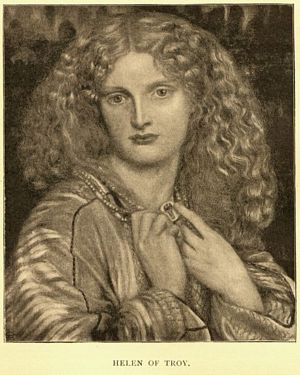
HELEN OF TROY.
Figure: Oil. Monogram lower left corner. Head and shoulders of a woman with
long wavy hair, her hands clasping a pendant around her neck.
The last of the
St. George subjects belongs to the year we are dealing with, and represents
St. George in the act of slaying the dragon; a
water-colour version of one of the incidents in the window series, but treated a
little differently. The Princess, naked to the waist, is bound to a tree in the
background, while the knight is engaged in trussing the monster, not a very
formidable specimen in regard to size. This drawing was acquired at some country
sale by the late Mr. Virtue Tebbs.
Next come three small subjects:
Belcolore
, a very finely painted head of a girl biting a rosebud, in a circular
frame, formerly in the
Boyce collection, of which a red chalk
study exists, as well as a copy in water-colour;
Brimfull
, a water-colour sketch of a lady stooping to sip from a full
glass—Rossetti explained in a letter to Mr. Mitchell, the purchaser, that this
was a study from something he had seen, and that the lady's companion, a
gentleman, was not shown, but was reflected in a mirror behind; the third is a
picture called simply
A Lady in Yellow
, belonging to Mr. Beresford Heaton. It is a half-length figure, sitting
with folded hands, done from a favourite model, and very effective as a study in
one colour, the background, the hair, and the lady's dress being all in subtly
varied tones of yellow.
We are now entering upon the period when Rossetti ceased to paint small heads and
began to devote himself to larger single figure subjects, lavishing upon them
indeed all the wealth of his fine imagination, and surrounding them with quaint
and beautiful accessories in the way of stamped leather or tapestry backgrounds,
richly embroidered robes, inlaid pieces of furniture, jewels, vases, ornaments
and flowers such as he alone knew how to select and paint. Many of these
accessories, picked up during his rambles among the curiosity shops, figure over
and over again in different pictures, the commonest of them all—so common that
it almost amounts to a signature—being a spiral shell of pearls, worn at the
side of the hair by his luxurious and languishing types of beauty. I have not
made a list of pictures in which this pretty jewel figures, but I can name off
hand amongst them—none being earlier than about the year we are dealing
with—
The Christmas Carol
,
Monna Vanna
,
The Beloved
,
Lucretia Borgia
,
Joli Cœur
,
Mariana
,
The Bower Meadow
, and the painted cartoon of the
Princess Choosing the Lot
, from the
St. George and the Dragon
series. It was varied with other ornaments, a rosette and a pendant of
pearls, large single jewels, and gold and silver clasps, most of which are
recognizable more than once. A similarly persistent object is the globular brass
ewer surmounted by a little figurine which occurs in
Lucretia Borgia
and in
La Bella Mano
. Of the other accessories which Rossetti used, the gold, amber, bead and
coral necklaces, oriental stuffs, brass sconces and candlesticks, porcelain
vases, ebony and ivory mirrors, jade toilet articles, and musical instruments
such as would delight the antiquarian heart of Mr. Dolmetsch, a very select and
not inconsiderable exhibition might be made. One of the most striking objects in
it, never so far as I am aware repeated, would be the brilliant scarlet side
ornaments which the bride, in the picture
of
The Beloved
, wears on her head to clasp her veil, and which were made, I understand,
of red Peruvian feather-work.
The first picture of the type just mentioned, and in point of execution one of
the very finest, is
Fazio's Mistress
, a small oil painting belonging to Mr. Rae, dated 1863, but considerably
altered and repainted ten years later, when Rossetti re-named it
Aurelia
. The owner, however, prefers to retain the former name. This is a
half-length portrait of Mrs. Schott (Fanny Cornforth) seated in an embossed
velvet chair plaiting her hair before a carved ebony mirror. A jade brush and a
curious double comb lie on the table beside her. The gorgeous wealth of hair,
ruby lips, and sumptuousness of figure make up a picture of ideal but not very
soulful beauty. The flesh-painting of the face, which was left unaltered in
1873, when much of the “bric-à-brac” was added,
is as fine as anything Rossetti ever did of the kind, only surpassed perhaps by
his earlier handling in Old-Master style of the
Bocca Baciata
.
The year 1864, which is one of the richest in production, contains two or three
more prominent examples of Rossetti's attraction towards a luxuriant and
seductive type of feminine beauty. First comes a picture, formerly in the
collection of the late Mr. John Bibby, of St. Asaph, described in his sale
catalogue as
A Lady in white dress combing her hair
, the setting and surroundings of which are not unlike those of
Fazio's Mistress
, though the picture is less pleasing as a work of art. The same model,
with the same red gold hair, is holding an oval mirror, while with the free hand
she combs out her long and magnificent tresses. The red note is struck by a cord
and tassel round her neck. On the table by her is a small blue and white jar and
some toilet ornaments. A patterned green curtain forms the background. This
picture is intermediate in style and in date between the one last mentioned and
Lady Lilith
, which embodies perhaps the fullest expression of Rossetti's power in
the direction already referred to.
Lilith
is a modernized conception of that wife whom Adam had before Eve, in the
Talmudic legend, and by whom “he begat nothing but diuils.” She
is the incarnation of the world and the flesh, with all sorts of latent
suggestions of the third element. A beautiful woman, splendidly and voluptuously
formed, is leaning back on a couch combing her long fair hair, while with cold
dispassionateness she surveys her features in a hand mirror. She is not only the
Lilith of Adam, the Lilith who in
“Eden Bower” makes that weird compact with the serpent, but the Lilith of all time;
lovely but loveless,
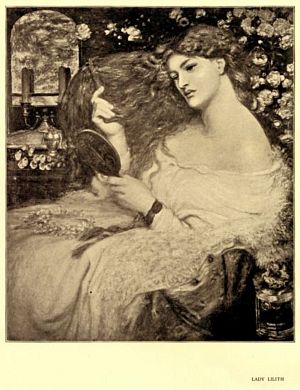
LADY LILITH
Figure: Oil. Woman in a long flowing gown, sitting in a chair facing left,
combing her hair with her right hand and looking into a mirror with her
left. Behind her at top right is a bouquet of flowers, and at top left
is a candelabra on a stand beside a window. This is a reproduction from
a photograph of the painting as it appeared prior to its retouching in
1872-3. Fanny Cornforth is the model.
amorous and deadly. She herself was a
serpent first, and knows the gift of fascination. Bowered in roses, robed in
white flowing draperies that slip and reveal the swelling contour of her bust
and shoulders, no painter has ever idealized like this the elemental power of
carnal loveliness.
“Body's Beauty” Rossetti called the picture afterwards, contrasting it with his
conception of “Soul's Beauty,” the
Sibylla Palmifera
of 1866-70. At the same time he described the two in a pair of sonnets,
which were embodied
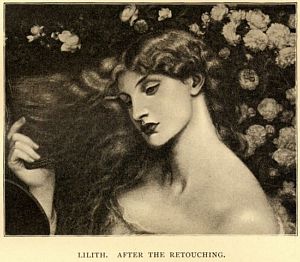
LILITH. AFTER THE RETOUCHING.
Figure: Oil. Head and shoulders of a woman combing her hair with her right
hand and looking into a mirror with her left. Behind her at top right is
a bouquet of flowers. This is a reproduction of the painting as it
appeared after its retouching in 1872-3, when the face of Alexa Wilding
was painted over that of Fanny Cornforth's.
in “
The House of Life” as Nos. LXXVII. and LXXVIII. This is the sonnet called “Body's Beauty”:
- “Of Adam's first wife, Lilith, it is told
- (The witch he loved before the gift of Eve)
- That, ere the snake's, her sweet tongue could deceive,
- And her enchanted hair was the first gold.
- And still she sits, young while the earth is old,
- And subtly of herself contemplative,
- Draws men to watch the bright web she can weave,
- Till heart and body and life are in its hold.
- The rose and poppy are her flowers; for where
- Is he not found, O Lilith, whom shed scent
- And soft-shed kisses
1 and soft
sleep shall snare?
- Lo! as that youth's eyes burned at thine, so went
- Thy spell through him, and left his straight neck
bent,
- And round his heart one strangling golden hair.”
Transcribed Footnote (page 133):
1 In the earliest version, inscribed on the picture,
Rossetti wrote “fingers,” which he afterwards altered to
“kisses.”
Lilith
, though dated 1864, was not finished completely until 1866 or 1867. It
was commissioned by Mr. F. R. Leyland, who, unwisely as the event turned out,
let Rossetti have it back in 1873, after one of his illnesses, when he became
seized with a sort of mania for altering his work. The face, which had first
been painted from Mrs. Schott, was entirely redrawn from a different model, and
with anything but satisfactory results, although he himself was not displeased
with the work which had been done upon it. A negative fortunately exists of the
picture in its former state, and though not a particularly good one, it serves
at least to show what the painting originally was. It is this which I have
reproduced, and in the text, for comparison merely, I have given the repainted
head. The picture, since the sale of Mr. Leyland's collection, has passed into
the hands of a gentleman who has already been mentioned as the owner of
Found
(and other Rossettis), Mr. Samuel Bancroft, junior, of Wilmington,
Delaware, U.S.A. Certain replicas exist, amongst which may be specified a
small water-colour (1867) belonging to Mr.
Coltart, of Liverpool, a
water-colour (1867)
belonging to Mr. A. S. Stevenson, of Tynemouth, a
black
and red crayon
(described as a “finished study”) formerly in the
possession of Mr. Trist, and a
chalk head and bust
in Mr. Ellis's possession, belonging to about the same period.
Still in the same vein—of “Women and Flowers”—is the next great picture begun in
1864, the
Venus Verticordia
. The principal version of this, an oil painting, was commissioned by Mr.
Mitchell, but was not finished until some time in 1868. The earliest, therefore,
in point of date is the little
water-colour
commissioned by Mr. Rae as a replica, which was delivered during the year. The
picture represents a tall, massively-built woman—no spiritual goddess of
beauty—undraped and standing in a bower of clustering honeysuckle which hides
her to the waist. Above she is bowered in roses—such a glorious wealth of
flowers as compelled even Ruskin's admiration, while disliking the picture
itself, the painting, and everything else connected with it. In her left hand
she holds the apple, the prize of her beauty; in her right a dart, upon which is
poised for an instant a delicate sulphur butterfly. Others are hovering round
like moths at a candle, symbolical of the lovers who adore for one day the power
of Love which remains eternal. Behind is the grove of Venus, and a blue bird
winging its way through space. As a nudity the picture would not now be
considered at all remarkable, but at the date it was painted Rossetti evidently
feared, and had reason to fear, hostile criticism on this account. In writing to
Mr. Rae about the little
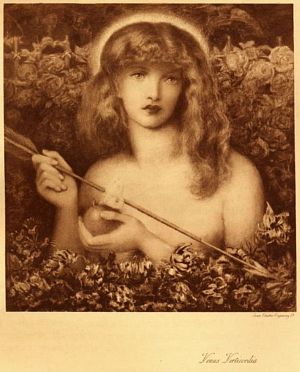
Venus Verticordia
Swan Electric Engraving Co.
Figure: Water colour. Head and upper torso of a nude woman standing in a
flower patch, holding an arrow in her right hand and an apple in her
left. Her hair is worn in a fringe on the forehead, and a butterfly
perches on the apple.
water-colour, which at all events is as
chaste as anything could be, and many degrees more pleasing than the full-sized
version, he said: “I really do not think the large picture chargeable
with anything like Ettyism, which I detest; but I am sure the little one has
not a shadow of it. Drapery of any kind I could not introduce without quite
killing my own idea.” Whether, if Rossetti had lived later, he would
have availed himself more of the freedom accorded to painters we cannot, of
course, say. With his intense and passionate love of feminine beauty, and a
sensual southern strain in his blood besides, it seems rather remarkable how
chary he was of painting the nude form. I only know of one entire nude figure
(besides, of course, studies) amongst all his works, and that is the crayon
called
Spirit of the Rainbow
belonging to Mr. Watts-Dunton, which is
reproduced in this book for the first time. Mr. Watts-Dunton has also
a half-length nude, done from the same model, a companion drawing in fact. There
are two reasons which might, perhaps, be assigned for this artistic reticence,
besides the possible one that Rossetti himself disliked in pictures anything
chargeable, as he says, with “Ettyism,” and these are, first, that he felt his
command of technique to be not quite adequate for such work, and, secondly, that
his clients were prudish. One of them, at least, we know to have been so. Mr. L.
R. Valpy was so particular that he hardly liked even a bare arm to be shown in
the pictures he bought to hang on his walls. One need not be a prude to feel
that
Venus Verticordia
is not among Rossetti's greatest works; nor, if one were, would it be
possible to grudge admiration of the marvellous skill and the wonderful eye for
colour which designed the floral surroundings. In the procuring of blossoms for
his purpose he spared neither trouble, money, nor friends, but commissioned them
carte blanche from all sources with a sort of Neronian magnificence.
The following
sonnet was written for
Venus Verticordia
, and published in the “
Poems,” with alterations which do not seem in all cases to improve it, though
in general Rossetti's emendations of his poems are as successful as his
pictorial ones are apt to be the reverse:
- “She hath it in her hand to give to thee,
- And yet within her heart would hold it back;
- She muses with her eyes upon the track
- Of some dazed moth or honey-seeking bee.
- ‘Haply he is as one of these,’ saith she;
- ‘Alas! the apple for his lips,—the dart
- That follows its brief sweetness to his heart,
- The wandering of his feet perpetually!’
- A little space her glance is still and coy;
- But if she gives the fruit that works her spell,
- Those eyes shall flame as for her Phrygian boy.
- Then shall her bird's strained throat the woe
foretell,
- And her far seas moan as a single shell,
- And through her dark grove strike the light of Troy.”
Mr. Rae's water-colour of
Venus Verticordia
is the one I have chosen, with his kind permission, to
reproduce here, although it has appeared once
before in Mr. Stephens's
monograph in the “Portfolio” series. The Mitchell picture seems to have passed into the possession
of Mr. John Graham, the uncle of Mr. William Graham, who also had a fairly large
collection, and to have been sold after his death in 1887. Previously to that it
had undergone the fate of so many of Rossetti's oil pictures in being badly
overpainted at a date subsequent to its completion. I have not ascertained who
owns it now. Of other versions known to exist I can mention a
finished crayon study dated 1863, a year before the
picture, which used to belong to Mr. William Graham; a
crayon replica of 1867 done for Mr. Leyland, and bought after his
death by Mr. Bibby, at whose sale it figured in 1899; lastly, a
water-colour replica (usually described as an
oil) done for Mr. William Graham in 1868, and now in the possession of Lady
Muir-Mackenzie.
The remaining productions of 1864 are all in water-colour. They include
Morning Music
, an elaborate little picture of a lady having her hair dressed while a
lover plays to her on his lute, wrongly attributed as a rule to a very much
earlier date;
Monna Pomona
, a seated figure of a girl holding an apple, with roses in her lap and
in a basket beside her, formerly in the possession of Mr. Alexander Ionides; the
little romantic picture of
How Sir Galahad, Sir Bors, and Sir Percival received the
Holy Grail
— belonging to Rossetti's earlier manner and already
described on page 92;
Roman de la Rose
, also described, page 107; and
The Madness of Ophelia
, a scene representing Laertes leading Ophelia away, whilst the king and
queen are looking on. Laertes is dressed in a red cloak
and reddish leather boots, with a green-sheathed knife slung round his neck,
exactly like the man in
La Belle Dame sans Mercy
(p. 69); Ophelia in blue and violet, with red underdress and a gold
girdle, also recalls the female figure in the same group, which, as already
mentioned, was probably intended at first for this Shakespearian
scene.
1 The drawing fetched £216 at Mr. William Graham's
sale,
Transcribed Footnote (page 136):
1 The figures of Laertes and Ophelia resemble those
in the water-colour of
La Belle Dame sans Mercy
, even to the details of their clothing, etc.; but the latter is
quite unlike the early sepia sketch of
La Belle Dame sans Mercy
, which I had not seen when the
passage on
page 69
was written. The sketch, I should say,
was intended to illustrate the ballad (though it is even more
suggestive of James Fitz-James and Blanche in “The Lady of the Lake”); but in the case of the water-colour the title must have been
merely an afterthought.
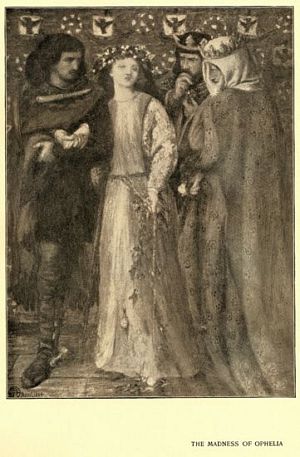
THE MADNESS OF OPHELIA
Figure: Water colour. Monogram and date lower left corner: "April 1864." At
center Ophelia stands, garlanded, holding a plant in her left hand whose
leaves drop to the floor. She is flanked by Laertes at left, who
clutches her right hand, and the king and queen at right; all stare at
her.
and passed into the collection of Mr. Humphrey Roberts. It has
since changed hands once more, and is now the property of Mrs. C. E. Lees, of
Werneth Park, Oldham, who has kindly allowed it to be
reproduced.
The next subject of this year,
Socrates taught to dance by Aspasia
, was an odd one for Rossetti to take up, except as a foil to his
ordinary work; nor does he seem to have made more than a rough sketch of it,
although the records say that a
water-colour was
commissioned by Mr. Heugh, and actually begun. This is probably the
unfinished drawing belonging to Mr. W. M. Rossetti.
Mr. Murray also has a
rough pencil sketch. The
last six items to be mentioned under 1864 are all replicas, and have been
described before, namely, Lady Ashburton's version of the
Saluto di Beatrice
triptych; a left compartment of the same done for W. Graham, and sold
some years since at Agnews', under the title of
Beatrice in Paradise
, to Dr. Lloyd Roberts, of Manchester (this is the subject usually known
as
Guardami ben; ben son, ben son
Beatrice
, from the inscription which Rossetti attached to it); the two versions
in
water-colour of
How they met Themselves
(
see page 39); and two versions also
mentioned before of
Joan of Arc, done respectively for
Lady Ashburton
and
Miss Heaton.
The record of 1865, going by the dates on the works themselves, is not large, it
being understood that some of the paintings grouped under 1863-4 were still in
progress, and that several most important new ones were commissioned and begun.
The most notable product of the year, from every point of view, was the
Blue Bower
, a picture of the
Lilith
group, done from the
Lilith
model, and representing in a setting of the most gorgeous blue and green
harmonies a beautiful woman playing upon a dulcimer. Blue tiles are at her back,
blue cornflowers by her side; blue turquoises in her hair and deep blue eyes are
other notes in the scheme such as Rossetti loved to plan. And the lady herself is clad in a fur-lined robe of green, such green as
that which the sea knows, and of which she shares the secret with a chosen
few of the world's great colourists.
1
Transcribed Footnote (page 137):
1 In a note of about this date Rossetti makes the
following interesting avowal of his colour preferences. “Thinking in
what order I love colours, found the following: (1) Pure light warm
green, (2) deep gold colour, (3) certain tints of grey, (4) shadowy
or
There can be no doubt that for sheer voluptuous beauty and grace of form the lady
of the
Blue Bower
takes high rank amongst Rossetti's creations—“sensuous yet not
sensual, sensuous with all the exquisite sensuousness of a creation by
Titian or Giorgione,” yet redeemed from inanity as from coldness by
the entrancing refinement of her music. The picture, which at one time belonged
to Mr. Mendl, is now in the hands of the executors of the late Mr. Dyson
Perrins, who bought it, and I believe that under his will there is some
possibility of its eventually coming to the nation. The terms under which it is
held do not, however, permit of my reproducing it here among Rossetti's other
masterpieces, as I should like to have done. No replicas exist of the
Blue Bower
, but one or two
studies for the head and
bust
, and a
mixed pencil and crayon study for
the full figure
, belonged respectively to Mr. Wreford Paddow and the
late Mr. Boyce, in whose names they have been exhibited.
In the midst of these large and sumptuous canvases, fetching big prices from
wealthy customers, and leading ever more and more along the well-paved road of
prosperousness and fame, it is pleasant to find that Rossetti could still turn
back to the romantic style of his early water-colours, as we have already seen
in the case of
Sir Percival receiving the Sanc Grael
, and produce one fit to rank among the very finest of his works of this
class.
The Merciless Lady
, for permission to
reproduce which for
the first time I am indebted to Mr. Fairfax Murray, is a scene of three figures
sitting on a turf-lined couch in a pavilion or arbour. In the centre is a man,
cross-legged, his chin on his hand, gazing with rapt admiration at the
blonde-haired damsel on his left who is singing to a lute. A vapid,
reckless-looking maid she is, not to be compared to the dark beauty on his
right, who with gloomy frown is trying to will back her lover. On the ground
beside them her glass only stands untasted; she alone is sad. There is the
little tragedy—barring one only the oldest I suppose in the world—set in a field
of the brightest, sunniest green, all nature rejoicing round it. Much as I
admire almost all Rossetti's water-colours, I know not one that clings in the
mind like this, or that produces without effort, from a purely imaginary scene,
so profound an impression of actuality.
Nor was this by any means Rossetti's only water-colour of 1865, though
indisputably the best. For Mr. Craven he painted the subject called
Washing Hands
—with the exception of
Dr. Johnson
Transcribed Footnote (page 138):
[
1] steel blue, (5) brown, with crimson tinge,
(6) scarlet. Other colours (comparatively) only lovable according to
the relations in which they are placed.”
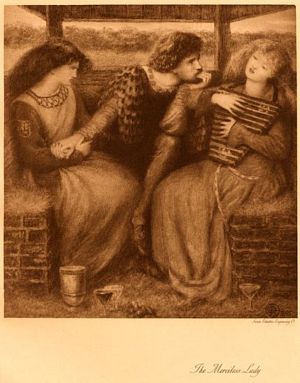
The Merciless Lady
Swan Electric Engraving Co.
Figure: Water colour. Monogram and date lower right corner: "1865." Three figures out-of-doors on a red brick seat covered over
the grass. The man in the centre gazes to the right at the
fair-haired girl who is playing and singing with her head thrown
back. On the left, a dark haired girl is trying to draw his
attention to herself; beside her on the ground her glass of wine
is untasted while the other two glasses are empty.Surtees, p. 102
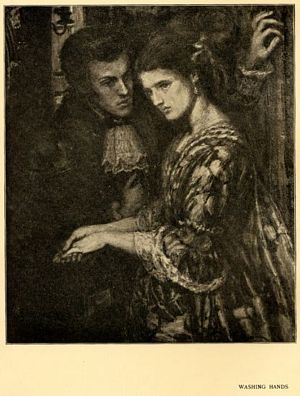
WASHING HANDS
Figure: Water colour. Man and woman in eighteenth-century costume. The woman is
turned to the left and is in the act of washing her hands while
the man stands close beside her, talking urgently.Surtees, p. 103
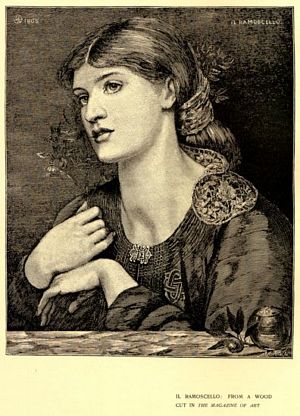
IL RAMOSCELLO: FROM A WOOD CUT IN THE MAGAZINE OF ART
Figure: Woodcut. Upper torso of a young woman, head turned halfway to left,
holding a twig in her right hand, which rests upon her left. Her hair is
drawn back and bound in the back. Monogram and date in upper left
corner: "1865." Inscription in upper right corner: "IL RAMOSCELLO," and
in lower right corner: "M. Klintright."
at the Mitre
his one experiment in eighteenth century costume. The illustration and
an extract from a letter of the painter's give all the information that is
necessary about this:
“The drawing,” it says, “represents the last stage of an unlucky love
affair. The lady has gone behind the screen (in the dining-room perhaps)
to wash her hands; and the gentleman, her lover, has followed her there,
and has still something to say, but she has made up her mind. We may
suppose that others are present, and that this is his only chance of
speaking. I mean it to represent that state of a courtship when both of
the parties have come to see in reality that it will never do, but when
the lady, I think, is generally the first to have the strength to act on
such knowledge. It is all over, in my picture, and she is washing her
hands of it.”
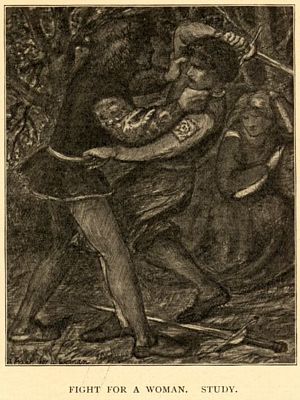
FIGHT FOR A WOMAN. STUDY.
Figure: Brush and Indian ink. Title inscribed in ink, lower left corner. Two men in a wood at twilight fighting for a woman who is
cowering at the foot of a tree. The man on the left in doublet
and hose has his opponent by the throat; the other holds a sword
above his head, ready to strike.Surtees, p. 103
A Fight for a Woman
, in Mr. Rae's possession, is one of Rossetti's most spirited and
forcible drawings. It represents two men in doublets and hose, engaged in deadly
conflict for a woman cowering near, the scene being a wood at dusk. In point of
invention this design goes back to very early days indeed, as is proved by the
existence of
tentative sketches dating from about
1853. Mr. W. M. Rossetti indeed has
rough pen
drawings
for the group of an even earlier, almost juvenile, date.
To the same year, 1865, belongs the oil painting called originally
Bella e Buona
, but renamed by Rossetti
Il Ramoscello
in 1873, when it was got back by him for retouching. The owner, Mr.
Graham, seeing the altered picture in his studio, had the sense to disapprove of
what had been done, and taking it away at once had the new work cleaned off. The
altered title, however, remains, done in gold on the blue-green background. The
figure is a half-length, dressed in slate green, and holding an acorn branch, as
may be seen from the illustration, reproduced here from a
woodcut in the “Magazine of Art.” It has often been stated that
Il Ramoscello
was painted from one of the Miss Grahams, but that is not the case.
We now come to one of the most beautiful pictures, if not the most beautiful,
that Rossetti ever painted—
The Beloved
. No one who has not seen it, with a warm sunlight bringing out its
colour, can form the most remote conception of its brilliance. “I mean it
to be like jewels,” wrote Rossetti to its owner, Mr. Rae; and
jewel-like it flashes. The subject is the Bride of the Canticles (the picture
has sometimes been called
The Bride
) advancing to meet her lover. As the Song says: “She shall be
brought unto the king in raiment of needlework; the virgins that be her
fellows shall bear her company.” In the centre is the bride,
gloriously arrayed in such stuffs as only Rossetti could imagine, and with her
are four dark-haired maidens, whose heads encircle and frame her. Before her,
serving as a foil to the creamy loveliness of her own face, goes a little negro
boy bedecked with a jewelled collar and headband, and bearing in his hands a
golden vase of roses. The figures, though life-size, are only painted
half-length, the most striking note of colour in the composition being the
bride's gown, which is of rich and indescribable green, with flowing sleeves
gorgeously embroidered in gold and red. As she nears her appointed spouse, the
maiden draws aside her veil of pearly tissue, revealing a face which for pure,
majestic loveliness is unsurpassed on canvas. The sitter was not one of
Rossetti's ordinary models, nor does she resemble even remotely that type of
dark and brooding beauty which is so frequent in Rossetti's later subjects. It
is stated that a Miss Mackenzie, a model much sought after in the studios, lent
her features for this particular picture, in which all intellectual attributes
were to be subordinate to sheer perfection of form. Of the maidens who surround
the central figure, and set off her beauty, one is of a dark Asiatic cast; a
second is a handsome gipsy; a third, on the left, looks languorously and
enviously towards the bridegroom, and the fourth is more than partially
concealed. The outside pair carry stems of blossom which form rich clusters of
colour in the upper corners, on the right a branch of scented japonica, on the
left a tiger-lily. Brighter than
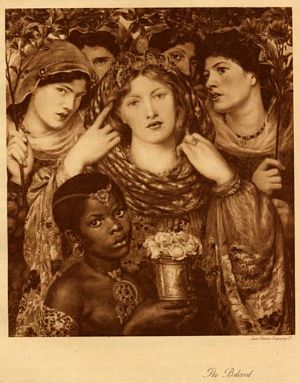
The Beloved
Swan Electric Engraving Co.
Figure: Oil. Monogram and date lower left corner: "1865-6." At center, a
woman dressed in a gown decorated with a floral pattern pulls back her
veil. Four women stand behind her holding branches and a young African
girl stands in front of her holding a vase of roses.
anything in the picture is the pair of gold
and scarlet aigrettes, formed of Peruvian feather-work, like a splendid Egyptian
head-dress, pinning the bride's veil at either side, and concentrating all
attention on her matchless beauty.
“Excepting one or two later works of the master, where sentiment of a more
exalted sort, as in the
Proserpine
, inspired the designs,
The Beloved
,” says Mr. F. G. Stephens, “appears to me to be the finest
production of his genius. Of his skill in the highest artistic sense,
implying the vanquishment of prodigious difficulties— difficulties the
greater because of his imperfect technical education— there cannot be two
opinions as to the pre-eminence of Mr. Rae's magnificent possession. It
indicates the consummation of Rossetti's powers in the highest order of
modern art, and is in harmony with that poetic inspiration which is found in
every one of his more ambitious pictures. . . . Rossetti's
Beloved
is in English art what Spenser's gorgeous and passionate
Epithalamium is in English verse, and if not more rapturous is more compact of
sumptuous elements.”
The Beloved was finished in 1866, but was painted upon again in 1873, this time
happily without injurious effects. Amongst other changes which took place while
the picture was in progress, Rossetti at one point substituted the
little negro boy for his first conception of the
foremost figure,
a brown mulatto girl.
[2nd sketch of girl] Numerous sketches exist of the
models he obtained for this figure,
[sketch 1]
[sketch 2]
[sketch 3]
[sketch 4] the late Mr. Boyce having some which
are now in Mr. Fairfax Murray's possession. After the change, but before the
picture was completed (lacking still the vase of roses, the jewelled collar of
the slave boy, the flowering stems and other details) Rossetti had the canvas
photographed, and copies of this unfinished state have been published once or
twice. These, however, by no means do justice to the picture, and I am very
considerably indebted to Mr. Rae for his permission, never before accorded, to
reproduce this masterpiece in its perfect
entirety. No replica was ever painted of it, nor does even a crayon study exist,
to my knowledge, beyond those of the
negro boy
mentioned, and one for the
central figure.
In August, 1866, Rossetti wrote to his mother, “I have been working
chiefly on the Toilette picture, and at the one with the gold sleeve, both
of which I think you know.” The “Toilette picture” was
Lilith
, not finished until this year or the next. The “gold sleeve” one was the
second of Mr. Rae's great treasures, called
Monna Vanna
, for permission to reproduce which I am equally be-
holden. This “Lady of the Fan” is a
sumptuous creature of the Lilith rather than the Beatrice type. Magnificently
robed in white, with heavy gold embroidery, she leans at ease upon a couch, idly
spreading a fan of black and yellow plumes, typical of all that is luxurious in
life. When exhibited at Burlington House in 1883, the
Monna Vanna
was one of the pictures that most attracted and dazzled the public eye.
I can myself, being then at school, remember the enthusiastic reports of certain
schoolfellows as to this wonderful picture, with a crystal locket that showed
the flesh beneath in rifts of pink and white, like nothing that ever was
painted, which sent me in due course to the scene; and I can dimly recall the
effect produced by the picture—and of course by the locket. When first
completed
Monna Vanna
aroused some criticism, on account of the clashing hues of her jewelled
rings, some of which Rossetti removed, when, at a later date, he had the picture
back for his customary revision. On this occasion, as is shown by comparison
with a photograph taken before the retouching, he altered and fortunately
improved the face. When he had done this and lightened the mass of wavy hair
which flowed around her shoulders, he proposed to change the name from
Monna Vanna
to
Belcolore
(which had already been used for an
earlier
head
), thinking that the former had a mediæval ring that was out of
keeping with the subject. The proposed new name, however, failed to take
effect.
This picture was not bought direct from the easel by Mr. Rae, but was transferred
to him by Mr. Blackmore, its original purchaser. One
replica, a crayon, seems to have been done
from it for Mr. Theo. Allingham, but this I cannot verify.
A picture of even greater importance in some ways than the
Monna Vanna
—certainly, I should say, in Rossetti's own estimation —was
Sibylla Palmifera
, the third of Mr. Rae's fine trio of large oils. This was commissioned
in 1865, begun in 1866, and not finally finished until the December of 1870.
Rossetti (says his brother, in a note on the picture) had at first intended to
paint for Mr. Rae a picture called
The Queen of Beauty
, which, however, he relinquished. He then designed the
Palmifera
, giving it this title, as he said, “to mark the leading place
which I intend her to hold among my beauties.” He also refused to
specify a time for delivery, having apparently had trouble about this in the
case of
The Beloved
; and added, “There is no knowing in such a lottery as painting,
where all things have a chance against one—weather, stomach, temper, model,
paint, patience, self-esteem, self-abhorrence, and the devil into the
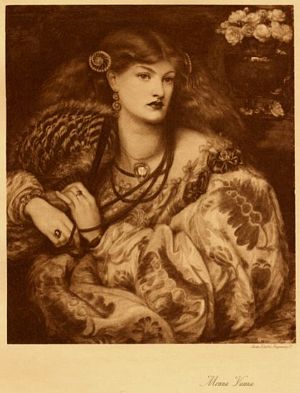
Monna Vanna
Swan Electric Engraving Co.
Figure: Oil. Upper torso of a seated woman wearing a billowing gown,
her hands clasping the string of beads around her neck. She wears
two seashell-shaped pins in her hair, and at upper right a vase of
flowers sits on a shelf.
Note: The title of
The Daughter of Herodias appears integral in this electronic transcription, but in
the original printed text it is printed partly on page 143 and
partly on page 144.
bargain.” The picture underwent some extensions of
idea, after it was begun, and it was then that the word Sibylla was added to the title. At the same time a fine
sonnet was written for it, published in the
1870 volume of poems under the full title of
the picture. Afterwards it occurred to Rossetti to make the latter stand for a
spiritual counterpart to his
Lady Lilith
, and in adapting the two sonnets for inclusion in “The House of Life” he put them side by side with the respective
titles of
“Soul's Beauty” and
“Body's Beauty”. The
“Lilith”
sonnet has already been quoted; the
following is that done for
Sibylla Palmifera
:
- “Under the arch of Life, where love and death,
- Terror and mystery guard her shrine, I saw
- Beauty enthroned; and tho' her gaze struck awe,
- I drew it in as simply as my breath.
- Hers are the eyes which, over and beneath,
- The sea and sky bend on thee—which can draw,
- By sea or sky or woman, to one law,
- The allotted bondman of her palm and wreath.
- This is that Lady Beauty, in whose praise
- My voice and hand shake still,—long known to thee
- By flying hair and fluttering hem,—the beat
- Following her daily of thy heart and feet,
- How passionately and irretrievably
- In what fond flight, how many ways and days!”
The sonnet describes the picture partly—a Sibyl bearing a branch of palm, and
seated on a throne beneath a stone canopy overlooking a temple court. Above her
is carved on one side a blinded cupid, wreathed with roses; on the other a
skull, crowned with red poppies. She herself is robed in crimson, with chestnut
brown hair drawn away from her forehead, and a dark green coif trailing from her
head over her left shoulder. A burning censer, a flaming lamp, and two
butterflies hovering near are all accessories in the picture, which so far as
the face is concerned differs from most other Rossettis, even those done from
the same model, Miss Wilding. The artist proposed to paint a full-sized replica,
at one time, but never carried this out. A
study in
tinted crayons
and a
black chalk
drawing
exist of it, according to Mr. William Sharp's book.
Two small paintings and a crayon were produced for Mr. J. Hamilton Trist, or
bought by him, in 1866. These are the head of Miss
Wilding called
Regina Cordium
,
1 already referred to; a nearly circular head of a
Dancing Girl
, sometimes called
The Daughter of Herodias
,
Transcribed Footnote (page 143):
1 This is described on page 108 as a replica of
Bocca Baciata
. Since the passage was printed I have ascertained that it was a
replica of the head of
Sibylla Palmifera
.
reproduced here, and the design for a
picture called
Michael Scott's Wooing
. What the story was that Rossetti proposed to illustrate by this design,
and where he got it from, I do not know. The catalogue of the Burlington House
exhibition of 1883 describes it as a “magical pageant of Love, Death, and
various other figures,” arranged by the wizard to please a lady with
whom he was in love, and of whom Rossetti once began a separate drawing, which
he inscribed “
Michael Scott's Mistress.” It was at any rate a favourite theme, and remained by the artist for
very many years, an early but quite
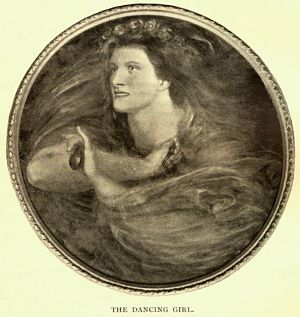
THE DANCING GIRL.
Figure: Oil, oval-shaped. Upper torso of a garlanded woman almost in
profile to the left. She holds a pair of castanets in each hand, and her
arms are crossed in front of her.
different version of the subject having been presented in
1853 to Alexander Munro.
1 This is given for comparison in the text. The subject was commissioned
as a
water-colour in 1867 by Mr. Frederick
Craven, and Mr. W. M. Rossetti mentions a letter of 1871 as tending
Transcribed Footnote (page 144):
1 That these were not the only versions of the
design is evident from the following
description in one of Rossetti's note-books: “Michael
Scott's mistress standing by the girl with a cup of magic wine, and
looking at her with pity. Deerhound with his head up, howling at the
spell. Women trying to stop him, or perhaps old woman frowning and
railing at him from corner. Michael lying along the front of the
picture at the girl's feet. Death's-head moth fluttering round the
burning lock of hair. Perhaps two openings above the side seats,
with a number of girls watching—Michael Scott's harem. Raven picking
up scraps in old woman's lap, while she cuts a silver cross from the
girl's girdle.” This last episode is repeated in the 1866
design.
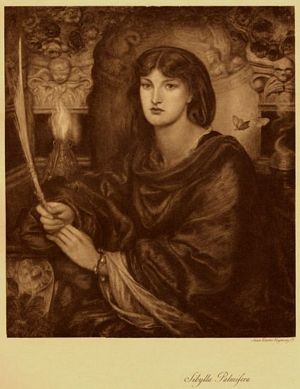
Sibylla Palmifera
Swan Electric Engraving Co.
Figure: Oil. Upper torso of a seated woman in a flowing dark robe facing
front, holding a palm branch in her right hand. She is seated on a throne beneath a stone canopy overlooking a temple
court, while behind her on the left a lamp illumines
the carved head of a blinded Cupid wreathed with roses; on the
right a burning censer stands beneath a carved skull crowned
with red poppies.Surtees, p. 112.
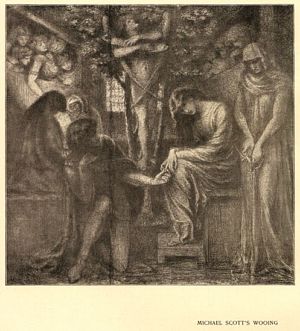
MICHAEL SCOTT'S WOOING
Figure: Red chalk. Michael Scott kneels in the foreground and slips a ring on to
the girl's finger; further to the right stands a hooded female
figure cutting a crucifix from her girdle. Love stands in the
centre, in the fork of a tree, head upturned, surrounded by
foliage; his wings are closed, the tips crossed in front of his
body. On the extreme left two shrouded figures are introduced,
one with back turned. On either side above, are groups of young
women looking down on the scene below.Surtees, p. 124
to imply that a
painted version was
actually in preparation for Mr. Leyland. It was certainly not finished, however,
even if it was ever begun. The
crayon design is
still in the possession of Mr. H. H. Trist.
In 1866 was painted the water-colour
Hamlet and Ophelia
, owned by Mr. A. T. Squarey, of Liverpool. This will be found reproduced
under 1858, for comparison with the well-known
pen-and-ink drawing of that date. The year's record closes with
an
oil portrait of the painter's mother,
towards whom at all periods of his life his devotion was exemplary; a
large crayon drawing of Christina
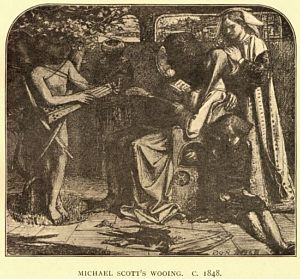
MICHAEL SCOTT'S WOOING. C. 1848.
Figure: Pen and brown ink. Inscription lower right: "DGR to A.M. 1853" Young woman holding an open book, having her hair dressed by
an attendant, is seated beside a man; both are facing to the
left looking towards the figure of Love standing beneath a tree,
playing on an instrument. A child sits on the floor to the right
of the chair; another figure in the background with head
bowed.Surtees, p. 21
Rossetti, with her thoughtful face resting on her hands; and two
designs for her second volume of poems,
The Prince's Progress, which for the sake of convenience in reference have already been
described under 1862, together with the pair for “Goblin
Market.”
In 1867 Rossetti painted the oil
Christmas Carol
for Mr. Rae, an entirely different subject, as has already been
explained, from the
1857-8 water-colour. This is a
half-length figure of a girl, draped in a gold and purple robe of Eastern stuff,
and playing upon a species of lute suspended round her neck. With head thrown
back she carols out a joyful Christmas hymn. On the frame is the following
inscription culled from the “Winchester Mysteries”:
“Here a
maid, well-apparelled, sings a song of
Christ's birth with the tune of Bululalow:—
Jesus Christus hodie Natus est de
Virgine.
”
An admirable engraving has been made by M. Gaujean from the
Christmas Carol
, and published by Mr. Dunthorne. On this account all that I shall
reproduce of it is a small photograph from the
crayon
study
, which belongs to Mrs. Aglaia Coronio.
Two small but pretty pictures of 1867 are
Joli Cœur
and
Monna Rosa
. The first, which was bought by Mr. Graham, represents a
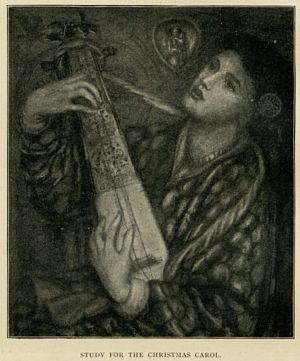
STUDY FOR THE CHRISTMAS CAROL.
Figure: Crayon. Upper torso of a seated woman turned left, head leaning
back to right, playing a stringed instrument.
coy-looking maiden fingering her necklace, and evidently proud of the
beautiful pearl ornament daintily stuck in her hair. It now belongs to Miss
Horniman, and has been exhibited three or four times. A
pencil drawing of it is said to exist.
Monna Rosa
belonged to Mr. Leyland, though an
earlier
version
(judging from an entry in a letter quoted by Mr. W. M.
Rossetti in his book “
D. G. R. as Designer and Writer”) appears to have been in the possession of Mr. Peter Miller in 1864.
The subject has attached to it a legend from Poliziano:
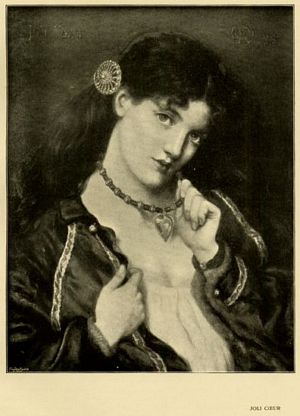
JOLI CŒUR
Swantype
Figure: Oil. Inscribed title upper left; monogram and date upper right:
"1867." Upper torso of a dark haired woman facing front, head tilted
right, holding in her right hand a necklace to which is attached a
heart-shaped pendant. A seashell-shaped pin made of pearl is in her
hair.
- “Con manto d'oro, collana ed anelli
- Le piace aver con quelli
- Non altro che una rosa ai suoi capelli.”
Its principal interest is as a study in beautiful colour, representing a
lady clad in a dress of pale emerald, with golden fruit worked upon it, plucking
a rose from a tree planted in a blue jar. Gold and red are the keynotes of the
picture, and are perpetuated in various degrees in the twenty or more roses on
the tree, the gold on her
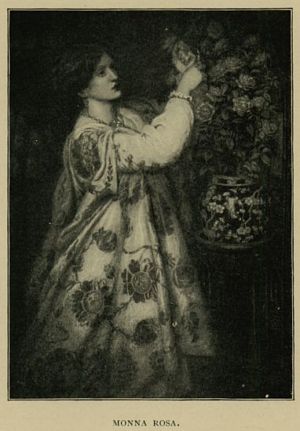
MONNA ROSA.
Figure: Oil. Full length of a woman turned profile right, wearing a
floral-patterned dress, and plucking a rose from a rose tree in a vase
at right.
dress, the gold ornaments she wears, her gold auburn hair, a red pot
in the flower-stand, and a large peacock screen in the background, also of red
purple. The picture was sold in 1892, together with the rest of the Leyland
collection.
The next item of 1867 is a more important one than either of the foregoing, being
the exquisite
Loving Cup
. The original and best version of this is the oil picture, formerly
owned by Mr. Leyland and now in the possession of Mr. T. H. Ismay. It is this
which I have
reproduced. It was followed in the
same year by three water-colour replicas, of which
one was commissioned by Mr. W. Graham and is at the moment of
writing on exhibition at the Burlington Fine Arts Club in the name of Mr.
Charles A. Swinburne (not the poet). It is on a panelled
stretcher, and has generally been described erroneously on that account as
an oil.
1
Transcribed Footnote (page 147):
1 This may be a convenient place to state that most
of Rossetti's later pictures which are described in Christie's and
Exhibition catalogues as “Panel” are in reality canvas stretched on
panel, a mode of protection commonly adopted by Rossetti. The
Loving Cup
(oil) was perhaps the last picture that he actually painted on
panel. Water-colours and drawings were often put down also on to
panelled stretchers, and this has in some cases led to a wrong
description, as in the above instance.
A
second
replica
belongs to Mr. Alexander Stevenson; and a
third, sold amongst the late Mr. Bibby's
pictures this year (1899), is now in the possession of Mr. J. Beausire, of
Birkenhead. The subject is a young and beautiful lady—how everlastingly foolish
it is to say that Rossetti painted nothing but one mournful type!—robed in
crimson, and standing against a background of fair embroidered linen, surmounted
by a row of heavy brazen plates. With long brown hair gracefully looped about
her shapely neck, she raises to her lips a golden cup, holding the cover in her
left hand, and pledging her unseen knight.
- “Douce nuit et joyeux jour
- A cavalier de bel amour”
is the inscription attached to some copies of this picture, which is
probably too well known from photographs to require praise or description.
Such is not the case, however, with another picture of the same year, the
water-colour
Return of Tibullus to Delia
, which has also been generally described from its glazed appearance as
an oil. The subject is taken from the end of the third elegy of Tibullus, in
which he takes farewell of his mistress, and begs her to await his next coming:
- “Live chaste, dear love; and while I'm far away,
- Be some old dame thy guardian night and day.
- She'll sing thee songs, and when the lamp is lit,
- Ply the full rock and draw long threads from it.
- So, unannounced, shall I come suddenly,
- As 'twere a presence sent from heaven to thee.
- Then as thou art, all long and loose thy hair,
- Run to me, Delia, run with thy feet bare.”
In the picture Tibullus is seen bursting in at the door, followed by a
joyful slave girl, who pulls aside the curtain. Delia is seated wearily, distaff
in hand, on a couch, and on the floor is “the old dame, her
guardian,” singing to a lute. A young black slave is sleeping across
the threshold. Numerous pencil sketches
[sketch 1]
[sketch 2]
[sketch 3]
[sketch 4]
[sketch 5] were made from Miss Siddal for Delia,
sitting on the couch and biting a long tress of hair in her teeth, which shows
that the design must have been of considerably earlier date than this year, when
it was commissioned by Mr. Frederick Craven. A
duplicate water-colour, not so fine, was painted in the following
year. Another water-colour was painted for Mr. Craven about the same time as
the
Tibullus
, called
Aurora
, and was exhibited along with it in Man-
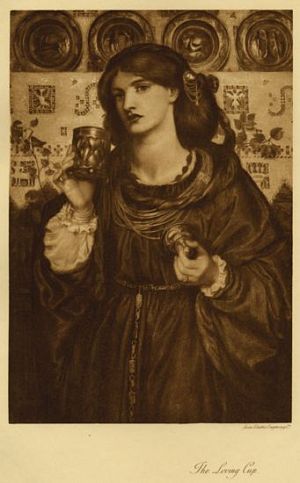
The Loving Cup
Swan Electric Engraving Co.
Figure: Oil. Nearly full length of a dark-haired woman who raises a gold cup to her lips with which she is about to
pledge her unseen knight. In the background, a high Venetian
sideboard covered with a lace cloth on which are ranged four
brass dishes; sprays of ivy form an additional pattern. The head
is taken from Alexa Wilding.Surtees, p. 115
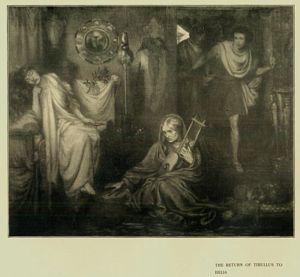
THE RETURN OF TIBULLUS TO DELIA
Figure: Water colour. At right, Tibullus enters the room. Delia is leaning over to the left with hair outspread, holding a
lock of hair between her lips; in her right hand she holds a
shuttle. The serving woman holds back a curtain to enable
Tibullus to enter. A large basket filled with balls of coloured
wool has been introduced; also a cat sleeping on a red stool. An
elderly woman sits on the floor playing upon two musical
instruments.Surtees, p. 25, 24
chester at the great Exhibition of 1882.
This was a “toilet” picture, modelled upon
Morning Music
.
The last year of this period was probably in part taken up with finishing off the
long list of pictures described, and was also cut into by Rossetti's breakdown
in health and sudden anxiety about his eyesight. Even in 1867 he had written to
a friend: “I must tell you that since my return to town I have found the
confusion in my head and the strain on my eyes decidedly rather on the
increase than otherwise. I mention this in confidence, as it would be
injurious to me if it got about.” At the same time he was consulting
Sir William Bowman, the famous oculist, and no doubt had to relax his hours of
work. In this year, nevertheless, he painted the
portrait
of Mrs. William Morris
, in a blue dress, seated at a table before a
glass of flowers, which many competent judges regard as one of his very finest
pictures, and which was the prelude to that long series of noble canvases by
which he has become best known to the public. Mrs Morris has lent her portrait
to the National Gallery, where it hangs (at Millbank) beside the
Ecce Ancilla
and the
Beata Beatrix
. Here the public have full opportunities for admiring its exquisite
colour and painting—qualities of masterhood that overshadow the earnest
simplicity and effort of Rossetti's little early picture. Several crayon studies
were done for the portrait, some of them in a different pose from the one
adopted, but nearly all finished with that marvellous art which renders
Rossetti's work in chalks hardly less valuable than his painting. The study
called
Reverie
, belonging to Mr. Watts-Dunton, of which Mrs. Morris herself has a very
fine duplicate, belongs to this class and period, though suggestive in treatment
of a later picture,
The Daydream
, in which Mrs. Morris is represented sitting in a sycamore tree. But there is little doubt that Rossetti, from the sittings
which Mrs. Morris then gave him, built up materials for much of his
subsequent work, just as he had previously done in the case of Miss
Siddal.
1
Transcribed Footnote (page 149):
1 This may be a suitable place to draw attention to the
fact that the sonnet
beginning
The other productions of 1868 are
Bionda del Balcone
, an enlarged replica in water-colour of
Bocca Baciata
;
The Rose
, a water-colour drawing of a lady at a window, formerly in the Turner
collection, at the sale of which in 1888 it fetched £89, and later in the
possession of Mr. Alexander Ionides, at whose sale ten years later it fetched
£300;
Aurea Catena
, a fine crayon drawing of Mrs. Morris, said (but without truth) to have
been a first study for
La Pia
, a picture painted many years later of the unhappy wife of Nello della
Pietra, of Siena, who was locked up by him in a castle overlooking the
fever-haunted Maremma, until she died. Rossetti, it is known, did begin
upon
La Pia
about this date, and completed two very fine drawings for it in black
chalk, which used to be in the possession of Mr. Howell, but which disappeared
before the picture was taken up. These drawings are
usually known by the full title of the legend,
Ricorditi di me che son La Pia
. Some versions in coloured crayon which exist are replicas of later
date.
1 Except that the “lady of the golden chain” is seated at a parapet,
gazing out into space, there is nothing in common between the picture of
La Pia and this drawing, which is simply a very beautiful portrait. It is in
Lord Battersea's possession, at Overstrand, near Cromer.
A water-colour replica of
Venus Verticordia
, the one done for Mr. William Graham, and a replica for Mr. Craven
of
St. George and the Princess Sabra
,
Miss Heaton's picture, painted in 1862,
close the list of works executed by Rossetti (in some cases, it must be
suspected, with the help of his assistants) between the years 1862 and 1868. The
length of this chapter, as compared with previous ones, speaks sufficiently,
without any further remarks, for the volume and importance of his output during
this period.
Transcribed Footnote (page 150):
[
1]“One face looks out from all his
canvases,” by Miss Christina Rossetti, which is printed opposite
the title-page, refers to Miss Siddal, not to Mrs. Morris, as most people
would probably imagine. The date should show this, but it might perhaps be
overlooked, in which case the sonnet would appear to confirm, instead of
disprove, the popular delusion as to Rossetti's devotion to one type of
beauty.
Transcribed Footnote (page 150):
1 One of these has been published in photographic form
by Mr. Caswall Smith. It was originally bought by the late Earl of Lytton,
and is now the property of his daughter, Lady Betty Balfour.
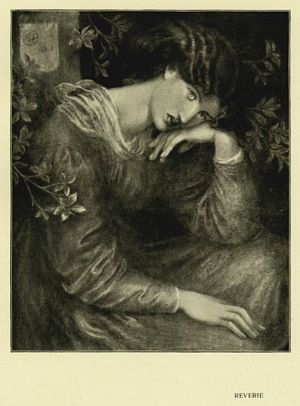
REVERIE
Figure: Coloured chalks. Monogram and date inscribed on a scroll upper
left: "1868." A seated young woman leans right, resting her cheek upon
her left hand. Branches fill the upper background.
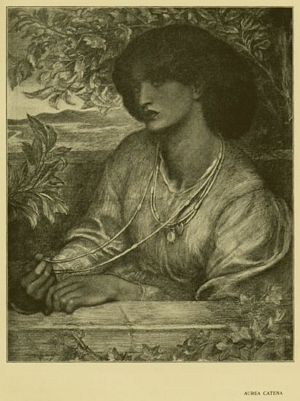
AUREA CATENA
Figure: Colored chalks on grey-blue paper. Upper torso of a dark-haired
woman turned almost profile left, in a leafy bower, fingering her
necklace with her right hand, leaning against a railing.
THE insomnia which began to attack Rossetti in his
thirty-ninth year, and which was the indirect cause of his subsequent breakdown,
is attributed by his brother, in the first instance, to melancholy thoughts
consequent upon the death of his wife. Other contributory causes might also be
suggested in the case of a man so imaginatively gifted. An affection of his
eyesight, already mentioned, which began to cause him much anxiety, was no doubt
connected with the general overstrain of his nervous system, and in addition he
developed an internal ailment which caused him trouble from time to time. For
his eyes he adopted spectacles, often one pair on top of another, which he wore
continually, as depicted later in the dining-room scene in Chapter XI., where
Mr. Dunn has shown him reading aloud to Mr. Theodore Watts-Dunton, who in later
years became his constant companion, and even adviser on artistic and literary
points. He was hardly the sort of man to bear an illness patiently, or to make
the least of it; so that trials which would have sat but lightly on a more
phlegmatic nature, became in his case almost insupportable, and reacted on his
naturally genial temperament. In the autumn of 1866 he took Mr. Dunn with him on
a short tour in Warwickshire, revisiting the places he had walked through on his
return from Carlisle in 1853, and proceeding thence to Penkill Castle in
Ayrshire, the residence of Miss Boyd. Here he had the congenial company of Mr.
W. B. Scott, and of a most amiable and considerate hostess. On his return in
November, his eyes still gave him trouble, but he continued with interruptions
to work on his large canvases, most of which henceforward were painted from Mrs.
Morris as the sitter.
In 1869 the visit to Penkill was repeated, and is of interest, because it was not
until this occasion that he gave a serious thought to the publishing of his
early poems, some of which were still
going about in manuscript in a more or less
finished condition, though others were buried in his wife's grave. As a relief
from the strain of painting, moreover, he began to write again. The ballad of
“Troy Town”, part of “Eden
Bower”, and the “Stream's Secret”, not to
mention others of his later works, were composed at this time. His first idea
was to have the poems, such of them as he could collect or recall from memory,
set up in type to keep by him as a nucleus for a possible volume, and in this
proof-sheet form they actually exist. Gradually, however, the idea of publishing
outright grew or was forced upon him; and the last obstacle to this, the loss of
so much of his early work, was finally removed one day in October, 1869, when,
after a consent wrung from him very reluctantly, the grave was opened, and the
manuscript poems recovered. A painful interval of recopying followed, and at
last in 1870 the book appeared, having as publisher Mr. F. S. Ellis, of King
Street, Covent Garden (afterwards Messrs. Ellis and Elvey, of 29, New Bond
Street). In some ways it was no doubt an advantage to have kept the poems back
so long. His fame as a painter protected them now from the obscurity in which
every volume of verse by a young writer is launched, and they proved an
immediate success. Rossetti was fortunate in dealing with a publisher who was
not only a man of considerable attainments himself, able to appreciate as well
as push the poems, but one who was willing to undertake the risk on generous
terms; so that within a week or two Rossetti found himself £300 the richer for
the publication, with a small but steady annual return thereafter. A deal of
exaggerated nonsense (started by W. B. Scott's book) has been talked about his
procuring “cooked” or favourable reviews, the fact being that, like most men who
are in a position to do so, he took some pains to see that his book fell into
the hands of reviewers likely to understand it, and familiar with his position.
If this be “cooking” reviews, Heaven help some modern novelists! Amongst the
most loudly appreciative notices of Rossetti's new volume was one by Mr.
Algernon Charles Swinburne; amongst the few that were really hostile, if not the
only one, was a magazine article by Mr. Thomas Buchanan. One does not want, at
this time of day, to rake up again the unfortunate affair of that pseudonymous
attack in the “Contemporary” called
“The Fleshly School of Poetry”, by “Thomas Maitland.” Mr. Buchanan has long since admitted and recanted
the injustice, which he describes as “a mere drop of gall in an ocean of
eau sucrée;” and there we might let it lie, but
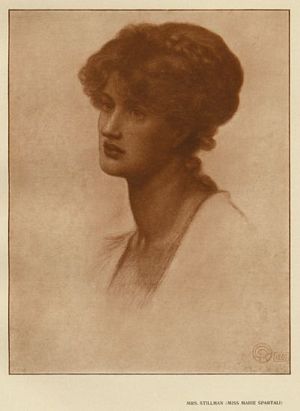
MRS. STILLMAN (MISS MARIE SPARTALI)
Figure: Red chalk on greenish paper. Lower right corner, monogram and date:
"1869." Head three-quarters to left. The hair is worn in a braided
coil with a tendril escaping at the nape of the neck.Surtees, p. 197
for the fact which no decent man or lover of Rossetti can forget,
that after his slander had been exposed Mr. Buchanan chose to repeat it with
extensions in the form of a pamphlet. The effect of this persistent
hostility on a man of Rossetti's sensitive temperament, suffering from nervous
fancies, and troubled by want of sleep, was disastrous. He viewed as a great
conspiracy against him what other men, in sounder health, would have been able
to disregard, and the effect was unhappily permanent. Mr. Buchanan has not the
excuse that it was a critical onslaught to which Rossetti objected. Ill as he
was, Rossetti could probably have ignored Mr. Buchanan's criticism. But it was a
scathing, wanton, and quite unsupported attack on his moral position, involving
in the same breath Swinburne and William Morris, the very Galahad of pure-minded
writers, whom he associated with some of the worst vices prevalent in Paris.
Rossetti, Swinburne, and Morris, as poets, have all survived Mr. Buchanan's
anonymous attack. All that that gentleman has to reproach himself with is the
effect upon the health, and indirectly upon the life of the first-named, which
no apologies could undo. Rossetti had by this time acquired the habit of taking
chloral as a cure for sleeplessness, without knowing, what is well known now,
its lamentable after-effect. The drug was then new, and was believed to be
harmless. To him it came as a godsend. In the course of time, naturally, he took
to increasing the dose, complicating it with spirits, and otherwise behaving as
people do who fall victims to this form of narcotic; but the abuse began with,
and was largely due to this episode of the “Fleshly School”. For a time, if one
may accept his brother's judgment, Rossetti was hardly to be regarded as sane;
all sorts of delusions disturbed his mind. A passage in Browning's “Fifine at the Fair,” then just published, he seized upon as an intended insult, and
Browning was forsworn for ever. Even Lewis Carroll's “Hunting of the Snark” he suspected to be a skit upon him, and so another old acquaintance was
cut off. These were painful days for his brother and the little group of friends
who tried to cheer him and divert his thoughts. Dr. Gordon Hake came to the
rescue and offered his house at Roehampton for a change. Here, either by
accident or design, he swallowed the contents of a phial of laudanum, and for a
couple of days lay between life and death. A strong constitution and prompt
treatment, however, overcame the danger, and after a short interval at Madox
Brown's house Rossetti was taken up to Scotland, first to
Urrard and Stobhall, two mansions rented by
Mr. William Graham, and then to a farmhouse at Trowan, near Crieff. Madox Brown,
and afterwards Scott, with the two Hakes, father and son, accompanied him. Three
months after this move Mr. Treffry Dunn was sent for, and painting re-commenced,
the work on which he was engaged being the replica of
Beata Beatrix
for Mr. Graham. Long walks amid healthy scenery,
good hours, and a freedom from external worries partially restored him to
health, and late in September of that year, 1872, Rossetti left Scotland for
Kelmscott, on the borders of Oxfordshire and Gloucestershire, where he had
taken the fine old Elizabethan manor house jointly with Mr. and Mrs.
Morris.
1 In order to pay expenses during his illness his valuable
collection of blue china had to be sold. He continued taking chloral, though not
at first in immoderate quantities, and, if so trivial a detail be admissible, he
began to let his whiskers grow in addition to the moustache and beard by which
he is generally known in portraits.
Rossetti's work at Kelmscott during 1872, 1873, and 1874 has been mentioned once
or twice already. It consisted to a large extent in repainting many of his old
pictures, which he had sent to him for the purpose. In this way he worked upon
the
Lilith
,
Beloved
,
Monna Vanna
, and other important canvases, including even the little early
Ecce Ancilla Domini
, which had just come into the market and was sent to him by the
purchaser, Mr. William Graham, on the express condition that he was not to alter
its primitive character. It is stated that he repainted the lily which the angel
Gabriel bears.
About 1872, Mr. Theodore Watts, who combined the business of a lawyer with the
attractions of a man of letters, visited Rossetti at Kelmscott, and made a great
impression upon him. This was the foundation of their subsequent attachment,
which, however, was not carried further at the period mentioned. Rossetti left
Kelmscott suddenly in July, 1874, owing to some dispute in which, during a
moment of nervous excitement, he became involved with a party of anglers staying
in the place. Finding things unpleasant, he returned
Transcribed Footnote (page 154):
1 This arrangement had been entered into about June,
1871, and Rossetti had already spent some months of the previous year
there. During that time he had painted a view of the old house with its
many gables and the river front as a background to the picture
Water-willow
. In a letter dated May 17th, 1871, William Morris describes
Kelmscott as “a little village about two miles above Radcott
Bridge—a heaven on earth,” and speaks of “going down again next
Saturday with Rossetti and my wife; Rossetti because he thinks of
sharing with us if the thing looks likely.”
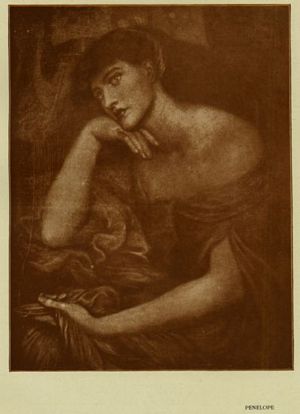
PENELOPE
Figure: Chalk. Nearly full-length of a woman turned partly to left, cheek
resting on right hand, sitting before a tapestry loom, holding a shuttle in her left
hand.Surtees, p. 121
to London, and that was the end of his
connection with the quiet Gloucestershire retreat, which thenceforward became
associated solely with the life of William Morris.
During the years 1869 to 1871, and the two following which Rossetti spent at
Kelmscott, he was at work on a number of fairly important new canvases in
addition to the retouching of old ones
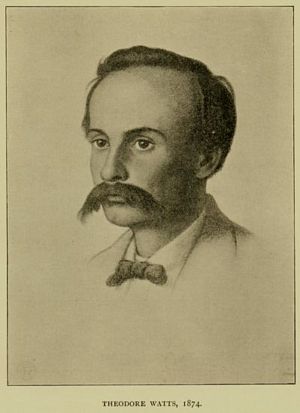
THEODORE WATTS, 1874.
Figure: Crayon. Head and shoulders turned slightly to the left; heavy
drooping moustache.Surtees, p. 199
which has already been referred to. A sprinkling of crayons and small
pictures also has to be mentioned. In 1869 he drew the
Rosa Triplex
, a study of three heads from one model;
Penelope
, a very fine crayon design belonging to Mr. Leathart, of Gateshead,
which is unique in the respect that it was done from a favourite model of Sir
Edward (then Mr.) Burne-Jones;
La Mandolinata
and a drawing in the possession of Mr. Constantine Ionides of
A girl holding her knees
, two typical subjects; a design for what would
have been a fine picture, the meeting
of
Orpheus and Eurydice
, from Virgil, now in the collection of Col. Gillum (though this may be
later), and the
first chalk study for
Pandora
.The last was formerly in Mr. Graham's
collection,
1 and now belongs to Mr. Charles Butler,
who also owns the oil picture.
The
Rosa Triplex
drawing of 1869 is one of four or five versions which exist, and is the
most certainly genuine one of them all. At least some critics are a little
doubtful of the others. This particular version, like the
Mary Magdalene
, was lost for many years, but finally reappeared in the possession of
Mr. J. J. Lowndes, who presented it to the National Gallery. It is now at
Millbank— though not, at the date of writing, included in the catalogue.
Another charming drawing of 1869 is the
portrait of Mrs.
[Stillman]
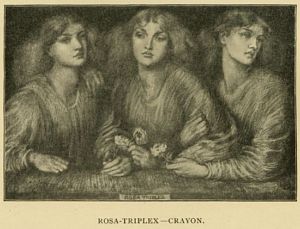
ROSA-TRIPLEX—CRAYON.
Figure: Chalk. Title lower center. Monogram and date lower right: "1867."
Three identical women, arms entwined, each holding a rose in her left
hand.
Stillman, in red chalk on greenish paper,
reproduced here. A
companion portrait of
Mr. Stillman was drawn in the following year.
Throughout the year 1870, with one or two exceptions, Mrs. Morris's is the face
which figures in Rossetti's work. In this year we have
La Donna della Fiamma
, a large crayon drawing of a lady, from whose outstretched hand there
issues a flame containing a little suppliant spirit figure. The drawing was
owned by the late Mr. Clarence E. Fry, and is still in the family. It was
unfor-
Transcribed Footnote (page 156):
1 There is a question, apparently, whether Mr.
Graham's crayon was the original study for the picture or a replica of
it made in the same year. Mr. Sandys has a story about it, which points
to the latter being the case; but as Rossetti himself circulated
photographs of this version, it must at least have satisfied him and
been his work. A
second drawing of the
same date certainly does exist, and was exhibited at the Burlington Fine
Arts Club in 1883 in the name of Mr. T. Eustace Smith, M. P. This is
described in the catalogue as the original.
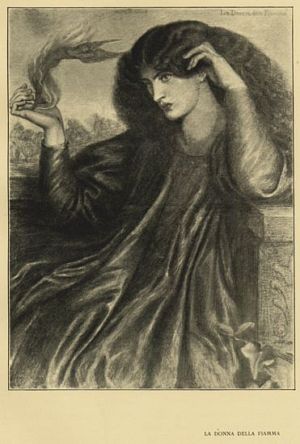
LA DONNA DELLA FIAMMA
Figure: Colored chalks. Title inscribed in top right corner, "DGR 1870"
inscribed lower right. Seated woman in a long flowing robe. The head is taken from Mrs. Morris; from her right hand
issues a winged figure in a flame of fire; on her left wrist is
a circular mark.Surtees, p. 122
tunately injured some little time ago by an
accident, and repaired by Mr. Shields.
La Donna della Fiamma
was no doubt intended as a study for a picture, as was an even finer
drawing called
Silence
, of which more than one version exists. Mr. W. M. Rossetti relates that
on his brother's return from Scotland in 1872, he thought of taking up the
picture of
Silence
, and was much disgusted to find that during his illness the more
finished study had been sold out of
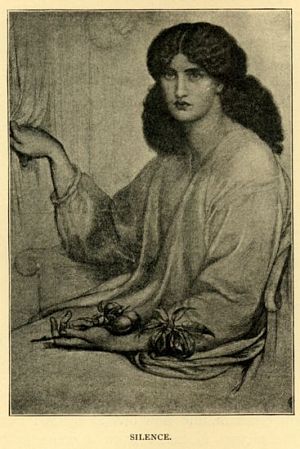
SILENCE.
Figure: Black and red chalk. The figure of Jane Morris holds in one hand a branch of peach. With the other hand she
draws together the veil enclosing the shrine in which she
sits.Surtees, p. 122
his studio. He insisted on buying it back, but did not begin the
picture, and the study was finally sold some time later to Mr. Charles Rowley,
of Manchester, by whom it was exhibited at Burlington House in 1883, and
afterwards published.
The Roseleaf
, dated 1870, is a graceful head of Mrs. Morris, named from a spray she
is holding. I have
reproduced it by permission of
Mr. W. M. Rossetti.
The Prisoner's Daughter
is, equally, a mere portrait, half-length, lying back, with a book or
paper in the hand, and supposed to illustrate a tale by Mr. Theodore
Watts-Dunton, to whom it belongs.
1 In addition to the drawings I have just mentioned, all
done from Mrs. Morris, are several less easy to name, including a series of
recumbent studies of which Lord Battersea has one (exhibited at the New Gallery
under the title of
The Couch
), and another, belonging to Mr. Watts-Dunton, is reproduced here. A
number were sold at Rossetti's sale in 1883.
A more important item of 1870, to be classed however with the work of 1868, is
Mariana
, an oil painting formerly in the possession
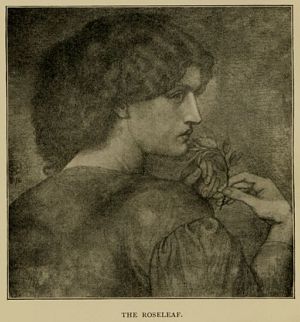
THE ROSELEAF.
Figure: Pencil. Monogram and date left center: "1870." Head and shoulders of Mrs. Morris turned to right, holding up
a spray of rose-leaf with her right hand and fingering it with
her left.Surtees, p. 122
of Mr. William Graham, and now owned by Mr. Francis Buxton. The title
of the picture is taken from a scene in “Measure for Measure,” and has no connection whatever with the
design done for Tennyson's “Mariana in the Moated Grange”.The picture was really begun at the same time as
the
portrait of Mrs. Morris now lent to the
Tate Gallery, but Rossetti put it aside at the time, and finished it off
later for Mr. William Graham, painting in a portrait of his son as the page
singing to the lute.
2 He then gave it the Shakespeare
Transcribed Footnote (page 158):
1 This must have been an afterthought, because
Rossetti's acquaintance with Mr. Watts-Dunton did not begin until two
years later than the execution of the drawing.
Transcribed Footnote (page 158):
2 Mr. Graham was very anxious to have a replica of
the portrait of Mrs. Morris, which Rossetti declined to paint. This
picture was done for him as a compromise.
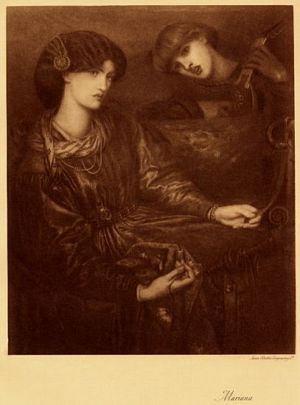
Mariana
Swan Electric Engraving Co.
Figure: Oil. Mrs. Morris, three-quarter-length, seated to right, holding a
sycamore branch across her knees.Surtees, p. 121 At upper right, a lute-player, head tilted to left.
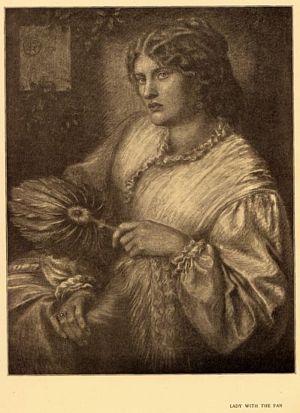
LADY WITH THE FAN
Figure: Crayons. Monogram and date inscribed on a scroll upper left: "1870."
Fanny Cornforth, three-quarter-length, seated turned to the
left, eyes looking to front, holding a feather fan in her left
hand; her right arm is extended across her body, the hand
resting on the chair-arm.Surtees, p. 123
name, and added to the frame the legend
from the page's song: “Take, O take those lips away.” It is said
that he had originally some idea of music in connection with the portrait, and
intended to put in a bird, to whose notes the lady should be listening—a theme
which he developed afterwards in
Veronica Veronese
. At any rate the picture, as a piece of painting, is nearly, though not
quite as fine as the
Tate Gallery portrait, which
it resembles in its main accessories (the rich blue gown, etc.), and in the
absence of the other is
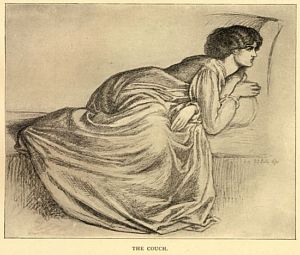
THE COUCH.
Figure: Pencil. Inscription at right: "27 July 1870." Whole-length on a sofa, crouched, leaning forward to the
right, the head in profile against the sofa arm. Her shoulders
and right hand are supported by a bolster; her left arm is drawn
up under her, only the hand is visible.Surtees, p. 177
well worthy of
reproduction amongst the
principal plates in this book.
The crayon drawing of a
Lady with a Fan
, which is reproduced here, interrupts, as will be noticed, the series of
studies drawn from Mrs. Morris. This is a portrait, and a remarkably fine one,
of Mrs. Schott, the model whose features were chosen for the
Lilith
and the
Blue Bower
. It has become familiar to the outside world through having been
published by the Autotype Company at a time when such publications were rarer
than they are at present. The drawing itself used to belong to Mr. Constantine
Ionides, but is now in the possession of
Mr. Fairfax Murray. It bears no relationship whatever, except in name, to
the
Monna Vanna
already described in Mr. Rae's collection.
Two studies of 1870, for
La Donna della Finestra
, one of Rossetti's favourite themes from the “Vita Nuova,” bring us back to the main current of his work at this time. The one
illustrated may be slightly the earlier of the
two. It will be seen by comparing it with the reproduction of the picture
painted in 1879 that there are strong differences, especially in the position of
the hands. A
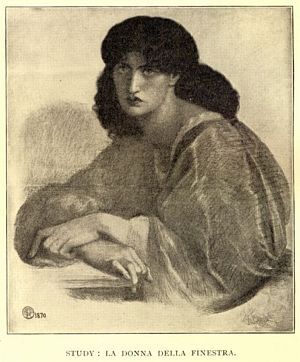
STUDY: LA DONNA DELLA FINESTRA.
Figure: Pastel on greenish paper. Monogram and date lower left corner:
"1870." Half-length of Jane Morris, turned to the left, head and eyes facing front, and hands
placed upon a ledge in front of her; the heavy dark hair,
fastened behind the ears lies outspread on the
shoulders.Surtees, p. 152
chalk replica of this was made in 1880. The
other
study resembles the picture more
exactly. It belonged to the late Mr. H. V. Tebbs, and is generally regarded as a
remarkably fine drawing. On a scroll below the figure it has the legend, “Color d'Amore e di Pietà Sembiante,” and like most of the drawings for the
Donna della Finestra
it bears a variant title,
The Lady of Pity
, which is apt to be misleading. It will be found under this name in the
catalogue of the Burlington House Exhibition of 1883, where it was numbered 337.
It is also described as “on panel,” an absurdity in the case of a crayon
drawing, meaning simply that it is on a panelled stretcher (see footnote to page 147).
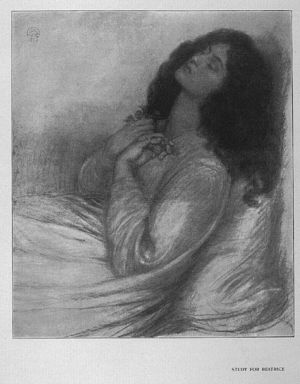
STUDY FOR BEATRICE
Figure: Monogram and date upper left: 1870. Study for Beatrice. Half-length to left; her eyes are closed;
hands folded on her breast; the heavy dark hair falls about her
shoulders.Surtees, p. 45 Assumed to be S81.R.1.F.
In the same year were made the first studies for Rossetti's great oil picture of
Dante's Dream
. These included a very lovely
head of the dead
Beatrice
, done from Mrs. Morris, and now in the possession of Mrs.
Coronio; a
head of Dante, in the possession of
Mrs. A. Ionides; and sundry studies for the two pall-bearing maidens, of whom
the one at the head of the bier was done from
Mrs.
Stillman
(
née Miss Marie Spartali) and the one at the foot I think from
Miss Wilding. I have seen it stated that Mr.
Forbes Robertson
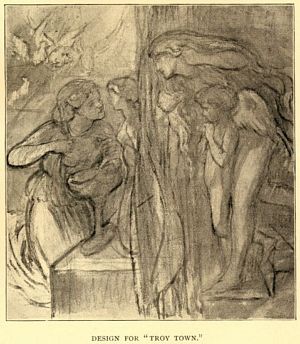
DESIGN FOR
TROY TOWN.
Figure: Black chalk and violet wash. Helen kneels at the altar of Venus offering her a double cup
moulded upon her own breasts. Venus and Cupid watch from behind
a curtain on the right.Surtees, p. 123
sat for the figure of Love, and that the Dante was drawn from Mr.
Stillman. The picture itself will come up for description under the year
following, 1871, and again to some extent in 1881. We may therefore leave it for
the present, and record the remaining items of 1870, which are a large pencil
drawing for
Mary Magdalene at the Door of Simon
, similar in composition to the pen-and-ink version of 1858, but lacking
the fawn and figures of the background; a crayon replica of
Beata Beatrix
, which belonged to Mr. Valpy; and two designs for pictures not
executed—
Troy Town
, after Rossetti's ballad, and
The Death of Lady Macbeth
.
In the former Helen is shown offering at
the shrine of Venus a double cup:
- “Saying ‘A little gift is mine,
- A little gift for a heart's desire.
- Hear me speak and make me a sign.
- It was moulded like my breast;
- (
O Troy Town!)
- He that sees it may not rest,
- Rest at all for his heart's desire.
- O give ear unto my behest!’ ”
Above the altar on which stands the image of the goddess, Venus
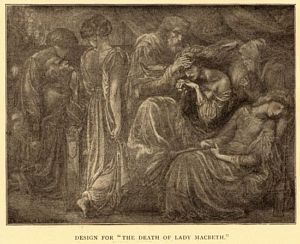
DESIGN FOR
THE DEATH OF LADY MACBETH.
Figure: Pencil. Title inscribed lower left. At center, Lady Macbeth sits up
in bed, leaning forward, rubbing her hands together. A bearded physician
to her left holds his hand to her forehead. To his left, a woman stares
at a kneeling priest folding his hands in prayer, looking up; beside him
is a young man staring at Lady Macbeth. At right an older woman watches
Lady Macbeth and a younger woman, seated with a fan in her hand,
sleeps.
and Cupid are seen peeping down from behind a veil at the lovely
suppliant, conspiring to answer her prayer that they would fire with love the
heart of Paris. I have reproduced this design here, by permission of its present
owner, the Hon. Percy Wyndham. The drawing for the
Death of Lady Macbeth
(or rather drawings, for the design exists in pen-and-ink as well as in
pencil) may possibly belong to a later date than 1870, but there is not much to
guide one in fixing it. It is a rather harrowing conception, as the illustration
shows—Lady Macbeth on her death-bed, sitting up, and with disordered mind
rubbing at the fancied blood-spots on her guilty hand.
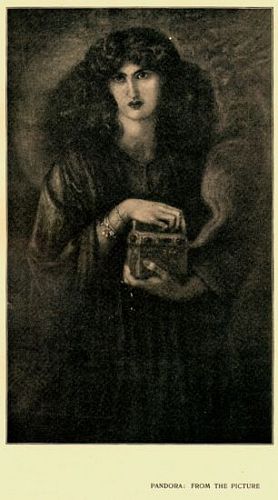
PANDORA: FROM THE PICTURE
Figure: Oil. With both hands she holds the fateful casket encrusted with
precious stones and inscribed: Nescitur
Ignescitur; from out of it issues an orange smoke
curling upwards round her head taking the shape of spirit forms.
The head is taken from Mrs. Morris.Surtees, p. 125
At the foot of the bed kneels a priest in
prayer, and behind him a youth swinging a censer. A physician bathes the
frenzied sufferer's head, and beside her couch are attendant ladies, one of whom
has fallen asleep with a fan in her hand.
The
crayon study for
Pandora
has already been mentioned, under date 1869, and in 1871 the
oil picture was painted. It was commissioned by Mr.
John Graham, of Skelmorlie, the uncle of Mr. William Graham, in 1870, and was to
be a three-quarter length figure. Before it was finished Rossetti conceived the
idea of making it into a full length, but this did not take effect, partly
because Mr. William Graham commissioned a
full-length
picture
for himself. The latter figures a good deal in the
correspondence of the next few years; so much so that Mr. W. M. Rossetti
catalogues it under the year 1875 as actually done. I have not, however, found
any confirmation of this, and there can be little doubt that it was
not done. Rossetti was not apt to be successful with full-length
figures, and this particular subject would hardly be attractive in that form. It
certainly never came into the possession of Mr. William Graham, or any other of
Rossetti's principal customers, and to the best of my knowledge it has never
appeared anywhere else.
The 1871 picture of
Pandora
is now in the possession of Mr. Charles Butler, of Connaught Place, and
is
reproduced here. The head, of course, is done
from Mrs. Morris. The figure is clad in a long robe of Venetian red, and is
holding the fateful casket, from which issues a red smoke, curling all round her
and forming behind into clustering shapes, like flame-winged seraph curses.
Pandora herself wears a look of distant brooding melancholy rather than of
surprise or grief. On the side of the casket is a spirit form, with the words “Nescitur Ignescitur,” and on the
frame, below the picture, is
the sonnet beginning:
- “What of the end, Pandora? Was it thine,
- The deed that set these fiery pinions free?”
The last six lines may be quoted as descriptive of the subject:
- “What of the end? These beat their wings at will,
- The ill-born things, the good things turned to ill,—
- Powers of the impassioned hours prohibited.
- Aye, clench the casket now! Whither they go
- Thou mayst not dare to think: nor canst thou know
- If Hope still pent there be alive or dead.”
Mr. Swinburne in his “Essays and Studies” praises this sonnet as the most perfect and exalted of all those done
by Rossetti for his
pictures, as the design itself is
“amongst the mightiest in its godlike terror and imperial trouble of
beauty.” This definite pronouncement, coupled with other winged
words of praise, from one who had the closest sympathy with Rossetti's work, and
a divine gift of appreciation for its best side, makes one shy of hazarding the
opinion
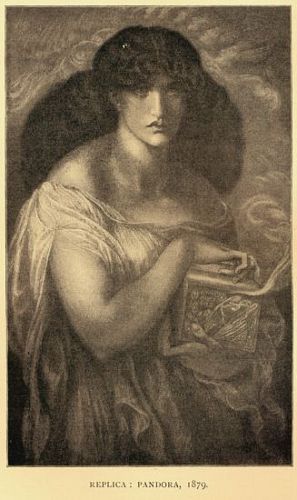
REPLICA: PANDORA, 1879.
Figure: Colored crayons. Later version of the painting. The features of Mrs. Morris
are exaggerated and almost grotesque. Three-quarter-length,
standing slightly to right, wearing grey-white draperies which
leave the massive shoulders and arm partly uncovered. In both
hands she holds the casket bearing the legend Ultima
Manet Spes, decorated with a splay of flowers and a
winged head turned in profile; from its nearly closed lid issues
a cloud of pink smoke which wreathes itself around Pandora's
heavy dark hair, forming a halo of winged heads.Surtees, p.126
that both in qualities of invention and depth of feeling
Pandora
is inferior to the companion great picture owned by Mr. Butler, the 1877
Proserpine
.
Water-willow
, a little quarter-length figure with a river landscape behind, formerly
in the possession of Mr. Turner, and now belonging to Mr. Samuel Bancroft in
America, is interesting from the fact that it is a very charming picture of Mrs.
Morris, and that the view behind is one of the old manor-house of Kelmscott on
the bank of the Thames. Mr. Murray owns the
study in
coloured chalks
, done in the same year as the oil, but with a
different background—merely a winding river without the house
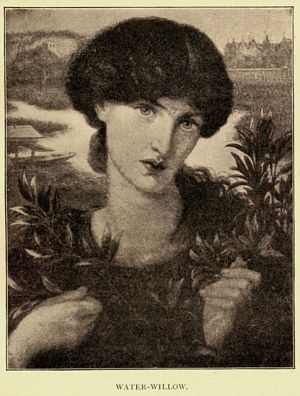
WATER-WILLOW.
Figure: Oil. Head and shoulders of Mrs. Morris holding branches of willow
in both hands. Behind her is the winding Thames, with Kelmscott
Manor on the left bank; on the right is a small country church
partly obscured by a tree and a punt moored by the
river-bank.Surtees, p. 127
or willows. A drawing called
Perlascura
, “the Dark Pearl,” is a crayon head of Mrs. Morris, done in this year,
and still in her own possession.
We now come to the picture of
Dante's Dream
, begun in 1870 and finished towards the close of 1871, Rossetti's most
important work in the opinion of many people, and considerably his largest. The
subject is that of the little early
water-colour
painted
for Miss Heaton in 1856, and is best described by the
following passage from the “
Vita Nuova”:
“A few days after this, my body became afflicted with a painful
infirmity, . . . and
I remember that on the ninth day
being overcome with intolerable pain, a thought came into my mind
concerning my lady. And weeping I said to myself: ‘Certainly it must
some time come to pass that the very gentle Beatrice will die?’ Then
feeling bewildered, I closed mine eyes; and my brain began to be in
travail as the brain of one frantic, and to have such imaginations as
here follow. . . . With that, while I wondered in my trance and was
filled with a grievous fear, I conceived that a certain friend came unto
me and said: ‘Hast thou not heard? She that was thine excellent lady has
been taken out of life.’ And I seemed to look towards Heaven, and to
behold a multitude of angels who were returning upwards, having before
them an exceedingly white cloud: and these angels were singing together
gloriously, and the words of their song were these: ‘
Osanna in Excelsis’: and there was no more that I heard. Then my heart that was so
full of love said unto me: ‘It is true that our lady lieth dead:” and it
seemed to me that I went to look upon the body wherein that blessed and
most noble spirit had its abiding place.”
The latter portion of the vision which Dante is narrating, and which so
powerfully affected his imagination, is best told in
the poem following the prose passage, as this contains the incident
of Love leading him, which is not in the other, and which the picture illustrates:
- “Then Love spoke thus: ‘Now all shall be made
clear:
- Come and behold our lady where she lies.’
- These idle phantasies
- Then carried me to see my lady dead:
- And standing at her head
- Her ladies put a white veil over her;
- And with her was such very humbleness
- That she appeared to say, ‘I am at peace.’ ”
In the picture we see a youthful grave-faced Dante led by the figure of Love up
to a bier whereon is laid the dead Beatrice, whom Love bends down to kiss. Two
beautiful maidens at the head and foot of the bier are lowering upon her a pall,
covered with symbolic flower-of-may, and the floor is strewn with poppies. An
oil-lamp just above the bier is flickering out, and through an open space in the
roof of the chamber can be dimly seen a flight of angel forms bearing upward
with them the white soul that has just departed. To the right and left of the
chamber are winding staircases looking out upon the sunny streets of Florence,
now deserted for grief, a scroll of parchment pinned to one of the rafters
containing the lamentation of Jeremiah:
Quomodo sedet sola civitas plena populo! Facta est
quasi vidua domina gentium.
Love is clad in the colour of flame, with a pilgrim's scallop upon his
shoulder, and birds of a consonant scarlet hue are flying in and out of the open
stairways, typifying that the house is filled with the spirit of love. The two
pall-bearing maidens are robed in green, and Dante in a sombre vesture of black,
with dull purple under-sleeves.
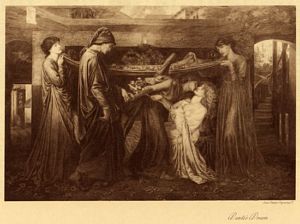
Dante's Dream
Swan Electric Engraving Co.
Figure: Oil. Within the chamber Dante is led forward by Love, the pilgrim
of the
Vita Nuova, wearing a scallop-shell on his shoulder. Two woman
attendants lower a pall strewn with symbolic blossoms of the
may-flower; red poppies of death cover the floor.Surtees, p. 42. In this replica DGR added two doves with crimson plumage, and the circular flight of
angels bearing away the soul of Beatrice (upper centre). On the
wall above the bier flickers a dying lamp; a scroll on the left
records thc lamentation of Jeremiah: Quomodo sedet solo
civitas.Surtees, p. 44
Impressive as
Dante's Dream
may be, and grand as its conception undoubtedly is, it is not to be
classed on
all grounds with Rossetti's finest work. The
execution is, moreover, not quite up to Rossetti's best level. Yet the picture
in many respects is strikingly fine, and has been the object of boundless
admiration. It has even been said that if no other of Rossetti's works survived
but this and the
Beata Beatrix
, they alone would be enough to insure him a place among the few great
artists of the world. In extenuation of any technical faults which the picture
may possess it should be stated that the physical strain of painting so large a
canvas was too much for Rossetti in his state of health at the time, and after
an exceptionally hard year. He overworked himself to an injurious extent in his
anxiety to cope with the difficulties and to make it as perfect as possible, and
this was no doubt largely the cause of his lamentable break-down during the year
following.
Dante's Dream
was commissioned by Mr. William Graham, but not on the very ample scale
that the artist finally chose for it. When it was delivered it was found, as the
purchaser previously expected, to be too large for his walls, and had to be
hung, much to its disadvantage, on a staircase. This perturbed Rossetti, who not
long afterwards asked to be allowed to take the picture back, and undertook to
paint in its place a
smaller version of the
subject.The large one remained in his studio, where
it was seen and greatly admired by Mr. Valpy, who in 1873, through Howell's
irresistible inducements, became its second purchaser, at the price of
fifteen hundred guineas.
1 Even this arrangement did not prove final, for in 1878 Mr.
Valpy retired from business as a solicitor in London and migrated to Bath, where
it was not convenient for him to install so large a picture. Besides, Rossetti
himself was anxious to prevent his masterpiece, as he then deemed it, from being
removed to a provincial town; he therefore offered once more to take it back and
to try to sell it to a new customer, engaging in this case not to refund the
money, but to paint a number of smaller pictures for Mr. Valpy up to or above
the original value. This was a decidedly good bargain in one way, for it enabled
him to receive payment for the picture
three times over; but,
on the other hand, the subsequent negotiations gave him a great deal of trouble
and worry, and I believe that at its third sale the picture did not realize more
than £1,000. The various transactions relating to this, and to
Transcribed Footnote (page 167):
1 Howell tried at one point to cancel this
negotiation, and to buy the picture himself for an unknown dealer, in
order that it might be engraved and published.
the pictures painted for Mr. Valpy in
return, will be recorded later on.
The
smaller replica that was commissioned by Mr.
Graham Rossetti entered into a special undertaking to paint himself; and by
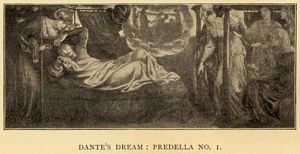
DANTE'S DREAM: PREDELLA NO. 1.
Figure: Black crayon on grey-green paper. Dante asleep in bed facing right,
attended by one woman at left, and four at right. In a cloud in the centre background is seen a shadowy
impression of the five-figured composition of
Dante's Dream. Surtees, p. 46
way of using up a difference of £300 in the prices of the two pictures
(for it was not his custom to return money if he could help it) he agreed to add
to it a pair of small predellas. These show, respectively,
Dante seeing the vision in trance upon his
couch
, and the
episode of certain anxious
ladies hurrying in alarmed at hearing him cry out
. Beneath them are
the following inscriptions:
(1) “Dante, being sick, and crying out in a dream of his lady's
death, is mourned over by his near kinswoman, whom other ladies lead
thence by reason of his grief, and awaken him.”
(2) “Dante recalling the incidents of his sorrowful dream,
recounts them to the ladies who have awakened him, whereto his
grieving kinswoman also hearkens apart.”
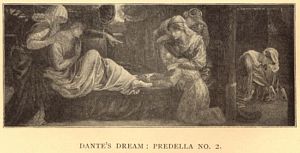
DANTE'S DREAM: PREDELLA NO. 2.
Figure: Crayon on grey-green paper. At center, Dante sits up in bed facing
right. At left, a woman leans over him touching his right shoulder,
while at right three other women listen at the foot of his bed. A fifth
woman sits hunched over at far right.
The second picture was not finished until 1880, when it came into Mr. Graham's
possession. It now belongs to Mr. William Imrie, the ship-owner. Liverpool thus
possesses at the present time both the large pictures of
Dante's Dream
.
In 1872, as has already been mentioned, Rossetti had a serious
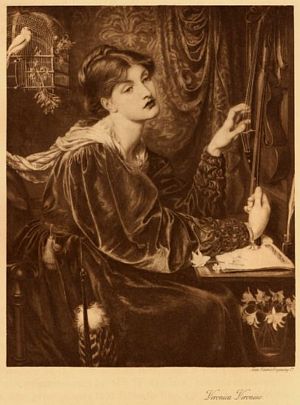
Veronica Veronese
Swan Electric Engraving Co.
Figure: Oil. Full length of a seated woman turned right, head tilted left.
She plucks the strings of a violin with her left hand, and holds the
violin bow upright in her right. She sits at a table on which lay a
musical score, inkwell, and a flower. A bird in a cage hangs upper
left.
illness, and spent some months in Scotland. On his return thence,
in the late autumn, he took up his residence at Kelmscott Manor, where most, if
not all, of the remaining pictures enumerated in this chapter were painted.
Shortly before his departure from Scotland, in September, he wrote to Madox
Brown that on settling down at Kelmscott he intended to do two pictures from
Mrs. Morris,
The Daydream
and a full-length
Pandora
, small life-size. For these heads had been drawn and were now in London,
and he was making studies for the background of the first (some hills seen
behind a sycamore tree) at Trowan. Either of these he proposed to offer to
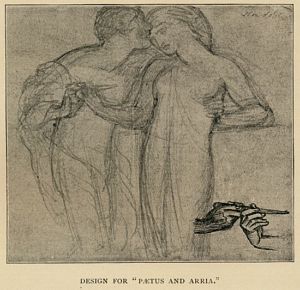
DESIGN FOR
PÆTUS AND ARRIA.
Figure: Pencil. A man and woman standing three-quarter-length; he kisses her
on the forehead while holding a dagger in his right hand which
she is showing him how to use. Lower right, a study for the two
hands holding the knife.Surtees, p. 130
Mr. Leathart for 1,000 guineas, the half-length
Pandora
having cost Mr. John Graham 750. At the same time he mentions a desire
to paint the tragic story of “
Pætus and Arria,” from Pliny, the Roman wife showing the husband how to commit suicide,
for which a
pencil design was made, and is
reproduced here. The full-length
Pandora
is the one already mentioned a few pages back as having been
commissioned by Mr. W. Graham, but not executed.
The next great picture that Rossetti took up (for the
Daydream
was not executed until considerably later) has a very complicated
history attached to it, and is without exception the most difficult puzzle in
connection with his artistic work. I refer to the
Proserpine
.
With the aid of copious abstracts of
Rossetti's correspondence, kindly placed at my disposal by his brother, I have
unravelled the main facts, which have never before been accurately stated. The
two important pictures of
Proserpine
, as we shall see later on, belong properly to the end of 1873 and 1874;
but the
study, now belonging to Mrs. Morris, was
made in 1871, and in 1872 the subject was begun upon canvas no fewer than four
times, the fourth picture finally being finished off and sold to Messrs. Parsons
and Howell. Whether or not it was entirely painted by Rossetti is impossible to
say; but Rossetti owned to it, although it was evidently a poor picture, and
after remaining unsold for two years was taken back by him from the original
purchaser. The three unfinished canvases of the same date were cut down and
converted into heads, one of which, with Mr. Murray's help, I have been able to
trace. It had the hands altered and some floral accessories added, and was named
Blanzifiore
or
Snowdrops
, by which title it is known and has been exhibited. This, at all events,
Mr. Murray regards as a creditable specimen of Rossetti's work, and it bears an
inscription in his own handwriting at the back. It belonged for some time to
Howell, having been sold to him, together with a
head of
Miss May Morris
, for £300. It is now in the possession of Mr.
Goldmann.
The rest of the story of
Proserpine
had better be deferred for consideration under the date usually
associated with the subject. In the meantime it is enough to say that the
painting of an
inferior picture by Rossetti in the first
instance (to say nothing of several inferior pictures) from one of his great
subjects, and of
superior pictures—for one can hardly call them
replicas—later on, is unique in the tangled annals of his work, and would appear
incredible if the documentary evidence were not conclusive. The only explanation
that can be offered is that Rossetti during these years at Kelmscott was
frequently ill, was badly in want of money, and his assistant may at times have
been more than usually active. Certainly much of his work done then, especially
in retouching, was deplorable.
An exception must be made, however, from this general assertion in the case of
the
Veronica Veronese
(finished in the year we are dealing with, 1872), against which no
complaint can be raised either on the ground of design or of execution. On the
contrary, this may be regarded as one of Rossetti's real successes, combining
beautiful colour and consummate grace without any trace of the
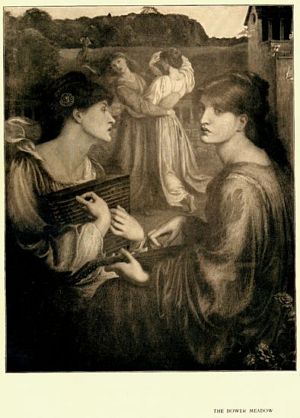
THE BOWER MEADOW
Figure: Oil. Two seated women play stringed instruments in the foreground,
while two women dance on a terrace in center background. A landscape
with a lone walking figure forms the upper background.
overstrained expression which mars, for
some people, the pictures painted in his later life. The subject of
Veronica Veronese
is supposed to be taken from the letters of Girolamo Ridolfi, which
describe how a lady, after listening to the notes of a bird, tries to commit
them to paper, and finally to reproduce them on her violin.The quotation,
1 which is inscribed on the frame, is as follows:
“
Se penchant vivement, la Veronica jeta les premières
notes sur la feuille vierge. Ensuite elle prit l'archet du
violon pour réaliser son réve; mais avant de décrocher
l'instrument suspendu, elle resta quelques instants immobile en
écoutant l'oiseau inspirateur, pendant que sa main gauche errait
sur les cordes cherchant le motif suprême encore eloigné.
C'était le mariage des voix de la nature et de l'âme—l'aube
d'une création mystique.
”
In the picture the Lady Veronica is robed in a rich gown of Rossetti's favourite
green, with yellow daffodils in a glass beside her. A feather fan is suspended
from her girdle. The bird, a canary, is perched on a cage above and behind her
head. She sits at a writing cabinet, on which is a sheet with the musical notes
she has been writing down; and listening with dreamy blue eyes to the bird's
song she lets her thumb wander over the strings of the violin suspended on the
wall before her. Had it been more known there is little doubt that this would
have been long since, as it is now becoming, one of Rossetti's most popular
pictures. It has been well reproduced and published by Mr. Caswall Smith, to
whom I am indebted for the
photograph used
here
.
Veronica Veronese
was one of the fine series of pictures painted for Mr. F. R. Leyland, at
a cost of 800 guineas, the price for which he mostly commissioned them. The
model for it was the beautiful Miss Wilding. At the Leyland sale it was acquired
by Messrs. Agnew, and is now, I am informed by them, in the possession of Mr. R.
Vaile.
Before leaving the year 1872 there is a minor but interesting episode to record.
In this year Rossetti took up once more the old background of trees and foliage
which he had painted in 1850, in his Pre-Raphaelite days, when studying with
Holman Hunt at Knole Park, near Sevenoaks. Nothing had ever been done to it
since; but now Rossetti, doubtless anxious to sell everything he could, painted
in two women playing instruments and a group of dancing figures, for which very
charming crayon studies were made, and called it
The Bower Meadow
. The first purchaser of this highly interesting combination of early and
late styles was Mr. John Miller,
Transcribed Footnote (page 171):
1 I understand that no such passage actually occurs
in Ridolfi's letters, and that it was probably composed to fit the idea.
Rossetti and Mr. Swinburne were both “great hands” at composition of
this kind, and either may have been responsible for it.
who parted with it some years later to a
dealer, from whom it was acquired at a high price by Mr. William Dunlop, of
Bingley, Yorkshire. Mr. Dunlop owns it still, and has allowed it to be
reproduced here for the first time.
La Ghirlandata
, the next great oil picture by Rossetti, is dated 1873, and is one of
those which has already crossed the Atlantic to the bourne whence works of art
but seldom return. It was bought at the Graham sale in 1886 by Mr. Ross, a
Scotch-Canadian, and is now in Montreal. The picture was painted from Miss
Wilding, at Kelmscott, and represents a lady playing upon a garlanded harp, in
the midst of a forest clearing, where angel faces peer down upon her rapt in
wonder of her music, and mystical blue birds cleave the air. Miss May Morris sat
for the two angelic faces. The whole is a subtle blending of subdued colour,
where blue and green strive for the mastery. Beautiful as it is in these
respects,
La Ghirlandata
, it must be admitted, lacks the invention and the interest of Rossetti's
more vigorous early work. It is an inspiration, a touch of poetry, no more. The
reproduction given here is not from the
picture itself, but from a
crayon drawing
published by the Autotype Company. This formerly belonged to Mr. James Worrall,
but has since been bought and sold by Messrs. Agnew.
A production of this year of relatively small importance in itself, though it may
have served as a preliminary study for the
Sea Spell
, was
Ligeia Siren
, a crayon drawing of a naked sea-maiden (afterwards, I believe, draped)
playing upon an extraordinary kind of lute. This was described by Rossetti
himself, in a letter, as “quite an elaborate picture,” although only in
chalk, and “certainly one of my best things.” It may be remarked
here as an interesting trait that Rossetti always regarded the picture or design
on which for the moment he happened to be engaged as his finest work. When he
passed on to something else it ceased to occupy this paramount place in his
affections, and underwent the criticism that he seemed at first afraid of
applying to it.
Ligeia Siren
, for all that, is a highly finished work, fully worth the price (£210)
put upon it by Rossetti. It was for some time in the possession of Mr.
Constantine Ionides.
The story of
Proserpine
has already been told in part, and may now be concluded. The
picture sold to Messrs. Howell and Parsons, an
inferior one, as has been said, was seen by Mr. Leyland in July, 1873, and
offered to him for 800 guineas. On hearing, however, that Rossetti was engaged
upon “a very superior
duplicate,” at a higher
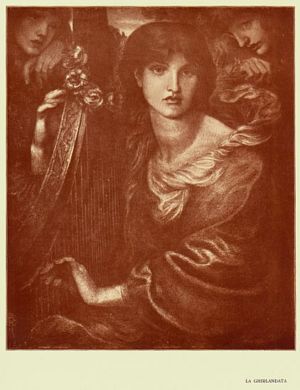
LA GHIRLANDATA
Figure: Colored chalks. Monogram and date lower left corner: "1873." A
woman plays a garlanded harp, while two youths peer down from upper left
and upper right corners, each one resting a chin on a hand.
price, he decided to take that instead.
The
new picture was practically completed
by the beginning of October, when, as Rossetti wrote to Madox Brown, he found
that in lining the face had become rucked. Determined that the picture should be
his best, he accordingly set to and painted
another. A month later he writes that the
faultily-lined picture had been put right and
made “so completely of his best work” that he had decided after
all to send it to Mr. Leyland.This arrangement was upset
at the last moment by the accident that in course of transit to Kelmscott,
after being re-lined, the picture went astray—also, perhaps, Rossetti had
again changed his intention; at any rate, it was the
picture No. 2 (the
sixth, if we reckon the
four canvases of 1872) that was consigned to Mr. Leyland in December, 1873,
and which crowned a long series of catastrophes by arriving in a damaged
condition with the glass broken.
1 On receiving it back for repair Rossetti first decided
that he could do nothing. Accordingly he set to work and painted a fresh one
still—
No. 3. What eventually became of
the
picture that had been re-lined there
is nothing to show, but it seems certain that this was not the one finished up
to replace the damaged picture. The latter remained in Rossetti's studio until
1877, when on re-examining it he found that the head and hands were intact. He
accordingly had these cut out and inlaid on to a new canvas, and then painted
the background and drapery afresh. At the same time he rather misleadingly
re-dated the
picture, which was bought by Mr.
Turner.
The upshot of the whole transaction is that two large
Proserpine
s exist (not to reckon a possible third), of which the inscriptions and
dates run as follows:
“Dante Gabriele Rossetti ritrasse nel capo d'anno
del 1874”
“Dante Gabriele Rossetti ritrasse nel capo d'anno
del 1877”
and of these the second is the earlier in its main features, having
been completed in 1873. As to their comparative merits, the latter is also the
more generally esteemed, on account of its severer and grander type of face; but
the repainted portions show signs of hasty work.
Transcribed Footnote (page 173):
1 It can hardly be wondered at, after so many
misfortunes, that Rossetti thought the subject an unlucky one. Summing
up the casualties in a letter to Madox Brown he says, “the
Proserpine
was begun on seven different canvases, to say nothing of
drawings. Three were rejected after being brought well forward; the
fourth is now with Parsons,
and will shortly come back on my hands; the
fifth has twice had the glass
smashed and renewed; the
sixth has had
the frame smashed twice and the glass once. It was nearly spoilt in
transferring to a fresh strainer, and is now (referring to its
arrival in Liverpool) almost destroyed.”
This is the picture I have selected for
reproduction, though both were available for
the purpose, and there is not a great deal to choose between them. The
“1874”
version has been published by Mr.
Caswall Smith, who photographed all the Leyland pictures, and the “1877”
version by the Autotype Company, to whom I am
indebted for the use of the subject. The latter, which is generally known as the
Turner picture, is now in the possession of
Mr. Charles Butler, of Connaught Place, whilst the former, the
Leyland picture, belongs to Mr. Graham
Robertson.
In addition to the three main canvases of
Proserpine
just mentioned, and the earlier, less important
one of 1872, which was probably cut up or destroyed, I find some
record of a
water-colour replica done about
1880, or at any rate in the possession at that time of Mr. James H. Hutton. A
small oil replica was included amongst the
pictures turned out for Mr. L. R. Valpy in return for the
Dante's Dream
. This, with a replica of
Joan of Arc
, was one of the very last pictures that Rossetti worked on, being
finished shortly before his death in 1882. It was begun, or in hand, at Keswick,
in September, 1881. A
crayon replica which used
to belong to Mr. Graham is in the possession of Mrs. Horner. There may be others
also of which no record has been kept.
In all these pictures of
Proserpine
the subject is the same. The ravished bride of Pluto is seen standing in
a corridor of the hall of Hades, illuminated with a bluish subterranean light,
due to one stray moonbeam from on high. In none of the other pictures done from
Mrs. Morris do we find so appropriate the distant air of brooding melancholy
with which the painter contrived to invest her features. The Queen of the Lower
Regions, for all her magnificent beauty, is eating her heart out for thoughts of
that girl life in the flower meads of Sicily whence she was snatched away, and
holds in her hand, pensively, the pomegranate of which she ate one fatal seed
that binds her for ever to her destiny.
The following, with an Italian equivalent also, is the
sonnet which Rossetti wrote for
Proserpine
:
- “Afar away the light that brings cold cheer
- Unto this wall,—one instant and no more
- Admitted at my distant palace door.
- Afar the flowers of Enna from this drear
- Dire fruit, which, tasted once, must thrall me here.
- Afar those skies from this Tartarean grey
- That chills me: and afar, how far away,
- The nights that shall be from the days that were.
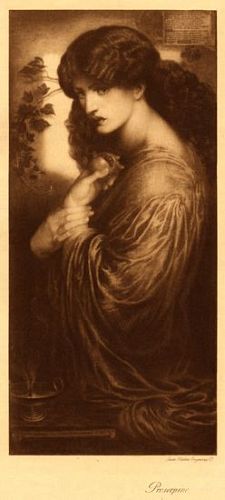
Proserpine
Swan Electric Engraving Co.
Figure: Oil. Signature and date on a scroll lower left: Dante
Gabriele Rossetti ritrasse nel capo d'anno del 1877.
The artist's sonnet in Italian is inscribed on a label attached
to an ivy spray, upper right.Surtees, p. 131. Half length of a woman turned left, holding a half-eated
pomegranate in her left hand, her right hand clasping her left wrist. A
incense-burner lies on a ledge at lower left.
- Afar from mine own self I seem, and wing
- Strange ways in thought, and listen for a sign:
- And still some heart unto some soul doth pine,
- (Whose sounds mine inner sense is fain to bring,
- Continually together murmuring,)—
- “Woe's me for thee, unhappy Proserpine!”
Before closing the record of work executed in 1873, which has been carried beyond
the limits of the year by the history of the
Proserpine
pictures, it may be mentioned that Rossetti executed at this time one or
more crayon studies for another great picture which was not painted until some
years later—
The Blessed Damozel
, illustrating the subject of his early
poem. The finer of these studies was acquired by Mr. Leyland, who
exhibited it at Burlington House in 1883. An earlier, but less finished
crayon came into the possession of Mr. Graham, and
was sold with his collection in 1886. This now belongs to Mr. Gray Hill, of
Birkenhead. The picture will be further described with its antecedents under
1877.
The Damsel of the Sanc Grael
, painted in 1874 for Mr. Rae, is a very different picture from the
little
water-colour of 1856-7. There was a
delightful simplicity and primitiveness about the latter which accorded as well
as anything could with the mediæval sanctity surrounding the subject. When
Rossetti came to paint the picture again in his later manner, he represented the
austere damsel of the holy mysteries as a handsome girl with flowing chestnut
hair, bright lips, and languishing eyes, sumptuously robed in a red gown with a
heavily-flowered mantle. Raising one hand in a dainty attitude of admonition,
she holds in the other a modern communion chalice, of form certainly less
appropriate than the long-stemmed antique cup held by her predecessor. Even the
sacred dove, poised above and bearing a golden censer in its beak, affects a
graceful pose in harmony with its handmaid. The frame bears a quotation from the
“Morte Darthur”:
“And there came a dove, and in her bill a little censer of gold, and
therewithal there was such a savour as if all the spices of the world had
been there. So there came a damozel passing fair and young, and she bore a
vessel of gold between her hands.”
In painting this picture Rossetti probably did not seek much beyond mere beauty
of form and decoration, in the attainment of which he has succeeded perfectly;
and the same may be said in part of a better-known production of the same year,
the much-praised
Roman Widow
. This, also called
Dis Manibus
from the inscription, represents a Roman lady seated by the marble tomb
of her
Editorial Note (page ornament): On page 176, in the final line of the tombstone inscription,
Marillier prints a formee cross between the phrase "Ave Domine" and
"Vale Domine".
husband, playing a dirge upon two citherns, and fulfilling the
appointed mourning rites. Upon the tomb are carved the words:
- “Dis Manibus
- L. Aelio Aquino
- Marito carissimo
- Papiria gemina
- Fecit
- Ave Domine † Vale Domine.”
The widow is clad in funereal grey, with a soft white veil trailed as
Rossetti loved to trail it, the colour being given by the greenish tint of the
marbles, the tortoiseshell harp, and the wreath of wild roses which crown it.
The model for the face is said to have been Miss Wilding, but I think Mr.
William Rossetti must be right in suggesting that it was also inspired by Mrs.
Stillman, the original of
Fiammetta
. The effect is perhaps weakened by a tendency towards the overstrained
and exaggerated expression of features mentioned previously. Rossetti, however,
admired it, and especially describes in a letter to a friend the “fair
luminous colour seeming to melt into the gold frame like a part of it.” He
adds, “I fear the picture is too severe and tragic for his taste (Mr.
Leyland's, by whom it was commissioned): I don't think Géricault or Regnault
would have quite scorned it.” The present owner of the
Roman Widow
is Mr. Thomas Brocklebank, of Chester.
For convenience of division, and in order to begin the next chapter with pictures
dated 1875, I have been including amongst the work done at Kelmscott everything
belonging to the previous year, without, however, wishing to assume that all of
it was finished there. On this understanding the next three items are also given
here, although from their nature they rather suggest a break in the continuity.
The first is the large unfinished canvas, painted simply in grisaille, called
The Boat of Love
, which was begun for Mr. Graham, but abandoned in 1881 owing to a
disagreement about terms. The subject is taken from a very
well-known sonnet of Dante addressed to
Guido Cavalcanti, beginning,Guido vorrei che tu e Lapo
ed io, translated as follows in the “Early
Italian Poets”:
- “Guido, I would that Lapo, thou, and I
- Could be by spells conveyed, as it were now,
- Upon a barque, with all the winds that blow
- Across all seas at our good will to hie.
- So no mischance nor temper of the sky
- Should mar our course with spite or cruel slip;
- But we, observing old companionship,
- To be companions still should long thereby.
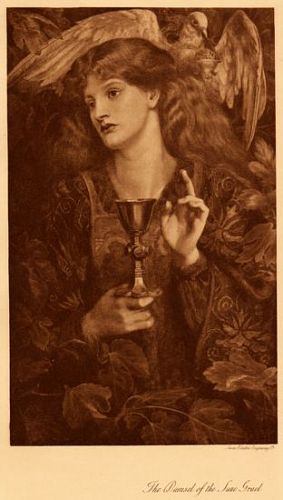
The Damsel of the Sanc Grael
Swan Electric Engraving Co.
Figure: Oil. Monogram and date lower right corner: "1874." Half-length figure framed by vine leaves, holding a gold
Chalice in her right hand; her left is raised in benediction.
The Holy Dove bearing in its beak a censer hovers above her head
which is turned three-quarters to left. The head is taken from
Alexa z Wilding.Surtees, p. 51
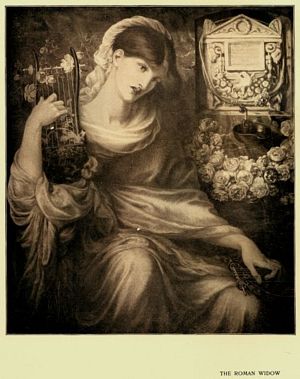
THE ROMAN WIDOW
Figure: Oil. Full length of a seated woman, head tilted right, playing two
harps, one in her right arm and one on her left knee. An urn sits in a
niche on the wall wreathed with roses: the urn is inscribed: "Dîs
Manibus L. Aelio Aquino Marito Carissimo Papiria Gemina Fecit Ave Domine
Vale Domine."
- And Lady Joan, and Lady Beatrice,
- And her the thirtieth on my roll, with us
- Should our good wizard set, o'er seas to move,
- And not to talk of anything but love,
- And they three ever to be well at ease
- As we should be, I think, if this were thus.”
The idea for the picture was one of Rossetti's very early ones, when he was first
under the Dante spell, and he began a small
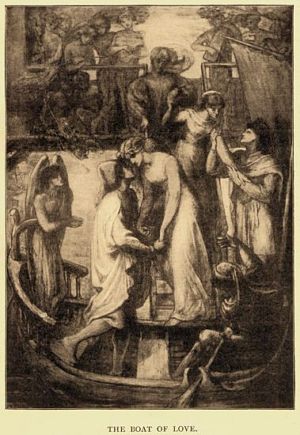
THE BOAT OF LOVE.
Figure: Oil (monochrome). Inscribed upper left: "Guido vorrei che tu e Lapo
ed io." Dante holds Beatrice by both hands and gazes up into her
face; behind them Cavalcanti supports Giovanna by the arm. Degli
Uberti is seated at the oars, while at the prow Love stands
ready to guide the boat.Surtees, p. 137. Numerous figures stand on the dock in upper background.
water-colour of it about 1855. The picture was
commissioned ten years before the date we are now dealing with by Mr. Dunlop.
Subsequently, in 1867, Mr. Craven desired to have a
water-colour of it, but the subject still remained unexecuted when
Mr. Leyland commissioned it once more in
1873 on a
large scale
, and Mr. Graham simultaneously on a
smaller one. The unfinished picture, which was
bought at Rossetti's sale in 1883 for the Birmingham Corpora-
tion Art Gallery, seems to have been the
Graham one, abandoned for reasons of the kind indicated above.
The water-colour copy of
Rosa Triplex
, done from Miss May Morris, and so described by Rossetti in a letter to
his mother, is dated this year. It has been exhibited as recently as 1892 at the
Guildhall, and is now in the possession of Mr. Graham Robertson. The original
purchaser was Mr. Craven. A
first study in oil, or
perhaps a rejected canvas of the central figure in
The Blessed Damozel
, was painted in 1874, and afterwards presented to Lord Mount Temple by
Rossetti. This has a gold background in lieu of the accessories, the maiden
having however the stars in her hair and the lily laid along her arm. It is
sometimes called
Sancta Lilias
, a name which is also appropriated to
another
drawing
, done in 1879, of a different subject, which will be
found
reproduced in the text—perhaps
unnecessarily, as it has long been well known in the form of a supplement to a
number of the “
Portfolio.”
One more subject dated 1874 I have purposely kept to the end, because it at least
is intimately bound up with Kelmscott. This is an oil picture called by a large
variety of names—
Marigolds
,
Fleurs de Marie
,
The Bower Maiden
, and
The Gardener's Daughter
, but representing in actual fact a young girl standing in a room, and
reaching up to place a mass of yellow marigolds and lilies in a flower vase upon
a high cabinet of inlaid wood. She wears a blue gown with green apron, and round
her head a close-fitting cap or hood of dark green velvet. The model is said to
have been the gardener's daughter at Kelmscott, a girl who occasionally helped
in the house— not that the detail signifies, except as connecting the picture
with the place. It is a graceful and pretty little piece of work, declined
(perhaps on the score of price) by Mr. Leyland, and purchased for £825 by Mr.
William Graham. After the latter's death it was sold with the rest of his
collection, the present owner being Lord Davey.
ONE of the first incidents to be recorded after Rossetti's
return to London in 1874 was the dissolution of the partnership of Morris,
Marshall, Faulkner and Co., and the re-construction of the firm under the sole
management of William Morris. The principal partners besides Morris, as has
already been mentioned, were Burne-Jones, Rossetti, Madox Brown, Marshall, Webb,
and Faulkner. Brown already cherished a slight grievance that he had not been
fairly treated in respect of the commissions for designing windows; and this,
coupled with some expectations that his partnership would eventually become
profitable, made him extremely averse from entertaining the project of
dissolution. On the other hand, Morris had made all the sacrifices for the firm,
had sold his pictures and spent his capital for it, organized it, given up his
time, and even abandoned the house he had built in order to promote its
interests the better. It was natural that he should resent opposition to what he
must have regarded as his legitimate reward, especially as he proposed to
compensate the more ornamental partners with a money payment based upon
valuation of the goodwill. The dissolution was effected, but not without
unpleasantness, resulting in the estrangement of Morris and Brown. Rossetti also
seems to have become involved on Brown's side, although from his brother's
account, based upon existing letters, he did his best to play a conciliatory
part. Mr. Mackail's version of the transaction is said by some who were closely
involved in it not to be entirely fair to Rossetti, who might have urged, if he
had chosen to do so, that his name was one of the best assets that the firm
started with, Morris being then comparatively unknown. Mr. Theodore Watts was
employed on Madox Brown's behalf, and possibly on Rossetti's as well, to see the
negotiations through; and this he did with success, though a breach, as said,
unfortunately resulted in the personal friendship of some of
the leading men concerned. Morris and
Rossetti never actually quarrelled; but from 1874 onwards the two men seldom saw
each other, Rossetti's recluse habits of life being possibly responsible to some
extent for the severance. It was one of the many strange results of the chloral
he had taken that at this time and onwards he never was free from the delusion
of a widespread conspiracy existing against him. He gave up going out by day,
and all his exercise consisted in driving with a friend at night to some
secluded spot in Regent's Park, where he took a walk and then returned in the
same fashion.
The latter part of 1875 and the first half of 1876 Rossetti spent in a hired
house at Bognor, and after that he visited the Cowper-Temples (afterwards Lord
and Lady Mount Temple) at Broadlands in Hampshire, being then engaged upon his
picture of
The Blessed Damozel
. It was as a momento of this occasion that the fine
oil study of the central figure, mentioned in the
previous chapter, was presented to Lord Mount Temple. While he was away from
home, Rossetti had the party wall between his studio and the next house padded
and built up to double thickness, it being one of his fancies that objectionable
noises were made by the neighbours for the purpose of annoying him. After his
return, however, his health was better, and he made the experiment for a short
time of employing a mesmerist to put him to sleep in place of the noxious drug
which had taken such hold upon his nerves.
In 1877 he had a very severe physical illness, due to the uræmic affection which
had been set up in 1872, and which eventually was the active cause of his death.
The crisis called for an operation, very promptly performed by his attentive
friend, Mr. John Marshall, the surgeon; but for two months following Rossetti
was confined to bed, before he could be removed to a little cottage at Hunter's
Forestal, near Herne Bay, where the members of his family in turn attended him.
So much prostrated was he that he seriously gave up all hope of resuming his
profession. “At last,” says Mr. William Rossetti, “the power and the
determination returned simultaneously; he drew an admirable
crayon-group (head and shoulders) of our mother
and sister, two others equally good of the latter, and yet
another of our mother. Weather had been
favourable, spirits and energy revived, and he came back to town nerved once
more for the battle of life and of art.” Of the portraits mentioned
in this passage, the group of Mrs. and Miss Rossetti is now in the National
Portrait Gallery, and is
reproduced here. Mr.
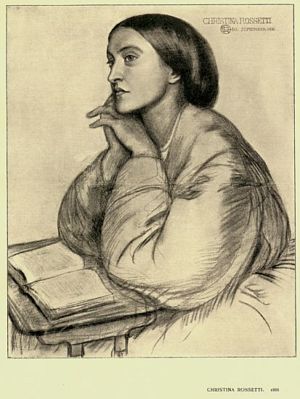
CHRISTINA ROSSETTI. 1866
Figure: Colored chalks on blue-grey paper. Monogram and inscription upper
right: "CHRISTINA ROSSETTI del. SEPTEMBER 1866." Over half-length turned to left, seated at a table leaning
her chin on folded hands; the head is nearly in profile; a book
lies open before her.Surtees, p. 184.
Fairfax Murray has acquired the
single one of Mrs. Rossetti, probably the last ever
done, which at the time was given to Miss Charlotte Polidori, and the two heads
of Christina Rossetti still belong to her brother.
[head
1]
[head 2] They are in black crayon with touches of
colour, the faces being coloured, and show the poetess as she is best
remembered, with a sad and aged expression and features worn by illness. In her
young days she was beautiful, with a delicate, demure, oval face and steady grey
eyes, typical of the Madonna for
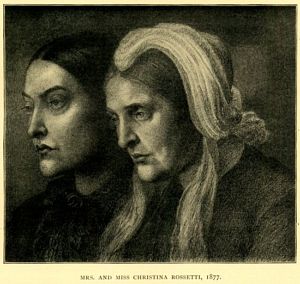
MRS. AND MISS CHRISTINA ROSSETTI, 1877.
Figure: Colored chalks. Head and shoulders, both nearly in profile to left; Christina
is on the far side of her mother.Surtees, p. 185.
whom she sat to Rossetti. Two very pretty pictures of her are a little
oil head of 1848 belonging to Mr. William
Rossetti, and a
pencil drawing of about the same
date also formerly in his possession.
In 1877 the Grosvenor Gallery was started, and overtures were made to Madox
Brown, Rossetti, and Burne-Jones to become exhibitors. The first two refused,
after much deliberation; but the third-named accepted the invitation, and
rapidly acquired his enormous popularity through the medium of the new annual
exhibitions, of which for many years his pictures were the mainstay. Rossetti's
refusal was explained in his reply as due to a conscious-
ness that his attainments were not equal to
his efforts—alas, whose are?—and he wrote a letter to the “Times” as well, disposing of some criticism on the same grounds. To these we
may add that he was still haunted with a fear that malicious critics were lying
in wait to fall upon his work and rend it. His painting was not free from
defects, as he was well aware, which would render this easy enough; but where
his modesty or his exclusiveness did him ill-service was in blinding him to the
fact that since his fiasco in 1850, which had turned him against exhibitions, he
himself had acquired a broader and more popular style, and a public had grown up
round him with taste and education enough to appreciate the poetic beauty of his
conceptions. Had he accepted in 1877 the invitation to exhibit, it is quite
possible that his pictures would have been more popular and more widely admired
even than those of Burne-Jones, which for all their delicate sentiment and
decorative charm are less robust and fine in colour, and are even displeasing to
a certain number of people on that account. The wave of admiration which
followed the great double exhibition of Rossetti's work in 1883, after his
death, when almost every picture and drawing of importance was collected on the
walls of the Royal Academy and the Burlington Fine Arts Club, showed
conclusively what might have been expected if Rossetti had consented to let his
works be known more widely in his own lifetime. It has been hinted that in
persistently refusing to exhibit Rossetti was actuated by some idea of personal
advertisement. To suggest that any artifice connected with the sale of pictures
was unknown to him would be wronging Rossetti's extraordinary business capacity;
but I find no trace of any
arrière pensée of this kind which could warrant the insinuation referred to. It is far
more likely, as his brother says once or twice, that he had in his mind an idea
of some day collecting the best of his works himself and exhibiting them in
their proper relationship. This intention was enough to warrant him in refusing
to exhibit beforehand, but he did not live long enough to carry it out.
The departure to Herne Bay, and I suppose the general dislocation of Rossetti's
financial affairs which usually ensued on an illness were responsible for an
unfortunate breach with Madox Brown, resulting as such things mostly do out of a
perfectly trivial circumstance. The story is too long to go into, and not very
edifying, but it had something to do with an attempt on Brown's part to get
Rossetti to cut down expenses by dismissing two servants; and on Rossetti's
refusing to do so, Brown imagined himself slighted, and
actually avoided the house for two years.
So pettish can even great men be.
After 1877 Rossetti seldom if ever went beyond the doors of No. 16, Cheyne Walk,
and as he suffered from continual fits of melancholy, and disliked being alone,
a few still faithful friends formed the practice of coming to visit him by turns
once a week. Mr. Theodore Watts was a far more constant attendant, and had a bed
at his disposal, as “evenings” with Rossetti tended to break up about four or
five in the morning. A good number of acquaintances
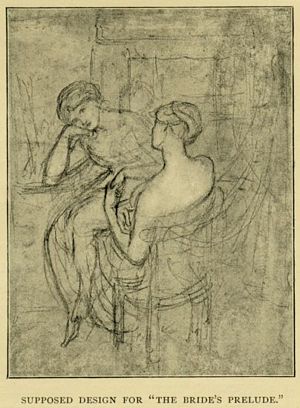
SUPPOSED DESIGN FOR THE BRIDE'S
PRELUDE.
Figure: Pencil. Slight sketch of two women seated. One, back view with naked
shoulders, the other turned to the left supporting her head with
her right hand.Surtees, p. 124.
also frequented the house, some of them much more intimate than others
and dating back in their relations to about 1866. Among these may be mentioned
the artists J. M. Whistler and Alphonse Legros, Frederick Shields, F. A. Sandys
and Fairfax Murray, Mr. Joseph Knight and Mr. William Sharp, Dr. Gordon Hake and
his son George Hake, who for a time acted as Rossetti's secretary, the Hueffers,
and others. The unfailing devotion of these later friends, most of whom were
only too willing to make sacrifices for the man from whose genius they derived
so much pleasure, may have induced Bell Scott's ill-natured sneer that
“none but new men were now to be seen about him.”
In 1878, or thereabouts, Rossetti's devotion to poetry received a fresh impulse,
and he set himself assiduously to the production of sonnets. It was not until
1880, however, that he began really to compile materials for a new volume. In
that year he wrote
“The White Ship”, and in the year following a second ballad. Of the latter he remarked to
a correspondent: “I am writing a ballad on the death of James I. of
Scots. It is already twice the length of
“The White Ship”, and has a good slice still to come. It is called
“The King's Tragedy”, and is a ripper, I can tell you!” The third
ballad of
“Rose Mary” was already in hand. Finally, by March of 1881 the copy for
Ballads and Sonnets
was complete, and was accepted by Messrs. Ellis and White on the same
handsome terms as the first book. The latter, after going through some six
editions was now out of print, and Rossetti determined to alter it somewhat
before republication. He had taken out of it the incomplete sequence of sonnets
called
“The House of Life”, and transferred this in its completed form to the second book. By way
of filling up the gap his long unfinished early poem of
“Bridechamber Talk”— re-christened
“The Bride's Prelude”—was at length allowed to appear.
Poems
of 1881 is thus a totally different compilation from the editions of
1870 and onwards.
The “
Ballads and Sonnets “ were quite as marked a success as the earlier volume had been, and no
jarring note of criticism broke this time upon Rossetti's sensitive ear. But the
time was passed for him to feel either acute pleasure or acute pain. Profound
melancholy had settled down over his once exuberant nature, and even the fact
that the year was rendered doubly successful by the sale of his great
Dante's Dream
picture to the Corporation of Liverpool could not arouse more than
momentary exhilaration.
The last stages in the history of this picture may as well be told here. After
the departure from London of Mr. Valpy, on whom it had rather been forced by
Howell, Rossetti took it back into his studio with the intention of finding
another purchaser. His agreement with Mr. Valpy was that
on doing this he would make up the equivalent value, or something more, in
smaller and more manageable pictures.
1 A
friendly influence on the council of the Walker Art Gallery, in the person of
Alderman Samuelson, combined with a suggestion from one of Rossetti's
acquaintances, led to an offer being made, and after protracted negotiations,
and some opposition from a section of the Liverpool Corporation, the bargain was
finally struck. The picture was allowed to appear first in the annual
Transcribed Footnote (page 184):
1 As this Valpy transaction is complicated it may be
as well to give here some brief particulars in regard to it. Rossetti's
first stable offer, as compensation for the purchase money, £1,575,
included balance due on a
replica of
Beata Beatrix
£340, replica of
Sea-Spell
£735, reduced
Proserpine
in water-colour £420, and cash £500—making a total of £1,995,
which was to be reduced to £1,645 by the return of other works. In place
of the £500 a replica of some 800 guinea picture was offered, or, later
on,an original picture, to be called
Gretchen
or
Risen at Dawn
. Mr. Leyland objecting to a full-sized replica
of
Sea-Spell
, an oil
Joan of Arc
was added to the list, and was the very last picture that
Rossetti painted on. The
Sea-Spell
replica and
Risen at Dawn
did not progress far towards completion, and at Rossetti's death
a considerable sum remained due to Mr. Valpy, which was defrayed by the
executors out of the proceeds of his estate.
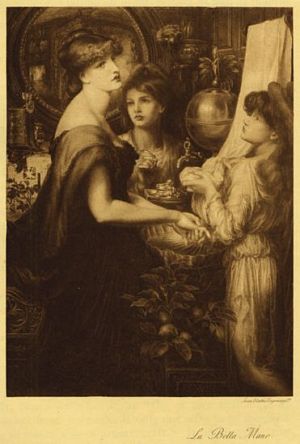
La Bella Mano
Swan Electric Engraving Co.
Figure: Oil. A woman facing right washes her hands in a basin. At right, an
attendant girl hands her the end of a towel which hangs from the wall,
and another attendant holds a bracelet in her right hand. A circular
mirror hangs upper right, and a potted flowering plant sits below the
basin, lower center.
exhibition at Liverpool, on the condition that it was to be
regarded as already sold, and on this understanding Rossetti repainted the hair
of the dead Beatrice, making it light instead of dark. As he preferred it so one
would perhaps be rash to question the wisdom of the change, but there are many
signs that towards the close of his life Rossetti's magnificent colour sense
began to deteriorate, and some of his last pictures show a falling off in this
respect as well as in form and drawing. A good deal of the exaggeration of necks
and lips which are such a stumbling-block to ordinary people dates from this
later period and may be attributed to the failure of his eyesight as well as to
a gradually growing morbidity of temperament. That it should have come to be
regarded as the distinguishing feature of his work only proves how very little
his pictures were known, and how unfortunate from the point of view of fame was
his decision never to exhibit. The heavy-lipped faces have no part at all in
seven-eighths of his work, as this monograph ought conclusively to show; and if
it happened to be the remaining eighth which became known first, and so stamped
his reputation, the painter himself and not the undiscerning public must bear
the bulk of the blame. Of course there is this additional factor to be
considered, that the pictures painted in his younger, fresher days were mostly
small ones, and the later ones mostly large, and therefore more important. But
between the two there was a long productive period when his pictures were both
large and free from abnormality. I refer to the period of
Lilith
,
The Beloved
,
Monna Vanna
,
Veronica Veronese
,
Beata Beatrix
,
La Ghirlandata
,
Sibylla Palmifera
, and
The Blue Bower
.
His pictures during the later period that we have been discussing took on a
certain heavy sensuousness, languid as the scent of tiger-lilies in a room, yet
combined in many cases with a fine quality of painting and wonderful power of
conception. In 1875, for instance, we have
La Bella Mano
, a subject by no means free from the defects of style just mentioned,
and characterized by poverty of invention rather than by any exalted or poetic
range of thought, yet possessing extraordinary beauty of composition and
colouring. Mr. Sharp describes it as “the picture that most fit judges
would select from his works if only one were to be specified as excelling in
all mastership of artistic craft.” It represents a lady washing her
“beautiful hands” (which suggested the title), in a scalloped basin of brass.
Two angel-boys, or cupids, with scarlet wings, attend her on either side, one
holding up the towel which
hangs from a roller rack, the other bearing
a tray which contains her rings and bracelets. The ewer above the basin is the
same which figures in
Lucretia Borgia
, a brass globe with a little figurine on top and spreading wings. The
lady is robed in mauve, with large pink-lined sleeves turned back on to her
shoulders. Mr. Sharp has mistaken the pink lining for a cloak, and has also
described the attendants as maidens, probably on account of their long soft
hair. The accessories of the picture are painted with Rossetti's usual taste and
care: a large square green pot on the ground with a lemon-tree growing in it, a
mirror reflecting the sumptuous furniture of the room, a china vase with
convolvulus, other vases of malachite and bronze, pearl ornaments, and so forth.
This picture, like
Proserpine
, had sonnets written for it both in Italian and English, to be inscribed
on the frame. The following, by no means one of Rossetti's best or most
inspired, is the English version:
- “O lovely hand, that thy sweet self dost lave
- In that thy pure and proper element,
- Whence erst the Lady of Love's high advent
- Was born, and endless fires sprang from the wave:—
- Even as her Loves to her their offerings gave,
- For thee the jewelled gifts they bear; while each
- Looks to those lips, of music-measured speech
- The fount, and of more bliss than man may crave.
- In royal wise ring-girt and bracelet-spanned
- A flower of Venus' own virginity,
- Go shine among thy sisterly sweet band
- In maiden-minded converse delicately
- Evermore white and soft; until thou be,
- O hand! heart-handsel'd in a lover's hand.”
La Bella Mano
for a long time belonged to, and was greatly admired by Mr. F. S. Ellis,
Rossetti's generous publisher and friend. On his retirement from ill-health, and
consequent migration to a south-coast resort, it was sold and became the
property of Sir Cuthbert Quilter. A fine
crayon
study
of the same date as the oil used to belong to Mr. Turner, by
whom it was exhibited in 1883 at the Burlington Fine Arts Club. This bore the
fuller title
La Donna colle Belli Mani
. A
study of the head, said to have been
done from Mrs. Stillman, also exists, and was sold among the relics of
Rossetti's work in 1883.
To 1875 belong some of the studies for the
Blessed Damozel
(the figure called
Sancta Lilias
, in the possession of Lady Mount Temple, is, as already mentioned, a
year earlier, and two crayon
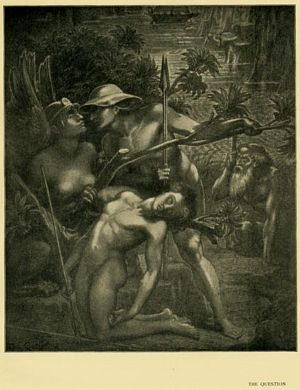
THE QUESTION
Figure: Pencil. Monogram, date lower right corner: "1875." At left, the
Sphinx turns her face upwards, clinging to a tree branch while perched
on a cliff. At center Man, a nude figure carrying two spears, leans
close to her face. Youth, a nude boy holding a spear at lower center,
kneels, swooning backwards. At right, Old Age, an old bearded man,
climbs the cliff while staring at the Sphinx. A boat floats on a lake in
the upper background.
studies were prepared a year before that);
a finished
pen-and-ink study for a great picture
of 1877, the
Astarte Syriaca
; and a large pencil drawing called
The Question
or
The Sphinx
. This represents, seated on a crag of rock, the twiform monster, emblem
of the mystery of life and death, gazing blindly forth into space, whilst to her
feet there climb wearily three figures, typifying youth, manhood, and old age,
all bent on drawing from her sealed lips or inscrutable eyes the answers to the
questions lying nearest to their hearts. The youth falls back dead, with his
question unasked, just as he has reached the goal, still grasping in his limp
and powerless hand a down-turned spear. The figure is a nude, somewhat curiously
drawn, but with all the expression of death in the failing limbs. Manhood
presses resolutely behind him, thrusting aside the obstacles that bar his path,
determined to have his answer, and old age beyond toils painfully upward,
anxious before it be too late to solve the everlasting mystery.
It is said that in designing
The Question
Rossetti was prompted to make youth die upon the threshold of knowledge
by the untimely death of Oliver Madox Brown, the brilliant son of F. M. Brown,
for whom he had a great admiration. I have alluded once or twice to the “Autobiographical Notes” of W. B. Scott, and their captiousness in regard to Rossetti, without
any intention of reviving the turmoil which raged over them in the pages of the
“Academy” and elsewhere; it may, however, be
mentioned here that Scott makes a charge against Rossetti almost as trivial as
the one about
Found
, to the effect that he stole the idea of mankind questioning the Sphinx
(instead of the Sphinx questioning mankind) from an early poem and woodcut by
him. The method in which this charge is made is as ridiculous as the charge
itself, and only calls for refutation because Mr. Sharp in his book appears to
endorse it. Mr. Sharp, however, has since then figured as the reviewer of these
“Autobiographical Notes,” and doubtless is inclined to regard with more caution the pretentions
of Mr. Scott to have furnished Rossetti with ideas. An interesting circumstance
in connection with the drawing is that on his death-bed Rossetti, having an idea
of publishing a miscellany of poems and tales by himself and Mr. Theodore Watts,
selected this subject to serve as a frontispiece, and wrote two fine sonnets for
it. The sonnets remain in the possession of Mr. Watts-Dunton, and have never yet
been published. The drawing for
The Sphinx
was retained by Rossetti, and appeared as Lot No. 197 at his sale in
1883. It has since been acquired by Mr. Fairfax Murray.
About the same time as the afore-mentioned subjects, so far as I can ascertain,
or possibly a year earlier, was drawn a design of a lady holding a crystal
globe, the
Madonna Pietra
of Dante. This was intended to be worked up into a
picture, but never got beyond the stage of
preliminary crayon studies.
One study, a nude,
seems to have come into the hands of Mr. Fry, who wrote to Rossetti in April,
1876, to ask what it signified. In Rossetti's reply he explained the subject,
and added that the crystal globe was intended to reflect a rocky landscape
symbolizing the stony heart of the lady herself.
The following year, 1876, was mainly devoted to the large
works in hand, especially the
Blessed Damozel
, commissioned by Mr. William Graham, which was finished sometime in
1877. This subject was an attempt to realize on canvas the
intensely spiritual conception of Rossetti's early poem which first appeared in
“
The Germ”:
- “The blessed damozel leaned out
- From the gold bar of Heaven;
- Her eyes were deeper than the depth
- Of water stilled at even;
- She had three lilies in her hand,
- And the stars in her hair were seven.”
An idea of painting the picture had existed many years previously, as early at
least as 1856, when Mr. Plint, Rossetti's chief patron at that date, had tried
to commission it. Mr. Graham's commission was given in
February, 1871, and by 1872 he had received a
crayon
drawing
of the subject, which he sent back to be finished
up.
1 In May, 1873, in a letter to Madox Brown, there is some
mention of another
crayon drawing, done for Mr.
Leyland, which Rossetti describes as “a very complete thing,” adding that
he thinks he will paint a picture right off from it, as he really believes
that “such pictures have more unity if one does not do them from nature but
from cartoons.” The crayon drawing last referred to was exhibited at
Burlington House in 1883, and is figured in the catalogue as of oblong rather
than upright shape. Whether this is an error or not I cannot say.
The oil picture now in question is a very fine one. Rossetti filled in the
background behind the stooping figure of the damozel with a heavenly landscape,
in which were countless pairs of embracing
Transcribed Footnote (page 188):
1 This
study, a drawing in red
chalk
, figured as No. 92 in the catalogue of the W. Graham
sale (where, however, no date is given), and was acquired by Mr. Gray
Hill, of Birkenhead. Another
crayon sold
at the same time (No. 96 in the sale catalogue) is the one produced here
as a plate, which belongs to 1875.
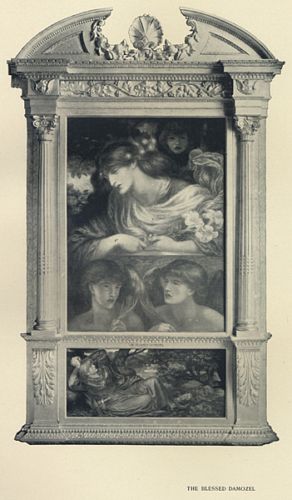
THE BLESSED DAMOZEL
Figure: Oil, with predella. Title inscribed above predella. The damozel,
almost in profile to left, leans over a bar, holding three lilies in her
hands. At top are the heads of three child-angels; at bottom are the
busts of two angels holding quill-pens. The predella shows a man lying
on his back in a wooded grove, gazing upwards.
lovers clad in blue. The reproductions in
the text show two of the studies made for these groups; but a far more
interesting
study which
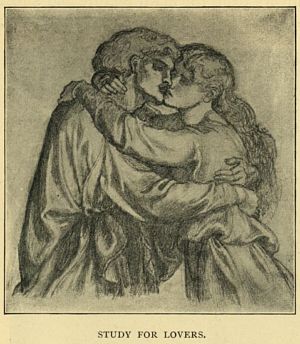
STUDY FOR LOVERS.
Figure: Pencil on buff paper. Study for two lovers embracing; standing, over half-length.
The man is on the left, his arms about the girl's waist; the
girl has her ams round the man's neck.Surtees, p. 143.
I should like to have reproduced is one for the entire background,
studded with pairs of lovers, in the possession of Mrs. Morris. The picture
itself is unfortunately not available, owing to the terms on which it is held in
trust to the executors of the late Mr. Dyson Perrins, who bought it from Mr.
William Graham, the original owner. As already mentioned, the painting was in
progress during Rossetti's visit to Lord and Lady Mount Temple at Broadlands in
1876, and here, according to Mr. William Rossetti, he painted the two angel
children at the feet of the blessed damozel, one being done from the infant of
the Rev. H. C. Hawtrey
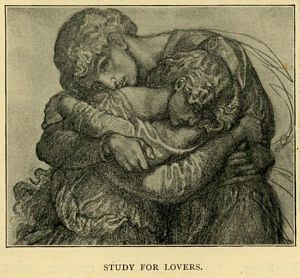
STUDY FOR LOVERS.
Figure: Pencil with touches of chalk on paper. The woman is on the right,
her hands around the waist of the man, her head leaning against his left
shoulder. The man leans on top of the woman's right shoulder, around
which his arms are crossed.
and the other from a work-house child. In December, 1877, Mr. Graham
commissioned a predella to be added to the main picture, and this appropriately
enough represented the earthly lover lying on his back, gazing up through space
to the starry regions which hold his long-lost lady. The price paid for the
picture was £1,000, with an added £150 for the predella. Rossetti, however, in a
moment of characteristic generosity, offered to take £100 for the latter if Mr.
Graham would buy some pictures by his friend James Smetham, whose affairs were
in a bad way at the time.
In 1879 Rossetti painted a
replica of
The Blessed Damozel
and its predella for Mr. F. R. Leyland, omitting the background of
lovers from the main picture and substituting two angel heads rather suggestive
of those which occur in
La Ghirlandata
. This replica
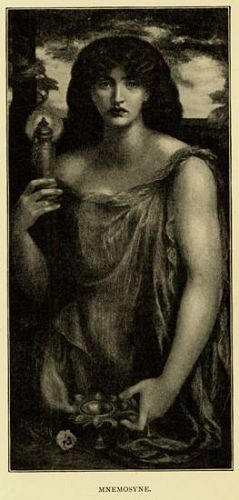
MNEMOSYNE.
Figure: Oil. Initials and date lower left corner: "1881." Nearly
full-length of Jane Morris, who holds a lighted lamp in her right hand
and a winged chalice in her left. The sun sets in the
background.
was accepted in lieu of a
Hero
, which had been commissioned by Mr. Leyland some years before, and for
which 800 guineas had been paid in full. As a picture it is not worthy to be
compared with the original in most respects, but some people find a more
spiritual and pleasing expression in the face of the damozel herself. The
replica is now in the possession of the Hon.
Mrs. O'Brien, by whom it was exhibited at the New Gallery in 1897-8. I have
reproduced it here, with its handsome frame, from
a negative made by Mr. Caswall Smith before it had left Mr. Leyland's hands. A
very charming
crayon study for the head, dated
1875, formerly in Mr. Graham's possession (but said to have been used for this
replica, not for his picture), is also
given
here
, the plate having kindly been lent to me by Mr. Duckworth, for
whom it was first engraved. The study itself has been photographed by Mr.
Hollyer. Other studies in crayon exist both for the heads in the picture and for
the predella.
In June, 1876, Rossetti wrote to Mr. Clarence Fry, who had commissioned
Astarte Syriaca
(now in hand), offering him for £500 a picture just completed which he
called
La Ricordanza
or
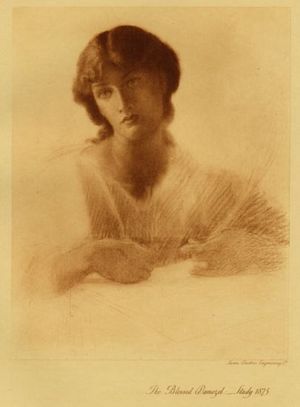
The Blessed Damozel:—Study 1875
Swan Electric Engraving Co.
Figure: Red chalk on pale-green paper. Head and bust with hands (of which only the head of Alexa
Wilding is finished) facing to front, the head inclined slightly
to left. The action of the hands is close to that in the
painting; a palm branch is roughly sketched in her left
hand.Surtees, p. 143.
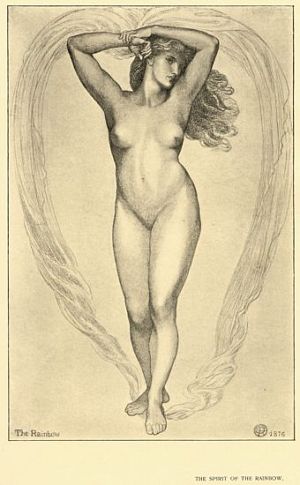
THE SPIRIT OF THE RAINBOW.
Figure: Black crayon. Inscribed in lower left corner: "The Rainbow."
Monogram and date inscribed lower right corner: "1876." Full-length
female nude, her arms raised and over her head, her left hand clutching
her right wrist.
Memory
, “one of his best works.” This picture, which is better
known under the title of
Mnemosyne
, represents a tall mysterious figure with grey brooding eyes, the very
type of mournful memories. Clad in a robe of deep sea-green, which lightly
drapes her rounded form, she holds in one hand a lighted bronze lamp and in the
other a curious winged chalice, accessories which are alluded to in the couplet
inscribed on the frame:
- “Thou fill'st from the winged chalice of the soul
- Thy lamp, O Memory, fire-winged to its goal.”
Some yellow pansies and a fading sunset sky carry yet further the
symbolism of the picture.
That Rossetti should have offered this to Mr. Fry is a little strange, because
that gentleman was shortly to have the
Astarte
, for which
Mnemosyne
was undoubtedly in the first instance intended. The two figures, as will
be seen by comparison of the reproductions, are almost identical in form, and
both have the same sea-green drapery. The conversion into
Memory
must, one would think, have been an afterthought, finely as it is
imagined and carried out. There is even a further suggestion, due to Mr. W. M.
Rossetti, that it was not unconnected with the idea of
Hero
, the figure holding a lamp on high, which Mr. Leyland had commissioned.
However this may be, Mr. Fry did not take the picture, and it remained on
Rossetti's hands, a much lamented incubus, until 1881, when Mr. Leyland bought
it. A
chalk head for
Mnemosyne
was formerly in the Turner collection; it is now in the possession of
Lord Battersea.
The remaining items of 1876 are
Domizia Scaligera
, an unfinished oil painting of a lady in Roman attire leaning on a
window-sill, painted from Mrs. Sumner, a friend of Lord and Lady Mount Temple,
the
study for which belongs to Mr. W. M.
Rossetti; the crayon head of a
Magdalen
belonging to Mr. Rae, and
reproduced here,
said to have been a
replica of the one done about
1866 for Mr. Leyland; a crayon, of which I have no knowledge, called
The Dulcimer
(probably a study for the
Sea-Spell
); and two rather remarkable studies from the same model, called
respectively
The Spirit of the Rainbow
and
Forced Music
. These both belong to Mr. Watts-Dunton, by whose courtesy I have been
able to
reproduce the former. It represents, as
may be seen, in black chalk, a full-length nude figure, the only one executed by
Rossetti (unless we except the figure of “Youth” in
The Question
), standing in the centre of a gauzy veil symbolizing the rainbow. The
rain and a landscape of trees were to have been added, so as to illustrate more
completely a sonnet by Mr. Watts-Dunton
which is inscribed on the frame and of which the following lines form part:
- “The spirit of the Rainbow would'st thou wed?”
- I arose, I found her—found a rain-drenched girl
- Whose eyes of azure and limbs of rose and pearl
- Coloured the rain above her golden head.”
Forced Music
is a half-length figure, also nude, playing upon a sort of lute; and
from the expression an idea is conveyed that the
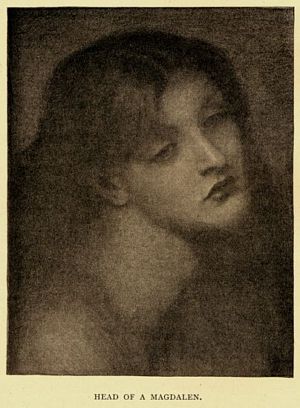
HEAD OF A MAGDALEN.
Figure: Pastel. Head and shoulders of Alexa Wilding, turned right, head
leaning back and face front.
girl is a captive slave. This title also is said to be based upon a
little Rosicrucian romance written by Mr. Watts-Dunton.
The year 1877 contains but three items, two of which are, however, the important
oil-pictures
Astarte Syriaca
and
The Sea-Spell
; while the third is also an oil-picture, of a
Magdalen
bearing the vase of spikenard, round which is seen a portion of the
inscription, “Hoc pedes meos . . .” These words are sometimes taken as the title by which the picture is
identified, to prevent confusion both with the earlier subject of
Mary Magdalene at the Door of Simon
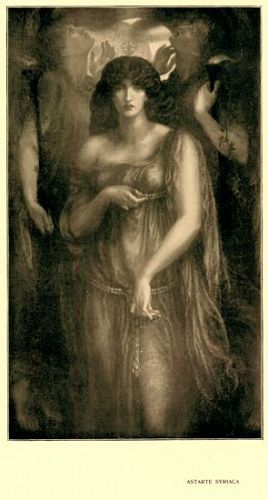
ASTARTE SYRIACA
Figure: Oil. Full length of Jane Morris, her left hand resting beside her
belt, her right resting beneath her bosom. To her left and right, two
torch-bearing male attendants gaze up at the sky. The full moon shines
through dark clouds in the background.
and with the two Magdalen heads in chalk
[head 1]
[head 2] done respectively for Mr. Leyland
and Mr. Rae. The picture in question has passed into the possession of Mr.
Samuel Bancroft, junior.
Astarte Syriaca
has already been mentioned as commissioned by Mr. Clarence Fry, late of
the well-known firm of Elliot and Fry, photographers. Through the skilful
manipulations of C. A. Howell, a larger price was obtained for this picture than
for any other that Rossetti ever painted, viz., £2,100. Mr. Fry secured most of
the
crayon studies and a finished
pen-and-ink drawing of the subject as well, perhaps
without extra payment. The pen-and-ink drawing he obtained as a return for
obliging Rossetti in the matter of an advance. Some slight idea of the picture
has already been given in connection with the subject
Mnemosyne
, supposed to have been begun for it; but it is a finer and grander
conception than that. The Syrian Venus, a dusky massive figure, with face and
hair strongly reminiscent of Mrs. Morris, gazes majestically from the canvas.
Her eyes are vague and dreamy, mysterious as her rites. Her swarthy form, larger
than life-size, stands out impressively against a blood-red sunset sky, and
behind her the moon begins to rise auspicious for her worship. A sea-green
drapery with silver girdle enfolds, as in the
Mnemosyne
, but does not hide her ample bust and limbs. To right and left, with
heads uplifted and strained in adoration, are two attendant spirits draped in
brighter green with wings of sombre olive, bearing each a fiery torch. The
following fine
sonnet was written for the picture:
- “Mystery: lo! betwixt the sun and moon
- Astarte of the Syrians; Venus Queen
- Ere Aphrodite was. In silver sheen
- Her twofold girdle clasps the infinite boon
- Of bliss whereof the heaven and earth commune:
- And from her neck's inclining flower-stem lean
- Love-freighted lips and absolute eyes that wean
- The pulse of hearts to the spheres' dominant tune.
- Torch-bearing, her sweet ministers compel
- All thrones of light beyond the sky and sea
- The witnesses of Beauty's face to be:
- That face, of Love's all penetrative spell
- Amulet, talisman, and oracle,—
- Betwixt the sun and moon a mystery.”
Shortly before Mr. Fry's death this magnificent picture, into which Rossetti
certainly put all the good work of which he was still capable, was sold for a
price much below that originally given. It is now in the Corporation Art Gallery
at Manchester.
The Sea-Spell
is a reversion from the type of Mrs. Morris to the type of Miss Wilding,
and represents a beautiful siren crowned with roses, and seated in a leafy bower
by the shore. Before her she holds a harp of strange unearthly form. Rossetti's
first idea in painting this subject was to illustrate the lines from Coleridge:
- “A damsel with a dulcimer
- In a vision once I saw.”
The notion of sea was then absent from the design, and a white-winged dove
was to be represented as flying round attracted by the music. In the later
development of the picture the dove was replaced by a graceful sea-bird, and a
beautiful glimpse of blue waves was painted where trees would otherwise have
been. The following
sonnet expresses
Rossetti's conception of the theme:
- “Her lute hangs shadowed in the apple-tree
- While flashing fingers weave the sweet-strung
spell
- Between its chords; and as the wild notes swell,
- The sea-bird for those branches leaves the sea.
- But to what sound her listening ear stoops she?
- What nether-world gulf-whispers doth she hear,
- In answering whispers from what planisphere,
- Along the wind, along the estuary?
- She sinks into her spell: and when full soon
- Her lips move and she soars into her song,
- What creatures of the midmost main shall throng
- In furrowed surf-clouds to the summoning rune:
- Till he, the fated mariner, hears her cry,
- And up her rock, bare-breasted, comes to die?”
The Sea-Spell
was painted for Mr. Leyland as a pendant in size to
Veronica Veronese
, which it can hardly be said to equal as a picture. Apart from
undeniable qualities of colour and painting, it is not entirely felicitous in
pose, and the drawing of the neck and face is distinctly in Rossetti's later
manner. In subject it is, as previously mentioned, an expansion of the idea
embodied in the crayon drawing of a nude figure called
Ligeia Siren
(1873).
The two finished items of 1878—for as the years advance now the output grows less
and less—are
A Vision of Fiammetta
and a water-colour study of a head called
Bruna Brunelleschi
. The latter was acquired by Mr. Leonard Valpy, but after some time was
transferred back to Rossetti at his request, and in 1883 belonged to Mr. C. W.
Mills. Whether or not it has since changed hands I do not know.
Fiammetta
is a fine and striking conception, representing on a
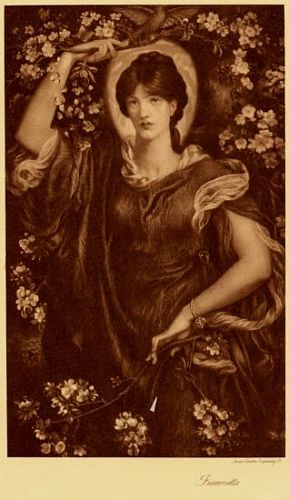
Fiammetta
Swan Electric Engraving Co.
Figure: Oil. Full length of a haloed woman holding an apple-tree branch in
each hand. She holds her right hand above her head, and the left rests
beside her waist. A bird is perched on the branch held above her
head.
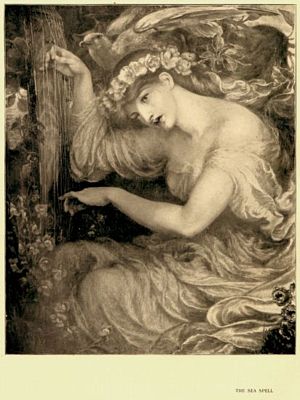
THE SEA SPELL
Figure: Oil. Full-length of a seated, garlanded woman turned left, playing
an upright dulcimer in a bower. A bird perches beside her
head.
life-size scale the lady beloved by
Boccaccio, to whom he addressed many sonnets, including
the last but one in Rossetti's volume of
translations, which begins: “Round her red garland and her golden hair I
saw a fire about Fiammetta's head.” In Rossetti's picture she stands
fronting the spectator, holding in one hand, or pushing away a heavily-laden
branch of apple-blossom. She is clad from head to foot in a dull red robe, and
has hair of reddish-brown; but the most striking feature of her beautiful face
are the bright blue eyes that form a colour contrast with the pink-white masses
of blossom surrounding the whole picture. Two blue butterflies poised aloft
skilfully support this contrast and make it more complete. Besides the Boccaccio
sonnet just mentioned, of which the first line is altered to “Mid glowing
blossoms and o'er golden hair,” the frame of
Fiammetta
bears
a second, which was published
in “Ballads and Sonnets”:
- “Behold Fiammetta, shown in vision here,
- Gloom-girt mid spring-flushed apple-growth she
stands;
- And as she sways the branches with her hand
- Along her arm the sundered bloom falls sheer,
- In separate petals shed, each like a tear;
- While from the quivering bough the bird expands
- His wings. And lo! thy spirit understands
- Life shaken and showered and flown, and Death drawn near.
- All stirs with change. Her garments beat the air:
- The angel circling round her aureole
- Shimmers in flight against the tree's grey bole;
- While she with reassuring eyes most fair
- A presage and a promise stands; as 'twere
- On Death's dark storm the rainbow of the Soul.”
In the picture a crested bird is seen winging its way as described, and
the angel “circling round her aureole” can also be seen. The
sitter for
Fiammetta
, as has already been mentioned, was Mrs. W. J. Stillman, formerly Miss
Marie Spartali. Many of the “heads” of Mrs. Stillman which exist were drawn with
a view to this picture; though some, like the
one
reproduced under 1869
, were simply portraits.
Fiammetta
was acquired in the first instance by Mr. W. A. Turner, and after the
sale of his collection passed into the possession of Mr. Charles Butler, who has
been mentioned already as the possessor of Mr. Turner's
Proserpine
, dated 1877, and
Pandora
.
Of unfinished designs taken up in 1878 may be mentioned
Desdemona's Death-Song
, in which Rossetti sought to show the hapless wife of Othello crooning
her song of the willow as Emilia
combs out her long hair. Various drawings
for the figure of Desdemona, and one at least of the
entire composition
reproduced here, were executed in chalk on a scale
about half life-size, and as soon as
Fiammetta
was out of hand a beginning was made to paint the subject on canvas.
This, however, came to nothing. No better
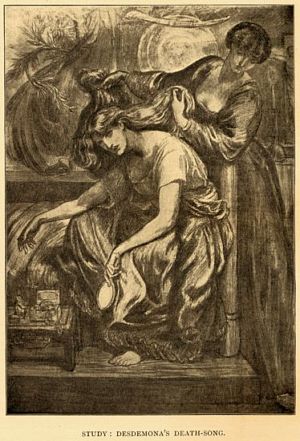
STUDY: DESDEMONA'S DEATH-SONG.
Figure: Medium unknown. Desdemona, seated at center, leans left with a
mirror in her right hand, while Emilia, standing at right, combs her
hair. A small table covered with toiletries sits in front of Desdemona
at left.
fortune attended the Faust subject that Rossetti proposed to himself
to paint about the same time, called
Gretchen
or
Risen at Dawn
, a theme reminiscent of one or two very early pen-and-ink drawings, but
representing a totally different scene, Gretchen in her chamber examining the
casket of jewels. Rossetti intended this picture for Mr. Valpy, as part of his
payment for
Dante's Dream
; but as already mentioned in a note it failed to reach completion before
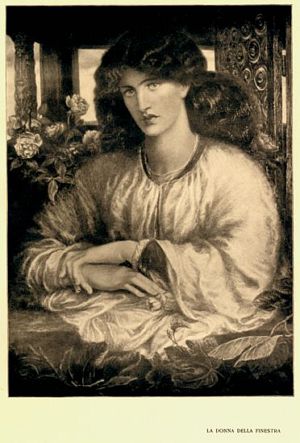
LA DONNA DELLA FINESTRA
Figure: Oil. Upper torso of a woman leaning against a window-sill, her
hands crossed in front of her, her left hand holding her right wrist. A
bouquet of flowers grows beside her right shoulder, and a columned
building forms the background.
Rossetti's death, and the executors had to
repay Mr. Valpy out of the proceeds of the estate instead. The unfinished canvas
figured among the items of the sale.
La Donna della Finestra
, a subject which had also been present in his mind from early years as
suitable for a picture, was painted in 1879 and came into the possession of Mr.
F. S. Ellis, who already owned
La Bella Mano
. This “Lady of the Window,” also known as “The Lady of Pity,” is she who
in Dante's “Vita Nuova” is described as looking down upon the poet one day, when he was
overcome with grief, “so that the very sum of pity appeared gathered
together in her.” Rossetti had a fancy that this lady, who
thereafter, whensoever she saw Dante, “became pale and of a piteous
countenance as though it had been with love,” might be Gemma Donati,
whom the poet afterwards married— a suggestion which I have mentioned in
connection with his early water-colour of
Dante drawing an Angel on the anniversary of Beatrice's
Death
. In the picture the lady is seen seated at an open window, leaning her
arms upon the sill, and looking downwards with a yearning pity in her grey-blue
eyes. The head is taken from Mrs. Morris, much modified by the conventions which
Rossetti at this time introduced into all his faces. Not the least charming
feature of the picture is the clustering mass of beautifully painted fig-leaves
growing up to the balcony in which the lady sits.
The studies for
La Donna della Finestra
had been begun in 1870, and two which especially call for notice have
already been mentioned under that date. One of these, in the collection of the
late Mr. Virtue Tebbs, resembles the picture accurately in regard to the
attitude of the figure and position of the hands, and may therefore be regarded
as the real
study for it. The other, which will
be found
illustrated on page 160, shows the
figure only, and differs in some respects,
especially in the arrangement of the hands. Both are fine examples of Rossetti's
work in chalk.
La Donna della Finestra
now belongs to Mr. W. R. Moss, of Bolton, Lancs., and has been published
by Mr. Hollyer. It was last exhibited at the New Gallery in 1897-8. In addition
to the two studies just mentioned of 1870, there exists a
crayon replica (dated 1880) of one of them, the
variant
reproduced in the text. This used to belong
to Mr. Graham, and is now in the possession of Mr. Goldmann. Mr. Graham also
owned an
earlier drawing than any of those
mentioned, done from his own daughter, now Mrs. Horner, in 1869. This, however,
ranks really as a separate subject, and not as
a study for the picture. It has, I believe,
been photographed for distribution, and is still in Mrs. Horner's possession. Of
other studies or replicas there remain to be mentioned a
pen-and-ink drawing of about 1879, formerly in
the possession of Mr. Valpy, and at least one
unfinished oil painting, sold at Rossetti's sale in 1883, and now in
the Corporation Art Gallery at Birmingham. This—a head and hands merely, with
none of the background or drapery filled in—is popularly known as
The Lady of Pity
, and has been misleadingly described as different from the picture.
Comparison
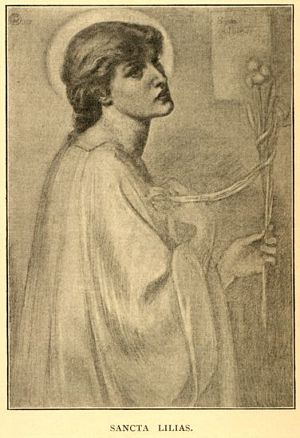
SANCTA LILIAS.
Figure: Monogram and date upper left corner: "1879." Inscribed on a scroll
upper right: "Sancta LILIAS." Three-quarter-length figure of a woman (features of Alexa
Wilding) standing, turned to the right; the head with a halo is
nearly in profile. In her left hand she holds up a lily stem.
Head finished in red chalk, the rest of the figure
sketched.Surtees, p. 153.
of the two shows that it would have been identical, and that it is in
fact simply an unfinished replica, though a fine one so far as it goes.
The other items of 1879 are a
crayon replica
with variations of
Pandora
, in the possession of Mr. Watts-Dunton, already described and
reproduced; the large Leyland replica of
The Blessed Damozel
, in the possession of the Hon. Mrs. O'Brien, also reproduced already;
and a very popular crayon study known as
Sancta Lilias
, from the inscription on a label in the corner, which there is reason to
suppose may have been intended for an Annunciation picture different from those
already executed by Rossetti. The angel or female saint bears in her hand a
bunch of lily stems, round which is wound a ribbon with the inscription
“Aspice Lilia!”
During the years 1880 and 1881 Rossetti was occupied with three large original
pictures,
The Day Dream
,
The Salutation of Beatrice
, and
La Pia
; with
Found
, which had been re-commissioned by Mr. William Graham; and with several
replicas, of which the most important, delivered early in 1880, was the
smaller
Dante's Dream
with the two predellas, done for Mr. Graham to replace the large one.
After Mr. Graham's death, in 1886, this picture passed
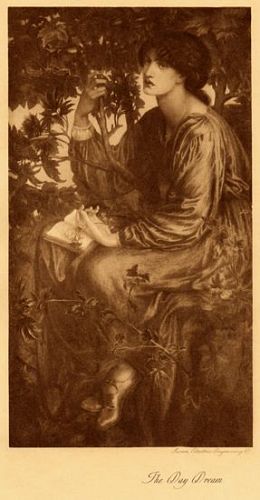
The Day Dream
Swan Electric Engraving Co.
Figure: Oil. Full length of Jane Morris sitting in a sycamore tree. She is
barefoot, and holds a flower laid on an open book in her right hand, and
holds a branch of the tree with her left.
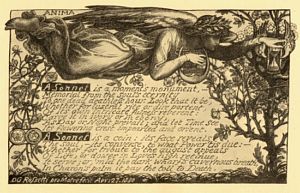
Figure: Pen and ink. Inscribed in upper left: "ANIMA," and in lower left:
DG Rossetti pro Matre fecit Apr: 27 1880." DGR's sonnet "A Sonnet is a
moment's monument" is inscribed at center. At top, an angel playing a
lyre flies towards a winged hourglass in the branch of a tree at
right.
into the possession of Mr. Ruston, and now
belongs, as already mentioned, to Mr. William Imrie, of Liverpool. The other replicas taken in order are a
water-colour
Proserpine
, stated to have belonged to Mr. J. H. Hutton, of which I have no
further knowledge;
1 a
large oil
Beata Beatrix
, painted for Mr. Valpy, and now in the possession of the Hon. Percy
Wyndham; the unfinished
Donna della Finestra
just mentioned as being in the Birmingham Art Gallery; Mr. Valpy's
reduced oil
Proserpine
; and the
Joan of Arc
done for the same gentleman, which two were the very last pictures
touched by Rossetti, being finished at Birchington within a few days of his
death.
The
Day Dream
, which Rossetti at first thought of calling
Monna Primavera
, is a beautiful portrait of Mrs. Morris, seated in the lower branches of
a sycamore tree. Like many of Rossetti's important pictures it remained
unexecuted for years after the original studies had been prepared. It may almost
be said in fact that some of the drawings done from Mrs. Morris in 1868, such as
Mr. Watts-Dunton's
Reverie
, were preparations for the
Day Dream
, which continually occupied his thoughts, and which it will be
remembered he had announced his intention of painting in 1872, directly he got
back to Kelmscott from Scotland.
The last of
the
“Sonnets for Pictures”, a well-known one, belongs to this subject, and may be quoted here:
- “The thronged boughs of the shadowy sycamore
- Still bear young leaflets half the summer through;
- From when the robin 'gainst the unhidden blue
- Perched dark, till now, deep in the leafy core,
- The embowered throstle's urgent wood-notes soar
- Through summer silence. Still the leaves come new;
- Yet never rosy-sheathed as those which drew
- Their spiral tongues from spring-buds heretofore.
- Within the branching shade of Reverie
- Dreams even may spring till autumn; yet none be
- Like woman's budding day-dream spirit-fann'd.
- Lo! tow'rd deep skies, not deeper than her look,
- She dreams; till now on her forgotten book
- Drops the forgotten blossom from her hand.”
It has been recorded, as an instance of Rossetti's painstaking and scrupulous
particularity, that a friend saw him, after the figure
Transcribed Footnote (page 199):
1 Mr. F. S. Ellis was in treaty for a
water-colour
Proserpine
in 1878, so that this replica may really be earlier than is
generally stated. There is no evidence of there having been two.
in the
Day Dream
was finished,deliberately set to and paint out
all the lower portion because he thought on reconsideration that the limbs
were made too short.
1 This is but typical of the man as we know him, recklessly
prodigal of money and trouble as he could at times be chary of both. The
Day Dream
was much admired by Mr. Constantine Ionides, and was bought by him. Mrs.
Morris has a fine
crayon study dated 1878, and
others exist.
[study 2] One was recently in the
possession of Lord Battersea.
[study 3] A third
was numbered Lot 31 in Rossetti's sale, and is definitely dated in the catalogue
1879.
An episode in the work of 1880 is a charming pen-and-ink design, called
The Sonnet
(
reproduced here), which Rossetti drew in
a volume of Main's “Treasury of English Sonnets” as a birthday gift to his mother. The body of the design is itself a
sonnet on
“The Sonnet”, which has often been quoted. Mr. William Rossetti owns the volume
containing this drawing, attached to which is the inscription and date:
“D. G. R. pro matre fecit . 27:4:'80.”
The large
Salutation of Beatrice
which Rossetti began to work upon in 1880 bears no resemblance to his
earlier designs from the same source, but is an illustration of
the lines:
- “My Lady looks so gentle and so pure
- When yielding salutation by the way,
- That the tongue trembles and has nought to say,
- And the eyes, which fain would see, may not endure.
- And still amid the praise she hears secure,
- She walks with humbleness for her array.”
The Beatrice of this picture is shown descending a street in Florence, off
which, upon a sort of terrace, and seated by a well, is Dante overshadowed
beneath the outspread scarlet wings of Love. In her hand she bears a book of
devotion, with which she wends her way, clothed in that humility and beauty
which compelled the folk to whisper as she passed by: “This is not a
woman, but one of the beautiful angels of Heaven.” Moreover, says the poet,
so potent was her virtue that “when she drew near unto any, such truth and
simpleness entered into his heart that he dared neither to lift his eyes nor
to return her salutation.” Flowering roses and jessamine surround
her path.
Despite the source of inspiration, which was so congenial to
Transcribed Footnote (page 200):
1 This involved first copying on to a separate
canvas the sycamore shoots which were painted on top of the drapery,
because the season of year had passed for obtaining fresh specimens. The
head in
The Day Dream
was also entirely repainted once if not more times because
Rossetti felt dissatisfied with the result.
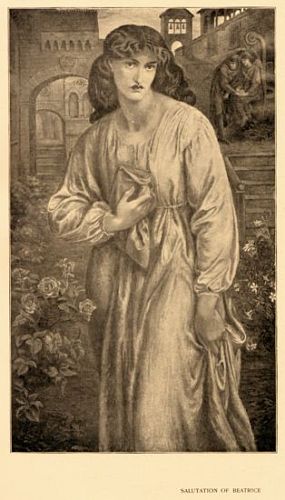
SALUTATION OF BEATRICE
Figure: Oil. Beatrice, three-quarter-length, walks in a street in
Florence, rose bushes and jasmine growing on either side. In one
hand she holds her missal and with the other gathers up her
dress. In the background Love, seated on a well, shelters Dante
beneath his wings.Surtees, p. 155
Rossetti's temper, it can scarcely be said that this last Beatrice
was an attractive or successful creation. The picture indeed exhibits all the
defects of his later style, induced by morbidity, weak eyesight, and failing
powers. For the background, with its studies of mediæval architecture, Rossetti
took some pains to procure suitable material, photographs of old Florentine and
Sienese streets being sent to him by a friend from Italy. The picture, however,
remained in a not quite finished condition at his death, and the background was
slightly worked upon at the last by another hand. It passed
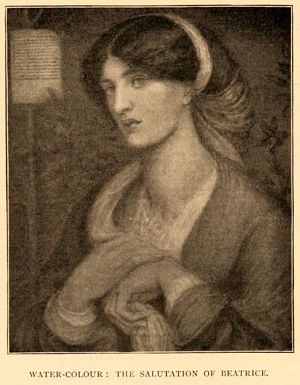
WATER-COLOUR: THE SALUTATION OF BEATRICE.
Figure: Watercolor. Inscribed on a scroll upper left: sonnet two of the
Vita Nuova ("Tanto gentile e tanto onesta pare.") Mrs. Morris half-length, is turned slightly to the left with
the eyes looking to front. She wears a scarf twisted round her
hair, the end falling over her shoulder and lightly held in both
hands which are placed one upon the other.Surtees, p. 156
into the possession of Mr. Leyland, by whom it was exhibited at
Burlington House in 1883; and being sold with the rest of that gentleman's
pictures in 1892, it was acquired by Sir John C. Holder, its present owner, who
lent it to the exhibition of Rossetti's pictures at the New Gallery in the
winter of 1897-8. From some notes made by Mr. Murray on
the Leyland collection, and kindly lent to me, it appears that Mr. Leyland
had a
small version of the picture as
well as the
large one, both being in about the
same unfinished state, and both dated 1881.
1
Transcribed Footnote (page 201):
1 Mr. Leyland objected to replicas of his pictures, and
finding the
small version after
Rossetti's death in the same state of completion as his
large one, he decided to take
A
water-colour study for Beatrice, differing
entirely, however, from the picture, and only to be identified by the
sonnet,“Tanto gentile e tanto
onesta pare” on a scroll at the back, was painted
(probably about 1872) from Mrs. Morris, and belonged to the late Mr. John Bibby.
It was entered in the catalogue of his sale as “No. 36. A Lady in a blue
dress, her hands folded in front of her.” This is now in the
possession of Mr. Joseph Dixon, who has allowed it to be
reproduced for comparison with the
oil picture.
A crayon
head
of later date, 1876 or 1877, belonged to the late Mr. Valpy, and
may be the one of which a reproduction has been published.
Mr. Leyland was also the purchaser of
La Pia
, the last original picture painted by Rossetti. The story of Pia de'
Tolomei, wife of Nello della Pietra, of Siena, is told in the fifth canto of the
“Purgatorio,” and has already been referred to under the year 1868, when the first
studies for the subject were made. In Rossetti's picture she is seen, sitting
bent forward in a window, gazing out over the poisonous Maremma marshes from the
fortress where her husband had placed her to die. With one hand she fingers the
wedding-ring which has brought her so much sorrow. The attitude and expression
of the face, it must be confessed, are unpleasant, while the colouring is no
longer up to Rossetti's best standard. Apart from this, the landscape, painted
mostly from sketches of Maremma scenery, is finely done, and so are many of the
accessories of clustering ivy and green leaves, the tolling bell, and ravens
hovering round, symbolic of the death that lurks within that fever-stricken
air.
Mr. Leyland did not retain
La Pia
, but passed it on to Mr. John Bibby, among whose pictures it was lately
sold, in June, 1899. The present owner is Mr. Russell Rea. No duplicate painting
of it exists, but two fine studies in black chalk
[study
1]
[study 2] were made about 1868, and remained in
the possession of C. A. Howell until about 1874, when they disappeared. Two
supposed
studies—one
a
head
—belonged to the late Mr. L. R. Valpy, and were exhibited, the
one at the Burlington Club, the other at Burlington House, in 1883. The
Burlington Club drawing is described as “Lady (3/4 length) seated on a
castle wall, leaning on a parapet. Head of figure turned to R. Overhead the
branches of a tree. The Maremmese marshes beyond. Head and hands in red
chalk, accessories in blue.
Transcribed Footnote (page 202):
[
1] both. It is uncertain what has become of the
smaller picture, which was not in the Leyland sale.
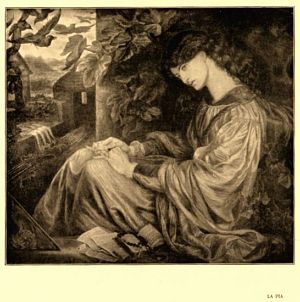
LA PIA
Figure: Oil. Full length of a seated woman facing left, head and neck
bent forward, fingering her wedding ring. She sits among the leafy
growth of a castle rampart. Beside her at lower center are several
letters and a rosary laid across an open book. At center left are a
bundle of lances and a banner draped over the side of the
battlement.
Different from the oil picture.”
1 The date is given as circa 1868.
The head, exhibited at
Burlington House (No. 331), is also described as differing from the picture in
features and pose. It is dated 1868, and inscribed with the first line of the
pathetic appeal which the lady's spirit makes to Dante in the “Purgatorio”: “Ricorditi di me che son La Pia.” Most of the studies probably bear this line, and the one which has
been published by Mr. Caswall Smith is catalogued by it as a title. The main
difference between this and the finished picture is that the lady is leaning
back instead of forward.
The last picture by Rossetti with which we are concerned, as also one of the
first, is
Found
. The description and a large part of the history of this picture have
already been given under the year 1853, when it was begun. Rossetti's early
patron, Mr. MacCracken, was the first to commission it; he was followed, in
1859, by Mr. Leathart, and ten years later by Mr. William Graham, the price
rising in the interval from 350 to 800 guineas. Ten years later still a
monochrome on canvas was prepared, with a view
to straightening out the composition and bringing the picture to completion. By
1880 Rossetti had made considerable progress with the man's figure and other
details, and would probably have finished it, had a difference not arisen
between him and Mr. Graham, who wished to concentrate upon
Found
certain sums advanced long previously for another unexecuted
picture,
The Boat of Love
. Mr. Graham may have seen that the chances of getting the latter were
becoming infinitesimal, but Rossetti would not allow it to be dropped, and on
the matter being pressed abandoned both.
Found
was taken in its unfinished state by Mr. Graham for the money which had
been advanced, after Rossetti's death; and a friendly hand— that of Sir Edward
Burne-Jones—gave it a sort of completion by painting in a sky to hide the
nail-holes which showed where the canvas had been enlarged. After the Graham
sale
Found
belonged for a time to Mr. R. Benson, but later on was purchased at
Christie's by Mr. Samuel Bancroft, and removed by him to his residence in
Delaware, U.S.A.
Transcribed Footnote (page 203):
1 In reality neither is a study for the picture as it
stands. The drawing here described was sold at Rossetti's sale under the
fancy title of
Aurea Catena
, or
The Lady with the Chain
, and, as has already been explained, was not a study for
La Pia
at all.
WITH the last chapter we came to an end of Rossetti's work as
a painter. It remains to close the record of his life. In order to do this it is
necessary to introduce a new name, that of Mr. Hall Caine, with whom, about
1879, Rossetti entered into a correspondence chiefly in relation to literary
matters. Mr. Caine had lectured on Rossetti's poetry, and that was the common
link. In 1880 Mr. Caine called on Rossetti in London, and in 1881 he came by
invitation to keep Rossetti company as an inmate of No. 16, Cheyne Walk. Great
as this privilege was, it may not have been entirely without its drawbacks; for
Rossetti had by this time fallen into a chronic condition of melancholy, and his
demands upon a companion were apt to be exacting. He could still when he chose
talk as brilliantly and wittily as ever, and upon the intellectual side his mind
remained untouched; but in general he was too sensitive about himself and too
suspicious of his friends to be an altogether pleasant housemate or an easy
master. Mr. Caine has given a painfully minute description of Rossetti's failing
state when first he joined him. He had not been outside his house for two years,
except at rare intervals for a drive; he was taking chloral to excess; he was
liable to outbursts of unreasonable anger, followed by moods of almost equally
embarrassing remorse; and he was apparently so devoid of will power that Mr.
Caine detected “irresolution with melancholy lying at the basis of his
nature.”
One must make allowance for impressions formed under the caprices of a disordered
mind, and rather hastily published; but to accuse Rossetti of fundamental
irresolution or melancholy shows small knowledge of his past and small
appreciation of the intrinsic qualities of his character. Nevertheless, Mr.
Caine very greatly admired Rossetti, and performed services for him that were in-
valuable—not the least instance of his
usefulness being the part he played in conjuntion with Mr. Shields in
negotiating the purchase of
Dante's Dream
by the Liverpool Corporation. Fuller particulars as to Mr. Caine's
relations with Rossetti may be sought for in the volume which Mr. Caine has
devoted to the subject.
In September, 1881, Rossetti, accompanied by Mr. Caine, tried the effect of an
expedition to the lake district of Cumberland; but after a month spent in the
Vale of St. John, his health, which at first had appeared to benefit by the
change, became alarmingly bad, and he returned hurriedly to London, exclaiming
as he entered his own door: “Thank God, home at last, and never shall I
leave it again.” Within a few days he was seriously ill and required
continuous nursing. His brain became troubled with old reminiscences and with
semi-religious qualms. Mr. W. M. Rossetti has given some account of his
brother's religious opinions, which normally were of a quiescent sort, slightly
inclined on artistic grounds towards the superstitious legends of Catholicism.
This indeed would be evident to anyone from the tone of his religious pictures;
but his manner of speaking and writing about the latter is enough to show, if a
proof be required, that his convictions were not very active or deep-rooted. A
curious departure from his ordinary philosophic attitude was the interest he
took for a long time in spiritualism, when the mediumistic craze was at its
height in England. It seems that he was genuinely attracted towards the tawdry
hopes held out by practitioners in this science of communicating with the unseen
world, and like Mrs. Browning, with whom he may have exchanged views, was
inclined to believe in the evidence for materialized spirits. At the same time
he was not above speaking with levity of his spiritualistic experiences; and in
the absence of the modern word “spooks,” which he would certainly have welcomed,
he used to refer to the alleged inhabitants of the spiritual world as “bogeys.”
“Come and help to drive the bogeys away” was a familiar form
of invitation to friends to spend the evening with him, and “bogeys” were
occasionally responsible for severe mental disturbance, as on the occasion of
one of his visits to Penkill, about which Mr. W. B. Scott has a long passage in
his autobiography.
To sum up the point briefly, Mr. W. M. Rossetti quotes from the lyric called
“Soothsay”, in “
Ballads and Sonnets,” a verse which is so representative of his brother's views in regard to
the broader questions of religion, and so sound in principle, that I hope I may
be excused for repeating it here:
- “Let lore of all Theology
- Be to thy soul what it can be;
- But know—the Power that fashions man
- Measured not out thy little span
- For thee to take the meting-rod
- In turn, and so approve on God
- Thy science of Theometry.”
After a partial recovery from the illness just mentioned, Rossetti's work
was once more interrupted in December of 1881 by an attack of nervous paralysis,
which came upon him suddenly and deprived him of the use of his lower limbs. The
loss of co-ordinative power was only too plainly traceable to the effects of the
drug he had been taking, and chloral was from that time finally and completely
abolished. That this entailed much suffering at first goes without saying, but
once the sacrifice was accomplished Rossetti perceptibly gained in health and in
freedom from delusions. As soon as he was well enough for a change, in the
beginning of February, 1882, he was taken to Birchington-on-Sea, where a cottage
had been placed at his disposal by Mr. J. P. Seddon; and here he worked a little
on two of the pictures intended for Mr. Valpy. His old uræmic complaint attacked
him, however, within a month or so of his arrival, and kidney disease
supervened. In his shattered state of health he could not rally, but grew
gradually weaker and worse; and though everything was done for him that skill
could suggest, he died, from purely physical causes, on the 10th of April. His
mother and his invalid sister Christina, together with Mr. W. M. Rossetti and
Mr. Theodore Watts, were amongst those who attended him in his last moments. He
was buried, quietly and simply, in the little churchyard at Birchington, where a
stone monument has been erected by his family in the form of a Celtic cross
designed by Madox Brown. A memorial window embodying his own early design
of
The Passover
, adapted by Mr. Shields, was also set up in the adjoining church.
Very shortly before his death, and after he had given up painting, Rossetti made
an attempt to finish his old story of
“St. Agnes of Intercession” begun for the “
Germ.” He also completed the somewhat saturnine ballad of
“Jan Van Hunks”, and wrote a pair of sonnets, already referred to, for his drawing
called
The Question
. These, with the unpublished ballad, remain in the hands of his literary
legatee, Mr. Theodore Watts-Dunton.
So passed away, in the fifty-fourth year of his life, one of the greatest and one
of the most original artists of our time; I will not
say one of the greatest painters, for that
would invite controversy as to points in which he was, and knew himself to be,
deficient. But as an artist, as one who saw, and could interpret and depict
beautiful things in a beautiful way, there can be no two questions about
Rossetti's greatness. Never before has one man blended so perfectly the sister
gifts of poetry and painting that it was impossible to pronounce in which he was
superior. An American critic, struck with the wealth of poetic idea embodied in
all his canvases, and perhaps also with the pictorial richness of his poetry,
went so far as to say that Rossetti should have painted his poems and written
his pictures; but in truth the two were interchangeable, and what Rossetti has
done is to paint his poems as well as write them. To complain, as some have
done, of the far-fetched mediæval quality of his subjects is foolish. As well
complain that our fairy tales are old. Rossetti
was mediæval
in his thoughts and tastes. Without any affectation or straining for effect he
lived his intellectual life in a mystical, richly-coloured world of romantic
knights and sad-eyed ladies. These, and not the hedgerows or buttercups of
to-day, were what came to the surface in his creative moods. England is rich
enough in native poets and painters to spare one man, so strangely gifted, for
the rarer visions of romance. Honour to the many who can see beauty in the life
around them, and can extract from spring and autumn, life and death, from
crowded towns and whirling wheels, the underlying motives of eternal truth; but
honour also to him who can collect the faded rose-petals of the past and make
them yield their sweetness. We have witnessed in these latter years a great
revival of romance, springing up in various ways all over the continent of
Europe. Of this revival in England, on the side of pictorial art, Rossetti was
the fountain head; nor did his stream less clearly flow when swelled by
tributaries from the Oxford movement. With poetry it was different. The
beginning of the century had produced in Coleridge, Keats, Chatterton, and
others, a school of pure romance of which Rossetti was but the heir. After them
came Tennyson, with a Midas touch, transmuting all to gold. How far Tennyson,
with his thoughts of chivalry, may have influenced Rossetti is difficult to say.
It was Browning to whom the latter chiefly turned, drawn by a sympathetic
feeling for the buried past, when lives were many-hued and passions strong. But
there were no “sad eyes” in Browning, whose robustness would have scorned such
feeble attributes. The gentle melancholy that pervades Rossetti's work was
derived from his namesake Dante, to whom he
was doubly allied besides by ties of birth
and sentiment. “He had,” says Mr. Colvin, in an appreciative sketch
written shortly after Rossetti's death, “the same cast and tendency of
imagination as inspired the poet of the “Vita Nuova” to embody all the passions and experiences of the human heart in
forms of many-coloured personification and symbol. He was moreover driven by
something like the same unrelaxing stress and fervour of temperament, so
that even in middle age it seemed scarcely less true to say of Rossetti than
of Dante himself:
- ‘Like flame within the naked hand,
- His body bore his burning heart.”
A great question arising out of Rossetti's peculiar temperament is his influence
on the younger generation both of painters and poets. That he exercised, and
continues to exercise, a commanding influence is undeniable, even though its
ramifications may not be very wide. Perhaps on the whole it is his spirit rather
than his manner that has been sought after; and we may be glad that this is so.
For manner even in his own hands tended at the last to become mannerism, and in
the hands of imitators would infallibly do so. There are special reasons, apart
from the unorthodox quality of his technique, why Rossetti is a dangerous guide
to follow closely in art. The richness of his imagination and his Italian warmth
of temperament led him along heights of poetic fancy where it is difficult for
colder natures to follow. He knew the limits, where others only exaggerate; and
so he could succeed where others tend to fail.The
direction of his influence, and of the Pre-Raphaelite movement generally,
has recently been worked out in a scholarly manner by Mr. Percy H. Bate, in
a book called
The English Pre-Raphaelite Painters,
1 where an attempt is made for the first time to trace the
artistic lineage of such diverse executants as Mr. Spencer Stanhope, Mr. Walter
Crane, Mr. J. M. Strudwick, Mrs. de Morgan, Mrs. Stillman, Mr. T. M. Rooke, Mr.
Byam Shaw, Mr. Graham Robertson, Mr. C. H. Shannon, the late George Wilson, and
others. On many of these the influence of Burne-Jones is more evident than that
of Rossetti; but Burne-Jones himself owed so much to Rossetti at the critical
period of his career, that his pupils and followers may not improperly claim to
derive from the older painter as well.
Transcribed Footnote (page 208):
1London: George Bell and Sons, 1899.
Here this memoir must end, for there is little to add that would not be
repetition. In relinquishing it I am very conscious that the work might have
been more worthily performed. The subject of Rossetti's art is one that presents
genuine and exceptional difficulty, on account of the semi-privacy which
surrounded it during the painter's lifetime. Even at the present day it is far
from easy to trace his pictures, with the help of sales and catalogues; and I
expect to hear of many sins of omission (as well as commission) as soon as it is
too late to rectify them. The subject of Rossetti himself is more supremely
difficult still; but this, as I have frankly explained at the beginning, I do
not profess to have attempted. I have tried to give an impression of him,
briefly, at his best, not at his worst; not only because his best is more
interesting, but also because the other by no means does him justice. It has
become a sort of fashion to decry Rossetti the man, and to forget Rossetti the
genius, among some who knew him only in his latest years—perhaps by hearsay
mainly. To take one instance, the personal chapters in Mr. Quilter's “Preferences” leave behind an impression of Rossetti as a sordid, self-indulgent,
mean, and querulous recluse. Stories of his want of consideration for others,
his egotism, his shabby treatment of patrons, his ungoverned temper, are reeled
off with a sort of zest, as though they summed up the man whose work Mr. Quilter
so gracefully admires, and as though such candour were a merit. Let us mistrust
this candour of the less towards the greater, and the narrow judgments which
spring from it. Much of it may be true—what then? Why should we subscribe to any
one-sided estimate of a man whose qualities were so varied and so complex?
Rossetti was not only a very great man, both in art and literature, but he was
also one of the most lovable and most attractive characters of our time. I have
chosen in these pages to dwell more upon his amiable side (or sides), not
because I think he had no foibles, or wish to conceal them, but because as I
have said these are so much less interesting than his virtues, and, it might be
added, concern us so much less. It is not always so; some men's vices are their
most original traits. In Rossetti good and bad are almost inextricably mixed up,
with a strong preponderance on the whole towards the former. There were periods
when his brilliant, impulsive, magnetic personality swamped the most audacious
faults— yet could not perhaps altogether avert enemies. These strong impassioned
natures breed detractors as the sparks fly upward. Genius offers itself and its
work as a target for duller minds. For a man to stand out head and shoulders
above his fellows is often
enough in these days a signal for petty
jealousies and stone-throwing. But in such cases, let it be remembered, it is
not always a David who prepares the sling, nor is it always the giant who is on
the side of the Philistines.
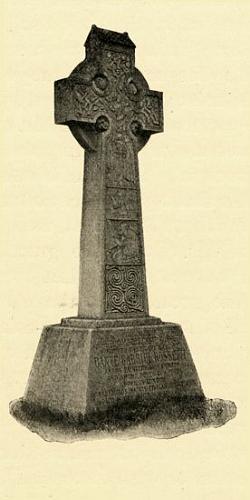
Figure: Photograph of DGR's headstone.
IN the
introductory chapter of this
book some mention was made of Rossetti's childish drawings, a large number of
which, owing to his mother's preservation of such relics, are still in
existence. Although these have no part or place by rights in an artistic record,
yet they are not without a certain personal interest, and as Mr. W. M. Rossetti
has kindly allowed me to look through
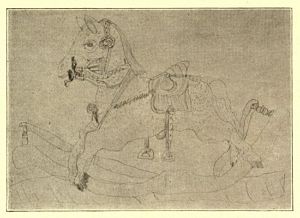
Figure: Pencil. Profile of a rocking-horse, facing left.
his collection and select some examples from it, no apology is needed
for introducing them here for the benefit of any who may care to know what
Rossetti's first efforts in art were like. Perhaps the earliest drawing of all
is the one connected with the milkman, of which the story has already been told
(
see page 6). It is
reproduced here (not very successfully) on a much diminished scale,
and is a very fair representation of a
rocking-horse. It is dated1834, in Mrs. Rossetti's hand, and is
undoubtedly a
more than average good piece of work for a
child of barely six. The next drawing is of about the same date, and is taken
from
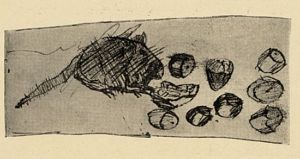
Figure: Pen and ink. Juvenile drawing. Side view of a dormouse facing
right, and several cracked nuts.
a tiny pocket sketch-book filled with pen-and-ink and coloured
drawings of heroes of romance. There is no doubt as to the source of origin of
the latter, which reveal a close study and intimate knowledge of the
old-fashioned theatrical prints which Gabriel and his brother spent much time in
colouring. The specimen reproduced here, however, is a more ambitious effort
from life, and is labelled in large childish writing which I regret has been cut
away:
Dormouse surnamed Dwanging
. The objects before this creature with the engaging
surname are nuts in various stages of fracture.
When the young Gabriel and his brother were beginning to learn Greek at school,
their sister Maria, who had a temporary affection for Pope's “Iliad,” resolved to learn Greek too. To please her, as Mr. Rossetti
records
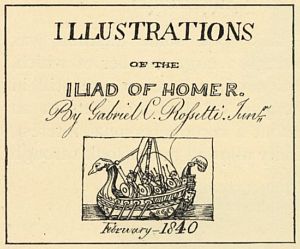
Figure: Pen and ink. Inscribed above illustration: "ILLUSTRATIONS OF THE
ILIAD OF HOMER By Gabriel C. Rossetti. Junr." Inscribed below
illustration: "February 1840." Title page for DGR's Illustrations of the
Iliad of Homer. Centered in a box under the title is a Greek warship
with oars.
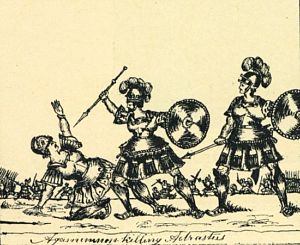
Figure: Pen and ink. Inscribed below drawing: "Agammemnon killing
Adrastus." Juvenile drawing of three ancient Greek soldiers. Adrastus
has fallen to the ground with his left arm raised. Agammemnon holds a
spear over him and a shield in his right hand, while another soldier,
spear and shield in hand, looks on.
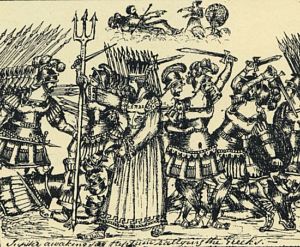
Jupiter awaking sees Neptune rallying the Greeks
Figure: Pen and ink. Inscribed below drawing: "Jupiter awaking sees Neptune
rallying the Greeks." Juvenile drawing. Neptune is in the center holding
a trident, facing left, while behind him Greek soldiers fight. Above the
scene, Jupiter reclines on a cloud, one arm reaching toward Juno
standing before him with both arms outstretched. Juno's peacock stands
behind her.
in his “
Memoir,” Gabriel undertook to illustrate the entire work in pen-and-ink, one
drawing to every book. These are in small loose pages, arranged like a pack of
cards, the top one being the title-page
reproduced here. There is a considerable sameness
of design running through the pictures, and not much evidence of originality. I
give two of them, however, side by side, as representative specimens.
[illustration 1]
[illustration 2] They depict “
Agamemnon killing Adrastus,“ and “
Jupiter awaking sees Neptune rallying the Greeks.”
The next drawing has really some slight literary interest, of a juvenile kind,
inasmuch as it illustrates a quartette of stories by the
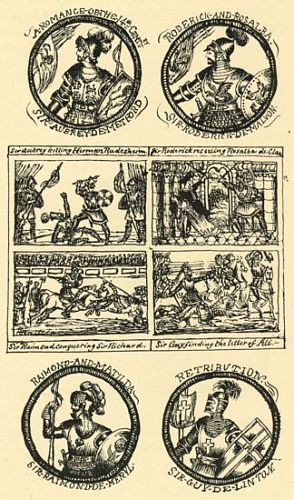
DESIGNS FOR TITLES OF NOVELS
Figure:
A ROMANCE OF THE 14TH CENTURY. SIR AUBREY DE METFORD.
Pen and ink. Small circle with a 3/4 view of a knight in full
armor, carying a shield in his left hand, his flag to the left of the drawing.
RODERICK AND ROSALBA. SIR RODERICK DE MALVON.
Pen and ink. Small circle containing a 3/4 view of a knight in full
armor, his sheild in his left hand and his right arm outstretched.
Sir Aubrey killing Herman Rudesheim
Pen and ink. Two knights fighting in the center. One holds the
other down with his foot while raising an axe overhead. The downed
knight has one arm raised to ward off the blow. Flanking the two are
rows of men carrying spears.
Sir Roderick rescuing Rosalba de Clara
Pen and ink. A knight swordfights with a man holding a limp woman
in an ornate room full of columns.
Sir Raimond conquering Sir Richard
Pen and ink. Two knights on horseback joust, ringed by spectators.
Sir Guy finding the letter of Ali
Pen and ink. A knight on foot confronts three knights on horseback.
One man has fallen at the knight's feet.
RAIMOND AND MATILDA. SIR RAIMOND DE MERYL
Pen and ink. In a circle, 3/4 length drawing of Sir Raimond in full
armor, holding a shield in his left hand and a spear in his right.
RETRIBUTION. SIR GUY DE LINTON
Pen and ink. In a circle, 3/4 length view of Sir Guy in full armor,
a shield with a cross in his left hand, and another behind him to his
right.
entire Rossetti family. Mr. William Rossetti says that in 1840 a great
scheme was started that each of the four should write a romantic novel. The
designs here given represent the titles of each with an illustration of some
leading incident immediately above or below it. Maria Rossetti's tale was “Sir Aubrey de Metford: a Romance of the Fourteenth
Century”; Gabriel's was
“Roderick and Rosalba: a Tale of the Round Table”; William Rossetti's was “Raimond and Matilda”; and Christina's, rather characteristically, I think, bore the grim
legend, “Retribution”. The only one of the four tales that was ever finished was
Gabriel's
“Roderick and Rosalba”, which, according to Mr. Rossetti, began as follows:
“ It was a dark and stormy night in the month of December when a
figure closely wrapped in the sable folds of his coat, and mounted
on a jaded steed, was seen hurrying across a bleak common towards a
stately castle in the distance, whose lofty towers and time-worn
battlements frowned over the wide expanse beneath.”
The felicitous choice of epithets in this passage shows that by the age of eleven
Gabriel Rossetti had at any rate mastered the fundamental principles of romance.
His imagination, moreover, must have been prolific if he could afford to
squander so many ingredients of his subject on the opening sentence.
The next illustration is three years later in date and very Early-Victorian in
design. It belongs to a story called
“Sorrentino”, in which Rossetti evidently took himself and his literary aspirations
very seriously. The following quotation from a letter of 1843, addressed to his
mother, is I suppose the
locus classicus upon this little-known production:
“I have not written anything new lately except a third chapter of
“Sorrentino”; an unfortunate work, the tribulations whereof have been so many
and so great that if the approbation of others were the only
encouragement to an author to continue his literary labours, the romance
in question would long since have found its way behind the grate.
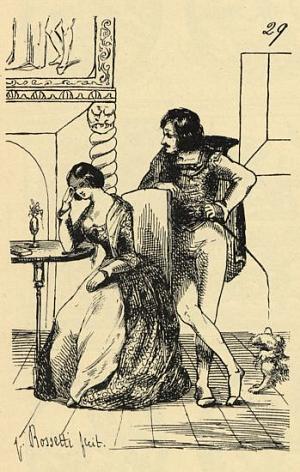
Figure: Pen and ink. Signed lower left: "G. Rossetti fecit."
Inscribed upper right corner: "29." The drawing depicts a medieval scene with a woman,
supporting her head in her right hand, seated at a table
(on which there is a book and a vase of flowers) before
a fireplace; a man stands behind her, in front of a
window, his left hand on his hip, his right arm resting
on the back of her chair, his legs crossed; a King
Charles spaniel stands at his feet. Fredeman (A
Rossetti Cabinet), p. 13
. . . No one, however, pretends to deny that it is my
chef-d'œuvre, an opinion in which I hope you will coincide after having
perused it. The charge of indecency can no longer be laid upon the
former portion with any show of reason, since I have purged and purified
it most effectually, and burnt up the chaff with unquenchable fire. On
the completion of this work I intend offering it to some publisher, for,
defying all accusations of vanity and self-esteem, I cannot help
considering that it is equal to very many of the senseless productions
which daily issue from the press.”
Mr. William Rossetti says that
“Sorrentino” was a story of
diablerie, in which Mephistopheles, somewhat on the lines of
Faust, interferes between a lover and his lady. The author's opinion of his
handiwork, as expressed in the faultless phrases of the letter just quoted,
cannot be said to err upon the side of self-flattery.
Somewhere about 1845 Rossetti tried his hand at lithography. The experiment was
not strikingly successful, but a few interesting results remain, of which one or
two are reproduced here as curiosities. The
design for
Soulié's “Juliette
” is a mere piece of drawing-school work, careful enough, but quite
unoriginal. A set of punning court-cards show greater individuality, and
invention of a queer kind for Rossetti. The two specimens here illustrated
represent
Death as the King of Spades, and
Erin as the Queen of Clubs.
[King of Spades]
[Queen of Clubs] Some of the others are political
skits, representing Peel with a “free trade” halo round his head, as the
Knave of Spades;
the Prince
Consort as the Knave of Diamonds
;
Louis
Philippe as the King of Diamonds
, and
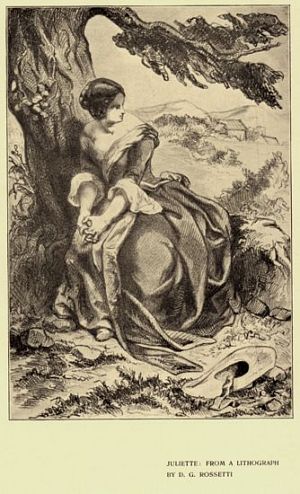
Juliette: From a Lithograph By D. G. Rossetti
Figure: lithograph. Study of a girl (Juliette, from Frédéric Soulié's novel
Les Memoires du diable) sitting by a tree with her hands clasped, looking over
her left shoulder. Her hat lies on the ground beside
her.Surtees, p. 3
the Queen (on a coin) as the Queen of Hearts.
A bust of Shakespeare served as the King of Hearts,
and a conventional puppet
Punch as the King of
Clubs
. There was some talk of finding a publisher for these, but nothing
came of it, and they survive merely in the form of
one
or two copies of the sheets taken from the stone
.
The next drawing, dated September, 1846, recalls an early visit to France, and is
a record of some never-to-be-forgotten
chambermaid,
equipped with the indispensable but ruinous
bougie. Gabriel at a later date recorded his impressions of the kind of
Frenchwomen he encountered at Paris in verse that, like the luckless
“Sorrentino”,
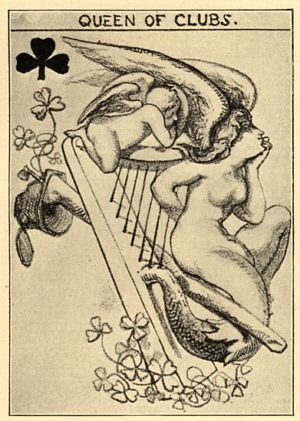
Figure: Pen and ink and watercolor. Inscribed at top: "QUEEN OF CLUBS."
Sketch of a winged woman (Erin) with a human left leg and a mermaid-like
right leg that bends behind her and becomes part of the harp growing
from her back. Cupid rests on top of the harp. Shamrocks decorate the
bottom and left side of the card.
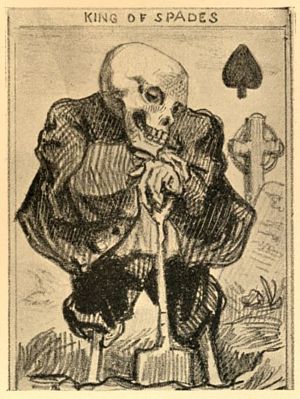
Figure: Pen and ink and watercolor. Inscribed at top: "KING OF SPADES." A
figure of Death with a skeleton head, legs and hands, leans on a shovel
in a graveyard.
requires to be purged and purified for publication. His previous ideas
upon the subject had been derived from Gavarni, for whose artistic style he
developed a youthful admiration. But a ball at Valentino's destroyed his
illusions. “As for Gavarni,” he afterwards exclaimed in a letter, “he is
a liar, and the father of it.” I have already mentioned the diary in
verse and other humorous effusions arising out of this trip to France with Mr.
Holman Hunt. They constitute an interesting
dossier by themselves, and an effectual rejoinder to any suggestion that
“irresolution with melancholy lay at the basis of Rossetti's
character.”
The year 1847 marks, according to the classification I have adopted, the close of
Rossetti's juvenile period and pupilage. In
this year he produced, among other things,
five drawings in pencil which were bound into a copy of the privately
printed
Verses by Christina Rossetti. One of these is a
profile of Christina
Rossetti
herself, and the other four
[illustration for "The Ruined Cross"]
[illustration for "Tasso and Leonora"]
[illustration for "The Dream"]
["Lady Isabella"] are illustrations to the poems.
The book was presented by the authoress in 1854 to her mother, and in 1880 to
Mr. W. M. Rossetti, who has pointed out the main characteristic of the drawings,
viz., that they show no feeling whatever for clothes, which are represented in
the male figures by a mere line at the neck
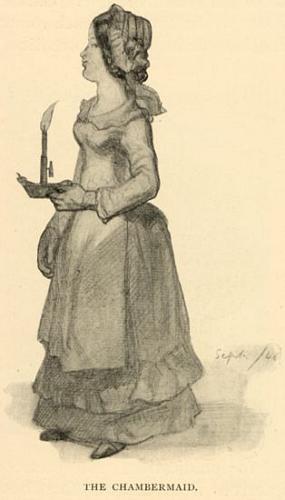
THE CHAMBERMAID.
Figure: Pencil. Date at lower right: "Sept. /46." Young woman, whole-length
in profile to left, holding a candle.
and the wrists. At the same time, however, Rossetti was engaged upon a
much more ambitious effort, a fairly large oil painting of a girl with downcast
eyes walking in a chapel beside an elderly priest, who holds a crucifix before
her, and at the same time makes a sign of benediction with his upraised hand.
The devil, dressed as a man, with horns and tail, was represented slinking
behind in an abject attitude. The title of the picture was
Retro me Sathana
. On its being shown to Sir Charles Eastlake in an unfinished state, he
objected to the subject, and it was not gone on with. I have discovered,
however, in the possession of Dr. Munro, a
pen-and-ink
drawing
of the picture just as it is described, dated “July
1848.” This has been reproduced in Chapter II. among the examples of
Rossetti's “Pre-Raphaelite” work, and will be found
facing page 17. There is no reference to it in the text, as it had
not been discovered when the latter was printed.
The next two or three sketches are of a later date, and show our artist in the
light of a caricaturist. Not a specially good one, it is true, but still gifted
with a certain energy of expression which corresponded to his literary style.
There are many little skits by him, jotted down on odd scraps of paper or
contained in letters, like this of Millais, done in 1850, or like the two
figures below represent-
ing himself and his brother on some memorable occasion in 1853.
The portrait of himself has some slight foundation in fact, and
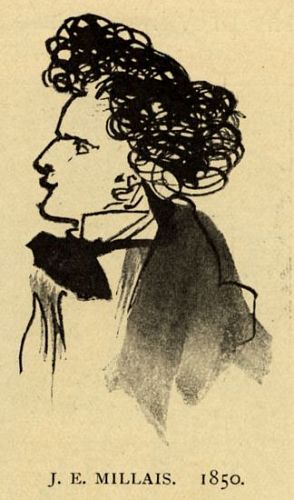
J. E. Millais. 1850.
Figure: Pen and ink. Sketch of head and shoulders turned to left, wearing a
stand-up collar; the head is in profile.Surtees, p. 173 Assumed to be S353.
might almost be called recognizable; but not even the sartorial
fashions of the mid-century, it is to be hoped, could ever have made his brother
look quite so much like a funeral mute.
Somewhere about 1852 the sentimental afflictions of “Uncle Tom” took the world by storm. They left Rossetti cold; in fact, he could not
by any stretch of effort read the book. But he wrote a “
rather charming parody of Old Uncle Ned” on the subject, which was published at the end of last year in the
“
Pall Mall Magazine.” The first verse, which is a sample of the whole, runs as follows:
- “Dere was an old nigger, and him name was Uncle Tom,
- And him tale was rather slow;
- Me try to read de whole, but me only read some,
- Because me found it no go.
- Den hang up the author Mrs. Stowe,
- And kick de volume wid your toe—
- Dere's no more public for poor Uncle Tom,
- He am gone where de trunk-linings go.”
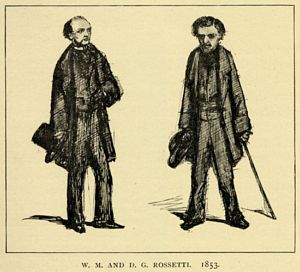
W. M. and D. G. Rossetti. 1853.
Figure: Pen and ink. Whole-length figures of the brothers, slightly caricatured.
On the left, turned to the right, William Michael stands holding
a hat in his right hand. Gabriel stands with legs apart, holding
a soft felt hat in his right hand and a stick in his
left.Surtees, p. 209
This skit was accompanied by a fancy
sketch of “poor Uncle Tom,” with a banjo, which was
also reproduced in the “
Pall Mall
Magazine.” Here are two other comic drawings
[drawing
1]
[drawing 2] of the same period, representing
Rossetti's fears of what might be a possible outcome of the prevailing “nigger
craze”.
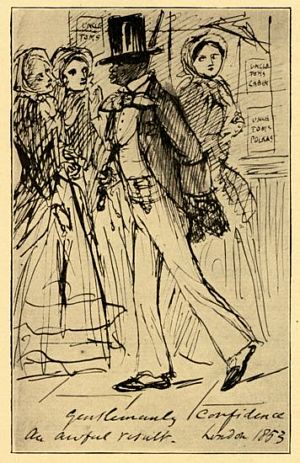
Gentlemanly Confidence: An awful result
Figure: Medium unknown. Inscribed at bottom: "Gentlemanly Confidence: An
awful result. London 1853." Signs on the wall read: "Uncle Toms," "Uncle
Toms Cabin," "Uncle Toms Polkas." Sketch of a black man, slightly
caricatured, whole-length in profile facing left, walking past three
white women sketched lightly in the background.
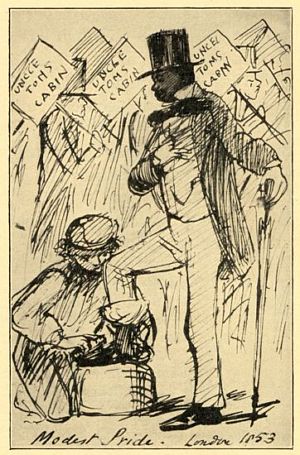
Modest Pride
Figure: Medium unknown. Inscribed at bottom: "Modest Pride. London 1853."
Placards read: "UNCLE TOMS CABIN." Sketch of a black man slightly
caricatured, whole-length in profile to left, having his shoes shined by
an adolescent white boy. Disgrunted-looking men carrying placards are
sketched in the background.
“I went to the Belle S. the other day”—writes Rossetti in 1854 to William
Allingham, meaning the ‘Belle Sauvage‘ tavern where he lunched—“and was
smiled on by the cordial stunner, who came in on purpose in a lilac walking
costume.
I am quite certain she does not regret you at
all!
” Elsewhere he talks of “a stunner, the Marchioness of
Waterford,” who had come to call upon him; and Dr. Birkbeck Hill
recalls the outcry that there was on one occasion when he ventured to suggest in
the company of Rossetti and his friends that a rather pretty murderess should be
hanged. “Oh, Hill,” was the reproachful answer, “you would never hang a
stunner!” The adjective “stunning” in a Pre-Raphaelite's vocabulary
was, as we have already noted, a broad antithesis of the generic term “slosh.”
The above three quotations show that the noun was limited to a narrower
significance, and meant implicitly a pretty girl. At some time in his salad days
Rossetti seems to have begun a gallery of these attractive creatures, and the
rough outline drawing labelled
Stunner No. 1
is the first of the series. The
nose, chin, and upper lip, being specially
notable features, have been made the most of by the artist.
There is a little water-colour sketch called
Writing on the Sand
, now preserved in the Print Room of the British Museum, which I have
reproduced here rather than in the main body of
the book, because it is quaint enough to be regarded as humorous. At the same
time, I dare say that it would not have appeared equally quaint to eyes
accustomed to the daily sight of men with Dundreary whiskers and women arrayed
in hoops and “Garibaldis.” Were the standard of costume to be pressed too
closely, Madox Brown's
Last of England
and Millais's
Huguenot
might come beneath the same ban. The date of this drawing is, roughly
speaking, 1857. It was done at No. 17, Red Lion
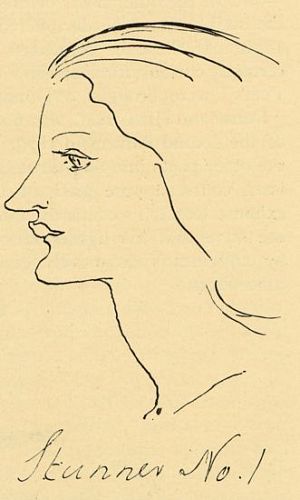
Figure: Pen and ink. Inscribed below sketch: "Stunner No. 1." Outline
sketch of woman's face, left profile.
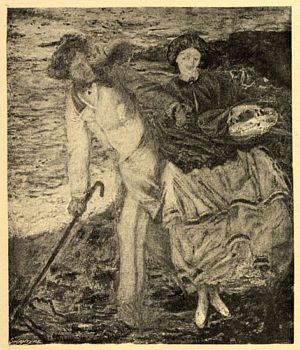
Figure: Watercolour. Man and woman walking along the shore; he is drawing a
female profile in the sand with his walking stick.
Square, during the joint tenancy of William Morris and Burne-Jones,
and it may be of interest to note that the man is a portrait of Mr. Richard R.
Holmes, the librarian to Her Majesty at Windsor, who at the date in question was
twenty-two years old. When Mr. Holmes sat (or rather stood) to Rossetti for it,
the figure of the woman and the background were already painted. It will be
noticed that the man is tracing a rough outline of the lady's face in the sand
with his stick.
The last drawing which I shall give under this heading is a
humorous pen-and-ink sketch by Rossetti of
“
Dante and his Circle” —and all the other poets before Dante with
their
circles. Beneath the scribble may be deciphered the word “London” and the year
1858. If these be connected with the drawing itself, the date is certainly
curious, for Rossetti's translations from
The Early Italian Poets were brought out under that title in 1861, and the title
Dante and His Circle was not given to them until the publication of the second edition in
1873. The notion of making Dante and the other poets jumping through their
circles, like clowns at a circus, is of course a pure piece of fun. These do not
by any means exhaust Rossetti's comic drawings, but they are enough to indicate
the style that his lighter fancy took, and show that he was not by any means
exclusively given over to morbid or melancholy conceptions.
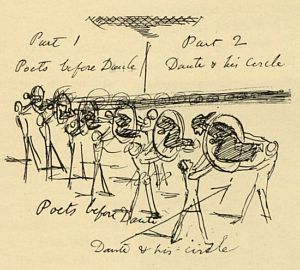
Figure: Pen and ink. Inscribed at top: "Part 1 Poets before Dante / Part 2
Dante & his Circle." Dated center: "1858." Inscribed at bottom:
"Poets before Dante / Dante & his circle." Humourous rough
sketch of poets featured in
The Early Italian Poets jumping through hoops (circles).
On page 237, volume i., of Mr. W. M. Rossetti's “
Memoir,” is quoted a letter from the late Sir Edward Burne-Jones, then
at Venice, in which he says: “The other day I saw a letter of
Titian's. The handwriting was, absolutely, exactly like yours, as
like as a forged letter of yours could be; the whole writing a
little bit bigger, I think, but the shapes of the letters as exact
as could be.”
As to this fancied similarity between Rossetti's handwriting and Titian's I
am unable to speak; but the resemblance if true would be interesting,
because of all the old painters Titian is perhaps the one that Rossettti
most nearly approached in his capacity as a colourist. Independently of
this, it may be worth while to include some specimens of Rossetti's
handwriting at different dates, and for this purpose I have selected three
examples from the collection belonging to Mr. Fairfax Murray. These are,
first, a couple of verses, numbers 5 and 6, from the earliest original draft
of
“The Burden of Nineveh”, begun about 1850, and first printed in the “
Oxford and Cambridge Magazine” in 1856 (pp. 771-775). The second specimen is from verse 7 of the
same poem, a later interpolation on the opposite page of the manuscript
book—or the blank portion of the same page, I forget which. The difference
between the two styles is quite perceptible, and if the earlier portion
dates from about 1850, the interpolated verse would belong to some
succeeding year not later than 1856.
In constrast to these examples I give one of very considerably later date.
This is the little poem
“Adieu”, written, or at all events transcribed in 1880, as near as one can
tell. It was published in “
Ballads and Sonnets,” 1881. The signature attached to the frontispiece is taken from a
letter of 1862, and is a fair average of most that I have seen. Rossetti,
however, at times took to interlinking the curves of the D and the G, a
habit which, his brother informs me, was partly adopted in consequence of a
forgery practised on him or his bank. Perhaps it was only revived or
specialized in this connection, because instances of it occur in letters of
quite early date, long before Rossetti could boast of a banking account.

Figure: Handwriting sample from The Burden of
Nineveh, c. 1850. Stanzas numbered 5 and 6.
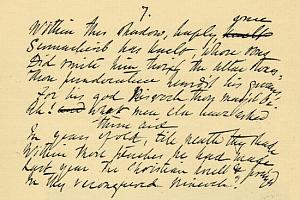
Figure: Handwriting sample from The Burden of
Nineveh, c. 1855-6. Stanza number 7.
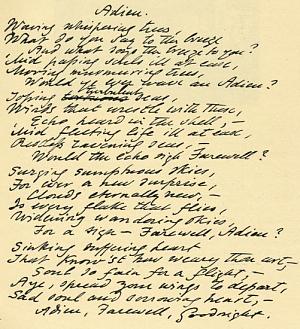
Figure: Handwriting sample from “Adieu”,
written c. 1880. Four stanzas.
As a good deal of interest attaches to Rossetti's Chelsea house, and to the
many legends and associations connected with it, some additional notes upon
this subject may not be altogether out of place. The house has been
considerably altered in appearance, either before or during its late
occupation by the Rev. H. R. Haweis, among other additions to it being a
conventional statue of Mercury poised on the ball at the top. The brickwork
of the front had an older, more natural look in Rossetti's day, and was
devoid of such excrescences as centrepiece and bay-windows. The pen-and-ink
sketch reproduced earlier (see p. 120) shows as well as anything could
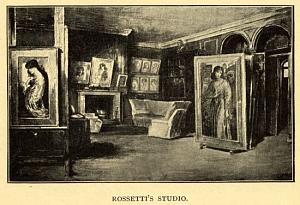
ROSSETTI'S STUDIO.
Figure: Medium unknown. Detail of the interior of Rossetti's studio.
The walls are lined with paintings;
Proserpina is visible on the left the later version of
The Salutation of Beatrice is seen on the right. The room features a sofa, fireplace,
and bookshelves.
what the house was like from the outside. In front the unembanked
river, and what Mr. W. M. Rossetti calls “the boating bustle and
longshore litter of the old days” added picturesqueness to the
view, which in all essentials was the same as the aged Turner had looked out
upon from his little house not very far away. The only bridge along the
reach was old Chelsea bridge, concerning which Mr. George Meredith tells me
a pleasant story: One day there called on Rossetti a pompous individual of
the vestryman class, with a paper to which he requested his signature.
“We are getting up a petition,” he said, “to replace the old
wooden bridge by a handsome new iron one, with gilt decorations, and I
am sure that you as an artist, Mr. Rossetti, will lend us the weight of
your name for so desirable an object.” Rossetti's language, on
occasion, could be more forcible than polite, and his unvarnished reception of
the vestryman's proposal caused that rash but well-meaning
person to retire with extreme precipitation. The inside of the house was a
little gloomy, partly from want of keeping up, and partly also because of
the accumulation of old and sombre furniture. Rossetti's assistant, Mr.
Treffry Dunn, made a set of water-colour drawings of the principal rooms in
the house, perhaps after Rossetti's death, though on this point I am not
sure. These drawings I am fortunately able to reproduce.
[Drawing 1: Rossetti's Studio]
[Drawing 2: Drawing-Room]
[Drawing 3: Rossetti's Bed]
[Drawing 4: Dining-Room] They are the only
existing records of the interior as it used to be, and consequently are of
great interest.
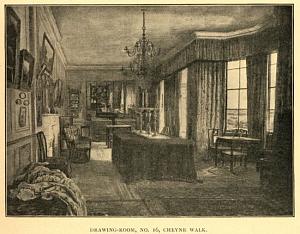
DRAWING-ROOM, NO. 16, CHEYNE WALK.
Figure: Medium unknown. Long view of a rectangular room with long
windows on the right and many paintings on the left wall. A draped
rectangular table topped with large candelabra is at the center of
the room. A partitioned mirror hangs at the back wall. Several
chairs and small tables are scattered about the room.
The hall, which was tiled with white marble, and lighted only by a
fanlight over the front door, led directly into a large room at the back
which served as Rossetti's studio. The sketch gives a fair idea of its
general arrangement. At one time, doubtless when his eyesight was failing,
Rossetti grew dissatisfied with the lighting of this room, and contemplated
all sorts of very elaborate changes. Finally he contented himself with
raising the mullioned window which overlooked the garden, up to the height
of the ceiling. On the floor above was Rossetti's bedroom, and the
drawing-room, a fine spacious apartment running the entire length of the frontage.
The bedroom has been described as
follows by Mr. Caine, who was taken into it on the occasion of his first
visit to Rossetti in 1880:
“It was entered from another and smaller room, used as a
breakfast-room. This outer room was made fairly bright and cheerful
by a glittering chandelier (the property once, he said, of David
Garrick), and from the rustle of trees against the window pane one
perceived that it overlooked the garden; but the inner room was dark
with heavy hangings round the walls as well as the bed, and thick
velvet curtains before the windows, so that candles seemed unable to
light it and voices sounded thick and muffled.
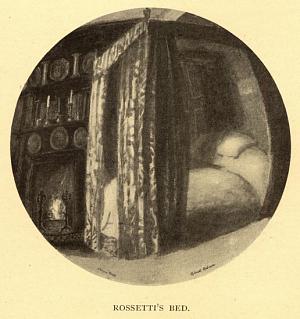
ROSSETTI'S BED.
Figure: Medium unknown. Inscribed at bottom: "Cheyne Walk /
Gabriel's Bedroom" [?]. The curtained bed is shown as viewed
in a convex mirror. A fireplace and shelves displaying china
and candlesticks are visible to the left of the bed.
An enormous black oak chimney-piece of curious design,
having an ivory crucifix on the largest of its ledges, covered a
part of one side and reached to the ceiling. Cabinets and the usual
furniture of a bedroom occupied places about the floor; and in the
middle, before a little couch, stood a table on which was a wire
lantern containing a candle. . . . I remarked that he probably
burned a light all night. He said that was so. ‘My curse,’ he
added, ‘is insomnia. Two or three hours hence I shall get up and
lie on the couch, and, to pass away a weary hour, read this
book.’ It did not escape me that on the table stood two
small bottles, sealed and labelled, together with a little measuring
glass. Without looking further at it, I asked if that were his
medicine. ‘They say there is a skeleton in every cupboard’,
he said in a low voice, ‘and that's mine; it is
chloral.’ ”
The bed
here depicted, as in a convex mirror,
with curtains round it, is the one which stood in this gloomy chamber, and
which Rossetti used to the end of his life. It was sent to him by his mother
on his settling at Chelsea, and is the one in which he and his brother and
sisters had all been born.
The garden at the back of the house, over an acre in extent, has been
described already, and a view of it will be found on
page 121. It was approached by a short avenue of lime trees, and
then opened out into a broad grass plot—“a wilderness of verdure and
flowers.” It contained a fine mulberry tree and other fruit
trees,
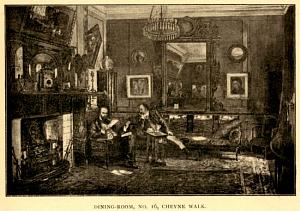
DINING-ROOM, NO. 16, CHEYNE WALK.
Figure: Interior water-colour by Dunn of the Dining-room. Rossetti sits
to the left before the fireplace reading to Watts who reclines on
the settee to the right. A mirror hangs over his head and reflects
the length of the room otherwise unpresented.
which were left to take care of themselves, as were the weeds and
flowers, the generally neglected condition being charged, according to Mr.
Caine, upon “Watts's reluctance to interfere with nature in her
clever scheme of the survival of the fittest.”
In this garden were kept most of the animals for which Rossetti had such a
curious and indiscriminate affection. How many of them there may have been
at any one time does not seem to be stated; but as one died or disappeared,
another would be got to replace it, or Rossetti would see some particularly
outlandish specimen at Jamrach's and bear it home in triumph to add to the
collection. Wire cages were erected for their accommodation, but
these were not always proof against
escape, especially in the case of the burrowing animals, which had an
annoying way of appearing in the neighbours' gardens. Mr. W. M. Rossetti has
given from memory a tolerably long list of creatures which at one time or
another figured in the menagerie at Cheyne Walk. They included a Pomeranian
puppy, an Irish deerhound, a barn-owl named Jessie, another owl named Bobby,
rabbits, dormice, hedgehogs, two successive wombats, a Canadian marmot or
woodchuck, an ordinary marmot, kangaroos and wallabies, a deer, two or more
armadillos, a white mouse with her brood, a raccoon, squirrels, a mole,
peacocks, wood-owls, Virginian owls, horned owls, a jackdaw, a raven,
parakeets, a talking parrot, chameleons, grey lizards, Japanese salamanders,
and a laughing jackass. Besides these there was a certain famous bull, a
zebu, which cost Rossetti £20 (he borrowed it from his brother), and which
manifested such animosity in confinement that it had to be disposed of at
once. The strident voices of the peacocks were so little appreciated in the
neighbourhood that Lord Cadogan caused a paragraph to be inserted in all his
leases thereafter forbidding these birds to be kept.
The wombats perhaps were prime favourites, and seem to have developed a small
cult outside their immediate surroundings. Some funny little sketches of
these ungainly creatures will be remembered in last winter's exhibition of
Sir Edward Burne-Jones's work at the Burlington Fine Arts Club. Bell Scott
also made an etching of the Chelsea wombat, and no less a poetess than
Christina Rossetti has hymned its qualities in the following lyric, which
was a priceless joy to Rossetti at the time:
- “O Uommibatto
- Agil, giocondo,
- Che ti sei fatto
- Liscio e rotondo!
- Deh non fuggire
- Qual vagabondo
- Non disparire
- Forando il mondo:
- Peso davero
- D'un emisfero
- Non lieve il pondo.”
Rossetti himself was more than devoted to the little oddity. Before its
arrival he penned, from the northern recesses of Penkill Castle, where he
was staying, the following
anticipatory ode of
welcome
:
- “O how the family affections combat
- Within this heart, and each hour flings a bomb at
- My burning soul! Neither from owl nor from bat
- Can peace be gained until I clasp my wombat.”
A few days after its realization he wrote: “The Wombat is a
Joy, a Triumph, a Delight, a Madness!” regretting at the same time its
inveterate inclinations towards “drain architecture.” When it
deceased in the natural course of things, according to his brother,
“his heart was sair.”
This devotion to quaint animals was shared by Rossetti's family and by many
of his friends. When Burne-Jones and Morris were living at Red Lion Square,
and Rossetti was in rooms at Blackfriars, the Zoological Gardens were a
constant resort of all three. The accompanying sketch of the great seal
expecting his dinner is a relic of those days, and was probably one of many
such. Oddly enough, with the exception of apes once or twice, the cat
in
Fra Pace
, and the fawn in
Mary Magdalene at the Door of Simon
, Rossetti never seems to have had any inclination to introduce
animals into pictures. He reserved them exclusively for his private life, of
which they formed, as the above notes show, a characteristic and remarkable
feature.
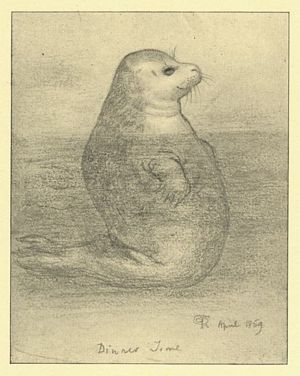
Figure: Pencil. Monogram and date lower right: April 1859." Inscribed
lower center: "Dinner Time." A seal, partly submerged in the water, waiting for its
dinner.Surtees, p. 210
 page:
page: 233
A List of Paintings, Drawings, and more important Studies
by Dante Gabriel Rossetti ; based in part upon the previous
Lists of Mr. William Sharp, Mr. J. P. Anderson, and Mr.
W. M. Rossetti,
but revised and considerably amplified.
In the following List, as distinguished from previous ones,
studies are in most cases catalogued under the heading of the picture they
belong to, instead of separately. An exception is made when the studies
themselves are so important as to rank as separate works.
The initials [S.], [K.], [W.M.R.], in square brackets, signify that an entry or
statement has been adopted from one or other of the previous lists without
independent verification. *An asterisk denotes that the subject is illustrated
in the book.
The abbreviations, R.A., 1883, and B.F.A., 1883, refer to the two large
exhibitions of Rossetti's work, held in the year following his death at
Burlington House and at the Burlington Fine Arts Club respectively, the
catalogue numbers being given as well for convenience of reference.
The dates given are as far as possible those on the pictures ; the dimensions are
in many cases taken from catalogues of sales and exhibitions, and verification
shows that these are not to be entirely depended on. They refer, however, as a
general rule, to the “sight size” of the picture inside the frame, the height
being taken before the width.
It has been thought best to give Portraits in a separate list from Pictures, and
to weed out a number of very indefinite items, such as
Head of a
Lady
,
Female Study, etc., which, besides being
useless for purposes of identification, do not represent any consider–able
proportion of the heads and studies which exist, and which it would be quite
impossible to catalogue.
The present as well as the past owner of pictures are given in all cases where
they could be ascertained. Since the great sales of the Graham, Leyland,
Leathart, and Turner collections, this represents a task of no ordinary
difficulty, and even with the help of so obliging a firm as the Messrs. Agnew
the list remains incomplete in this respect.
NO. DATE. PAGE. SUBJECT OR TITLE.
- 1. 1834 to 1847.
6,
211 *Juvenilia and Student's Sketches. (Various.) Most of
these which still exist are in the possession of Mr. W. M. Rossetti.
- 2. 1848.
24
The Sun may Shine and We be Cold. (Pen-and-ink. 8x6 3/4 in.) Dated May, 1848. “Given by
Dante G. Rossetti to his friend, Alex. Munro.” Exhibited, B.F.A., 1883, No.
27. In the possession of J. A. R. Munro.
 page:
page: 234
- 3. 1848.
24,
73 *
Gretchen and Mephistopheles in the Chapel. (Pen-and-ink. 10 3/4 x 8 1/8 in.) In the possession of Dr.
H. A. Munro. Signed, “G.C.D.R. (monogram), July, 1848.” Exhibited, B.F.A.,
1883, No. 101. Dr. Munro has also * a different, less finished
drawing of same subject, 12 3/4 x 7 in., signed
“Dante G. Rossetti, 1848.”
- 4. 1848.
17,
216 *
Retro me Sathana. (Pen-and-ink. 9 5/8 x 6 7/8 in.) Same design as an
oil painting begun in 1847 and abandoned.
In the possession of Dr. H. A. Munro.
- 5. 1848.
23 *
Genevieve (from Coleridge). (Pen-and-ink. 10 1/4 x 5 1/2 in.) Given to Coventry
Patmore, and by him to Sir E. Burne-Jones. Given by Lady Burne-Jones to C.
F. Murray. Exhibited, B.F.A, 1883, No. 99. Inscribed with title and
monogram, “G.C.D.R., August, 1848.”
- 6. c. 1848.
23
Ulalume (from E. A. Poe). (Pen-and-ink. 9 5/8 x 7 5/8 in.) Former, Lowes
Dickenson. Present owner, C. F. Murray (since June, 1888).
- 7. c. 1848.
24
The Raven (from E. A. Poe). (Pen-and-ink.) Crude design in the possession of Dr.
H. A. Munro, dated “June, 1848” (?).
Another,
of different composition, is in the possession of C. F. Murray.
- 8. 1848-9.
144 *
Michael Scott's Wooing. (Pen-and-ink. 7 1/8 x 8 1/4 in.) Design for picture.
Inscribed “D.G.R., 1853, to A.M.” (Alex. Munro). Title in lower l. c.
Exhibition, B.F.A., 1883, No. 37, by J. A. R. Munro. Mr. C. F. Murray also
has an early
pen-and-ink design. Cf. No. 182
(1866).
- 9. 1848-9.
21 -
23 *
The Girlhood of Mary Virgin. (Oil. Panel, 33 x 25 in.) Former owners, Marchioness of
Bath, Lady Louisa Feilding. Present owner, Mrs. Jekyll. Free Exhibition,
Hyde Park Corner, 1849, No. 27. Signed and dated, “Dante Gabriele Rossetti,
P.R.B., 1849.”
- 10. 1849.
34
Taurello's First Sight of Fortune (from “Sordello”). (Pen-and-ink. 9 7/8 x 10 1/8 in.) Owner, F. G.
Stephens. Inscribed, “Frederic G. Stephens, from his P. R. Brother, Dante G.
Rossetti.” Exhibited, B.F.A., 1883, No. 21 ; New Gallery, 1897-8, No. 34.
- 11. 1849.
36,
197
The First Anniversary of the Death of
Beatrice (Dante drawing the
Angel)
. From the “Vita Nuova.” (Pen-and-ink.
11 1/2 x 10 7/8 in.) Early finished drawing : given by “Dante G. Rossetti to
his P. R. Brother, John E. Millais.” Present owner, C. F. Murray. Inscribed
above, “Florence, 9th June, 1291,” with title, and signed, “Dante G.
Rossetti, P.R.B., 1849.” Below, a quotation from Dante's “Autobiography of
his Early Life.” Cf. No. 30.
- 12. 1849.
33,
79
“Hist! said Kate the Queen” (from “Pippa Passes”). (Oil.) Abandoned. Cf. Nos. 20, 24, 25, 173.
- 13. 1849.
Dorothy and Theophilus. (Pen-and-ink.) Formerly belonged to J. P. Seddon. Present
whereabouts unknown.
- 14. 1849.
34 *
The Laboratory (from Browning). (Water-colour. 7 5/8 x 9 1/2 in.) Formerly in
possession of W. B. Scott. Present owner, C. F. Murray. Exhibited, B.F.A.,
1883, No. 2.
- 15. 1849 and 1850.
24,
87 *
Il Saluto di Beatrice (First design for Diptych of Dante and Beatrice).
(Pen-and-ink. 14 3/4 x 25 3/4 in.) Cf. Nos. 27, 89-91, 157-8. Owner, George
Rae. Exhibited, B.F.A., 1883, No. 33. Right compartment dated 1849 ; left,
1850. In centre a figure of Love with down-turned torch and dial recording
the date of Beatrice's death, “9 Giugno, 1290.” In the later versions the
grouping of both compartments is reversed.
 page:
page: 235
- 16. 1850.
25 -
27,
33,
154 *
Ecce Ancilla Domini. (Oil. Panel, 28 1/2 x 17 in.) Former owners, F.
MacCracken, J. Heaugh, W. Graham. Now in the National Collection (Millbank).
Exhibited, Portland Gallery, 1850 ; R.A., 1883, No. 288. Signed and dated,
“D.G.R., 1850.” The picture was very slightly retouched for W. Graham in
1873-5.
- 17. 1850.
35 *
Benedick and Beatrice (Last Scene of “Much Ado”). (Pencil. 10 1/2 x 14 1/4 in.) Design
for a water-colour. In the possession of the author.
- 18. 1850.
38
To Caper Nimbly in a Lady's Chamber to the
lascivious Pleasing of a Lute
. (Pen-and-ink. 8 1/4 x 6 3/4 in.) Early drawing for the
Borgia Group, No. 21. Former owner, G. P. Boyce. Present owner, C. F.
Murray. Exhibited, R.A., 1883, No. 342. Signed and dated.
- 19. c. 1850.
65
A Parable of Love. (Pen-and-ink. 7 1/2 x 6 5/8 in.) Design for picture. A
lady painting her own portrait, her lover (portrait of Woolner) guiding her
hand. Former owner, Coventry Patmore. Present owner, C. F. Murray.
Exhibited, R.A., 1883, No. 330.
- 20. 1850.
Rossovestita. (Water-colour. 9 5/7 x 7 1/4 in.) Signed, “Dante Rossetti fece in Londra, 1850.” Probably
a fragment of
Hist! said Kate the Queen. Former owner, F.
Madox Brown. Present owner, unknown. Exhibited, Portland Gallery, 1850 ;
121, Pall Mall, Winter Exhibition, 1852 ; B.F.A., 1883, No. 9.
- 21. 1851.
38 *
Borgia. (Water-colour. 9 1/2 x 10 in.) Cf. Nos. 18, 145. Former
owner, G. P. Boyce. Present owner, L. Hacon. Exhibited, R.A., 1883, No. 346
; New Gallery, 1897-8, No. 60. Signed with monogram and dated 1851.
Pencil sketch for little girl dancing, exhibited
New Gallery, 1897-8, No. 71. Lent by C. J. Holmes ; present owner, S. C.
Cockerell.
- 22. 1851.
36 *
Beatrice at a Marriage Feast denying her
Salutation to Dante
(“Vita Nuova”). (Water-colour. 13 3/4 x 16 3/4 in.) Owner, H. T.
Wells, R.A. Different composition and different incident from the other
Salutation pictures. Cf. No. 52. Exhibited, 121, Pall
Mall, Winter, 1852 ; B.F.A., 1883, No. 6 (wrongly dated 1849) ; New Gallery,
1898, No. 54.
- 23. 1851.
39
How they met Themselves. (Pen-and-ink.) First design. Destroyed or lost. See Nos.
93, 159.
- 24. 1851.
34 *“
Hist! said Kate the Queen.” (Oil. 22 1/2 x 12 in.) Small design in colour for No. 12.
Present owner, S. E. Spring-Rice. Exhibited, B.F.A., 1882, No. 12. This has
been wrongly described as a water-colour.
- 25. 1852.
34
Two Mothers. (Oil. 12 10 1/8 in.) Fragment of
Kate the Queen
, No. 12. Formerly in possession of J. H. Hutton. Exhibited, Royal
Manchester Institution, 1882 ; B.F.A., 1883, No. 7. Sold at Christie's,
June, 1887.
- 26. 1852.
39,
53 *
Giotto painting Dante's Portrait. (Water-colour. 14 1/2 x 18 1/2 in.) Cf. No. 84. Former
owner, Thos. Seddon. Present owner, John Aird, M.P. Exhibited, R.A., 1883,
No. 365. Signed and dated, “D.G.R., Sept, 1852.” A pen
drawing for the subject was executed in 1849 and exhibited, 121,
Pall Mall, Winter Exhibition, 1852.
 page:
page: 236
- 27. 1852.
87
Guardami Ben ; ben son, ben son Beatrice
(The Meeting of Dante and Beatrice in
Paradise
. (Water-colour. 11 1/2 x 9 7/8 in.) Subject of the left
compartment of triptych called
Il Saluto di Beatrice
(Cf. No. 15). Former owner, G. P. Boyce, by whom it was given to Mr.
Philip Webb. Inscribed, “D.G.R.,” and on frame, “Dante Div. Com. Purg.
XXX.,” with the Italian legend. Exhibited, B.F.A., 1883, No. 20. (Mr. C. F.
Murray has
sketch for Dante and a
fine study for the whole composition.)
- 28. 1853.
40,
47,
50 *
Hesterna Rosa. (Pen-and-ink. 7 1/2 x 9 1/2 in.) Finished early drawing.
Cf. Nos. 170, 241. Owner, F. G. Stephens. Signed and dated, “Dante Rossetti,
1853.” Inscribed with verses of the song from “Philip van Artevelde,” and
the words, “Composed 1850, drawn and given to his P.R. Brother, Frederick G.
Stephens, 1853.” Exhibited, P.R. Exhibition, Russell Place, 1857 ; R.A.,
1883, No. 334 ; New Gallery, 1897-8, No. 19.
- 29. 1853.
65
Fra Angelico painting, and
Giorgione painting from a Model. (Pen-and-ink. 6 7/8 z 4 3/8 in., and 4 3/8 x 6 7/8 in.)
Two rough sketches in one frame. Former owner, F. Madox Brown. Present
owner, C. Fairfax Murray. Exhibited, B.F.A., 1883, No. 102.
- 30. 1853.
36,
43,
50 *
Dante drawing the Angel. (Water-colour. 16 1/2 x 24 in.) Cf. No. 11. Former owners,
F. MacCracken, Thomas combe. Now at the Taylorian Museum, Oxford. Exhibited,
P.R. Exhibition, Russell Place, 1857 ; R.A., 1883, No. 362. Signed and
dated.
- 31. 1853.
42
Lo Marinaio oblia che passa per tal via. (Pen-and-ink.) A slight sketch only. Former owner, G. P.
Boyce. Present owner unknown. Another in the
possession of W. M. Rossetti.
- 32. 1853.
41 *
Girl singing to a Lute. (Water-colour. 8 7/8 x 4 1/8 in.) Former owner, J. Ruskin
; present owner, Mrs. Constance Churchill. Exhibited, B.F.A., 1883, No. 10.
Dated. A study in yellow.
- 33. 1853.
104
Carlisle Wall, originally called The Lovers.
(Water-colour. 9 x 6 1/2 in.) In the collection of the late H. V.
Tebbs. Signed and dated, “D.G.R. (monogram), Carlisle, 1853.” Exhibited,
R.A., 1883, No. 368 ; New Gallery, 1897-8, No. 62.
- 34. 1854.
Girl trundling an Infant. (Pen-and-ink. 7 1/2 x 6 1/2 in.) Formerly in Boyce
collection. Signed, “Coventry, July /53.” Exhibited, B.F.A., 1883, No. 118.
- 35. 1853.
44 Studies for Found. No. 1.
Study for the picture. (Pen-and-ink. 8 x 7
1/4 in.) Owner, Col. Gillum. Exhibited, Hogarth Club, 1859 ; B.F.A., 1883,
No. 1 ; New Gallery, 1879-8, No. 36. Frame inscribed, “I remember thee, the
kindness of thy youth, etc.” *No. 2.
Study for the
picture
. (Pen-and-ink. 8 1/4 x 7 1/2 in.) Owner, C. F. Murray.
Later than No. 1. *No. 3.
Study for woman's
head
. (Pen-and-ink. 8 1/4 x 7 1/2 in.) Owner, C. F. Murray, who
also has two slighter sketches in pen and ink. No. 4
Studies for the man's head. (Pencil.)
Some ditto as late as 1870-80.
- 36. 1854.
38,
43,
79,
203 *
Found. Begun, but not completed. Worked upon at intervals up to
1882, when Rossetti tried to finish it for W. Graham. Bought at Graham sale,
1886, by R. Benson ; later by Samuel Bancroft, jun., and now in America.
Exhibited, R.A., 1883, No. 287. The sky was washed in after the artist's
death by Sir E. Burne-Jones.
- 37. 1854.
The Queen's Page. From Heine. Drawn in a Book. (Pen-and-ink). In the
possession of Mrs. Allingham. Reproduced in William Allingham's “
Flower Pieces,” 1888.
 page:
page: 237
- 38. 1854.
61 *
Arthur's Tomb: The Last Meeting of Launcelot and
Guenevere
. (Water-colour. 14 1/2 x 9 in.) Former owner, S. Pepys
Cockerell. Exhibited, New Gallery, 1897-8, No. 31. A
replica is said to exist in possession of
Mrs. Nickolson, daughter of M. D. Astley, Fort William, N.B.
- 39. 1855.
68
The Annunciation. (Mary steeping clothes in a rivulet. Gabriel standing with
folded wings between trees.) (Water-colour. 14 x 9 1/2 in.) Purchased from
the artist in 1855 by G. P. Boyce and now the property of Mrs. Boyce. Dated
on back. Inscribed, “My beloved is mine and I am his ; he feedeth among the
lilies. Hail thou that art highly favoured ; blessed art thou among women.”
Exhibited, B.F.A., 1883, No. 3 ; New Gallery, 1897-8, No. 53. A study from
nature for the Virgin belongs to C. F. Murray.
- 40. 1855.
53,
68,
69,
136
La Belle Dame sans Mercy. (Water-colour. 14 1/2 x 6 1/2 in.) Former owner, G. P.
Boyce. Present owner, C. F. Murray. Exhibited, B.F.A., 1883, No. 16. In
upper r. c. the notes G. D. A sepia sketch for the
same exists, dated 1848 (J. A. R. Munro). See No. 155. Col. Gillum owns
drawing of same name, but different
composition—lovers on horseback. Bought at Rossetti sale, 1883, Lot
84.
- 41. 1855.
53,
66,
81, 116
Paolo and Francesca da Rimini. (Water-colour. 9 3/4 x 17 1/2 in.) Diptych. Originally in
possession of J. Ruskin ; afterwards of William Morris. Present owner,
George Rae. Exhibited, B.F.A., 1883, No. 13. Cf. Nos. 103, 136. A
pencil study of the first compartment, dated
1854, belongs to H. A. Munro, and was exhibited, B.F.A., 1883, No.
17.
- 42. 1855.
66 -
67
Matilda gathering Flowers. (From Dante's “Purgatorio,” XXVIII. (Water-colour.)
Commissioned by J. Ruskin. Present owner unknown.
- 43. 1855.
66 *
Dante's Vision of Rachel and Leah. From Dante's “Purgatorio,” XXVIII. (Water-colour. 13 7/8 x
12 3/8 in.) Commissioned by J. Ruskin. Subsequent owner, Miss Heaton.
Present owner, Beresford Heaton. Exhibited, B.F.A., 1883, No. 19, New
Gallery, 1897-8, No. 50.
- 44. 1855.
70 *
The Maids of Elfen-Mere. (Woodcut.) Illustration for “Day and Night Songs” by
William Allingham. A
pen-and-ink design for the
same is in the possession of Mrs. Allingham, 9 x 8 1/2 in. (Exhibited, New
Gallery, 1897-8, No. 17). *
Another belongs to
Dr. R. Spence-Watson.
- 45. c. 1855.
64 *
Dantesque Composition. (Pencil.) Study for a picture never carried out. Mr. C.F.
Murray has more than one drawing of the same.
- 46. c. 1855.
63 *
Composition of Three Kneeling Figures. (Pencil.) Study for a picture never carried out. Mr. C.F.
Murray has more than one drawing of the same.
- 47. c. 1855.
64
Era in Pensier D'Amor : from a Ballata of Cavalcanti. (Pencil.) Study for a
picture never carried out. Drawing in possession of C. F. Murray.
- 48. c. 1855.
Cat's Cradle. (Pen-and-ink.) Probably design for a picture. Rossetti
sale, 1883, Lot 60.
- 49. c. 1855
A Fencing Scene. (Pen-and-ink.) Probably design for a picture. Rough
sketch, in the possession of C. F. Murray. Another
owned by W. M. Rossetti.
 page:
page: 238
- 50. 1855.
52,
68
The Nativity. (Water-colour.) Painted for John Ruskin (June, 1855). Present owner
unknown.
- 51. 1855-6.
The Carol. (Water-colour.) Painted for John Ruskin ; given by him to Miss Bell.
Present owner unknown.
- 52. 1855-6.
37,
53
Beatrice denying Salutation. (Water-colour.) Replica of No. 22. Commissioned by J. Ruskin. Now in
the possession of Prof. C. E. Norton.
- 53. 1855-6.
53,
66,
67,
206
Passover in the Holy Family. (Water-colour. 16 x 17 in.) Commissioned by the present owner, J.
Ruskin, and for a time lent to the Taylorian Museum, Oxford. Exhibited,
R.A., 1883, No. 364 ; New Gallery, 1897-8, No. 44. Unfinished. Sir Henry
- 54. 1856.
50,
72 *
Dante's Dream. (Water-colour. 18 1/2 x 25 3/4 in.) A small and early version of the
subject. Former owner, Miss Heaton, of Leeds. Present owner, Beresford
Heaton. Exhibited, P.R. Exhibition, Russell Place, 1857 ; Liverpool Academy,
1858 ; B.F.A., 1883, No. 32 ; New Gallery, 1897-8, No. 41. Cf. Nos. 247,
293.
- 55. 1856.
72,
84 *
Fra Pace. (Water-colour. 14 x 13 in.) Former owners, W. Morris, W. Graham.
Present owner, Mrs. Jekyll. Signed and dated. Exhibited, R.A., 1883, No. 361
; New Gallery, 1897-8, No. 39.
- 56. 1856?
65 *
Design for a Ballad. (Indian ink. 5 3/4 x 6 1/2 in.) Also a
sketch in pencil 3 1/2 x 4 1/2 in. Both owned by J. P.
Heseltine.
- 57. 1856.
74
The Seed of David: Christ adored by a Shepherd
and a King, with two figures of David
. (Water-colour.) First sketches for the Llandaff triptych. Cf. No. 98.
In possession of his Honour Judge Lushington. Pencil studies for ditto,
J. W. Thompson,
C. F.
Murray
, and others.
- 58. 1856.
Head of Child with Bonnet. (Pencil. 7 1/2 x 6 5/8.) Formerly Boyce collection. Exhibited,
B.F.A., 1883, No. 100.
- 59. c. 1856.
73 *
Faust with Margaret in the Prison. (Pen-and-ink.) Signed, “ D.G.R.” In the possession of Arthur Hughes.
- 60. 1856-7.
75 -
79 *Five Designs for Moxon's Tennyson. (Woodcuts.) Drawings in pen-and-ink or pencil exist for most of
these. Three finished drawings and two sketches are in the collection of Mr.
Fairfax Murray.
- 61. 1857?
79
St. Luke the Painter. (Crayon.) ?The same as
Luke preaching. A drawing of the latter title was formerly in possession of J.
Ruskin, and give by him to Miss Bell. Sold, 1872.
- 62. 1857.
80 *
The Damsel of the Sanc Grael. (Water-colour. 14 x 4 3/4 in.) Owner, George Rae, formerly William
Morris. Exhibited, R.A., 1883, No. 359. Cf. No. 262.
- 63. 1857-65.
80
Death of Breuse sans Pitié. (Water-colour. 19 1/2 x 13 1/2 in.) Owner, George Rae, formerly
William Morris. Retouched or repainted in 1865, and wears the double date.
 page:
page: 239
- 64. 1857-64.
80
The Chapel before the Lists (Scene from “Morte Darthur”). (Water-colour. 15 1/2 x 16 1/2 in.)
Owner, George Rae, formerly William Morris. Exhibited, B.F.A., 1883, No. 26.
This picture was retouched in 1864, and bears the double date.
- 65. 1857.
81 *
The Tune of Seven Towers. (Water-colour. 12 3/8 x 14 3/8 in.) Owner, Geoge Rae, formerly
William Morris. Exhibited, B.F.A., 1883, No. 18.
- 66. 1857.
50,
81 *
The Blue Closet. (Water-colour. 13 1/2 x 9 3/4 in.) Owner, George Rae, formerly
William Morris. Exhibited, 1857 ; R.A., 1883, No. 358. Signed and dated.
- 67. 1857.
50,
81,
104 *
Wedding of St. George and Princess Sabra. (Water-colour. 13 1/2 x 13 1/2 in.) Former owner, T. E. Plint ;
present owner, George Rae. Signed and dated. Exhibited, Liverpool Academy,
1858 ; R.A., 1883, No. 360.
- 68. 1857.
47,
82 *
The Gate of Memory. (Water-colour. 13 1/2 x 10 1/2 in.) Late owner, Moncure D. Conway.
Present owner, Humphrey Roberts. Exhibited, R.A., 1883, No. 357. Inscribed
with title, signed and dated, “1864,” when it was largely repainted.
Quotation from W. B. Scott's “Mary Anne” on frame.
- 69. 1857.
82,
104 *
The Garden Bower(Water-colour. 14 x 10 in.) Owner, T. H. Leathart. A girl drinking from
a long glass. Signed and dated. Exhibited, R.A., 1883, No. 367.
- 70. c. 1857.
89 “
Gwendolyn in the
Witch-Tower
”:
A Knight
Arming
, from the Christmas Mystery of “Sir Galahad.” (Oil.) Two panels on
chairs, illustrating poems by William Morris. Done for the latter at 17 Red
Lion Square. Present owner unknown.
- 71. 1857.
83,
89 *
Launcelot at the Shrine of the Sanc Grael. (“Morte Darthur.”) (Tempera.) Design executed in one of the bays of
the Oxford Union Reading Room. Now perished. Pen-and-ink studies for
Launcelot and for *Guenevere are in the possession of C. F. Murray. *Study
for Guenevere from Mrs. Morris, cf. No. 336. A study for the *
Ancilla Sanc Grael
(C. F. Murray) also belongs to this design.
- 72. 1857.
90 *
Sir Galahad, Sir Bors, and Sir Percival receiving
the Sanc Grael
. (“Morte Darthur.”) (Pen-and-ink.) Study for design for Oxford Union,
not carried out. In Print Room, British Museum. Col. Gillum has also an
unfinished drawing for this design, Rossetti sale, 1883, Lot 64. Cf. No.
153.
- 73. 1857.
92 *
Launcelot Escaping from Guenevere's
Chamber
. (“Morte Darthur,” Chap. CXLIV.) (Pen-and-ink. 13 3/4 x 10 in.) Design
for the Oxford Union, not carried out. Acquired by T. E. Plint ; later, J.
Anderson Rose. Present owner, C. F. Murray. Exhibited, B.F.A., 1883, No. 14.
Signed and dated, “Oxford, 1857.”
- 74. 1857.
79
St. Cecilia. (Water-colour.) Same design as the
Tennyson
woodcut
. See No. 60.
- 75. 1857.
80
St. Catherine. (Oil. 13 5/8 x 9 3/8 in.) Commissioned by J. Ruskin. Later owner, J.
G. Kershaw. Exhibited, B.F.A., 1883, No. 8.
- 76. 1857-8.
50,
82 *
A Christmas Carol. (Water-colour. 13 1/2 x 11 1/2 in.) A lady playing upon a keyed
instrument whilst two attendants comb her long hair. Formerly, Leathart
Collection. Present owner, C. F. Murray. Exhibited, Liverpool Acad., 1858 ;
R.A., 1883, No. 366. Dated, “Xmas 1857-8.”
 page:
page: 240
- 77. 1858.
66,
95*
Hamlet and Ophelia. (Pen-and-ink. 12 1/8 x 10 1/2 in.) Cf. No. 183, under 1866. Former
owner, T. E. Plint. Present owner, Col. Gillum. Inscribed on frame, “I did
love you once,” etc. Exhibited, B.F.A., 1883, No. 31. Very early sketch for
same in the possession of C. F. Murray.
- 78. 1858.
43,
50,
63,
96 *
Mary Magdalene at the Door of Simon the
Pharisee
. (Pen-and-ink. 20 x 18 in.) The most important version of this
subject, begun as early as 1853. Lost for some years, but now in the
possession of Charles Ricketts. Exhibited, P.R. Exhibition, 1857. Cf. Nos.
83, 168, 169, 234. Studies exist for the fawn and for separate figures. A
later sketch, of quite different
composition, is in the possession of C. F. Murray.
- 79. 1858.
43,
99
Mary in the House of St. John. (Water-colour. 18 x 14 in.) Former owners, Lady Trevelyan, R. E.
Loft. Present owner unknown. Exhibited, Fine Art Society, 1882 ; R.A., 1883,
No. 369. Cf. No. 85. Pencil studies for ditto: (
1) In the possession of F. W. Hilliard, 13 1/4 x 10 in. ; (
2) Exhibited, B.F.A., 1883 (No. 29), by G. L.
Jarvis, 8 7/8 x 8 3/4 in. ; * (
3) In the
possession of C. F. Murray, 14 1/2 x 12 1/8 in. One design for the subject
was exhibited at the old Hogarth Club, Dec. 1856.
- 80. 1858.
100 *
Golden Water of Princess Parisadé (from “The Arabian Nights”). (Water-colour. 14 1/4 x 7 1/8 in.) Owner,
Mrs. Constance Churchill, formerly J. Ruskin. Exhibited, B.F.A., 1883, No.
23.
- 81. 1858.
100
Ruth and Boaz. (Water-colour. 12 3/8 x 7 in.) Exhibited, B.F.A., 1883 (No. 15), by
Mrs. Popplewell Pullen.
- 82. 1858.
100 *
Before the Battle. (Water-colour.) Painted for Prof. Norton, of Harvard, and still in
his possession. Retouched before sending, January, 1862.
- 83. 1859.
99
Head of Christ. (Water-colour and oil. 8 6/7 in. diameter.) Circular enlargement or
study of head in
Magdalene at the Door of Simon. Said to be a portrait of Sir E. Burne-Jones. Sometime in the
possession of Moncure D. Conway. Exhibited, B.F.A., 1883, No. 24.
- 84. c. 1859.
101
Giotto Painting Dante's Portrait. (Water-colour.) Replica of No. 26. Unfinished. Head of Giotto done
from Mr. Val Prinsep. Present owner, C. F. Murray.
- 85. 1859.
100
Mary in the House of St. John. (Water-colour. 15 x 12 1/2 in.) A replica of No. 79. Present owner,
Beresford Heaton. Exhibited, New Gallery, 1897-8, No. 45.
- 86. 1859.
79 *
Sir Galahad at the Shrine. (Water-colour.) Same design as woodcut in Moxon's Tennyson. Cf. No.
60. Formerly in possession of J. Leathart ; now in Corporation Art Gallery,
Birmingham.
- 87. 1859.
62,
101 *
My Lady Greensleeves. (Water-colour. 12 x 7 in.) Former owner, Rev. E. Hale. Present owner,
Rev. S. A. Donaldson. Inscribed in top r. corner with four bars of the song
: “Greesleeves is my Heart of Gold, and who but my Lady Greensleeves?”
Golden yellow colouring. Exhibited, B.F.A., 1883, No. 22. Much retouched and
altered. *A pencil study in different attitude belongs to C. F. Murray.
- 88. 1859.
50,
102
Bocca Bociata. (Oil. 12 5/8 x 10 3/4 in.) Formerly in G. P. Boyce's Collection.
Present owner, C. F. Murray. Exhibited, Hogarth Club, c. 1859 ; R.A., 1883,
No. 309. Signed with monogram, and inscribed at back with the sonnet line :
Bocca baciata non perde ventura, anzi rinuova
come fa la Luna
. Cf. No. 206.
 page:
page: 241
- 89. 1859.
25,
63,
86 -
88*
The Salutation of Beatrice: Dante meeting Beatrice in Florence and in Paradise. (Oil. Each
subject 29 1/2 x 32 in.) Cf. Nos. 15, 27, 157-8. Two panels, painted on a
cabinet for William Morris, at the Red House, Upton. Framed and sold in 1865
to Sir F. Burton, and by him to J. Leathart. Resold 1896 to F. J. Tennant.
Exhibited, R.A., 1883, No. 289. Dated 1859.
- 90. 1859.
25,
86,
88*
Dantis Amor. (Pen-and-ink. 9 3/4 x 9 3/8 in.) Design for centre-piece of
Dante and Beatrice
panels at the Red House. Love standing betwixt the sun and moon.
Present owner, C. F. Murray.
- 91. 1859.
88
Dantis Amor. (Oil.) Same design as No. 90. Pained as a panel on cabinet at the Red
House. Some time after removal in 1865 bought separately by M. Gambart. Cf.
No. 185.
- 92. 1860.
102 *
Bonifazio's Mistress
- 93. 1860.
39,
103
How they met Themselves. (Pen-and-ink. 10 3/4 x 8 3/4 in.) Cf. Nos. 23, 159, 160. Drawn for G.
P. Boyce at Paris, to replace the lost design. Signed and dated, 1851-1860.
Exhibited, R.A., 1883, No. 329.
- 94. 1860.
104
Dr. Johnson at the Mitre. (Pen-and-ink. 8 1/2 x 8 1/4 in.) Formerly in the collection of G. P.
Boyce. Exhibited, R.A., 1883, No. 341. Signed with monogram and dated “Paris
1860.” Cf. No. 102.
- 95. 1860? “
Sweet Tooth.” (Water-colour.) Formerly in the collection of Peter
Miller [W. M. R.].
- 96. 1860.
106
Joseph accused by Potiphar's Wife. (Pen-and-ink. 5 5/8 x 5 1/4 in.) Formerly in possession of J.
Anderson Rose. Present owner, C. F. Murray. Exhibited, B.F.A., 1883, but not
included in the catalogue.
- 97. 1860-1.
50,
105,
131 *
Lucretia Borgia (Administering the Poison–Draught). (Water-colour. 16 1/2 x 9 1/2 in.)
First owner, F. R. Leyland, for whom the figure was scraped out and entirely
repainted. Re-purchased 1874 by George Rae. Exhibited, Hogarth Club, about
1860, probably before the altercation, and in its present state at the R.A.,
1883, No. 345. Cf. No. 240.
- 98. 1860-4.
73,
101,
110*
Triptych in Llandaff Cathedral. (Oil. Centre compartment, 94 x 60 in. ; Sides, 73 x 28 1/2 in.)
Subjects,
The Adoration, and on either side David as
Shepherd and David as King. Cf. No. 57. Exhibited, R.A., 1883, No. 296. The
pictures were worked upon again in 1869.
- 99. 1860-1.
106*
The Rose Garden. (Pen-and-ink.) Designs for frontispiece of “Early Italian Poets.” Cf.
No. 154. In the possession of Sir J. C. Holder.
- 100. 1861.
106The Rose Garden. (Etching.) Designed for frontispiece to “Early Italian Poets,” buy
destroyed after taking proofs. Mr. Fairfax Murray has the only two known
proofs. Cf. Nos. 99, 101, 154.
- 101. 1861.
107*
Love's Greeting. (Oil. Panel.) Connected with the design for “Early Italian Poets”
called
The Rose Garden. Former owners, W. Graham, F. R.
Leyland. Present owner unknown. Inscribed, “Madonna
Dio vi fece, Dio vi Guardi,” etc. Figures have titles,
“Amor,” “Amator,” “Amata.” A
pen-and-ink design with same inscription formed
part of Lot 69, Rossetti sale, 1883.
- 102. 1861?
104*
Dr. Johnson at the Mitre. (Water-colour. 14 1/2 x 14 in.) Replica of No. 94. Former owners,
Mrs. Plint, J. Stewart Hodgson. Present owner, C. F. Murray. Exhibited,
R.A., 1883, No. 349.
 page:
page: 242
- 103. 1861.
66, 116
*
Paolo and Francesca da Rimini. (Water-colour. 15 3/4 x 13 in.) Drawing of first compartment of
diptych, cf. No. 41. Possibly of earlier date originally, but enlarged and
finished later. Formerly in the collection of W. Graham. Present owner, W.
R. Moss. Exhibited, B.F.A., 1883, No. 34 ; Manchester Jubilee Exhibition,
1887 ; Guidhall, 1896 ; New Gallery, 1897-8.
- 104. 1861.
104,
107*
Regina Cordium. (Oil. Panel, 10 x 8 in.) Portrait of the artist's wife. Formerly
owner by John Ruskin, now in possession of Arthur Severn. Exhibited, New
Gallery, 1897-8, No. 61. Three or four replicas were afterwards painted, of
which one was sold amongst the Plint Collection, 1865, and one belongs to
Mrs. Philip Rathbone, Liverpool.
- 105. 1861.
108
Regina Cordium. (Oil. 10 1/4 x 8 1/2 in.) Portrait of Mrs. Aldam Heaton. Exhibited,
B.F.A., 1883, No. 48 ; inscribed at bottom, “Woodbank, Nov. 1861.” In upper
right corner the initials E. M. H. in a heart. Cf. No. 104.
- 106. 1861.
104
Burd Alane. (Oil. 11 1/2 x 12 in.) A woman, three-quarter length, leaning against
a parapet, holding a spray of honeysuckle. Background of ditto. Attributed
to Rossetti. First owner, T. E. Plint, later James Leathart. Present owner,
T. H. Leathart. Exhibited, B.F.A., 1883, No. 25.
- 107. 1861.
110
Lachesis. (Pencil. 9 3/4 x 8 1/2 in.) Figure study. A lady seated, with skein.
Owner, J. P. Heseltine.
- 108. 1861.
50,
108*
Fair Rosamund. (Oil.) Estate of the late J. Pyke Thompson : now in the Turner House,
Penarth. Signed and dated. Exhibited, Royal Scottish Academy, Edin., 1862,
by the artist himself.
- 109. 1861?
50,
108The Farmer's Daughter. (Water-colour.) A study in colour for
Found
, possibly of earlier date. Cf. No. 36. Exhibited, Royal Scottish
Academy, Edin., 1862. [K. S.] A red chalk drawing bearing same title but of
different design was sold among the Boyce pictures 1897.
- 110. 1861.
108*
Cassandra. (Pen-and-ink. 13 x 18 1/4 in.) In possession of Col. Gillum.
Exhibited, B.F.A., 1883, No. 35 ; New Gall., 1897-8, No. 16. Drawing
finished in 1861, but considerably worked upon and re-dated in 1867.
- 111. 1861.
117*
Goblin Market. (Woodcuts.)
Two designs for the
poem by Miss Christinia Rossetti (Machmillan, 1862). The
pen-and-ink sketches also exist.
- 112. 1861.
111*
The Annunciation. (Water-colour. 25 x 10 1/2 in.) Design for two panels, painted in
oil, on pulpit at St. Martin's Church, Scarborough. The original was bought
by John Miller, and is now in possession of William Dunlop (acquired 1864).
- 113. 1861.
113*
Adam and Eve before the Fall. (Cartoons.) Two designs for glass window in St. Martin's Church,
Scarborough, executed by Morris and Co. In possession of T. Watts-Dunton.
- 114. 1861.
113
Parable of the Vineyard. (Cartoons.) Seven designs for stained glass windows, executed by
Morris and Co., for St. Martin's Church, Scarborough. Formerly in the
possession of W. McConnel.
- 115. 1861.
113
The Crucifixion. (Cartoon.) Design for centre of stained class window in St. Martin's
Church, Scarborough.
- 116. 1861.
113
The Last Judgment. (Cartoon.) Nine designs in circle for stained glass, executed by
Morris and Co. The originals, Lot No. 96, Rossetti sale, 1883, bought by —
Brough.
 page:
page: 243
- 117. 1861.
114 *
King Rene's Honeymoon: Design for Panel
“Music.”
(Water-colour?) Copied in oil on the cabinet built for J.P. Seddon by
Morrris and Co. Present owner of cabinet, Mrs. W. de Hoghton Birch. It was
exhibited, New Gallery, 1897-8, No. 74. Cf. Nos. 117, 146.
- 118. 1861.
114
Spring. (Water-colour?) Design for small panel on Seddon cabinet. Former
owner, A. B. Steward of Ascog. Exhibited, Glasgow Inst. of Fine Arts, 1879.
An
ink sketch of same, dated c. 1861,
formerly belonged to H. V. Tebbs, and is now in the possession of C. F.
Murray.
- 119. 1867.
81,
113
* St. George and the
Dragon
. (Cartoons) Six designs for stained glass, done for Morris, Marshall,
Faulkner and Co. In the possession of C. F. Murray. The second (Princess
drawing the fatal lot) has been painted over in water-colour.
- 120. 1861-2.
114
Tristram and Yseult Drinking the Love
Potion
. (Water-colour on cartoon) One of the series done for stained glass
winfows in Birket Foster's house; commissioned by Morris, Marshall, Faulkner
and Co. Others of the smae series were done by Burne-Jones. A
replica was painted in 1867. See No. 200.
- 121. 1862.
115
King Rene's Honeymoon. (Indian ink. 17 x 13 1/4 in.) Cf. No. 117. Design for stained glass
in Birket Foster's house, carried out 1864. Drawing in posession of A. S.
Stevenson. Exhibited, B.F.A., 1883, No. 145a. Signed and dated.
- 122. 1862.
115
St. Margaret. (Cartoon) Design for stained glass. Now in the possession of T.
Watts-Dunton.
- 123. 1862.
115
Angel Swinging a Censer. (Cartoon) Design for stained glass. Now in posession of T.
Watts-Dunton.
- 124. 1862.
115
The Annunciation. (Cartoon) Design for stained glass. Now in the posession of T.
Watts-Dunton.
- 125. 1862?
115
Joseph and Mary at the House of St. Elizabeth
. (Cartoon) Design for stained glass. Now in the posession of T.
Watts-Dunton.
- 126. 1862?
115
Christ in Glory. (Water-colour. 12 1/4 in. high.) Design for stained glass. Formerly
in possession of J. H. Trist. Present owner, C. F. Murray. This or another
version bought by W. Graham, 1873.
- 127. 1862?
115
Threshing. (Sepia) Design for tile, done for Morris and Co. Present owner, Col.
Gillum.
- 128. c.1862.
117 *
The Crucifixion. (Pen-and-ink. 6 1/4 x 6 in.) Formerly in possession of A. Legros.
Present owner, Chas. Ricketts.
- 129. 1862.
110
Bethlehem Gate. (Water-colour. 18 x 15 1/2 in.) Done for Miss Heaton. Present owner,
Bereford Heaton. Exhibited , R.A., 1883, No. 292; New Gallery, 1897-8, No.
48. Signed and dated. An early pen-and-ink study exists, dated c. 1851 (?)
in Rossetti sale catalogue, No. 81.
- 130. 1862.
124
St. George and the Princess Sabra. (Water-colour. 20 5/8 x 12 1/8 in.) St. George washing his hands in a
helmet. Done for Miss Heaton. Present owner, Beresford Heaton. Exhibited,
B.F.A., 1883, No. 36. Dated. Cf. No. 212.
 page:
page: 244
- 131. 1862.
124
Girl at a Lattice. (Oil. 11 5/8 x 10 1/4 in.) Fomer owner, G. P. Boyce. Present owner,
C. F. Murray. Exhibited, B.F.A., 1883, No. 50. Signed and dated.
- 132. 1862.
79
Heart of the Night, or Mariana in the Moated
Grange
. (Water-colour. 11 x 9 1/2 in.) Same design as woodcut in Moxon's
Tennyson. Cf. No. 60. Owner, George Rae. Exhibited, R.A., 1883, No. 290.
Signed and dated.
- 133. c. 1862.
114
Amor, Amans, Amata (Oil.) Three oval panels on Rossetti's sofa, now in possion of C. F.
Murray. Along the fore-edge of the sofa are six small heads in circles,
brown on gold.
- 134. c. 1862.
Figure called “The Hair-Net.” (Pencil.) Study from a Scotch model [W. M. R.]
- 135. c. 1862.
110
Figure called “The Laurel.” (Pencil.) Study from the Scotch model. [W.M.R.] Rossetti sale, 1883,
No. 161.
- 136. c. 1862.
66,
124,
126*
Paolo and Francesca. (Water-colour. 13 x 24 in.) Cf. Nos. 41, 103. Replica of the subject,
painted for J. Leathart. Present owner, T. H. Leathart. Three subjects in
one frame, signed and dated. Exhibited, R.A., 1883, No. 291. Another replica
belongs to Mrs. J. L. Gardner, Boston, Mass.
- 137. 1862.
125*
Joan of Arc. (Oil.) Commissioned by J. Anderson Rose; now in possession of S. T.
Peters, N.Y. Some authorities have dated the picture later. Cf Nos. 161,
162, 304.
- 138. 1862.
110 ,
126 *
Beata Beatrix. (Oil. 34 x 27 in.) Painted for Lord Mount Temple. Now in National
Collection. Signed and dated. Inscribed on frame:
Quomodo sedet sola civitas, and date of Beatrice's death, June 9, 1290. Exhibited, R.A., 1883,
No. 293. A crayon study, supposed to be some years ealier, was in the
possession of W. Graham. *
Small pencil study
in possession of J. P. Heseltine. Cf. Nos. 217, 235, 242, 248, 284, 296.
- 139. 1863.
129 *
Helen of Troy. (Oil.) Formerly in possession of Mr. Blackmore; now abroad.
Exhibited, Liverpool, 1864.
- 140. 1863.
130
St. George Slaying the Dragon. (Water-colour, 13 x 17 in.) Collection of the late H. V. Tebbs.
Exhibited, R.A., 1883, No. 347. Signed and dated. Similar to the fourth
design of stained glass. Cf. No. 119.
- 141. 1863.
130
Belcolore. (A Girl Biting a Rosebud.) (Oil. 9 3/8 x 8 1/8 in.)
Formerly in Boyce Collection. Present owner, C. F. Murray. Exhibited,
B.F.A., 1883, No. 45. Circular, 10 1/2 in. diameter. Green background.
Inscribed with title and date in red. A replica or copy belongs to Mrs. A.
Ionides, and a
red chalk study was exhibited,
B.F.A., 1883, No. 145, by J. Anderson Rose. Other replicas possibly exist.
- 142. 1863.
131
Brimfull. (Water-colour.) A lady bending to sip from a full glass. Bought by J.
Mitcehll in 1864.
- 143. 1863.
131
A Lady in Yellow. (Water-colour. 16 x 12 in.) Half-length; yellow hair, yellow dress,
yellow background. In possession of Beresford Heaton. Signed and dated.
- 144. 1863.
103 ,
132
Fazio's mistress. Also called Aurelia. (Oil. 17 x 15 in.) Owner, George Rae.
Portrait of a lady plainting her hair before a toilet mirror. Considerably
repainted in 1873. Signed and dated. Exhibited, R.A., 1883. No. 300;
Guildhall, 1892, No. 157.
 page:
page: 245
- 145. 1863.
38
Borgia. (Water-colour. 15 x 15 1/2 in.) Cf. No. 21. Replica owned by William
Coltart. Exhibited, New Gallery, 1897-8, No. 40.
- 146. 1864?
114
King Rene's Honeymoon . (Oil?) Replica of No. 117. Painted for J. H. Trist, and purchased by
him in 1864. Sold at his sale (No. 109 in catalogue), April, 1892.
- 147. 1864.
132
Lady in White, at her Toilet. (Oil. 14 x 13 in.) Similar in style to
Fazio's Mistress
. (See No. 144.) Formerly in the collection of the late John Bibby.
Sold 1899. A
pencil study for this, dated
1864, belongs to C. F. Murray.
- 148. 1864.
132,
154 *
Lady Lilith. (Oil. 37 1/2 x 32 in.) Former owner, F. R. Leyland. Present owner, S.
Bancroft, Jun., (U.S.A.). Exhibited, B.F.A., 1883, No. 47. The picture was
much retouched at Kelmscott, 1872-3, from a different model. For replicas
see Nos. 202-5.
- 149. 1864.
54,
134
Venus Verticordia. (Oil. 32 x 27 in.) First version, commissioned by J. Mitchell. Later
John Graham. (Sold 1887.) Face repainted about 1873.
Crayon study 1863 for face and figure (W. Graham) exhibited,
B.F.A., 1883, No. 69. Title on white label at base. Cf. Nos. 150, 201,
211.
- 150. 1864.
134 *
Venus Verticordia. (Water-colour. 13 1/2 x 14 1/2 in.) Second version ; a small one.
Owner, George Rae. Exhibited, R.A., 1883, No. 312. Signed and dated.
Retouched in 1877.
- 151. 1864.
62,
136,
149
Morning Music . (Water-colour. 11 1/2 x 10 1/2 in.) Former owner, W. Graham, sale
catalogue, 105. Present owner, unknown. The date has always been given
wrongly as 1850 or 1860. Girl, half-length, having her hair combed, while a
youth plays a lute before her. Studies exist both in
pencil and
pen-and-ink ; see Rossetti sale catalogue, 1883, Lot.
108.
- 152. 1864.
136
Monna Pomona, (Water-colour. `8 x 15 in.) Formerly in possession of A. Ionides.
Bought (Goupil's, 1895) by A. de Pass. Dated. Exhibited, R.A., 1883, No.
308.
- 153. 1864.
92,
136
“How Sir Galahad, Sir Bors, and Sir Percival were
fed with the Sanc Grael, but Sir Percival's sister died by the
way.”
(“Morte Darthur.”) (Water-colour. 11 1/2 x 16 1/2 in.) Sold to Miss
Heaton. Present owner, Beresford Heaton. Replica of design for Oxford Union.
Cf. No. 72. Exhibited New Gallery, 1897-8, No. 51.
- 154. 1864.
107,
136
Roman de la Rose, (Water-colour. 13 1/2 x 13 1/2 in.) Similar in subject to Nos.
99-101,
Love's Greeting
and
Rose Garden
. Belonged to W. Graham. Present owner, James Bain. Title inscribed on
rose in upper left corner. Signed and dated. Exhibited, R.A., 1883, No. 353.
- 155. 1854.
136 *
The Madness of Ophelia . (Water-colour. 16 1/2 x 12 in.) Former owners, W. Graham, Humphrey
Roberts. Present owner, Mrs. C. E. Lees. Principal group similar to
La Bella Dame sans Mercy
, No. 40. Dated, “April, 1864.” Exhibited, R.A., 1883, No. 356.
- 156. 1864.
137
Socrates taught to Dance by Aspasia. (Wash.) Design for water-colour, commissioned by J. Heugh, but not
executed. In the possession of W. M. Rossetti. A rough
pencil sketch belongs to C. F. Murray.
- 157. 1864.
87,
137
Il Saluto di Beatrice : Meeting of Dante and
Beatrice in Florience and in Paradise
. (Water-colour.) Replica of panel diptych, No. 89. Done for Lady
Ashburton. Dated.
 page:
page: 246
- 158. 1864.
87,
137
Beatrice in Paradise. (“Guardami Ben ; ben son Beatrice.”) (Water-colour. 11 3/4
x 9 3/4 in.) Replica of left compartment of triptych,
Il Saluto di Beatrice
. Cf. Nos. 15, 27, 89. Done for W. Graham. Present owner, Lloyd
Roberts. Exhibited, C.F.A., 1883, No. 143. Dated.
- 159. 1864.
39,
137
How they met Themselves. (Water-colour. Enlarged to 13 1/4 x 9 5/8 in.) Cf. No. 93. Replica.
Formerly in possession of J. Anderson Rose. Now in California.
- 160. 1864.
39,
137 *
How they met Themselves. (Water-colour. 11 1/2 x 9 1/2 in.) Cf. Nos. 93, 149. Replica done for
W. Graham. Afterwards in possession of R. Benson. Present owner, S. Pepys
Cockerell. Exhibited, R.A., 1883, No. 350 ; New Gallery, 1897-8, No. 64.
Signed and dated.
- 161. 1864.
125,
137
Joan of Arc, (Water-colour. 20 1/4 x 21 3/4 in.) Another version of No. 137.
Painted for Miss Heaton. Present owner, Beresford Heaton. Dated.
- 162. 1864?
125,
137
Joan of Arc. (Water-colour.) Replica of No. 137. Painted for Lady Ashburton.
- 163. 1865.
137
The Blue Bower. (Oil. 32 x 27 in.) Owned by the executors of the late J. Dyson Perrin
; former owner, Mr. Mendl. Exhibited, R.A., 1883, No. 303. Studies : (1)
Pencil and chalk bust, 1863 (S. Wreford
Paddow) ; (2)
Pencil and chalk, girl playing
dulcimer, 1863 (formerly Boyce), B.F.A., 1883, No. 128 ; (3)
Pencil head, c. 1863 (formerly Boyce), B.F.A.,
1883, No. 130.
- 164. 1865.
138 *
The Merciless Lady. (Water-colour. 12 x 11 1/2 in.) Formerly Boyce Collection. Present
owner, C. F. Murray. Dated. Exhibited, B.F.A., 1883, No. 30.
Pencil sketch for ditto, Rossetti sale, 1883,
Lot 138.
- 165. 1865.
62,
139
Fight for a Woman. (Water-colour. 13 1/2 x 11 in.) Owner, George Rae. Signed and dated.
Exhibited, B.F.A., No. 39. Pen-and-ink sketches of very early date in
possession of W. M. Rosseti.
*Pen-and-ink
study, formerly in possession of H. V. Tebbs. Present owner, C. F.
Murray.
- 166. 1865.
137 *
Washing Hands. (Water-colour. 17 1/4 x 14 1/2 in.) Former owner, F. Craven. Present
owner unknown. Dated, “Aug., 1865.” Exhibited, Manchester, 1882 ; B.F.A.,
1883, No. 54.
Pencil sketch for ditto
formerly in possession of A. Ionides [S.].
- 167. 1865.
139 *
Il Ramonscello (originally called Bella e Buona). (Oil. 18 x 14 1/2 in.) Formerly in possession of W. Graham. Present
owner unknown. Exhibited, R.A., 1883, No. 310. Retouched, 1873, but restored
by owner. New name inscribed in gold top right corner.
- 168. 1865.
97,
140
Mary Magdalene at the Door of Simon. (Oil. 24 x 24 in.) Cf. No. 78. Commissioned by — Clabburn in 1863,
delivered July, 1865. Resold by C. A. Howell, 1872, and exhibited, B.F.A.,
1883 (No. 136
a), by J. Keir. It is questionable whether
this replica was entirely painted by Rossetti, see “Pall Mall Gazette,” Jan,
16, 1891.
- 169. 1865.
98,
140
Mary Magdalene at the Door of Simon. (Water-colour.) Cf. No. 78. Present owner, Gertrude, Countess of
Pembroke.
- 170. 1865.
41,
140
Hesterna Rosa. (Water-colour. 10 1/2 x 14 3/4 in.) Replica of No. 28, done for Mr.
Craven. Exhibited, Manchester, 1882 ; B.F.A., 1883, No. 38.
 page:
page: 247
- 171. c. 1865.
140
Three Sang of Love Together. (Pencil.) Sketch for illustrating sonnet for Christina Rossetti.
Bought at Rossetti sale, 1883, by — Brough.
- 172. c. 1865.
110,
140 *
Aspecta Medusa. (Pencil and crayon.) Designs for a picture never completed.
One large version belongs to Mrs. A. Ionides ;
another to W. M. Rossetti. Early sketches
date from about 1861. A crayon head called
Andromeda
, dated 1867, for this composition, exhibited, B.F.A., 1883, No. 57, by
F. R. Leyland. A
second is in the possession
of Constantine Ionides. The same or another belonged to L. Valpy in 1873.
- 173. c. 1865.
Boccaccio's “Fiammetta.” (Oil.) A head, acquired by Mr. Gambart. Said to have been cut out of
Hist! said Kate the Queen
, No. 12. No connection with No. 285.
- 174. c. 1865.
Juliet and the Old Nurse. (Pen-and-ink. 6 4 1/8 in.) Owner, C. F. Murray. Rough sketch.
- 175. c. 1865.
140
Circe. (Crayon.) [W. M. R.] [Oil. K.]
- 176. c. 1865.
140
Diana. (Crayon.) [W. M. R.] [Oil. K.]
- 177. 1865-6.
131,
140,
154 *
The Beloved—or, The Bride. (Oil. 32 1/2 x 30 in.) Commissioned 1863 by the owner, George Rae.
Exhibited, R.A., 1883, No. 297. Retouched, 1873. Studies ; crayon for “
The Bride” (Boyce), B.F.A., 1883, No. 129 (20 x 14 in.) ; heads of negro boy
and mulatto girl (formerly Boyce, now C. F. Murray), B.F.A., 1883, 127,
131.
- 178. 1866.
131,
141,
154,
160 *
Monna Vanna. (Oil. 35 31 in.) Bought from easel by W. Blackmore. Present owner,
George Rae. Exhibited, R.A., 1883, No. 302 ; Guildhall, 1894, No. 118.
Picture retouched at Kelmscott, 1873, and re-named by artist “Belcolore.”
Crayon replica, 1869. Cf. No. 369. 1873, and re-named by artist “Belcolore.”
Crayon replica, 1869. Cf. No. 369.
- 179. 1866-70.
133,
142 *
Sibylla Palmifera. (Oil. 38 x 34 in.) Owner, George Rae. Begun, 1866. Exhibited, R.A.,
1883, No. 294.
Crayon study, red, 1864 (the
late L. Valpy).
Another, black, same date,
exhibited, B.F.A., 1883, No. 132 (24 3/4 x 19 1/2 in.), by A. S. Stevenson.
Replica commissioned by W. Graham, 1868, but not executed. Cf. No. 181.
- 180. 1866.
143 *
The Dancing Girl, or, Daughter of
Herodias
. (Oil. Ovan. 16 x 15 in.) In the possession of H. H. Trist. Bought
from the artist by H. J. Trist. (Figured in sale catalogue as
La Castagnetta, but bought in.)
- 181. 1866.
102,
108,
143
Regina Cordium. (Oil. 24 x 30 in.) Head of Miss Wilding, in the possession of H. H.
Trist. Probably a replica of
Sibylla Palmifera
, not, as stated in the text, of
Bocca Baciata
.
- 182. 1866.
144 *
Michael Scott's Wooing. (Crayon. 39 x 30 in.) Design for picture : different composition from
No. 8. Owner, H. H. Trist. Exhibited, R.A., 1883, No. 336. A water-colour version was commissioned by F. Craven in July, 1867
; an oil picture for F. R. Leyland in 1872. Neither executed.
- 183. 1866.
96,
145 *
Hamlet and Ophelia. (Water-colour. 15 x 11 in.) Different composition from pen drawing of
1858. Owner, A. T. Squarey. Exhibited, R.A., 1883, No. 354. Signed and
dated. Inscribed on frame : “What should such fellows as I do crawling
between heaven and earth?” Pen-and-ink sketch for
ditto, dated 1865, in possession of C. F. Murray.
- 184. 1866.
117,
145 *
The Prince's Progress. (Woodcuts.) Two designs for volume by Christina Rossetti (Macmillan).
Pen-and-ink sketches for title-page exhibited, B.F.A., 1883, by J. Andwerson
Rose (dated in catalogue, 1862). Now in possession of C. F. Murray, with
others.
 page:
page: 248
- 185. c. 1866.
x,
89 *
Dantis Amor. (Pen-and-ink.) Cf. Nos. 90, 91. Second design for figure of Love, in
an oval, which was painted bewteen the framed
Dante and Beatrice
panels after removal from Red House. In the possession of C. F.
Murray.
- 186. 1866.
Heartsease. (Pencil.) Formerly in possession of Mrs. Schott. [W. M. R.]
- 187. 1867.
82,
131,
145
A Christmas Carol. (Oil. 17 1/2 x 14 7/8 in.) Owner, George Rae. Dated. Exhibited,
B.F.A., 1883, No. 52. Engraved by Gaujean, and published by Dunthorne.
*
Crayon study for same, 1866-7 (Mrs.
Coronio). Exhibited, V.F.A., 1897-8, No. 147. Full size.
- 188. 1867.
131,
146 *
Joli Cœur. (Oil. 14 1/2 x 12 in.) Former owners, W. Graham, W. A. Turner.
Present owner, Miss Horniman. Title in upper left corner. Exhibited,
Manchester, 1882 ; B.F.A., 1883, No. 56 ; Guildhall, 1894, No. 142 ; New
Gallery, 1897-8, No. 55. A
pencil study
exists.
- 189. 1867.
146*
Monna Rosa. (Oil. 27 x 21 in.) Formerly Leyland Collection. No. 57, sale
catalogue, 1892. An
earlier version appears to
have been in the possession of Peter Miller, 1864.
- 190. 1867.
147*
The Loving Cup. (Oil. 26 x 18 in.) Formerly in Leyland Collection. Present owner, T.
H. Ismay. Dated. Exhibited, R.A., 1883, No. 299 ; Guildhall, 1895, No. 47.
For replicas, see Nos. 191-3. A
full-sized pencil
study
in possession of C. F. Murray.
- 191. 1867.
147
The Loving Cup. Water-colour.) Replica of No. 190. Commissioned by W. Graham. Present
owner, C. A. Swinburne. On panelled streched and wrongly described as oil.
Exhibited privately, B.F.A., July, 1899.
- 192. 1867.
148
The Loving Cup. (Water-colour. 17 1/2 x 14 3/4 in.) Replia of No. 190. Owner, A. S.
Stevenson. Dated. Exhibited, B.F.A., 1883, No. 51 ; New Gallery, 1897-8, No.
52.
- 193. 1867.
148
The Loving Cup. (Water-colour. 21 x 14 in.) Replica of No. 190. Formerly in
possession of J. Biddy. Present owner, J. Beausire. Dated.
- 194. 1867.
62,
127,
148 *
The Return of Tibullus to Delia. (Water-colour. 18 1/2 x 22 1/2 in.) Commissioned by F. Craven. Now in
possession of C. F. Murray. Exhibited, Edinburgh, 1877 ; Manchester, 1882 ;
B.F.A., 1883, No. 92a. Cf. No. 209. Numerous pencil studies of early date
remain, mostly of Delia from Miss Siddal.
One
such
(formerly Boyce, now Murray) was exhibited, B.F.A., 1883,
No. 108.
- 195. 1867.
148
Aurora. (Water-colour.) A toilet picture. Former owner, F. Craven. Exhibited,
Manchester, 1882.
- 196. 1867.
149
Tessa La Bionsa. Formerly in the possession of Ed. Harris. [S.]
- 197. 1867.
149,
193
Head of Magdalen. (Crayon.) Formerly Leyland Collection. [S.] Cf. No. 277.
- 198. 1867.
149
Peace. (Crayon. 18 1/2 x 14 in.) A female head. Formerly in the possession
of L. Valpy. Exhibited, R.A., 1883, No. 339. Dated.
- 199. 1867.
149
Contemplation. (Crayon.) A seated figure. Formerly in possession of L. Valpy.
 page:
page: 249
- 200. 1867.
114,
149
Tristram and Yseult Drinking the Love
Potion.
(Water-colour. 24 1/2 x 23 in.) Cf. No. 120. Former owners, McConnel,
Leathart. Present owner, M. Sears (Boston, U.S.A.). Exhibited, R.A., 1883,
No. 355.
- 201. 1867.
136,
149
Venus Verticordia. (Crayon. 30 x 23 in.) A replica in red chalk, signed “D.G.R.—A.D.
1867.” Formerly in posession of F. R. Leyland, and later of J. Bibby.
Present owner, C. S. Goldmann. Exhibited, B.F.A., 1883, No. 73. Cf. No.
149.
- 202. 1867.
134
Lilith. (Water-colour. 20 1/2 x 16 in.) Replica of 148. In possession of A. S.
Stevenson. Exhibited, B.F.A., 1883, No. 55; New Gallery, 1897-8, No.
42.
- 203. 1867.
134
Lilith. (Water-colour. 20 3/4 x 18 in.) Replica of 148. In possession of W.
Colart. Exhibited, New Gallery, 1897-8, No. 29.
- 204. c. 1867-8.
134
Lilith. (Crayon. 37 x 33 in.) Replica, in possession of H. H. Trist. No
date.
- 205. c. 1867-8.
134
Lilith. (Crayon. 24 x 23 in.) A head and bust only, in possession of F. S.
Ellis. Undated.
- 206. 1868.
102,
150
Bionda del Balcone. (Water-colour. 18 x 15 in.) An enlarged replica of
Bocca
Baciata
, No. 88. Formerly in possession of Sir. William Bowman.
Exhibited, B.F.A., 1883., No. 144.
- 207. 1868.
150
The Rose—A Lady at a Window. (Water-colour.) Formerly in Turner Collection. Later owner, A.
Ionides. Resold 1898. A pencil study exists (Rossetti sale, 1883, Lot
159).
- 208. c. 1868.
150
Ricordititi di me che son La Pia. (From the
“Purgatoriio”)
(Crayon.) Two designs in black chalk, for
La Pia.
Cf. No. 302. Formerly in pssession of C.A. Howell; present wherabouts
unknown.
- 209. 1868.
148
The Return of Tibullus to Della(Water-colour.) Cf. No. 194. Replica formerly in possession of C. F.
Murray. Present owner, C. S. Goldmann.
- 210. c.1868.
150,
203 *
Aurea Catena(Crayon.) Former owner, L. R. Valpy; bought at Rossetti sale, 1883, by
the present owner, Lord Battersea. Exhibited, B.F.A., 1883, No. 67, and
wrongly described as a study for
La Pia.
- 211. 1868.
136,
150
Venus Verticordia.(Water-colour. 26 1/2 x 23 in.) Replica of No. 149, done for W. Graham.
Now in possession of Lady Muir-Mackenzie. Exhibited, New Hallery, 1897-8,
No. 66. On panelled stretched, and wrongly described as oil.
- 212. 1868.
124,
150
St. George and the Princess Sabra.(Water-colour.) Replica of No. 130, bought by F. Craven, 1871.
Exhibited, Manchester, 1882.
- 213. 1868.
149,
150 *
Reverie(Crayon. 33 x 28 in.) In the possession of T. Watts-Dunton. Exhibited,
B.F.A., 1883, No. 40. Dated. A replica, same date, in the possession of Mrs.
Morris.
- 214. 1868.
La Penserosa(Crayon. 17 x 12 1/4 in.) Head in the possession of Dr. Bird.
 page:
page: 250
- 215. 1869.
115
The Sermon on the Mount. (Cartoon.) Window erected to the memory of Miss Polidori, d. 1867, in
Christ Church, Albany Street. Original in possession of T.
Watts-Dunton.
- 216. 1869.
197
La Donna dell Finestra. (Crayon.) Not a study for the picture (No. 289). Drawn from Miss
Graham (Mrs. Horner), and still in her possession.
- 217. 1869.
128
Beata Beatrix. (Crayon. 33 x 25 1/2 in.) Cf. Nos. 138 and 248. Replica of the Mount
Temple picture. Formerly in W. Graham's Collection. Present owner, Robert
Harrison. Signed and dated. Exhibited, B.F.A., 1883, No. 77.
- 218. 1869.
A Portrait. (Crayon. 20 x 16 1/2 in.) Inscribed:
- “E'en of her inner self the perfect whole,
- The very sky and sea–line of her soul.”
Signed and dated. Formerly in possession of L. Valpy. Exhibited,
R.A., 1883, No. 340.
- 219. c. 1869.
155,
156*Rosa Triplex. (Crayon.) Three heads. Formerly in possession of W. Graham.
Bequeathed to the National Gallery by J. J. Lowndes. Now in collection at
Millbank. Cf. No. 265. Mr. F. G. Stephens mentions three other versions as
well.
- 220. 1869.
155*
Penelope. (Crayon. 35 1/2 x 28 in.) In the possession of T. H. Leathart.
Inscribed with title and date. Exhibited, B.F.A., 1883, No. 89. Another belongs to T. Clifford Allbutt.
- 221. 1869.
155
La Mandolinata. (Crayon. 35 5/8 x 27 1/2 in.) Exhibited, B.F.A., 1883, No. 70, by J.
D. Birchall.
- 222. 1869.
155
A Girl Holding Her Knees. (Crayon.) In the possession of C. Ionides.
- 223. c. 1869.
156
Orpheus and Eurydice. (Pencil.) Design for picture not executed. In the possession of Col.
Gillum. Perhaps later than the date assigned.
- 224. 1869.
156
Pandora. (Crayon. 38 x 26 in.) Study for No. 243. Formerly in possession of W.
Graham. Present owner, Charles Butler. Exhibited, R.A., 1883, No. 327. A
duplicate of this, of the same date, was
exhibited, B.F.A., 1883, by T. Eustace Smith, M.P.
- 225. 1870.
156*
La Donna Della Fiamma. (Crayon. 39 5/8 x 29 5/8 in.) Study for picture not executed. In the
possession of Mrs. C. E. Fry. Inscribed with title and date. Exhibited,
B.F.A., 1883, No. 88.
- 226. 1870.
157*
Silence. (Crayon. 41 1/2 x 31 1/4 in.) Design for picture. Bought by Charles
Rowley, 1876, and exhibited by him, R.A., 1883, No. 326. A less highly
finished
version dated “July 28. 1870” is in
the possesion of Charles Sayle.
- 227. 1870.
157*
The Roseleaf. (Pencil.) Rossetti sale, 1883, No. 189.
- 228. 1870.
157
The Prisoner's Daughter. (Crayon.) A portrait of Mrs. Morris, reading. Half life–size. In the
possession of T. Watts–Dunton.
- 229. 1870.
158*
The Couch. (Pen-and-ink.) A drawing of Mrs. Morris. In the possession of T.
Watts–Dunton. Dated “27 July 1870.” Another version of
ditto exhibited, New Gallery, 1897-8 (No. 35), by Lord Battersea. A dozen or
more drawings of a similar kind, mostly in pencil, were sold at Rossetti
sale, 1883 (Nos. 181-193 in catalogue).
 page:
page: 251
- 230. 1870.
79,
131,
158 *
Mariana. (“Measure for Measure.”) (Oil. 43 x 25 in.) Former owner, W. Graham.
Present owner, F. W. Buxton. Inscribed on frame : “Take, O take those lips
away.” Exhibited, R.A., 1883, No. 201 ; New Gallery, 1897-8, No. 47. Begun
as a portrait in 1868. A study for the boy exists, dated 1869.
- 231. 1870.
102,
159 *
Lady with a Fan. (Crayon. 40 x 28 3/4 in.) Portrait of Mrs. Schott. Formerly in
possession of C. Ionides. Present owner, C. F. Murray.
- 232. 1870.
160,
197 *
Study for La Donna della
Finestra
. Also called “The Lady of Pity.” (Crayon.) Probably
the first drawing. Hands, etc., different from No. 289. Dated. A
replica in same attitude belongs to 1880 ; see
No. 294. Another drawing, differing somewhat from the
picture, was sold at Rossetti sale, Lot 23, and was dated in catalogue, “c.
1875.”
- 233. 1870.
160,
197
Study for La Donna della Finestra. Also called “The Lady of Pity.” (Crayon. 33 1/2 x
28 1/2 in.) Finished drawing in black and red on panelled stretched, in the
collection of the late H. V. Tebbs. Exhibited, R.A., 1883, No. 337. Hands,
etc., the same as in No. 289. Dated, and inscribed, “Color d'Amore e de Pietà sembiante.”
- 234. 1870.
161
Mary Magdalene at the Door of Simon. (Crayon. 32 x 27 1/4 in.) Rough cartoon, without background or fawn.
Lately in possession of Lord Battersea. Present owner, C. F. Murray. Signed
and dated. Exhibited, New Gallery, 1897-8, No. 68. Cf. No. 78.
- 235. c. 1870.
129,
161
Beata Beatrix. (Crayon. 34 x 27 in.) Cf. No. 138. Replica of the oil painting.
Formerly owned by Mr. Valpy. Exhibited, R.A., 1883, No. 325. Black and red
chalk.
- 236. 1870. *
Design for The Bride's Prelude. (Pencil. 15 x 12 in.) Rough sketch. Subject and date conjectural. In
the possession of W. M. Rossetti.
- 237. c. 1870.
130,
161 *
Troy Town. (Crayon and wash.) Design for picture illustrating the ballad.
Rossetti sale, 1883, Lot 94. Present owner, Hon. Percy Wyndham.
- 238. c. 1870?
162 *
Death of Lady Macbeth. (Pencil. 13 x 19 in.) Design for picture not executed. In the
possession of C. F. Murray. Another version (pen-and-ink, 12 x 13 1/2 in.),
in the possession of W. M. Rossetti. Exhibited, R.A., 1883, No. 335.
- 239. 1870-76.
73,
161Studies for Dante's Dream.
1 (Crayon.)
(1) * Head of Beatrice (1870). In
the possession of Mrs. Aglaia Coronio.
(2)
Head of Dante (1870). In the possession of Mrs. A. Ionides.
Exhibited, R.A., 1883, No. 332. (A head of Dante was also given to Ald.
Samuelson, of Liverpool.)
(3)
Full-length
figure of Dante
(1874). In the possession of F. W. Buxton.
Exhibited, New Gallery, 1897-8, No. 4. A nude, and two
draped studies, dated c. 1871, formed Lot 6 at the Rossetti sale,
1883.
(4) Love leading Dante. In the possession of
the Hon. P. Wyndham.
(5)
Love and
Beatrice
(c. 1875). In the possession of C. S. Goldmann. Formerly
in the possession of Mrs. Toynbee. Exhibited, B.F.A., 1883, No. 146.
(6)
A Pall-bearer (1874). In the possession of C. S.
Goldmann. Formerly in the possession of Mrs. Toynbee. Exhibited, B.F.A.,
1883, No. 148.
(7) A Pall-bearer. (1873). Formerly
in the possession of L. R. Valpy. Exhibited, B.F.A., 1883, No. 149.
(8)
Various heads and half–length studies of Pall–bearers. Two, dated 1870,
exhibited, B.F.A., 1883 (Nos. 60 and 66), by Clarence E. Fry ; since sold.
Others dated 1874. See items 7, 8, 9, Rossetti sale catalogue, 1883.
Transcribed Footnote (page 251):
1Studies of 1874 and onwards must be presumed to
belong to the
smaller picture painted
in 1880.
 page:
page: 252
- 240. 1871.
106 Lucretia Borgia. (Water-colour. 24 1/4 x 13 in.) A replica of No. 97. In the possession
of C. F. Murray (formerly of Mrs. Schott); undated. *
Another, somewhat smaller, owned by J.
Beausire, formerly by William Coltart. Signed and dated. Exhibited, New
Gallery, 1897-8, No. 28.
- 241. 1871.
41
Elena's Song. (Water-colour.) Cf. Nos. 28, 170. Replica on larger scale of the
subject called
Hesterna Rosa.
- 242. 1871.
129
Beata Beatrix. (Water-colour. 28 1/2 x 21 1/2 in.) Cf. No. 138. A small replica of
Lord Mount Temple's picture, done for F. Craven. Exhibited, B.F.A., 1883,
No. 150.
- 243. 1871.
163,
169 *
Pandora. (Oil. 51 1/2 x 31 in.) Formerly in the possession of John Graham.
Present owner, Charles Butler. Exhibited, Glasgow Institute of Fine Arts,
1872, and Glasgow again, 1876; R.A., 1883, No. 320; Guildhall, 1894, No.
120. Cf. Nos. 224, 290.
- 244. 1871.
63
Proserpine. (Crayon. 39 1/4 x 19 1/2 in.) First study for the picture. In the
possession of Mrs. Morris. Exhibited, B.F.A., 1883, No. 81.
- 245. 1871.
165 *
Water-Willow. (Oil. 13 x 10 1/2 in.) Portrait of Mrs. Morris, with view of Kelmscott
behind. Former owner, W. A. Turner. Present owner, S. Bancroft, Jr.
(U.S.A.). Exhibited, Manchester, 1882; R.A., 1883, No. 306. Crayon study of
same date in the possession of C. F. Murray.
- 246. 1871.
165
Perlascura. (Crayon. 22 3/8 x 17 3/8 in.) In the possession of Mrs. Morris. Dated.
Exhibited, B.F.A., 1883, No. 133.
- 247. 1871-1881.
165,
184,
205 *
Dante's Dream. (Oil. 7 ft. 1 in. x 10 ft. 6 1/2 in.) Former owners, W. Graham, L. R.
Valpy. Now in Walker Gallery, Liverpool. Exhibited, R.A., 1883, No. 318. Cf.
Nos. 54, 293.
- 248. 1872.
128,
154
Beata Beatrix. (Oi. 33 3/4 x 26 in.) Cf. No. 138. Replica with predella, painted for
W. Graham. Now in the possession of Chas. L. Hutchinson, Chicago. Exhibited,
B.F.A., 1883, No. 83.
Pencil study of
predella, inscribed “D. G. R. to G. G. H(ake)—1872,” now in the possession
of Russell Rea.
Another replica>,
undated, and with the background, etc., put in later by F. Madox Brown,
formerly belonged to Mrs. W. M. Rossetti, and is now in the Corporation Art
Gallery, Birmingham. See No. 284.
- 249. 1872.
33,
131,
171 *
The Bower Meadow. (Oi. 32 x 25 in.) Composed of a group of figures painted on to the
landscape done at Sevenoaks in 1850. Former owner, John Miller. Present
owner, William Dunlop. Draped study for dancing figures bought at Boyce
sale, 1897, by C. F. Murray. Exhibited, B.F.A., 1883, No. 124. Inscribed,
“For G. P. B.” A nude study also exists.
- 250. 1872.
Head of Beatrice. (Oil.) Sold through C. A. Howell. Present owner, Charles
Butler.
- 251. 1872.
169 *
Pætus and Arria. (Pencil. 7 x 7 1/2 in.) Design for picture not executed. In the
possession of W. M. Rossetti.
- 252. 1872.
159,
170,
194 *
Veronica Veronese. (Oil. 43 x 35 in.) Formerly Leyland collection. Afterwards J. Ruston.
Present owner, R. Vaile. Inscribed with quotation from “Lettres de Girolamo Ridolfi.” Dated. Exhibited,
R. A., 1883, No. 295.
- 253. 1872.
170
Proserpine. (Oil.) Cf. Nos. 260, 261. An early, unsuccessful picture, sold to
Parsons and Howell, but returned to the artist in 1874. Three other canvases
of same date were cut down and sold as heads. See No. 254.
 page:
page: 253
- 254. 1872.
170
Blanzifiore. (Oil. 15 1/2 x 12 3/4 in.) Originally a head of
Proserpine
, cut out, and hands added with snowdrops. Used to belong to C. A.
Howell. Exhibited, B.F.A., 1883 (No. 95), by Mrs. Toynbee. Now in the
possession of C. S. Goldmann.
- 255. c. 1872.
La Gitana. (Crayon. 25 x 19 3/8 in.) Exhibited, B.F.A., No. 142, by Henry
Ellis.
- 256. c. 1872.
201 -
202
Lady in Blue Dress. (Water-colour. 19 x 16 in.) Probably an early study for No. 300,
Salutation of Beatrice
. Portrait of Mrs. Morris, bust only ; white coif round hair and hands
folded in front. Green branch behind on which is a scroll inscribed with
sonnet, “Tanto gentile e tanto onesta
pare.” Lot 36, Bibby sale, June 3, 1899. Present owner, J.
Dixon.
- 257. 1873.
172,
190
La Ghirlandata. (Oil. 45 1/2 x 34 1/2 in.) Original owner, W. Graham, afterwards J.
Ruston. Present owner, J. Ross (Montreal). Dated. Exhibited, R.A., 1883, No.
298. *A
crayon drawing of same date was
formerly owned by J. Worrall, and has since been sold by Messrs.
Agnew.
- 258. 1873.
172,
194
Ligeia Siren. (Crayon. 31 1/2 x 18 1/2 in.) Design for
Sea-Spell
, No. 283. Formerly in the possesion of C. Ionides. Exhibited, B.F.A.,
1883, No. 74.
- 259. 1873.
175,
188
The Blessed Damozel. (Crayon. 28 x 31 in.,
sic.) Cf. No. 274. Study for
principal figure. Black and red chalk. Exhibited, R.A., 1883, No. 328, by F.
R. Leyland. Dated. An earlier study still, dated 1872, was sold at Graham
sale (Lot No. 92), and is now in possession of Mr. Gray Hill.
- 260. 1873-7.
172 *
Proserpine. (Oil. 46 1/2 x 22 in.) The first large picture : commissioned by F.
R. Leyland, and damaged during delivery in December, 1873. It was replaced
by No. 261, and in 1877 was re-lined, repained as regards the drapery,
re-dated, and sold to W. A. Turner. Now in possession of Charles Butler.
Inscribed, “Dante Gabriele Rossetti ritrasse nel
capo d'anno del 1877.” Exhibited, Manchester, 1882 ; B.F.A.,
1883, No. 86 ; Guildhall, 1895, No. 48. A crayon replica, formerly in the
possession of W. Graham, now belongs to Mrs. Horner. Cf. Nos. 244,
253.
- 261. 1874.
173
Prosperpine. (Oil. 49 x 22 in.) Done for F. R. Leyland to replace No. 260 ; now in
possession of W. Graham Robertson. Signed and dated, “Dante Gabriele Rossetti ritrasse nel capo d'anno del
1874.”
- 262. 1874.
175 *
The Damsel of the Sanc Grael. (Oil. 37 x 23 in.) Owner, George Rae. Different from the
water-colour, No. 62. Exhibited, R.A., 1883, No. 311 ; Guildhall, 1895, No.
41. Signed and dated. Quotation from “Morte Darthur” on frame.
- 263. 1874.
175 *
The Roman Widow. (Oil. 30 x 25 in.) Formerly in Leyland Collection. Present owner, T.
Brocklebank. Dated. Exhibited, R.A., 1883, No. 317.
- 264. c. 1874.
63,
176,
203 *
The Boat of Love. (Grisaille.) In Birmingham Art Gallery. Begun on canvas, but
abandoned in 1881. Bought at Rossetti sale, 1883.
- 265. 1874.
178
Rosa Triplex. (Water-colour. 19 x 23 in.) Replica of No. 219. Former owners, F.
Craven, C. W. Mills ; present owner, W. Graham Robertson. Exhibited, R.A.,
1883, No. 352 ; Guildhall, 1892, No. 159 (described as canvas).
- 266. 1874.
178,
180,
186
The Blessed Damozel. (Oil. 19 x 18 in.) Cf. No. 274. Study of head and shoulders for
centre figure of picture, on gold ground. In the possession of Lady Mount
Temple. Exhibited, B.F.A., 1883, No. 87. This study is sometimes called
“Sancta Lilias.” Cf. No. 292.
 page:
page: 254
- 267. 1874.
178
Marigolds; also called Fleurs de Marie, Bower
Maiden, and Gardener's Daughter.
(Oil.) Formerly in possession of W. Graham; present owner, Lord Davey.
A crayon head for same exists [K.]
- 268. 1875.
131,
185 *
La Bella Mano. (Oil. 62 x 42 in.) Formerly in possession of F. S. Ellis. Present
owner, Sir Cuthbert Quilter. Exhibited, R.A., 1883, No. 307.
Crayon study, same date, formerly in Turner
Collection; exhibited, B.F.A., 1883, No. 68. 39 x 28 1/2 in.—entitled,
“La Donna colle Belli Mani.” Study of
head, from Mrs. Stillman, Rossetti sale, Lot 13.
- 269. 1875.
186,
190 *
The Blessed Damozel. (Red chalk. 33 x 28 in.) Study for central figure, head and shoulders,
with palm branch. Formerly in collection of W. Graham. No. 96 in sale
catalogue. Said to have been used for Leyland replica. Cf. No. 291.
Exhibited, B.F.A., 1883, No. 84.
- 270. c. 1875.
189
Blessed Damozel. (Crayon.) Study for background with groups of lovers. In the
possession of Mrs. Morris. * Separate studies for pairs of lovers exist in
many collections.
- 271. c. 1875.
187
Madonna Pietra. (From Dante). (Crayon.) Design for picture: lady holding a crystal globe. Not
executed. Former owner, Clarence E. Fry. More than one study exists.
- 272. 1875.
186,
191 *
The Question, also called The Sphinx. (Pencil. 18 3/4 x 16 in.) Finished design. in the possession of C. F.
Murray.
- 273. 1875.
186
Astarte Syriaca. (Pen-and-ink. 12 x 6 1/8 in.) Finished drawing. Design for No. 282. In
the possession of Mrs. Fry. Exhibited, B.F.A., 1883, No. 117.
- 274. 1875.
175,
180,
188
The Blessed Damozel. (Oil. 68 1/2 x 37 in.) Formerly, Graham Collection. Now owned by
executors of the late Dyson Perrins. With predella. The finer version.
Exhibited, R.A., 1883, No. 313. Cf. No. 291. For studies, see Nos. 259, 266,
269, 270.
- 275. 1876.
190,
193 *
Mnemosye, or the Lamp of Memory. Also called
Ricodanza.
(Oil. 48 x 23 1/2 in.) Bought in 1881 by F. R. Leyland. Possibly
intended for central figure of
Astarte Syriaca, of for
“Hero.” Exhibited, R.A., 1883, No. 315.
Crayon head for ditto, dated 1876, 22 x
17 3/4 in. Formerly in Turner Collection; now owned by Lord Battersea.
Exhibited, New Gallery, 1897-8, No. 6. A fine study also in South
Kensington Museum.
- 276. 1876.
191
Domizia Scaligera. (Oil.) Unfinished.
Crayon study for
ditto, inscribed, “Matrona Romana,” in the
possession of W. M. Rossetti.
- 277. 1876.
191,
193 * Head of Magdalen. (Crayon. 16 x 12 1/2 in.) Replica of No. 197. Owner, George Rae.
Exhibited, B.F.A., 1883, No. 65.
- 278. 1876.
191
The Dulcimer. (Crayon.) [W. M. R.] Possibly some drawing connected with
The Spell.
- 279. 1876.
135,
191 *
Spirit of the Rainbow. (Crayon.) Nude figure, half life-size, in the possession of T.
Watts-Dunton.
- 280. 1876.
191,
192
Forced Music. (Crayon.) Nude half-length figure playing on instrument. In possession
of T. Watts-Dunton.
 page:
page: 255
- 281. 1877.
192
Mary Magdalene. (Oil. 30 x 25 1/2 in.) Magdalen holding case of spikenard. Exhibited,
B.F.A., 1883, No. 91, by Edward Lloyd. Now in possession of S. Bancroft, Jr.
Dated, and inscribed on vase, “Hoc pedes meos.”
- 282. 1877.
190,
192 *
Astarte Syriaca. (Oil. 74 x 43 in.) Formerly in possession of Clarence E. Fry. Present
owner unknown. Exhibited, R.A., 1883, No. 322. Cf. No. 273. Other studies
(1875) exist for principal figure, two side heads, etc., most of which were
owned by the late C. E. Fry. Three heads now belong to Lord Battersea.
Exhibited, New Gallery, 1897-8, No. 72. Centre head exhibited, B.F.A., 1883,
No. 71.
- 283. 1877.
192,
194 *
The Sea-Spell. (Oil. 42 1/2 x 35 in.) Formerly in Lelyland Collection. Present owner
unknown. Dated. Exhibited, B.F.A., 1883, No 90. Cf. No. 258.
- 284. 1877.
Beata Beatrix. (Oil.) Cf. No. 138. Unfinished replica, worked upon by F. Madox Brown.
Formerly in the possession of Mrs. W. M. Rossetti; now in the Corporation
Art Gallery, Birmingham.
- 285. 1878.
176,
194 *
A Vision of Fiammetta (from Boccaccio). (Oil. 56 x 35 in.) Formerly in Turner Collection. Present owner, Chas.
Butler. Exhibited, Manchester, 1882; R.A., 1883, No. 304; New Gallery,
1897-8, No. 67. Dated. Pencil study, highly finished, said to exist.
- 286. 1878.
194
Bruna Brunelleschi. (Water-colour. 13 1/8 x 12 in.) Study for head, originally in
possession of L. R. Valpy. Exhibited, B.F.A., 1883, No. 94, by C. W. Mills.
Inscribed with title and date.
- 287. 1878-1881.
195 *
Desdemona's Death Song. (Crayon, pencil. etc.) Designs for picture not executed. One version,
crayon, 38 x 29 in., in the possession of C. F. Murray; another, pencil, 16
x 19 in.(
sic), exhibited, New Gallery, 1897-8, No. 12. Six
crayon studies figure in Rossetti sale catalogue, 1883, Lots 14-17, 33, 34;
one pencil, Lot 94; and one pen-and-ink, Lot 78.
- 288. 1879-80.
73,
184,
196
Gretchen, or Risen at Dawn. (Oil.) Commissioned by L. R. Valpy. Unfinished. See Rossetti sale
catalogue, 1883, Lot 105. Crayon head for ditto,
1876-7 [K.].
- 289. 1879.
197. *
La Donna Della Finestra. (Oil. 39 x 29 in.) Formerly in possession of F. S. Ellis; present
owner, W. R. Moss. Dated. Exhibited, R.A., 1883, No. 321. For studies, cf.
Nos. 232, 233.
- 290. 1879.
164,
198 *
Pandora. (Crayon. 38 x 24 1/2 in.) Cf. Nos. 224, 243. In the possession of T.
Watts-Dunton. Exhibited, B.F.A., 1883, No. 153.
- 291. 1879.
190,
198 *
The Blessed Damozel. (Oil. 43 x 32 in.; predella, 14 x 32 in.) Replica of No. 274, but
without groups of lovers in background. Formerly in Leyland Collection.
Present owner, Hon. Mrs. O'Brien. Exhibited, B.F.A., 1883, No. 72; New
Gallery, 1897-8, No. 63.
- 292. 1879.
178,
198 *
Sancta Lilias. (Crayon.) Different from No. 266. Perhaps study for an Annunciation
picture. Rossetti sale, 1883, Lot 35.
- 293. 1880.
168,
168
Dante's Dream. (Oil. 53 x 77 in.) Reduced replica of No. 247, with double predella.*
Former owners, W. Graham, J. Ruston. Present owner, W. Imrie. Exhibited,
B.F.A., 1883, No. 85; Guildhall, 1892, No. 136. Studies for predellas
exist.
 page:
page: 256
- 294. 1880.
160,
197
La Donna Della Finestra. (Also called “The Lady
of Pity.”)
(Crayon. 33 x 26 in.) Replica of No. 232. Formerly in collection of W.
Graham. Now owned by Miss Goldmann. Dated. Exhibited, R.A., 1883, No.
324.
- 295. 1880.
174,
199
Proserpine. (Water-colour). Reduced replica of the picture, No. 260. At one time
in the possession of J. H. Hutton.
- 296. 1880.
129,
184,
199
Beata Beatrix. (Oil. 32 x 25 in.) Cf. No. 138. Large replica of Lord Mount Temple's
picture, painted for L. R. Valpy. Bought at Rossetti's sale in 1883 by Hon.
P. Wyndham. Signed and dated.
- 297. 1880.
149,
169,
199 *
The Daydream. (Oil. 61 1/2 x 35 in.) Portrait of Mrs. Morris. In the possession of
C. Ionides. Dated. Exhibited, R.A., 1883, No. 316. Crayon study (1878) in
possession of Mrs. Morris. Exhibited, B.F.A., 1883, No. 76 (41 3/8 x 30
in.). Another version, (1879), Rossetti sale, Lot 31.
- 298. 1880.
200 *
The Sonnet. (Pen-and-ink.) Inserted in a copy of Main's “Treasury of English
Sonnets.” Inscribed “DGR pro matre fecit.
27 : 4 : '80.”
- 299. 1880-1.
198,
200 *
The Salutation of Beatrice. (Oil. Unfinished, 59 x 34 in.) Ilustrating the lines:
- “My lady looks so gentle and so pure
- When yielding salutations by the way.”
Formerly in Leyland Collection. Present owner, Sir J. C. Holder.
Exhibited, R.A., 1883, No. 323; New Gallery, 1897-8, No. 58. Studies for the
head were done from Mrs. Morris and Mrs. Stillman. Cf. No 256. Col. Gillum
has a study for Dante and Love at the well.
- 300. 1880-1.
201
The Salutation of Beatrice. (Oil.) Replica of the above, but on a smaller scale. Finished to the
same extent, and acquired by F. R. Leyland. Present owner unknown.
- 301. 1881.
198,
199
La Donna Della Finestra. (Also called “The Lady
of Pity.”)
(Oil.) Unfinished replica of No. 289. Lot 101, Rossetti sale, 1883;
bought for Corporation Gallery, Birmingham.
- 302. 1881.
150,
198,
199,
200,
201,
202 *
La Pia (from the “Purgatorio,” Canto V.) (Oil. 42 x 48 in.) Former owner, F. R. Leyland, afterwards John Bibby.
Present owner, Russell Rea. Exhibited, R.A., 1883, No. 319. Cf. No. 208. The
first studies were made, and head and hands begun in 1868. A crayon of about
the same date as the picture belonged to the late Earl of Lytton, and is now
in the possession of Lady Betty Ballfour.
- 303. 1882.
174,
184,
199
Proserpine. (Oil. 30 1/4 x 15 in.) Small replica of the picture. Done for L. R.
Valpy. Finished in Birchington, 1882. Exhibited, B.F.A., 1883, No. 92.
Inscribed: “Dante Gabriele Rossetti, 1882.”
- 304. 1882.
125,
174,
184,
199
Joan of Arc. (Oil. 20 1/2 x 18 in.) Replica of No. 162, painted for L. Valpy. Now
in the possession of Messrs Agnew. Exhibited, B.F.A., 1883, No. 93. Signed
and dated. Inscibred, “Jehane la Pucelle.”
This picture figured in the Rossetti sale, 1883, Lot 107.
 page:
page: 257

























































































































































































































































